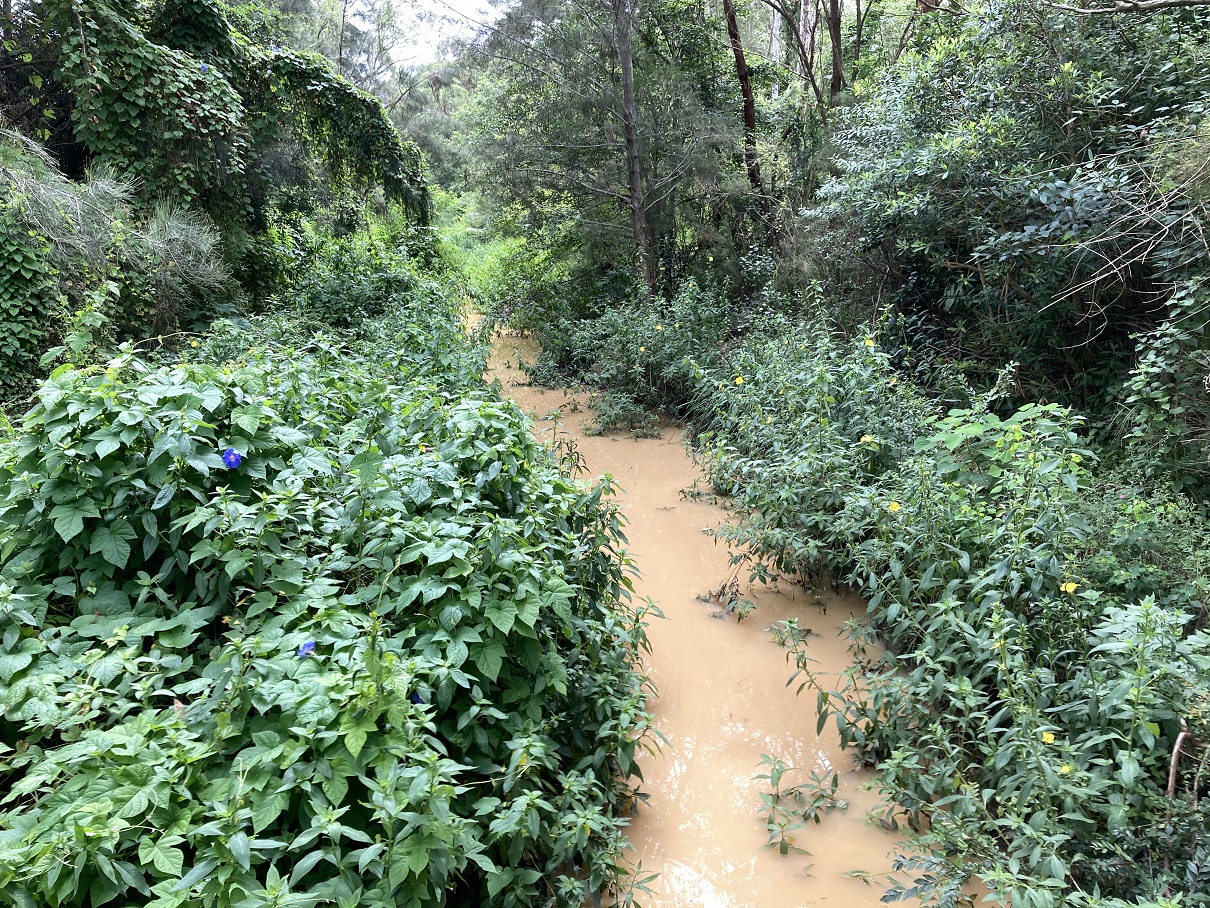inbox and environment news: Issue 590
July 16-22 2023: Issue 590
Weeds: A Round Table Discussion: Narrabeen - July 21
Conny Harris has organised this Round Table to discuss the problems with weeds in our area, which are a serious threat to our biodiversity.
You might enjoy this event if you battle with weeds in your garden, work in a Bushcare group, or just tire of seeing weeds along roadsides everywhere.
The Agenda is below, with some reading for you before the event.
Another attachment (also below) explains just what is a priority weed.
We will have weed specimens to help the discussions, and PNHA Cards will be for sale.
All Welcome
Weeds Round Table on July 21, PLEASE RSVP to Conny Harris if you would like to attend. Her email: conny.harris@gmail.com
Conny is providing Pumpkin soup and sourdough bread for supper.
Weeds: A Round Table Discussion
The Tramshed, Pittwater Rd Narrabeen, Friday July 21, 6-8pm
Conny Harris has organised this event because many of us are concerned about weeds increasing in the Northern Beaches area.
What can be done?
Agenda
1. acknowledgement of country
2. introduction of attendees
3. focus - why this forum?
4. presentation by Sonja Elwood, Coordinator, Invasive Species Northern Beaches Council (as per questions sent earlier)
5. discussion within the group about our experience with new or particular strongly emerging weeds.
6. conclusions/ recommendations
>>>>>>>>>>>>>>>>>>>>>>>>>>>>>>>>>>>>>>>>>>>>>>>>>>>>>>>>>>>>>>>>>>>>>>>>>
In advance of the Roundtable discussion, Council staff have provided answers to the following questions asked by Conny in a recent email.
1) Priority weeds for Council and their management:
Council's priority weeds are listed in Council's Local Priority Weed Management Plan. Weeds are managed in accordance with the requirements of the NSW Biosecurity Act 2015.
2) Where are these priority weeds predominantly?
Priority weeds may be found in a variety of locations including private lands and gardens, bushland reserves, creek lines, major roadways and/or degraded building or development sites.
3) How does the Council care for areas with very high biodiversity?
Council objectives for managing land with very high biodiversity are identified in Council’s Bushland and Biodiversity Policy. Council has limited powers over conservation and management (of weeds) of land that is private land or land that is not under our care and control. Funding for management of weeds is limited to land under Council’s care and control. Management of weeds in Council’s reserves is guided by Council policy which states “The restoration and enhancement of public bushland will be prioritised based on both conservation significance and the level of public interest”. Areas of conservations significance within individual reserves are determined by the relevant bushland management officer and based on Council mapping and local expert knowledge. In many instances, management is also guided by relevant Plans of Management.
4) What coordination is in place between roadside maintenance crews and your department?
Council Teams collaborate when carrying out works in sensitive areas such as Bushland and Endangered Ecological Communities (EEC's). The majority of the Parks road side maintenance involves cutting back vegetation from around 1 - 2m in from the road edge to maintain sight lines and safe road access for pedestrians and other road users. Council uses experienced contractors who have been carrying out road side maintenance in most of the bushland areas of Terry Hills, McCarrs Creek, Elanora Heights, Belrose and Ingleside for many years and are well aware of areas of EEC or threatened ecological communities.
5) What coordination is in place with RFS for planned burns?
Council has identified 42 burns for the 23/24 Annual Hazard Reduction Burn Program throughout various reserves and parks which not only contribute towards reducing bush fire risk, but also work towards maintaining diversity and ecological goals.
Council works closely with the relevant fire agency (NSW Rural Fire Service or Fire & Rescue NSW) to plan, prepare and implement Council proposed burns as weather and operational opportunities allow prioritised on risk.
Other land managers such as the NSW National Parks & Wildlife Service or the BFMC sometimes propose burns that may involve areas of Council land. Council works closely with these agencies through the BFMC to review any such proposals and provide appropriate permissions as required.
The BFMC is currently working towards renewing the two existing Bush Fire Risk Management Plans. The committee has recently publicly exhibited a new draft Bush Fire Risk Management Plan. The plan is on exhibition until 17th July after which time the BFMC will be working to reviewing any community and agencies comments prior to finalising and adopting the new plan.
6) What responsibility for weed control do the Parks and recreation department, and the department in charge of road maintenance have?
Council Teams collaborate when carrying out all proposed works, in particular our teams work extensively with Pamela Bateman our Weed Management Officer to ensure that we address weed outbreaks.
Also: Northern Beaches Draft Bush Fire Risk Management Plan (open for submissions until 17 July 2023)
 | DPI Primefact What is and what is not a priority weed Biosecurity Act JUN2023 (1).pdf Size : 532.84 Kb Type : pdf |
Spring + Summer 2023 Ringtail Posse Membership Now Open - Please Email Us To Express 'I'm In'!
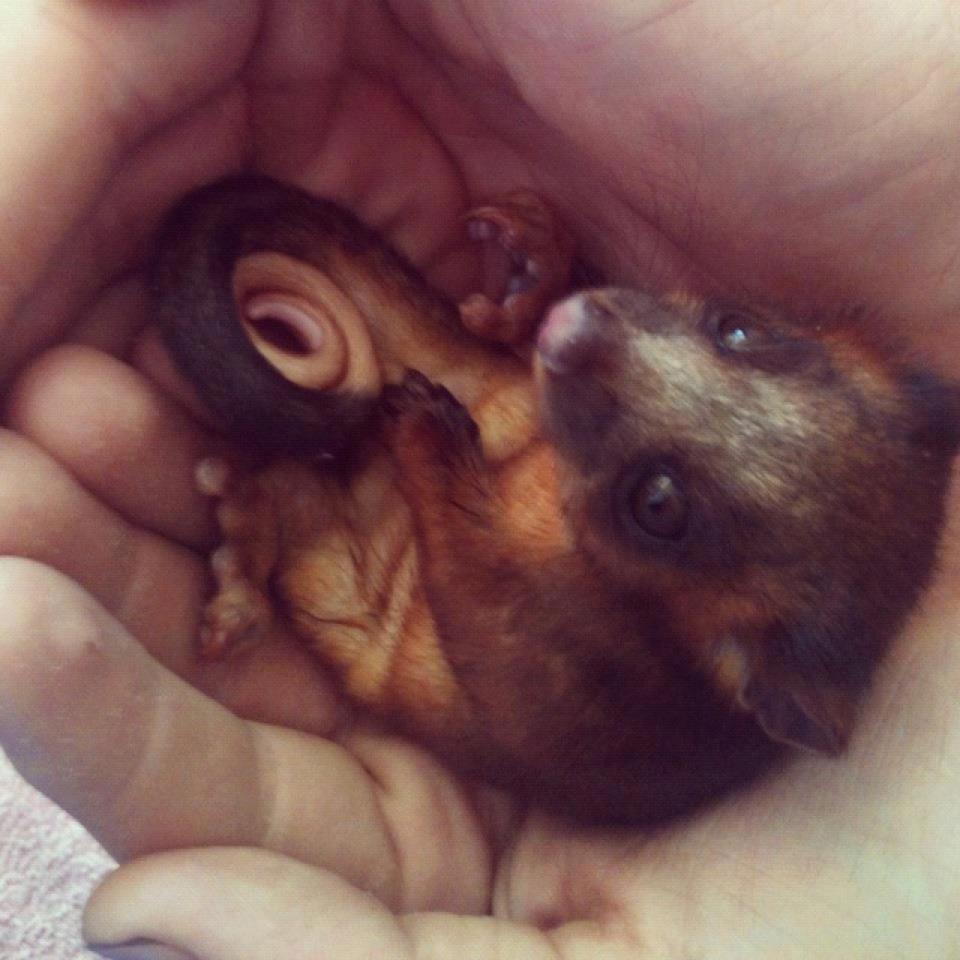 Although there have been calls to open the Ringtail Posse across the Sydney Basin, the founders will leave this up to local wildlife carer groups and councils at present - 2024 will see an expansion and we will persist in sharing local members insights. At present we are seeking residents who want to become part of the Spring and Summer rounds for our LGA.
Although there have been calls to open the Ringtail Posse across the Sydney Basin, the founders will leave this up to local wildlife carer groups and councils at present - 2024 will see an expansion and we will persist in sharing local members insights. At present we are seeking residents who want to become part of the Spring and Summer rounds for our LGA.The Life Electric Expo And Forum: July 30th At Avalon Rec. Centre
The Life Electric Community Expo is hosted by Avalon Palm Beach Business Chamber Inc. Entry is free with 10+ stalls, expert advice, food, music and test rides. You can also purchase tickets to the live panel featuring Saul Griffith and John Grimes.
Book your tickets ($10) at the link here: https://www.trybooking.com/events/landing/1076483
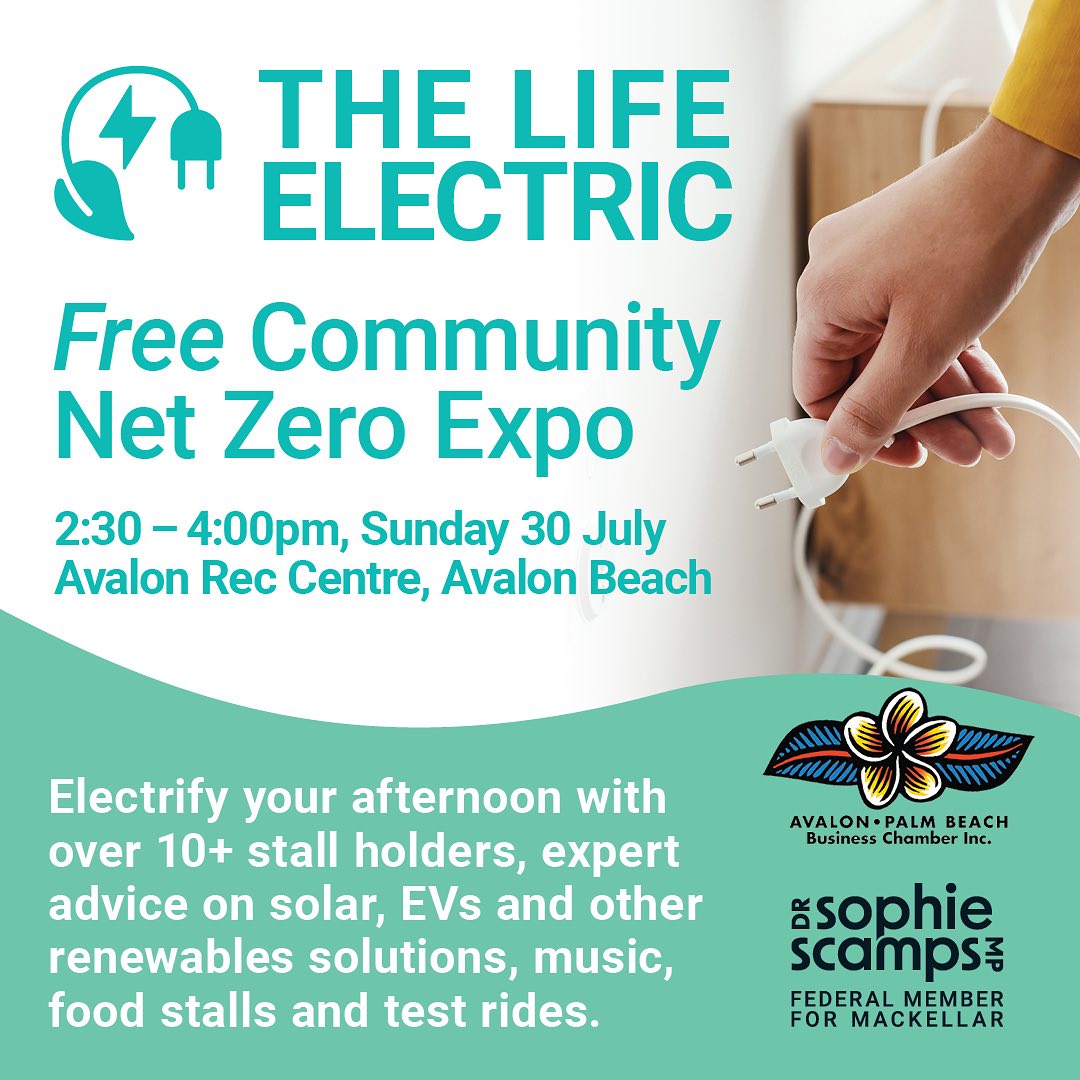
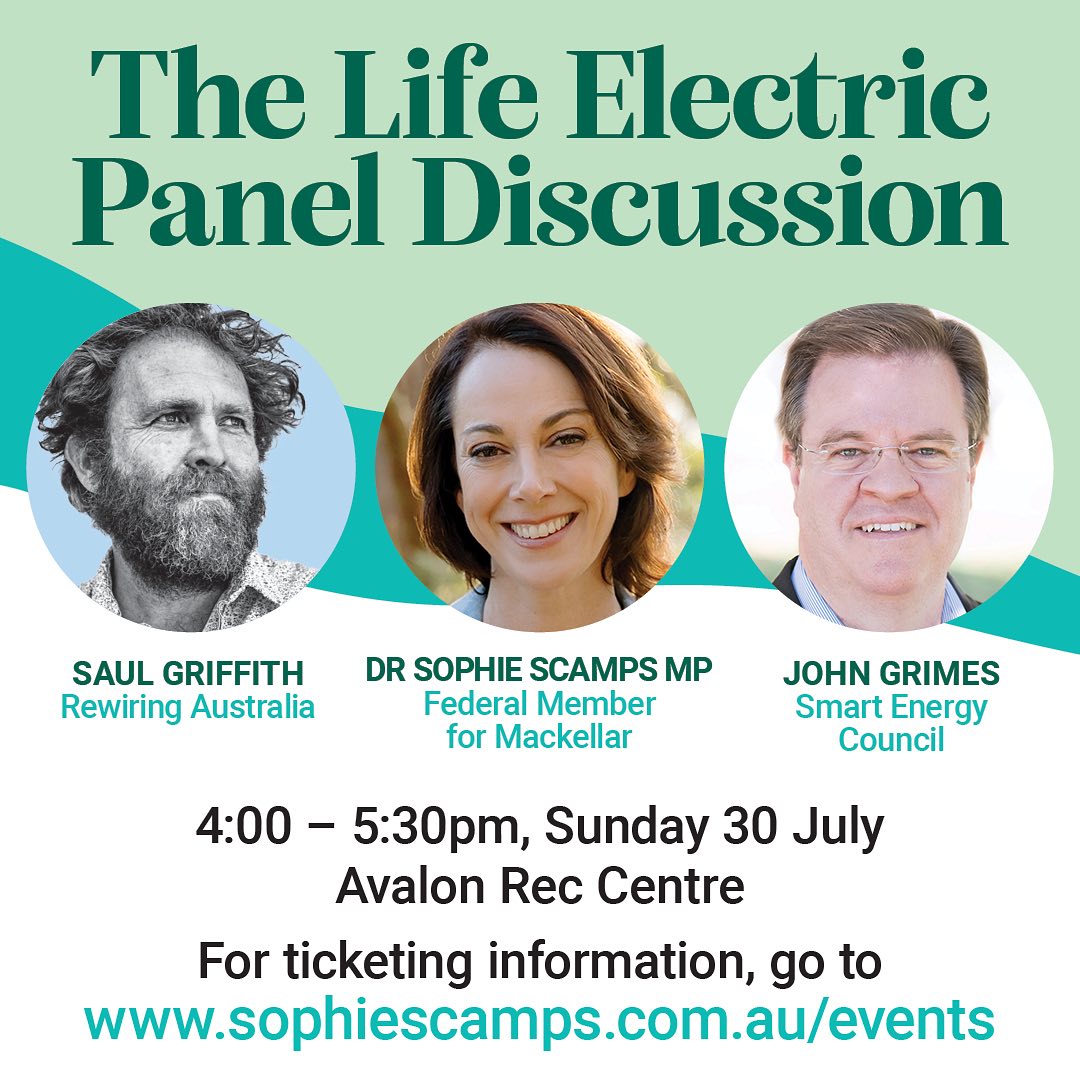
Northern Beaches Clean Up Crew: Dee Why Lagoon Beach Side Clean Up, 30th Of July, 2023, At 10am
Come and join us for our family friendly July clean up, in Dee Why Lagoon on the 30th at 10am. We meet in the grass area close to the council car park, and the surf life saving club at the north end of Dee Why. Please note that this is a different meeting point to where we were last time.
We have gloves, bags, and buckets, and grabbers. We're trying to remove as much plastic and rubbish as possible before it enters the water. Some of us can focus on the bush area and sandy/rocky areas, and others can walk along the water and even clean up in the water (at own risk). We will clean up until around 11.15, and after that, we will sort and count the rubbish so we can contribute to research by entering it into a marine debris database. The sorting and counting is normally finished around noon, and we'll often go for lunch together at our own expense. We understand if you cannot stay for this part, but are grateful if you can. We appreciate any help we can get, no matter how small or big.
No booking required - just show up on the day - we will be there no matter what weather. We're a friendly group of people, and everyone is welcome to this family friendly event. It's a nice community - make some new friends and do a good deed for the planet at the same time.
For everyone to feel welcome, please leave political and religious messages at home - this includes t-shirts with political campaign messages.
Message us on our social media or send us an email if you are lost. All welcome - the more the merrier. Please invite your friends too! All details in our Facebook event, Instagram or on our website.
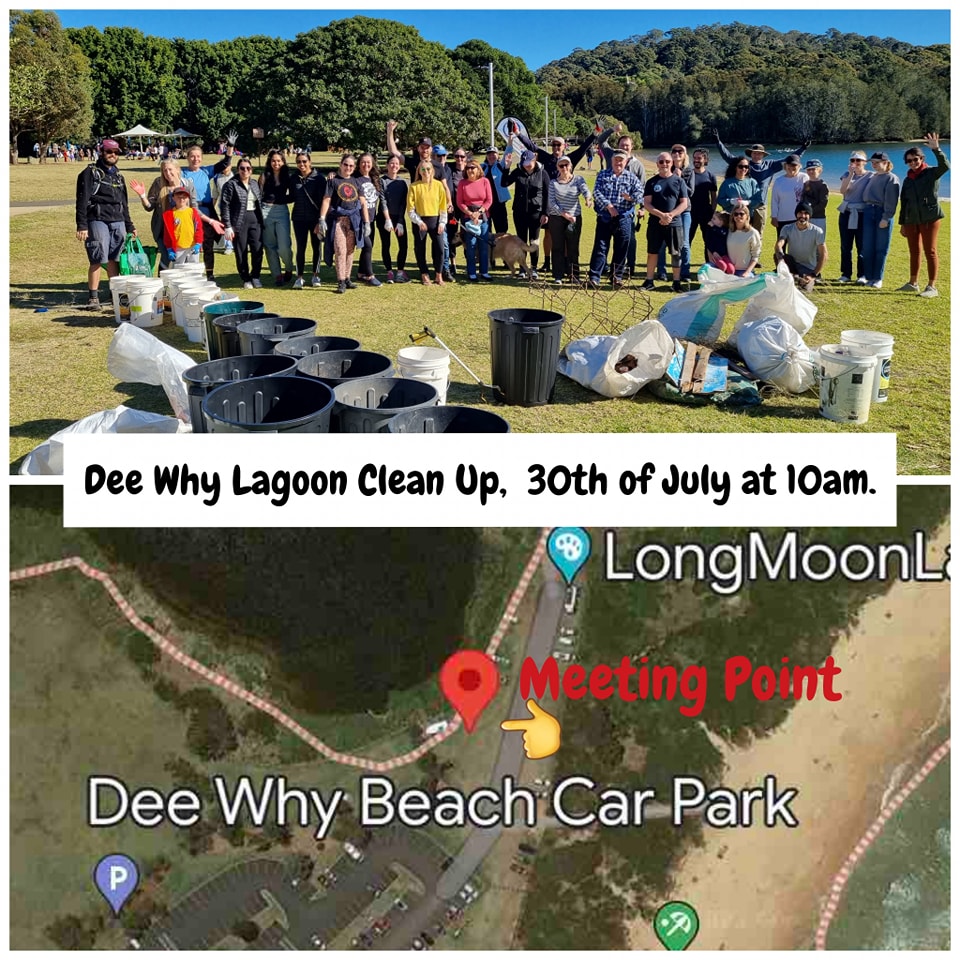
Areas Closed For West Head Lookout Upgrades
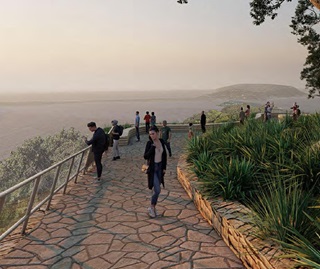 NPWS advise that the following areas are closed from Monday 22 May to Thursday 30 November 2023 while West Head lookout upgrades are underway:
NPWS advise that the following areas are closed from Monday 22 May to Thursday 30 November 2023 while West Head lookout upgrades are underway:
- West Head lookout
- The loop section of West Head Road
- West Head Army track.
Vehicles, cyclists and pedestrians will have access to the Resolute picnic area and public toilets. Access is restricted past this point.
The following walking tracks remain open:
- Red Hands track
- Aboriginal Heritage track
- Resolute track, including access to Resolute Beach and West Head Beach
- Mackeral Beach track
- Koolewong track.
The West Head lookout cannot be accessed from any of these tracks.
Image: Visualisation of upcoming works, looking east from the ramp towards Barrenjoey Head Credit: DPE
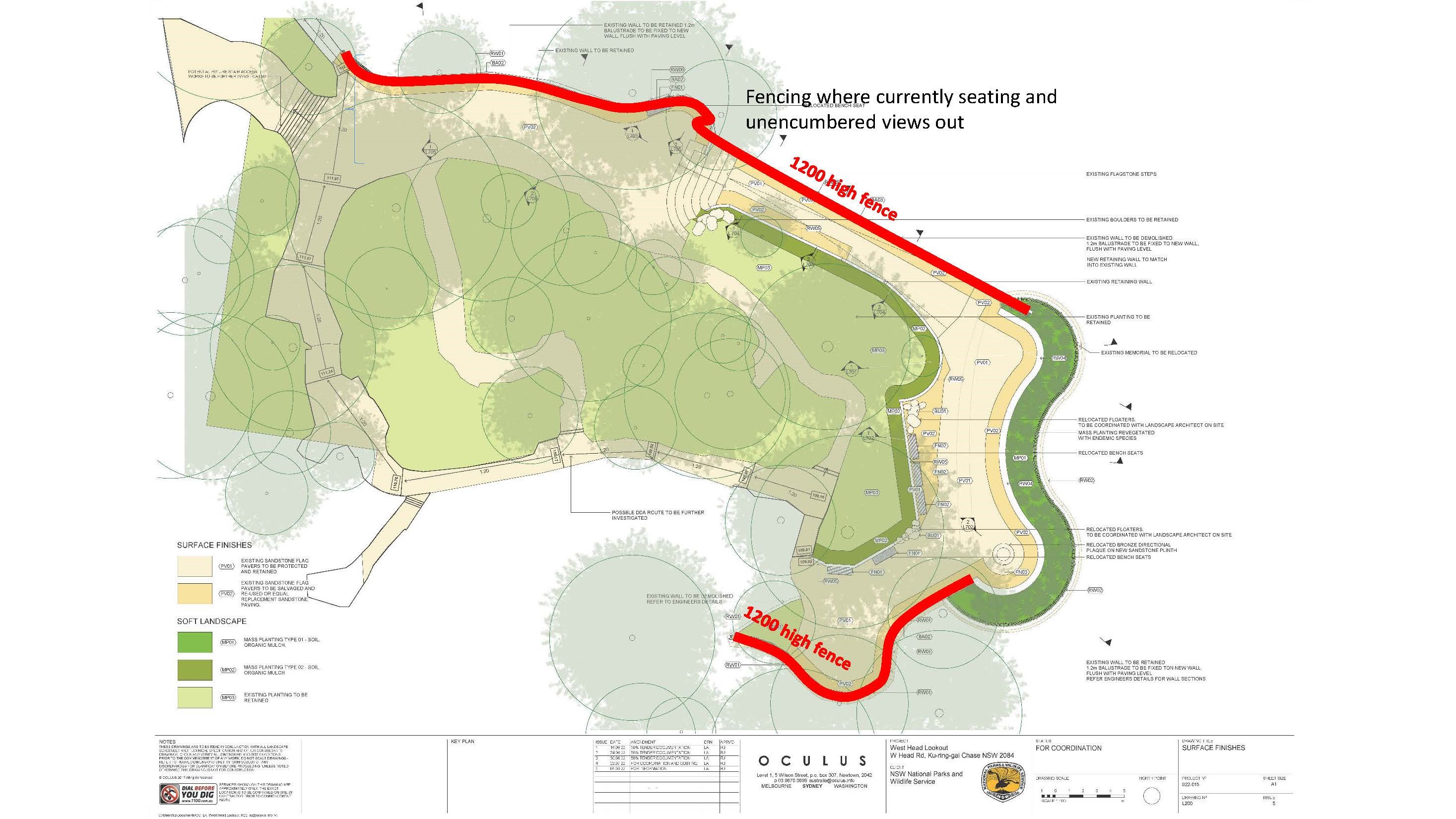
Time Of Burrugin
Cold and frosty; June-July
Echidna seeking mates - Burringoa flowering - Shellfish forbidden
This is the time when the male Burrugin (echidnas) form lines of up to ten as they follow the female through the woodlands in an effort to wear her down and mate with her. It is also the time when the Burringoa (Eucalyptus tereticornis) starts to produce flowers, indicating that it is time to collect the nectar of certain plants for the ceremonies which will begin to take place during the next season. It is also a warning not to eat shellfish again until the Boo'kerrikin (Acacia decurrens, commonly known as black wattle or early green wattle) blooms.
Eucalyptus tereticornis, commonly known as forest red gum, blue gum or red irongum, is a species of tree that is native to eastern Australia and southern New Guinea. It has smooth bark, lance-shaped to curved adult leaves, flower buds in groups of seven, nine or eleven, white flowers and hemispherical fruit.
Eucalyptus tereticornis was first formally described 1795 by James Edward Smith in A Specimen of the Botany of New Holland from specimens collected in 1793 from Port Jackson by First Fleet surgeon and naturalist John White. The specific epithet (tereticornis) is from the Latin words teres (becoming tereti- in the combined form) meaning "terete" and cornu meaning "horn", in reference to the horn-shaped operculum.
Habitat tree: Sclerophyll Forest.
Food tree: Natural stands are an important food tree for koalas and a wide variety of nectar-eating birds, fruit bats and possums.
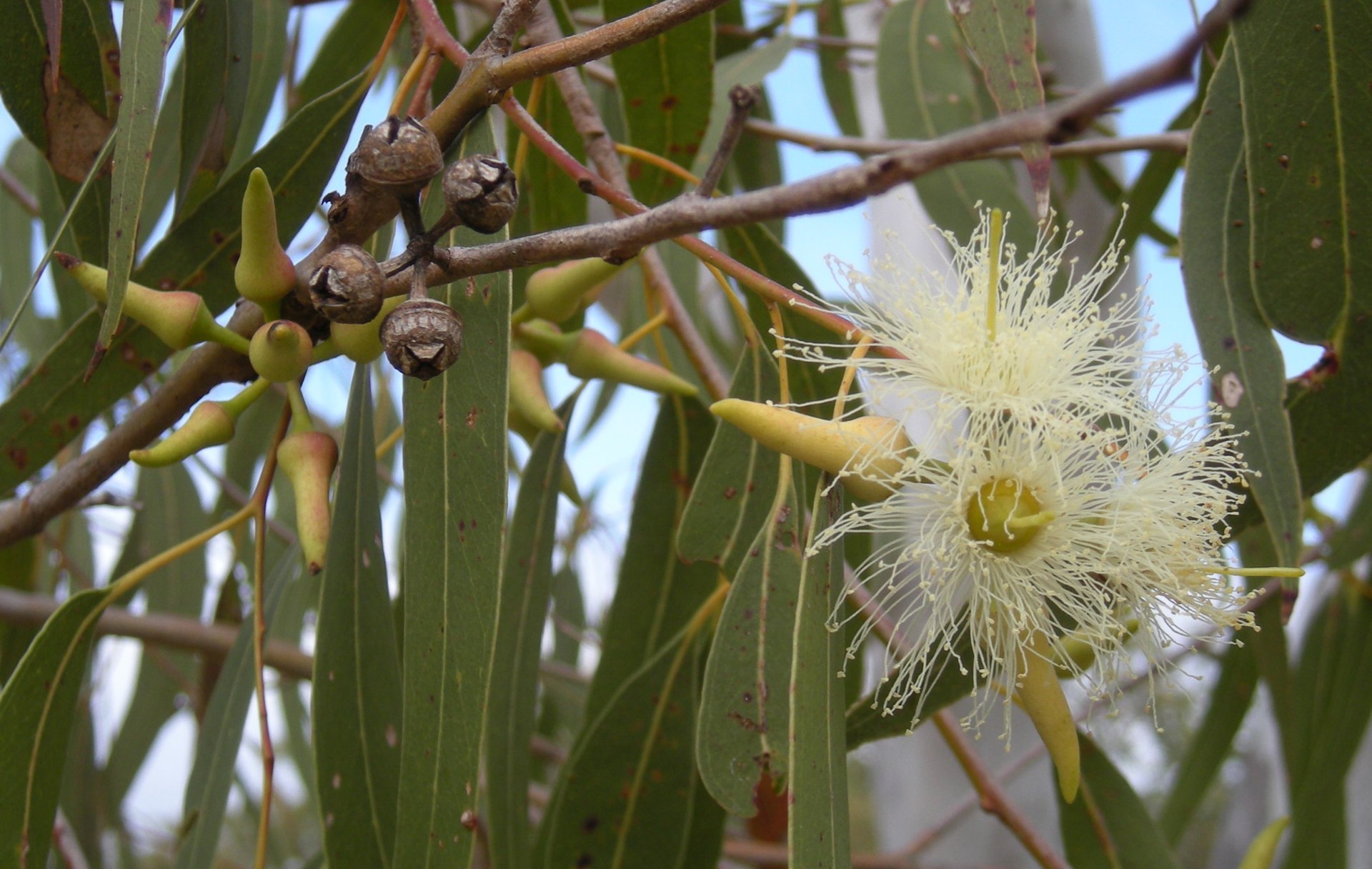
Eucalyptus tereticornis buds, capsules, flowers and foliage, Rockhampton, Queensland. Photo: Ethel Aardvark
Shelly Beach Echidna
Photos by Kevin Murray, taken late May 2023 who said, ''he/she was waddling across the road on the Shelly Beach headland, being harassed not so much by the bemused tourists, but by the Brush Turkeys who are plentiful there.''
Shelly Beach is located in Manly and forms part of Cabbage Tree Bay, a protected marine reserve which lies adjacent to North Head and Fairy Bower.
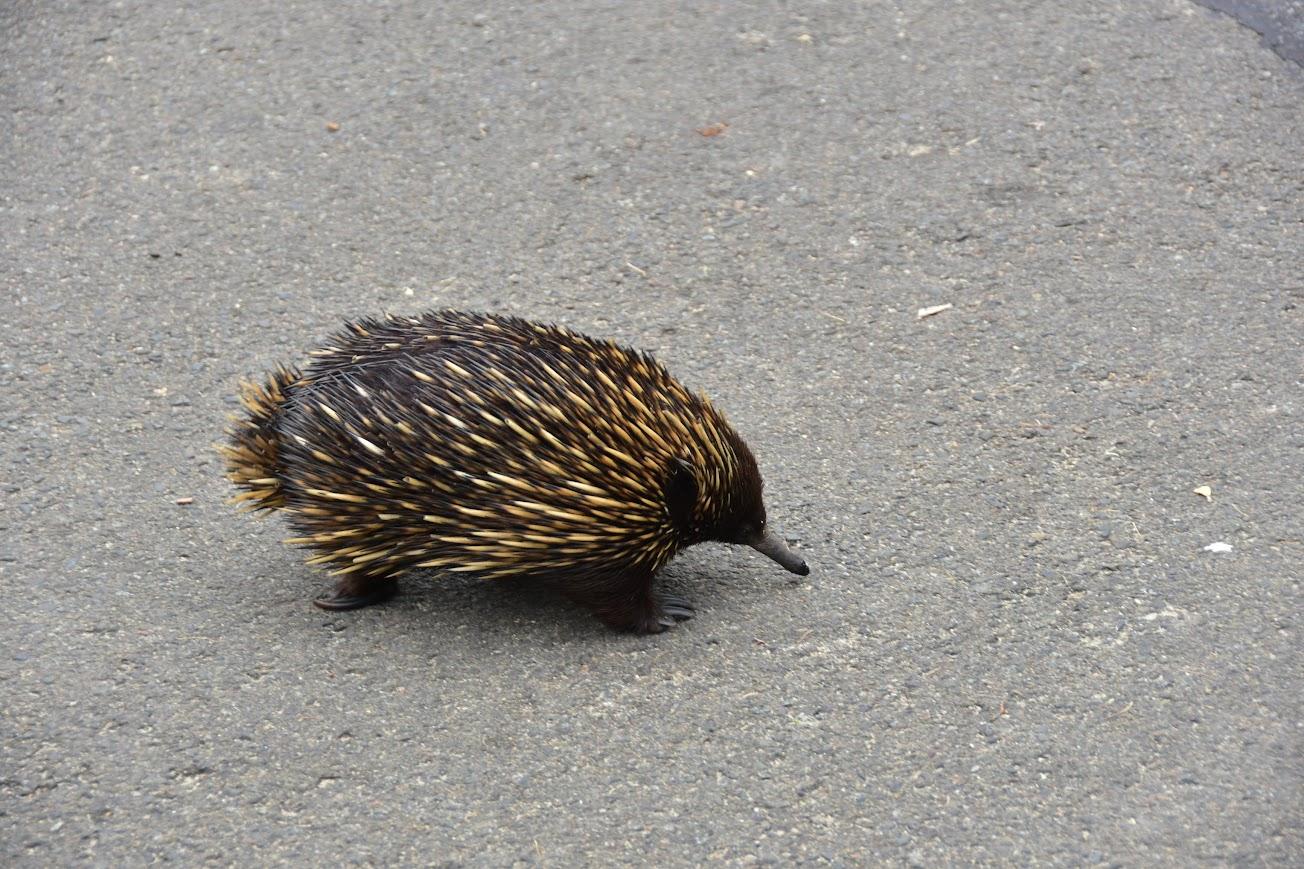
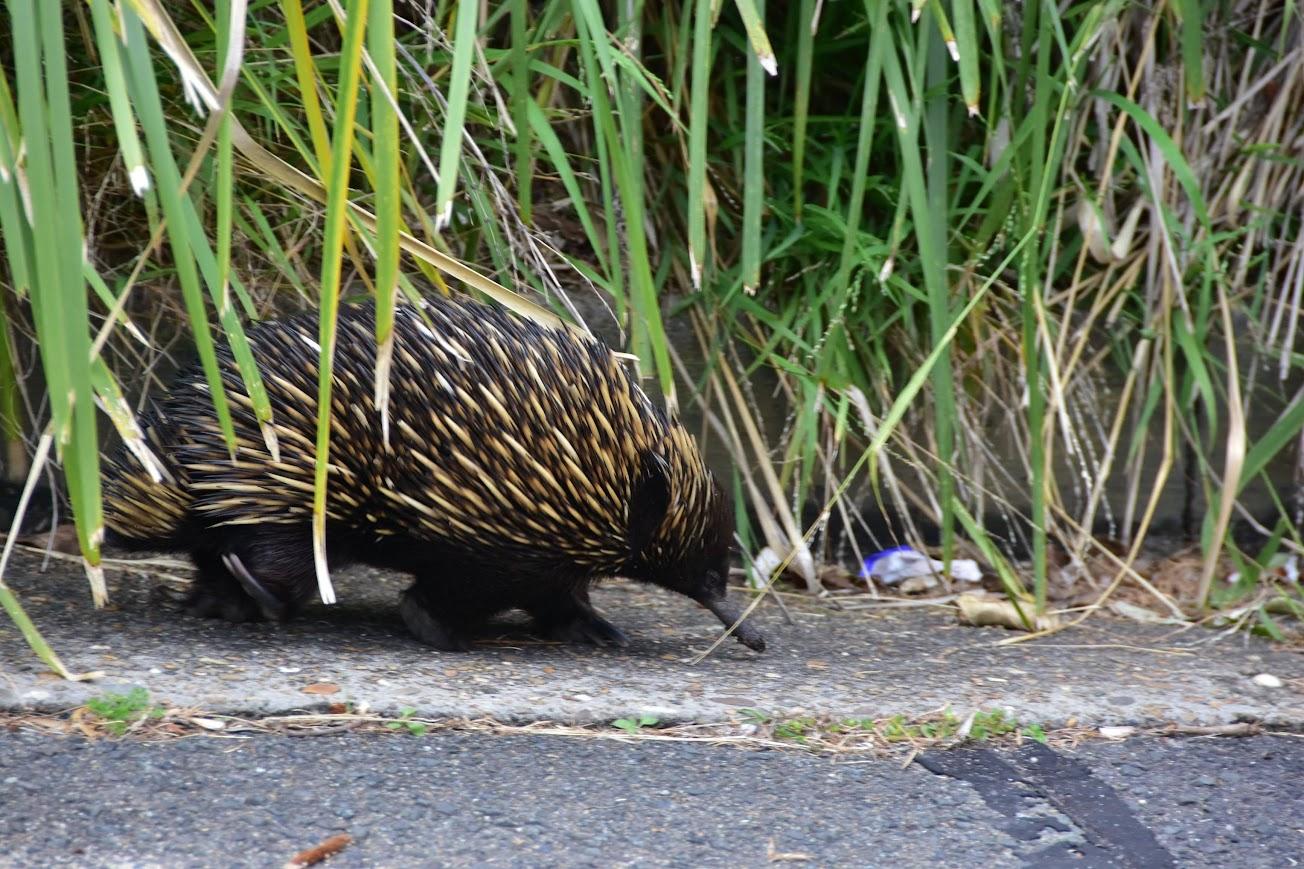
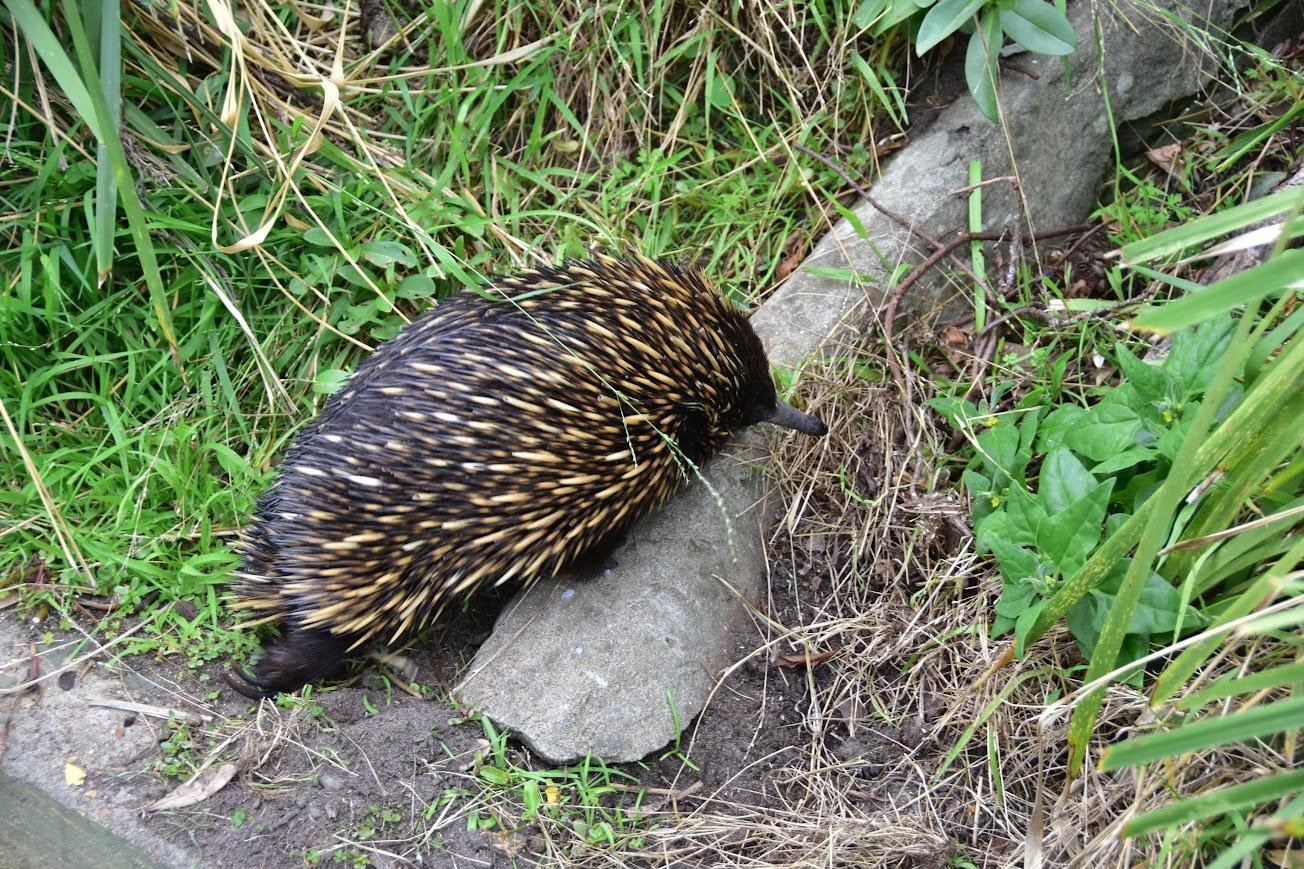
From the D'harawal calendar, BOM
D'harawal
The D'harawal Country and language area extends from the southern shores of Port Jackson (Sydney Harbour) to the northern shores of the Shoalhaven River, and from the eastern shores of the Wollondilly River system to the eastern seaboard.
Bush Turkeys: Backyard Buddies Breeding Time Commences In August - BIG Tick Eaters - Ringtail Posse Insights
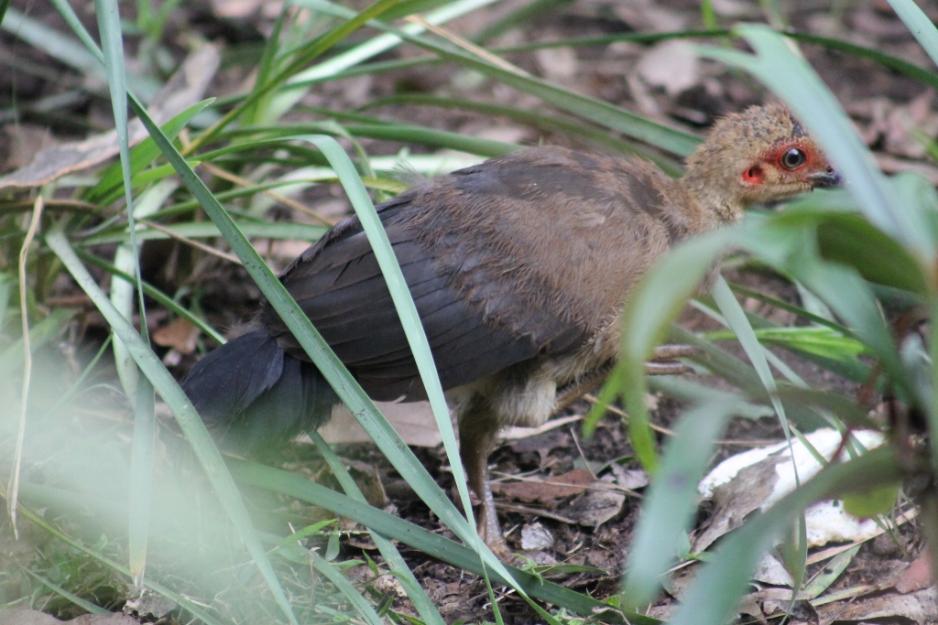
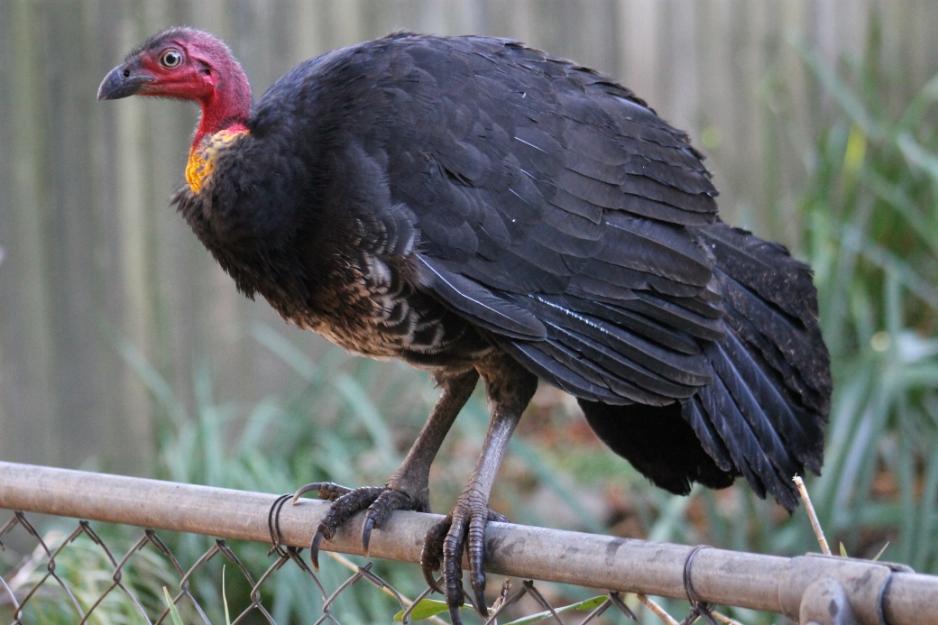
Northern Beaches Clean Up Crew : 50 Year Old Soft Drink Can Found In Narrabeen Lagoon
July 8 2023
Rubbish can definitely be around for a very long time. We regularly see evidence of it. Today, a can of Coke was found in Narrabeen Lagoon. It's been there for over 50 years.
Please always be mindful of your rubbish, and remember it is always best to try and avoid as much single use products as possible.

North Narrabeen Lagoon On A Winter Sunday Afternoon
PNHA Guided Nature Walks 2023
Our walks are gentle strolls, enjoying and learning about the bush rather than aiming for destinations. Wear enclosed shoes. We welcome interested children over about 8 years old with carers. All Welcome.
So we know you’re coming please book by emailing: pnhainfo@gmail.com and include your phone number so we can contact you if weather is doubtful.
The whole PNHA 2023 Guided Nature Walks Program is available at: http://pnha.org.au/test-walks-and-talks/
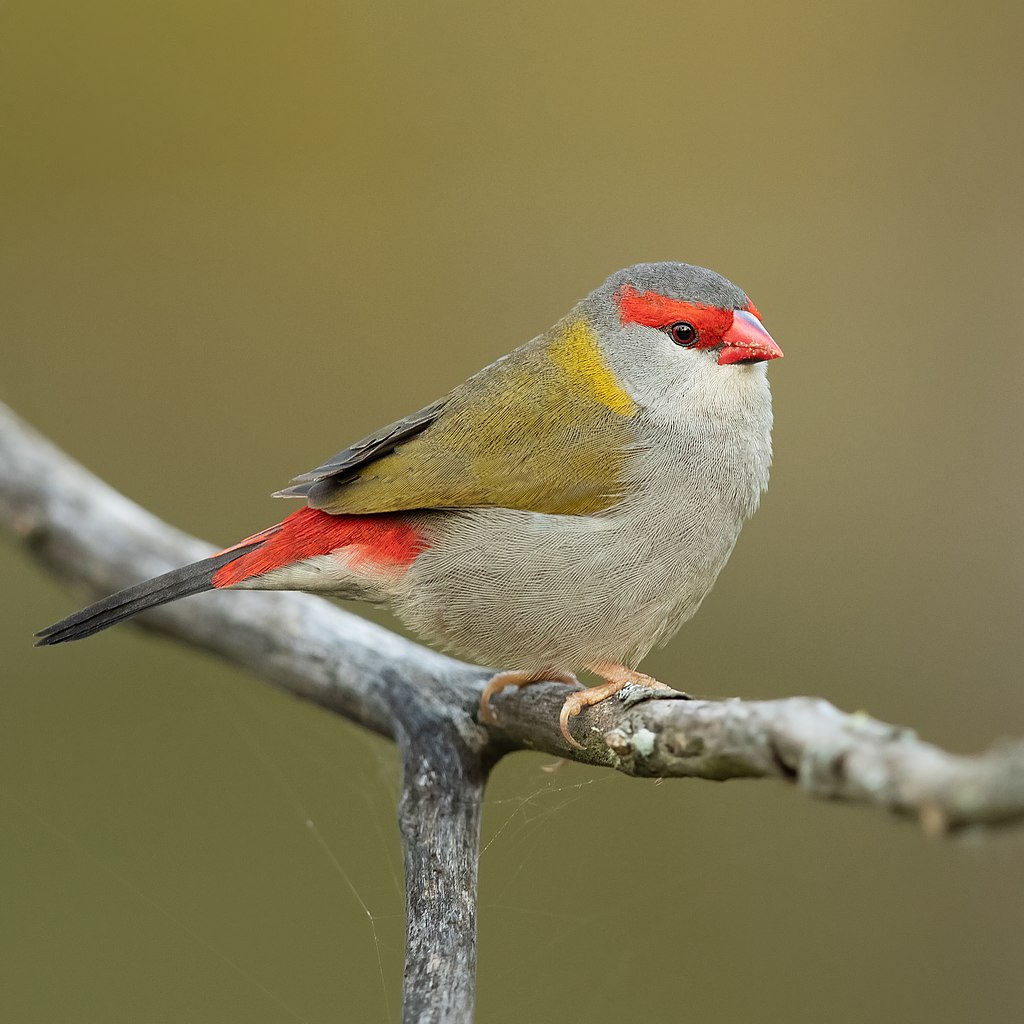
Red-browed finch (Neochmia temporalis). Photo: J J Harrison
Bushcare In Pittwater
Where we work Which day What time
Avalon
Angophora Reserve 3rd Sunday 8:30 - 11:30am
Avalon Dunes 1st Sunday 8:30 - 11:30am
Avalon Golf Course 2nd Wednesday 3 - 5:30pm
Careel Creek 4th Saturday 8:30 - 11:30am
Toongari Reserve 3rd Saturday 9 - 12noon (8 - 11am in summer)
Bangalley Headland 2nd Sunday 9 to 12noon
Bayview
Winnererremy Bay 4th Sunday 9 to 12noon
Bilgola
North Bilgola Beach 3rd Monday 9 - 12noon
Algona Reserve 1st Saturday 9 - 12noon
Plateau Park 1st Friday 8:30 - 11:30am
Church Point
Browns Bay Reserve 1st Tuesday 9 - 12noon
McCarrs Creek Reserve Contact Bushcare Officer To be confirmed
Clareville
Old Wharf Reserve 3rd Saturday 8 - 11am
Elanora
Kundibah Reserve 4th Sunday 8:30 - 11:30am
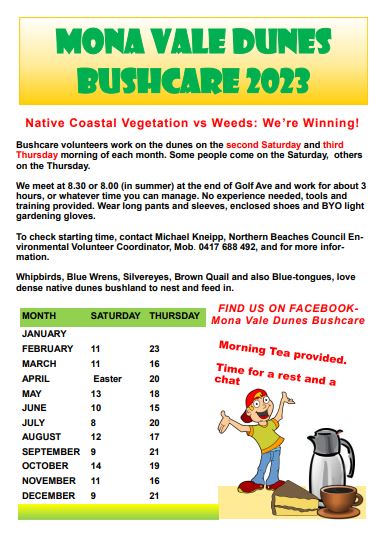 Mona Vale
Mona Vale Mona Vale Beach Basin 1st Saturday 8 - 11am
Mona Vale Dunes 2nd Saturday +3rd Thursday 8:30 - 11:30am
Newport
Bungan Beach 4th Sunday 9 - 12noon
Crescent Reserve 3rd Sunday 9 - 12noon
North Newport Beach 4th Saturday 8:30 - 11:30am
Porter Reserve 2nd Saturday 8 - 11am
North Narrabeen
Irrawong Reserve 2nd Saturday 2 - 5pm
Palm Beach
North Palm Beach Dunes 3rd Saturday 9 - 12noon
Scotland Island
Catherine Park 2nd Sunday 10 - 12:30pm
Elizabeth Park 1st Saturday 9 - 12noon
Pathilda Reserve 3rd Saturday 9 - 12noon
Warriewood
Warriewood Wetlands 1st Sunday 8:30 - 11:30am
Whale Beach
Norma Park 1st Friday 9 - 12noon
Western Foreshores
Coopers Point, Elvina Bay 2nd Sunday 10 - 1pm
Rocky Point, Elvina Bay 1st Monday 9 - 12noon
Friends Of Narrabeen Lagoon Catchment Activities

Gardens And Environment Groups And Organisations In Pittwater
Report Fox Sightings
%20(1).jpg?timestamp=1675893929686)
Marine Wildlife Rescue Group On The Central Coast
A new wildlife group was launched on the Central Coast on Saturday, December 10, 2022.
Marine Wildlife Rescue Central Coast (MWRCC) had its official launch at The Entrance Boat Shed at 10am.
The group comprises current and former members of ASTR, ORRCA, Sea Shepherd, Greenpeace, WIRES and Wildlife ARC, as well as vets, academics, and people from all walks of life.
Well known marine wildlife advocate and activist Cathy Gilmore is spearheading the organisation.
“We believe that it is time the Central Coast looked after its own marine wildlife, and not be under the control or directed by groups that aren’t based locally,” Gilmore said.
“We have the local knowledge and are set up to respond and help injured animals more quickly.
“This also means that donations and money fundraised will go directly into helping our local marine creatures, and not get tied up elsewhere in the state.”
The organisation plans to have rehabilitation facilities and rescue kits placed in strategic locations around the region.
MWRCC will also be in touch with Indigenous groups to learn the traditional importance of the local marine environment and its inhabitants.
“We want to work with these groups and share knowledge between us,” Gilmore said.
“This is an opportunity to help save and protect our local marine wildlife, so if you have passion and commitment, then you are more than welcome to join us.”
Marine Wildlife Rescue Central Coast has a Facebook page where you may contact members. Visit: https://www.facebook.com/profile.php?id=100076317431064
- Ph: 0478 439 965
- Email: marinewildlifecc@gmail.com
- Instagram: marinewildliferescuecc

Watch Out - Shorebirds About
.JPG.opt1460x973o0,0s1460x973.jpg?timestamp=1663629195339)
Possums In Your Roof?: Do The Right Thing

Aviaries + Possum Release Sites Needed

MR Vales Point Extension A Line In The Sand, Says Climate Groups
Record Fine For Illegal Water Take Proof Mining Has No Place In Sydney Water Catchment: Greens
Net Zero Economy Agency; Australian Government
July 3, 2023
The Net Zero Economy Agency is responsible for promoting orderly and positive economic transformation across Australia as the world decarbonises, to ensure Australia, its regions and workers realise and share the benefits of the net zero economy.
The agency will engage with a variety of stakeholders including communities, regional bodies, industry, investors and First Nations groups to support a positive transition to a net zero economy. The work of the Net Zero Economy Agency is a precursor to the establishment of a legislated Net Zero Authority, following Parliamentary processes.
It will kick-start the work of the Net Zero Authority by:
- helping investors and companies to engage with net zero transformation opportunities
- coordinating programs and policies across government to support regions and communities to attract and take advantage of new clean energy industries and set those industries up for success
- supporting workers in emissions-intensive sectors to access new employment, skills and support as the net zero transformation continues.
The Hon Greg Combet AM is chair of the Net Zero Economy Agency. As chair, Mr Combet will guide the agency to ensure that the workers, industries and communities that have powered Australia for generations, can seize the opportunities of the net zero transformation. The chair is supported by an advisory board to design and establish the legislated Net Zero Authority.
Me-Mel (Goat Island) To Be Transferred To Aboriginal Community
July 1, 2023
The NSW Government has today taken a significant step in the process for transferring Me-Mel (Goat Island) to Aboriginal ownership by signing a Memorandum of Understanding (MOU) with the Me-Mel Transfer Committee.
$43 million is committed to remediate and restore Me-Mel and pave the way for the transfer back to the Aboriginal community, the NSW Government said in an issued statement
The committee will identify options for the transfer, develop recommendations for cultural, tourism and public uses of the site, and provide advice on the management of the site.
It will also develop a strategic business case to be considered by the NSW Government.
The Committee is made up of key Aboriginal representatives, along with NSW Government representatives from the Cabinet Office, Aboriginal Affairs NSW and the NSW National Parks and Wildlife Service.
A wide range of engagement activities and consultation will be undertaken with the Aboriginal community, the broader public and other stakeholders on the plans for future ownership and management options.
Committee members have given unanimous support to a Registered Aboriginal Owners research project which aims to identify Aboriginal Owners of Me-Mel.
This research will be independently undertaken by the Office of the Registrar of the Aboriginal Land Rights Act 1983 (ORALRA) and is due to commence in the second half of 2023.
To prepare for the transfer of the island, National Parks and Wildlife Service is also undertaking a large-scale remediation and conservation program of the island’s built assets.
The 14-member committee includes:
- Aboriginal community representatives including Shane Phillips, Amanda Reynolds, Elizabeth Tierney and Ash Walker
- Metropolitan Local Aboriginal Land Council representatives include Allan Murray, Nathan Moran, Eunice Roberts and Jennah Dungay
- NSW Aboriginal Land Council representatives include Heidi Hardy and Abie Wright
- NSW Government members include Angie Stringer, Director Aboriginal Partnerships, Planning and Heritage and Deon van Rensburg, Director Greater Sydney Branch, National Parks and Wildlife Service; Nikki Williams, Director for Economic Policy Branch, The Cabinet Office; and Jonathon Captain-Webb, Director, Aboriginal Cultural Heritage, Land and Economy for Aboriginal Affairs NSW.
Iconic South Coast Island Nature Reserve Dual Named In Recognition Of Cultural Significance
July 4, 2023
The NSW Government has officially given Montague Island Nature Reserve a dual Aboriginal name, in honour of the cultural significance of the island to the Yuin people.
Barunguba Montague Island Nature Reserve, off Narooma on the NSW south coast, is valued as a significant ceremonial area and resource gathering place.
In addition to its Aboriginal cultural values and state-listed European lighthouse heritage, the nature reserve protects several seabird species including the endangered Gould's petrel, one of the largest little penguin colonies in New South Wales, and Australian and New Zealand fur seals.
The island is recognised in the international Union for Conservation of Nature (IUCN) Green List of Protected Areas, for its excellence in protected area management. Visitors can experience the island's wildlife by day trip or staying in historic lighthouse accommodation.
The process of renaming Barunguba Montague Island Nature Reserve was initiated by the Aboriginal traditional owners to recognise the cultural heritage of the site.
Further information: Barunguba is pronounced [bar-an-goo-ba]
Yuin Elder Uncle Bunja Smith said:
"From Mother mountain Gulaga, came the 2 sons. Najanuka and Barunguba. We know this because it is in our stories and our songs.
"As an Aboriginal Man and a Yuin Elder, I am filled with emotion to be standing here today with the ministers and our local member, to hear the word 'Barunguba' sounded out as it should be!
"I know this will delight all our Elders and Tribes people past, present and emerging.
"I pray that the spirit of this scared place touches the hearts of the wider south coast community and all visitors who may come. May we always say yes to reconciliation, as it always was and always will be Aboriginal land, Walawanni."
NSW Environment Minister Penny Sharpe said:
"I am delighted to be in this stunning location to officially announce the dual name of Barunguba Montague Island Nature Reserve.
"The cultural significance of Barunguba has been passed down by ancestors to the traditional Yuin custodians of the Far South Coast and I acknowledge the effort of the traditional owners in leading this name change.
"The Aboriginal name will sit alongside the non-Aboriginal name and I look forward to seeing Barunguba Montague Island Nature Reserve become widely and commonly used."

Penny Sharpe MLC: Today with Dr Michael Holland MP - Member for Bega I was able to be part of the ceremony to rename Barunguba Montague Island Nature Reserve. A place of deep cultural significance & beauty. Ready to be better understood & shared. Thanks to Aunties Vivienne, Roslyn, Lynette, Jacqueline & Uncles Bunja, Graham & Bruce & all the NSW National Parks and Wildlife Service staff who have worked so hard make this happen. Photos: NSW National Parks and Wildlife Service/NSW Government
Eastern Bettongs Return To NSW After 100-Year Absence In Historic Wildlife Reintroduction Project
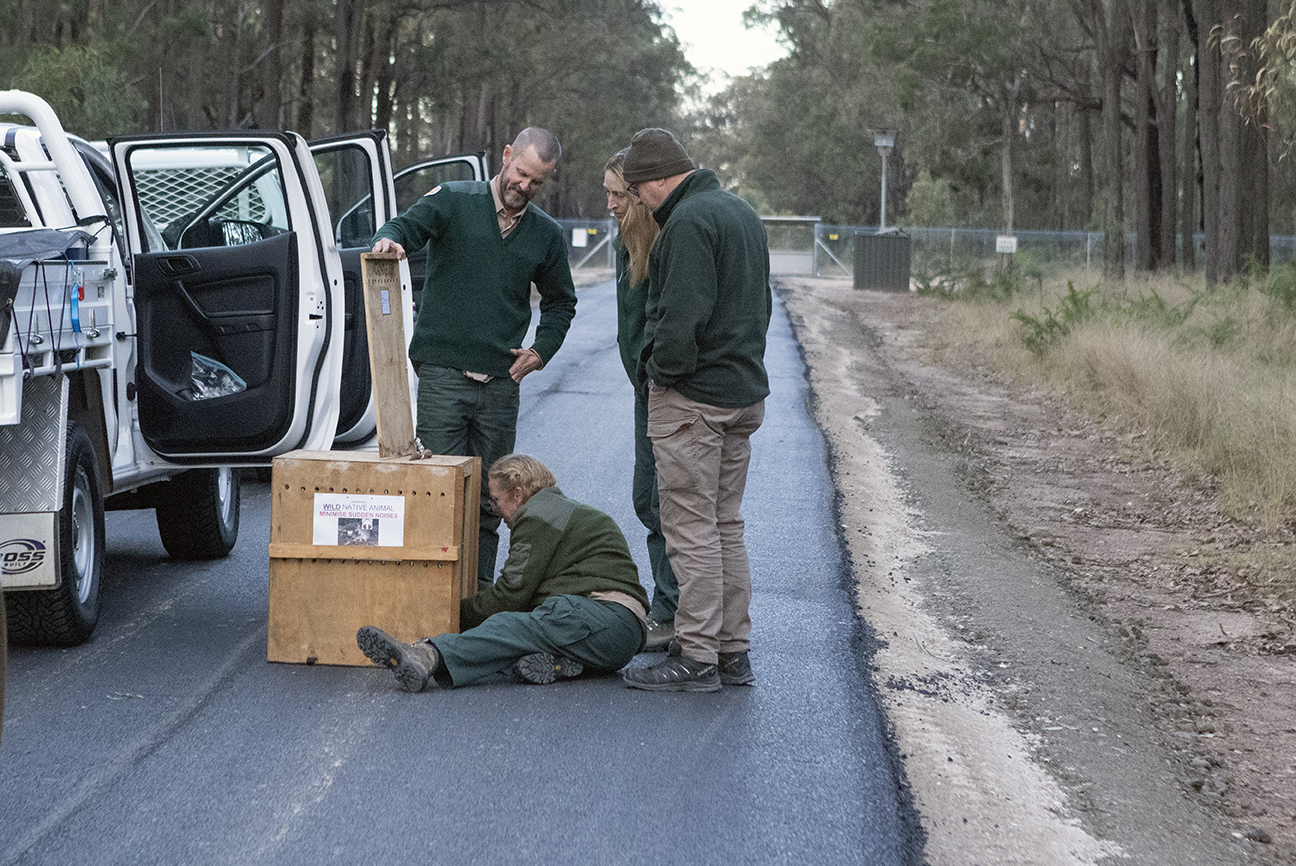
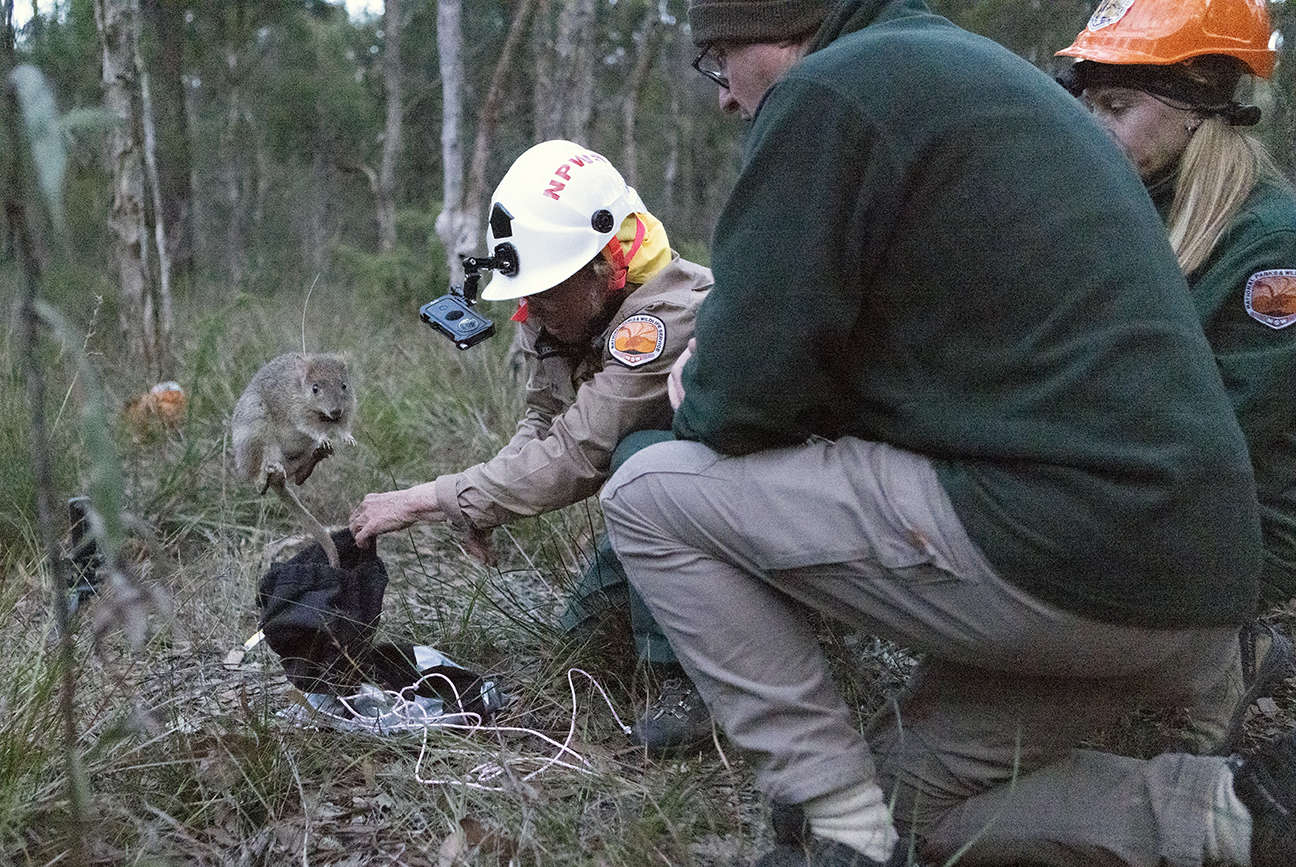
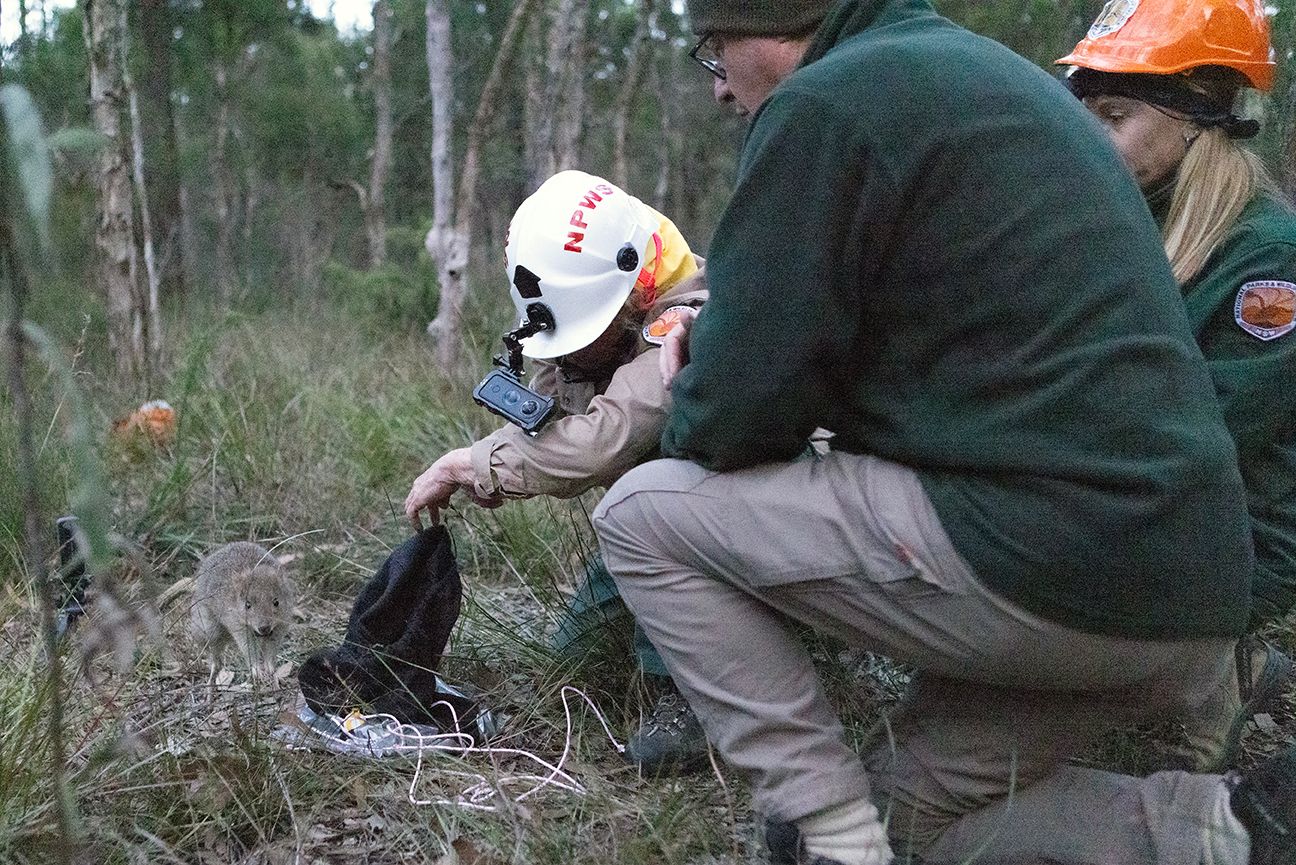
Broad-Toothed Rat Population Discovered In Victoria
Developers aren’t paying enough to offset impacts on koalas and other endangered species
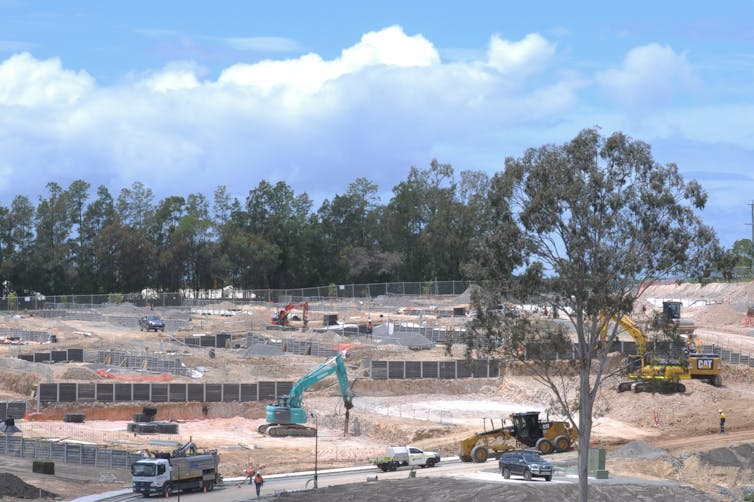
Developers are commonly required to “offset” their impacts on biodiversity. They can do this in two ways.
They can compensate directly for the biodiversity loss their development causes by taking action to improve habitat and biodiversity elsewhere. It is common, though, for developers to make payments in lieu of creating the required biodiversity offsets themselves. It’s the same idea as when you pay to offset your flight’s carbon emissions.
In Queensland and New South Wales developers settle almost all biodiversity offsets required of them by making payments into an offset fund. These funds are used to create the required biodiversity gains on the developer’s behalf. In NSW, for example, the Biodiversity Conservation Trust does this work.
But what are the pros and cons of allowing developers simply to buy their way out of their offset obligations? Research published today shows these so-called “financial settlement offsets” could be highly problematic. They might even worsen the decline of threatened species.
What Did The Study Find?
Researchers from The University of Queensland and Griffith University analysed the impacts of the Queensland government’s environmental offsets policy on koalas in the state’s south-east. This policy requires every koala habitat tree removed for development to be offset by planting and protecting three new habitat trees elsewhere. The developers can do this themselves or make a payment into a state-managed offset fund.
Our study assessed the likely impacts of financial settlement offsets on koala habitat and koala numbers under different future urban growth scenarios.
First the good news: these offsets can work in some cases. The payments can be used to invest strategically in planting trees in areas that lead to the greatest increase in koala habitat or koala numbers. For example, this could be done in areas that improve connections between areas of suitable habitat or are close to important koala populations.
Developers could do this offset work themselves. However, their priority is usually to minimise cost. This means they are unlikely to act strategically to deliver the maximum benefits for habitats and species.
As a result, our study shows financial settlement offsets could deliver 50-100% greater gains in habitat area and koala numbers than offsets delivered by developers.
Lack Of Suitable Offset Sites Is A Big Problem
Unfortunately, these gains depend on there being enough offset sites available for koala habitat restoration. An offset site must be ecologically suitable and able to be protected, habitat restoration must be feasible and the landholder must agree.
All these factors mean suitable sites are usually hard to find. In such cases, we found payments by developers weren’t enough to achieve the amount of restoration needed to offset their impacts.
If less than one in four of all ecologically suitable locations are available for offsets, the performance of financial settlement offsets falls dramatically. But if only one in 100 of all ecologically suitable locations are available, payments from developers are never enough to cover the cost of the required restoration.
According to the Queensland Offsets Register only 5.2% (0.7 hectares of 13.4ha) of all financial settlement offsets for koala habitat since 2018 have been delivered so far through on-ground activities by the state government. This shows how hard it is to find offset sites.
In Queensland, increasing the supply of offset sites has been identified as a priority.
Unfortunately, the shortage is a common problem across Australia.
In NSW, 90% of demand for offsets cannot be met through offset “credits”. These tradeable credits are created when biodiversity gains are generated at a site. Their supply to offset developer impacts is very low, indicating few suitable sites are available.
Potential offset sites are also increasingly scarce at the federal level. The shortage is expected to increase the use of financial settlement offsets.
A lack of sites can be due to the availability of ecologically suitable sites, but the offset price, transaction costs, regulatory constraints (such as requiring offset sites to be within a certain distance from impact sites) and social and economic influences on the land market are also key factors.
Developers Should Pay The Full Cost Of Offsets
Our study highlights the importance of ensuring developers pay the true cost of offsetting their impacts. By making payments in lieu of delivering offsets themselves, developers essentially transfer their financial risk to the state.
If there aren’t enough funds to deliver the required offset, the state is left with two options. Either it makes up the shortfall (taxpayers essentially subsidise developers’ environmental costs), or it falls short of delivering the full offset, leading to increased pressure on species. Both of these are poor outcomes.
The methods for calculating developer financial contributions have increasingly been called into question. It’s essential to ensure these calculators properly consider the availability and costs of offset sites.
The alternative jeopardises the delivery of offsets and adds to the pressure on threatened species such as the koala.![]()
Jonathan Rhodes, Professor of Ecology, The University of Queensland and Shantala Brisbane, PhD Candidate, School of Earth and Environmental Sciences, The University of Queensland
This article is republished from The Conversation under a Creative Commons license. Read the original article.
Australian Plastics Feeding Climate Crisis: Emissions To Double By 2050
July 10, 2023
- New research shows the plastics Australians consume in one year produce as much greenhouse gas as 5.7 million cars on our roads annually
- Australia’s plastic emissions will more than double by 2050 if we continue on current path
- Recycling alone won’t solve this problem – we must cut plastic use and stop using virgin plastic made from fossil fuels
- We can cut plastic emissions by up to 70% by cutting plastic use by just 10%, improving recycling rates and using renewable energy
The plastic consumed in Australia in just one year produces more greenhouse gas emissions than one third of our car fleet creates annually, according to groundbreaking research into the climate costs of Australia’s plastic addiction.
The report, produced by environmental consultants Blue Environment for the Australian Marine Conservation Society and WWF-Australia, shows that in 2020 Australia’s emissions from plastics created more than 16 million metric tonnes of greenhouse gases – equivalent to the emissions produced by 5.7 million cars on Australia’s roads annually.
If we continue on our current path of accelerating plastic consumption, the emissions from Australia’s plastics will more than double to 42.5 million tonnes annually by 2050 – the year Australia has legislated to reach net-zero emissions. The Center for International Environmental Law estimates plastics could account for up to 15% of the world’s carbon budget by 2050 if decisive action is not taken.
The report, Carbon emissions assessment of Australian plastics consumption, is the first major study to model the emissions associated with the production and disposal of plastics, including recycling, and what Australia can do to cut those emissions. The report shows that plastics produce significant emissions, and virgin plastics made from fossil fuels were the most emissions intensive to produce, creating more than double the emissions of any other plastic.
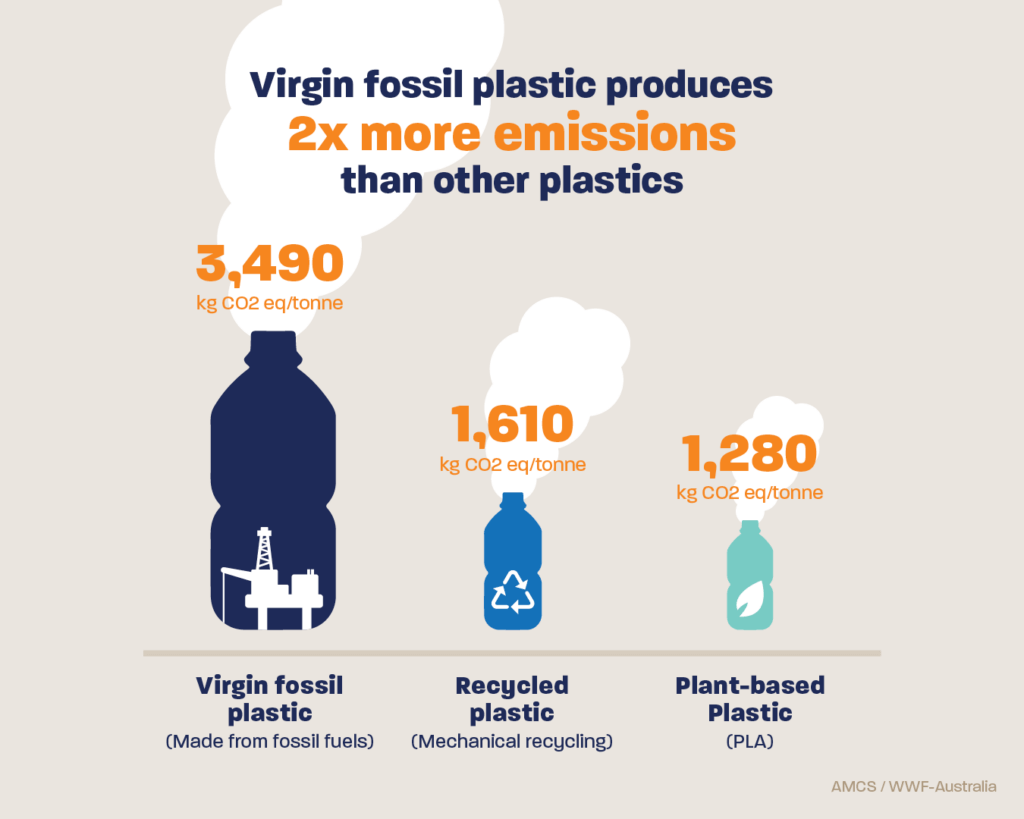
In Australia, we generate more single-use plastic waste per person than any other country except Singapore. The good news is that we can cut plastic consumption by 30% by 2040 through such approaches as banning plastic or increasing the use of reusables, before needing to substitute plastics with other materials.
AMCS Plastics Campaign Manager Shane Cucow said: “The findings are shockingly clear. We already knew runaway plastic use is creating mountains of waste and pollution, killing millions of animals every year through entanglement or ingestion. Now we have clear evidence it is also fuelling global warming, which is endangering our entire marine ecosystem.
“We must use less plastic, stop using fossil fuels to make it, and stop using fossil fuels as an energy source for plastic production and recycling. If we don’t, the emissions from plastic will only increase and exacerbate climate change.”
WWF-Australia No Plastics in Nature Policy Manager Kate Noble said: “We can’t rely on recycling solely to get us out of this mess; we need to drastically cut our plastic use and stop using virgin plastic made from fossil fuels. Even if we recycle 100% of the plastic we use, we’ll still see emissions double to more than 34 million tonnes annually by 2050.
“The good news is that we can reduce plastic waste and cut down the emissions from plastic at the same time. Reducing plastic consumption, combined with better design, using it longer, and managing it more responsibly, is the only way to bring our plastic addiction under control, and reduce the climate impacts of plastics at the same time.”
Cutting plastics emissions
The report modelled various scenarios including reducing plastics use, decoupling plastic production from fossil fuels, decarbonising energy systems globally, and significantly increasing recycling rates. Simply capping plastic production at current levels results in nearly a 40% fall in carbon emissions by 2050 relative to business as usual. Scenarios that solely rely on increasing recycling rates perform only marginally better than business as usual. Scenarios using renewable energy perform moderately well, and this is a key contributor to the combined scenarios that achieve high reductions in carbon emissions relative to BAU. Overall, the study findings strongly indicate that multiple complementary system level changes are required to significantly reduce the carbon emissions relating to plastics use.
Under a combined scenario, Australia could reduce the total emissions from its plastic use by up to 70% by 2050, with the greatest impact achieved by cutting plastics consumption by just 10%. We need to:
- use plastics more efficiently and cut total consumption by at least 10%,
- rapidly increase plastic recovery and recycling to 100%
- fully power plastics production and recycling with 100% renewable energy, and
- move away from virgin fossil-fuel based plastic entirely.
While these are ambitious goals that Australia is not currently equipped to meet, the report highlights the need for strong action on plastic consumption and waste management now, to avoid the growing waste, pollution and climate costs caused by skyrocketing plastic consumption.
Further findings
Greenhouse gas emissions from plastic production are higher than previously thought, due to substantive new research that indicates that methane from gas extraction and processing is at least 25-40% higher than estimates used by governments globally, which has been averaged to 32.5% for this report. This is likely to be an underestimate, with recent figures from the International Energy Agency putting the discrepancy at 70% higher than former estimates.
Manufacturing virgin fossil-fuel based plastics produces on average 3,490kg CO2e per tonne, more than double the emissions of producing new plastics through mechanical recycling (1,610kg CO2e/t) – 2.2 times the global warming potential (GWP) over GWP 20 years.
Fossil-fuel based plastics produce nearly three times the emissions to manufacture than plant-based plastics (1,280kg CO2e/t –2.7 times over GWP 20-year basis)
Incineration and burning plastics to produce energy are the most emissions intensive disposable methods for plastics.
Chemical recycling of plastics – where plastic waste is chemically treated to produce oil that can be used as fuel or remanufactured into plastic – is more emissions intensive than mechanical recycling, producing 67% more emissions than mechanical recycling.
Note: The emissions reduction scenarios modelled only refer to plastic emissions and do not consider the emissions of substituted products or other environmental harms caused by plastics. They are indicative projections only and further work is needed to identify technical pathways for reducing plastics consumption and increasing recovery.
The full report and report summary can be found at plasticemissions.org.au
Full report: Carbon emissions assessment of Australian plastics consumption – Project report
Summary report: Climate impacts of plastic consumption in Australia
Hungry Caterpillars: Synthetic Biology Holds The Key To Infinite Plastic Recycling
July 10, 2023
The powerful combination of a unique caterpillar research facility and Macquarie's synthetic biology expertise may be key to a novel method of recycling plastic.
When recycling business REDcycle wound up in November 2022, it emerged that 11,000 tonnes of plastics consumers had returned to supermarkets to be recycled were instead put into storage, due to a lack of recycling capacity.
Australians consume 1 million tonnes of single use plastic each year, with 90 per cent sent to landfill, and approximately 130,000 tonnes leaking into the marine environment. Unless something changes, by 2050, it is estimated that plastic in the oceans will outweigh fish.
But research underway at Macquarie University may hold the key to solving Australia’s growing plastic waste problem.
Microbiologist and ARC Future Fellow Associate Professor Amy Cain is collaborating with partners, including startup Samsara Eco, to develop an innovative approach to tackling plastic waste. She was awarded almost $675,000 in the latest funding round of the Australian Research Council’s Linkage Projects scheme to tackle polyurethane (PU) recycling.
“PU is ubiquitous in our lives, from lacquer coatings and elastane clothing to durable foam padding in car seats, cushions and mattresses,” Associate Professor Cain says.
“There are currently few avenues for recycling and much ends up in landfill.”
A single mattress, for example, produces 15-20 kilograms of PU foam waste.
“Currently, the only way of recycling the PU in mattresses, like the polyethylene in plastic bags, is to ‘upcycle’ them into limited products like benches. This can also only be done once as it downgrades the plastic integrity,” she says.
Fortunately, biodegradation of PU can occur naturally via various microbial means and from insects, such as Galleria mellonella (greater wax moth ) larvae.
When we fed household foams to caterpillars in the lab they munched through 95 per cent in under three days.
Associate Professor Cain is working with enviro-tech company Samsara Eco to understand plastic biodegradation and re-design and improve biologically active enzymes to break down the polymers in PU foams and sustainably recycle them into a variety of virgin plastics or biofuels.
“This process, which translates nature’s solutions into flexible and efficient synthetic enzyme technologies, will allow plastics to be infinitely recycled.”
The very hungry caterpillars
Associate Professor Cain’s research uses a mix of molecular discovery, microbe bioprospecting and synthetic biology.
“In recent years, bacteria have been identified in oil spills and other extreme environments, forced by evolution to develop the capacity to break down long carbon chains,” she says. More recently, a few insects, including wax moth caterpillars, have been identified as plastivores.
Macquarie University’s Applied Biosciences laboratories are home to Australia’s only fully-functional research facility for Galleria.
“Galleria caterpillars attack beehives in Europe and eat the wax which has a similar chemical structure to polyurethane, Associate Professor Cain explains.
“We are figuring out how they do what they do, picking out the relevant enzymes then creating platforms – in this case synthetic microbes – that eat the plastic more efficiently than the original.”
By working closely with the Centre of Excellence in Synthetic Biology, and with its director Distinguished Professor Ian Paulsen as a chief investigator on the linkage grant, the waste products of the process – carbon dioxide and water – are used as feedstock for other processes.

Sort it out: Associate Professor Amy Cain (pictured) says Australians are passionate recyclers but need to improve on separating plastic bottle tops and rings from bottles as these are different types of plastic.
Another priority research area is tackling polyurethane foams. Used in mattresses, car seats and cushions it is designed to be tough and is not currently recyclable, with a single mattress containing as much as 15 to 20 kilograms of foam.
“When we fed household foams to caterpillars in the lab they munched through 95 per cent in under three days," Associate Professor Cain says.
“The caterpillars’ appetite for plastics is so great that they will even eat right through plastic cages, and have to be kept under lock and key in glass and metal enclosures.
"Once we fully understand how they are doing this, we will take out the active component and create a safe, synthetic microbe that can be scaled up to become industrially relevant.”
More bins, less landfill
The great thing about these technologies is that they are more scalable than current industrial methods, she says.
Recycling aluminium for example, requires a lot of energy and significant carbon input. The process uses large plants that can’t be scaled down.
“Enzyme technologies, however, don’t need to melt anything – they will attack any plastic, as long as it’s clean, meaning they can be used on an industrial scale or in a benchtop bucket at home.
“Australians are very passionate about recycling, but we need to get better at sorting – for example separating plastic bottle tops and rings from bottles as these are different types of plastic.”
In Switzerland, she says, there are 17 different recycling bins, which leads to very efficient recycling.
“We still have a long way to go before we reach that.”
Associate Professor Cain has been working on plastics recycling for four years and says the field has recently become much more active, supported by government policy and consumer priority.
“Samsara Eco is a great case study of how the appetite for change and technology have come together. The company began in 2020 as a startup and, following a $54 million grant, is building a plastics recycling factory in Melbourne.
“In 2022 Samsara Eco recycled all of the water bottles used in the Australian Open, and is now partnering with Woolworths, as well as Macquarie, on infinite recycling.”
Microbiologist and ARC Future Fellow Amy Cain is an Associate Professor in the School of Natural Sciences, Macquarie University.

Galleria mellonella, the greater wax moth or honeycomb moth, is a moth of the family Pyralidae. G. mellonella is found throughout the world. It is one of two species of wax moths, with the other being the lesser wax moth. G. mellonella eggs are laid in the spring, and they have four life stages. Males are able to generate ultrasonic sound pulses, which, along with pheromones, are used in mating. The larvae of G. mellonella are also often used as a model organism in research.
The greater wax moth is well known for its parasitisation of honeybees and their hives. Because of the economic loss caused by this species, several control methods including heat treatment and chemical fumigants such as carbon dioxide have been used.
The caterpillar of G. mellonella has attracted interest for its ability to degrade polyethylene plastic.
Drones are disturbing critically endangered shorebirds in Moreton Bay, creating a domino effect
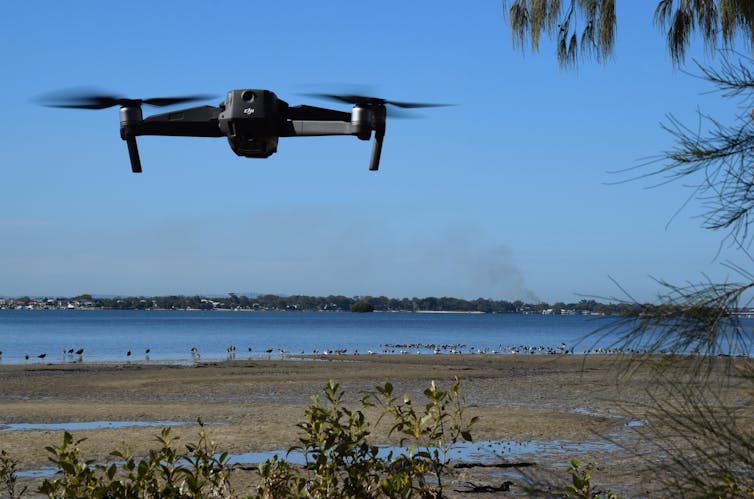
Drones are increasingly swarming our skies, capturing images, managing crops and soon, delivering packages. But what do the birds make of this invasion of their territory?
With strict animal ethics approval, we flew drones towards flocks of birds in Queensland’s Moreton Bay. We found many species were not disturbed, provided the drone was small and flew above 60m.
The exception was the critically endangered eastern curlew, which became alarmed and flew away – even when a tiny drone approached at the maximum legal altitude of 120m. But when the eastern curlew took flight, other nearby species were often startled, creating a domino effect that eventually caused the whole flock to take flight.
Drone disturbance can interrupt birds as they rest or feed. It can even cause them to avoid some locations altogether. If birds are consistently interrupted or scared away from their preferred habitats, they may find it difficult to eat and rest enough to survive and reproduce. This is particularly concerning for species such as the eastern curlew, which migrate thousands of kilometres to breed.
Yet Another Threat To Shorebirds
We studied a diverse group of birds typically found along coastlines, known as shorebirds. Heartbreakingly, their global population has plummeted as they continue to battle habitat destruction, sea level rise, disturbance and hunting.
The last few decades have been bleak for the eastern curlew, which is the world’s largest migratory shorebird. Research in 2011 indicated a population decline of 80% over three generations.
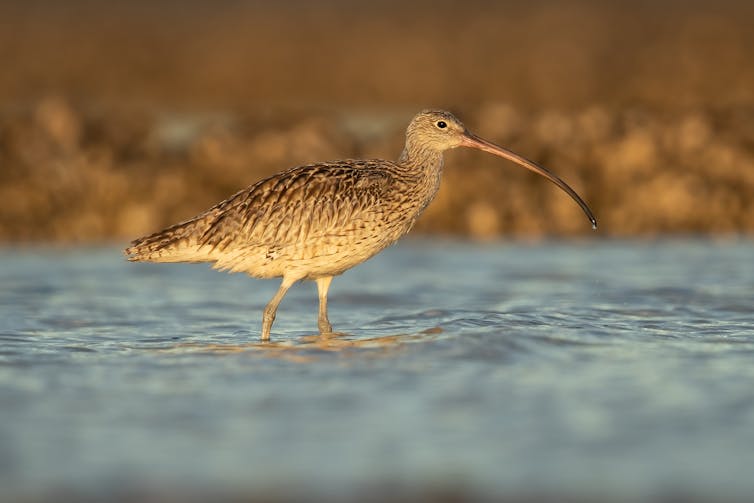
While drones are unlikely to have played a major role in shorebird decline so far, our results, combined with the increasing presence of drones along our coastline, indicate they could become yet another source of disturbance for these birds, many of which are already endangered.
Use With Care
At the same time, drones have proven to be a valuable tool. They’ve been used to plant trees, deliver healthcare in developing countries, and have even proven useful for bird conservation.
Drones can observe birds in places that are hard to reach on foot, such as birds of prey nesting in tree tops, or seabirds feeding on tidal inlets. In some cases, they can even be more accurate compared to traditional ground-based survey methods.
Shorebirds spread out across vast mudflats to feed, making it very difficult to survey them on foot and identify critical foraging habitats. Our research has shown that, for certain species, drones may overcome this barrier, providing information that may be pivotal in arresting shorebird population declines.
Drones can be beneficial in many ways, but we must identify when and how drones can be used to minimise potential harm. In some locations, such as some Australian national parks, drone use is already prohibited or restricted. But managers need to understand how drones affect wildlife to inform these regulations.
Our findings provide clear-cut parameters around how much space to give birds to keep drone disturbance to a minimum. In most cases this is about 60m, but it can vary significantly between species. For the eastern curlew, we don’t recommend approaches within 250m, even with small drones.
The Moreton Bay Marine Park, where this research was undertaken, is the single most important site in Australia for the eastern curlew. Disturbing shorebirds within the marine park is an offence that can result in fines. The Queensland Parks and Wildlife Service has already used our findings to place conditions on research projects and media activities involving drones.
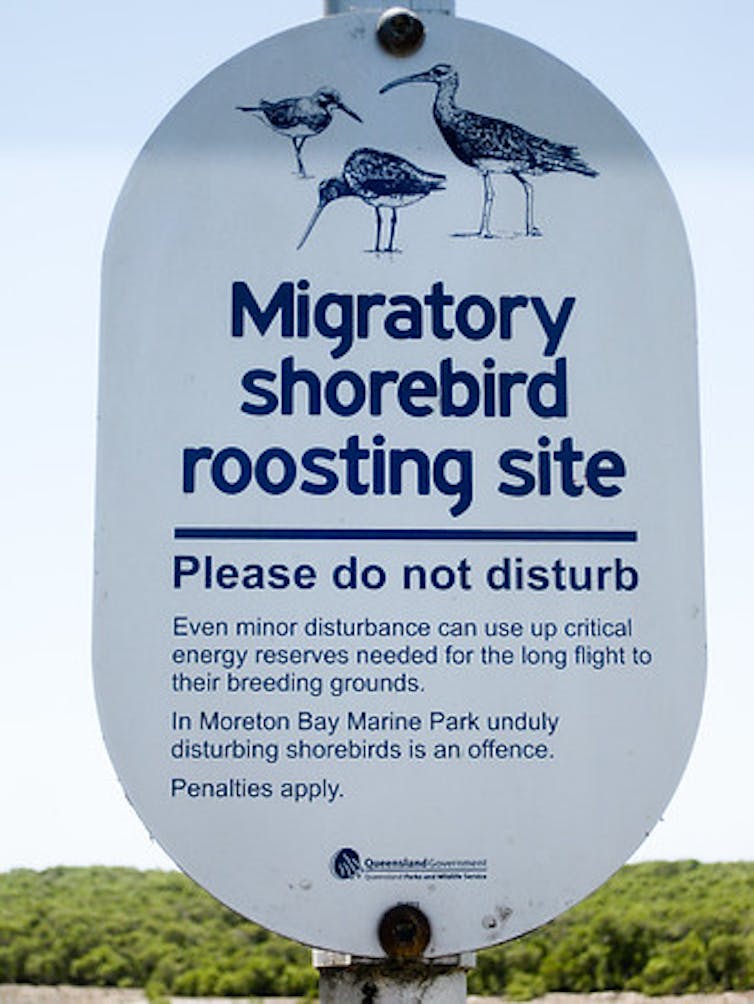
Sharing The Skies
We recommend organisations with influence on this issue, such as the Civil Aviation Safety Authority and national parks authorities, regulate drone use near bird flocks – especially those containing at-risk and highly sensitive species.
We also encourage those researchers considering adding drones to their conservation toolkit to carefully evaluate the risk of disturbance before using them to conduct wildlife surveys.
By understanding how shorebirds react to drones, we can inform effective and efficient management actions. Regulating drone use near critical shorebird habitats will help us to avoid exacerbating population declines, while still allowing the use of a valuable tool, where appropriate.
Hopefully, through small steps like this we can arrest the decline of shorebird populations, ensuring we can continue to share our shorelines with these beautiful birds for generations to come.
This research was supported by The Moreton Bay Foundation and the Queensland Wader Study Group. It was conducted under strict ethical clearance with the purpose of benefiting the birds with the knowledge gained.![]()
Joshua Wilson, PhD Candidate, The University of Queensland
This article is republished from The Conversation under a Creative Commons license. Read the original article.
Human-Made Materials In Nests Can Bring Both Risks And Benefit For Birds
July 9, 2023
We all discard a huge amount of plastic and other human-made materials into the environment, and these are often picked up by birds. New research has shown that 176 bird species around the world are now known to include a wide range of anthropogenic materials in their nests. All over the world, birds are using our left-over or discarded materials. Seabirds in Australia incorporate fishing nets into their nests, ospreys in North America include baler twine, birds living in cities in South America add cigarette butts, and common blackbirds in Europe pick up plastic bags to add to their nests.
This material found in birds' nests can be beneficial say researchers. For example, cigarette butts retain nicotine and other compounds that repel ectoparasites that attach themselves to nestling bird's skin and suck blood from them. Meanwhile, there are suggestions that harder human-made materials may help to provide structural support for birds' nests, while plastic films could help provide insulation and keep offspring warm. Despite such potential benefits, it is important to remember that such anthropogenic material can also be harmful to birds.
This research was published in a special issue of the Philosophical Transactions of the Royal Society B on "The evolutionary ecology of nests: a cross-taxon approach." The special issue was jointly organised by Mark Mainwaring, a Lecturer in Global Change Biology in the School of Natural Sciences at Bangor University.
Mark Mainwaring said, "The special issue highlights that the nests of a wide range of taxa -- from birds to mammals to fish to reptiles -- allow them to adapt to human-induced pressures. Those pressures range from the inclusion of anthropogenic materials into their nests through to providing parents and offspring with a place to protect themselves from increasingly hot temperatures in a changing climate."
Anthropogenic materials sometimes harm birds. Parents and offspring sometimes become fatally entangled in baler twine. Meanwhile, offspring sometimes ingest anthropogenic material after mistaking it for natural prey items. Finally, the inclusion of colourful anthropogenic materials into nests attracts predators to those nests who then prey upon the eggs or nestlings. This means that we need to reduce the amount of plastic and other anthropogenic material that we discard.

This stork chick has its foot caught in plastic rope in the nest. Photo Credit: Zuzanna Jagiello
The lead author of the study, Zuzanna Jagiełło who is based at the Poznań University of Life Sciences in Poland, added, "A wide variety of bird species included anthropogenic materials into their nests. This is worrying because it is becoming increasingly apparent that such materials can harm nestlings and even adult birds."
The second author of the study, Jim Reynolds, a researcher in the Centre for Ornithology at the University of Birmingham in the UK, remarked,
"In a rapidly urbanising world which we share with many different animal taxa, it is not surprising that birds use our discarded materials in their nests. Although much needs to be understood about how plastics, for example, impact birds, it is exciting that birds, through their high mobility and breeding biology, may prove to be potent biomonitors of environmental anthropogenic material pollution."
Zuzanna Jagiello, S. James Reynolds, Jenő Nagy, Mark C. Mainwaring, Juan D. Ibáñez-Álamo. Why do some bird species incorporate more anthropogenic materials into their nests than others? Philosophical Transactions of the Royal Society B: Biological Sciences, 2023; 378 (1884) DOI: 10.1098/rstb.2022.0156
Beak Shape Can Predict Nest Material Use In The World's Birds
July 9, 2023
The material a bird selects for its nest depends on the dimensions of its beak, according to researchers.
Using data on nest materials for nearly 6,000 species of birds, a team based at the University of Bristol and the University of St Andrews utilised random forest models, a type of machine learning algorithm, to take data from bird beaks and try to predict what nest materials that species might use.
They found a surprisingly strong correlation. Using only information on beak shape and size, they were able to correctly predict broad nest material use in 60% of species, rising to 97% in some cases.
These findings, published today in Philosophical Transactions of the Royal Society B, include a careful exploration of these models, investigating the ecological and evolutionary context behind these relationships. For example, not every species has the same access to all nest material types, which also affects these results.


A Zebra Finch (Taeniopygia guttata) handling nest material. A Mute Swan (Cygnus olor) building a nest. Photos credit: Shoko Sugasawa
The study's lead author, Dr Catherine Sheard of Bristol's School of Earth Sciences said: "We know a lot about primate hands, but not as much about how other animals use their limbs and mouths to manipulate objects. We've very excited about the potential applications of our findings, to further explore how beak shape may have co-evolved with other aspects of nest building or other functions."
Dr Shoko Sugasawa, senior author of the study, based at the University of St Andrews, added: "Most animals, including birds, do not have hands like ours, but manipulating objects like nest material and food is such a crucial part of their lives. Our finding is the first step to reveal possible interactions between the evolution of beaks and manipulation like nest building, and helps us better understand how animals evolved to interact with the world with or without hands."
The team are now working on a project documenting anthropogenic nest material in the world's birds, trying to understand what type of birds put human-made material (like plastic, wire, or cigarette butts) in their nests. They are in particular looking to see whether this would be linked to urban-dwelling birds.
"I'm also interested in how beak shape relates to other properties of the nest, including overall nest structure," added Dr Sheard, "such as whether birds build nests with walls, or a roof."
Catherine Sheard, Sally E. Street, Caitlin Evans, Kevin N. Lala, Susan D. Healy, Shoko Sugasawa. Beak shape and nest material use in birds. Philosophical Transactions of the Royal Society B: Biological Sciences, 2023; 378 (1884) DOI: 10.1098/rstb.2022.0147
New Australian laws for ‘engineering’ the ocean must balance environment protection and responsible research

The Australian Labor government has introduced a bill to regulate “marine geoengineering” – methods to combat climate change by intervening in the ocean environment.
The bill would prohibit listed marine geoengineering activities without a permit.
Scientists are already experimenting with ways to store more carbon in the ocean or shield vulnerable ecosystems. They include ocean fertilisation and marine cloud brightening. But these proposals are yet to be deployed beyond small-scale outdoor tests. Further research is needed.
These technologies offer huge potential to combat climate change. But large-scale marine geoengineering could also cause harm. Targeted laws are needed to both enable crucial research and protect the marine environment. So does the bill to amend the Sea Dumping Act strike the right balance?
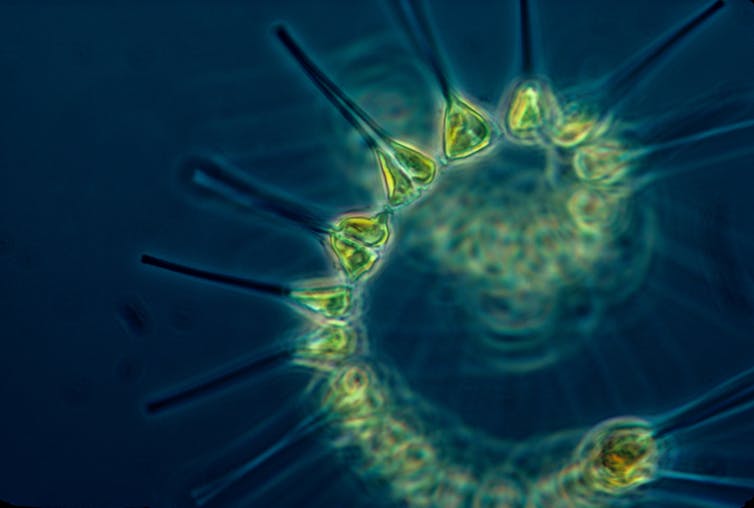
Getting To Grips With Marine Geoengineering
Interest in marine geoengineering has grown over several decades as the climate crisis has worsened. Removing CO₂ from the atmosphere is now necessary to achieve “net-zero” emissions and limit global warming to 1.5℃. But marine geoengineering proposals also present risks to the marine environment.
The Southern Ocean – which extends from Australia’s southern coast to Antarctica – has been identified as a suitable location for ocean fertilisation. This involves feeding iron dust to marine algae. Through the process of photosynthesis, the algae pull CO₂ from the atmosphere, which is potentially stored in the deep ocean.
Another proposal is modifying acidity in oceans. Oceans naturally absorb large amounts of CO₂, which is making the water more acidic. Ocean acidification harms marine life, especially animals with shells. It also limits the amount of CO₂ that can be stored. A technology that essentially adds “antacids” to the ocean“ could help counteract this and enable the oceans to store more.
Other proposals seek to reduce the damage from marine heatwaves. "Marine cloud brightening” seeks to limit coral bleaching on the Great Barrier Reef, by spraying sea-salt particles into clouds. The idea is to make the clouds whiter, to better reflect sunlight away from the ocean and limit further warming of the water.
With help, the oceans could play an even bigger role in stabilising the climate. But there are concerns about unintended consequences of deliberately intervening. For example, ocean fertilisation could decrease water oxygen levels and “rob” neighbouring waters of nutrients, reducing marine productivity.
Marine geoengineering could also distract from efforts to cut emissions at source.
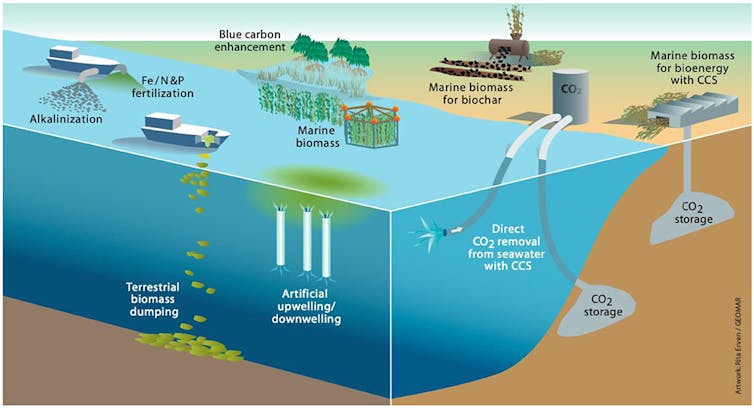
Strong Rules To Protect The Marine Environment
With this new bill, the Australian government has taken an important first step towards regulating marine geoengineering.
The bill involves proposed amendments to the Environment Protection (Sea Dumping) Act. It would introduce a permit system for legitimate scientific research activities.
Environment Minister Tanya Plibersek has said of the bill:
Regulating this type of activity, though a robust application, assessment and approval permitting process, would ensure that only legitimate scientific research activities exploring options to reduce atmospheric CO₂ can proceed. This amendment also provides for regulating other potentially harmful marine geoengineering research activities should they emerge in the future.
The bill implements Australia’s international obligations under the London Protocol, a marine pollution treaty that prohibits the dumping of waste at sea without a permit.
It follows a parliamentary inquiry that recommended Australia ratify these international rules. Australia’s support may encourage other countries to adopt these rules and make them legally binding.
Countries negotiated these rules in response to plans by private companies in the 2000s to conduct ocean fertilisation for profit. They decided new international rules were needed to protect the ocean. Currently, only ocean fertilisation is listed, and hence regulated, under these rules. But other activities may be listed in future.
The bill makes it an offence to place matter into the ocean for marine geoengineering without a permit. Permits may only be granted for scientific research activities. At present, these rules apply just to ocean fertilisation, as it is the only activity listed under the London Protocol.
If the bill is passed as it currently stands, commercial deployment of marine geoengineering cannot be conducted either in Australian waters or from Australian vessels.
Harsh criminal penalties will apply to people who conduct marine geoengineering without a permit. Offenders face 12 months imprisonment and/or a fine of up to $68,750.
The bill also establishes offences for loading and exporting material to be used for marine geoengineering without a permit.
Rules Limit Financial Incentives For Research
Prohibiting marine geoengineering deployment may be appropriate now. But without future prospects for deployment there may be little incentive to invest in research.
The treaty rules ban ocean-based research directly leading to financial and/or economic gain. This protection is important for building public trust and advancing the public interest. But broad prohibition could hamper marine geoengineering research for economic purposes such as eventual carbon crediting and trading. It could also call into question government subsidies and tax incentives encouraging private research investment.
The parliamentary inquiry did not consider the implications of the new rules for Australia’s carbon markets, or on research to save the Great Barrier Reef.
Changes Could Affect Research To Save The Reef
Since 2019, the Australian government has invested in marine cloud brightening and other interventions to protect the reef from heat stress and coral bleaching. The first outdoor experiments were conducted in 2020.
The effectiveness of marine cloud brightening is yet to be demonstrated at scale. But modelling suggests a combination of marine cloud brightening and crown-of-thorns starfish control could help protect the reef until 2040.
The treaty rules do not currently apply to marine cloud brightening. However, countries are currently considering adding marine cloud brightening to the list of regulated activities. This could allow research but prohibit deployment. The government should evaluate how this could affect its investment in marine cloud brightening research and associated programs.
Australia’s marine environment is already suffering from warming and acidification. Appropriately-managed marine geoengineering activities may help reduce the damage and/or mitigate climate change.
The treaty’s environmental safeguards are important to ensure the risks from ocean fertilisation activities are rigorously evaluated.
The current bill favours risk management, which is appropriate at the early stages of research and development. But by ruling out future deployment, Australia may undermine incentives to advance research. ![]()
Kerryn Brent, Senior Lecturer, Adelaide Law School, University of Adelaide; Jan McDonald, Professor of Environmental Law, University of Tasmania, and Manon Simon, Research Fellow, University of Tasmania
This article is republished from The Conversation under a Creative Commons license. Read the original article.
Small ocean critters use their poo to help seaweeds have sex
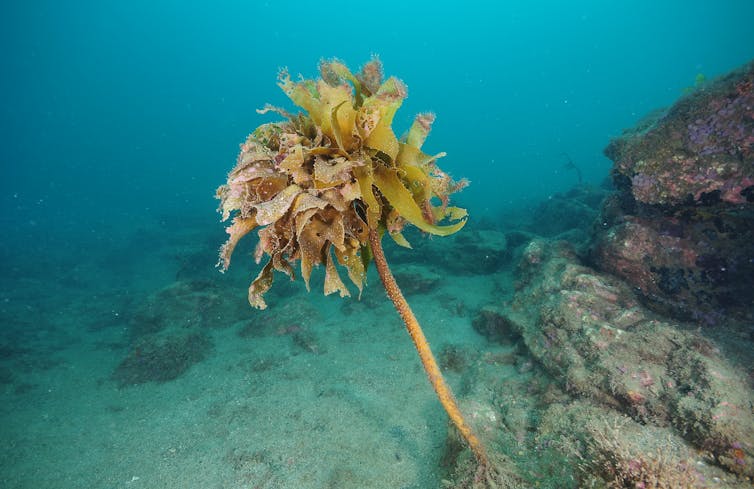
Finding a good partner in life is a tricky endeavour, so imagine how much more difficult this task becomes when you’re rooted in the ground.
For most land plants, the inability to move means they have to find clever ways of transporting fertile material to suitable mates. In the millions of years it took for land plants to evolve, they developed intricate and unique relationships with animals that have allowed them to successfully colonise almost every landmass on the planet.
Think of flowers luring in pollinators with the sweet scent of nectar, bristly seedpods travelling on the fur of passing animals, or seeds passing through the digestive tracts of birds and grazers to germinate in their poo.
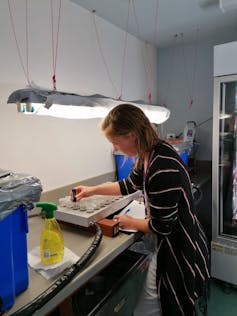
These animal-plant interactions are often mutually beneficial, or “mutualistic”. The animal gets a reward in the form of fruit or nectar, while the plant gets to disperse its pollen or seeds over a much greater distance than it would have achieved alone.
Mutualism between plants and the animals that eat them was thought to be a unique adaptation to life on land. Underwater, movement from currents and buoyancy take care of the dispersal and fertilisation of seaweeds and marine plants. Seaweeds don’t need animals to spread their seed far and wide – or so it was thought.
Our new research challenges this assumption by showing examples of mutualism among seaweeds and animals. It adds to a growing body of evidence that suggests the ability to use animals to fertilise, and spread fertile material, may not be exclusive to land plants.
From Spore To Kelp
Last year, researchers at the Sorbonne University found that isopods (marine invertebrates about 2-4cm in length) can increase fertilisation success in the red seaweed Gracilaria.
As the isopods feed on small algae growing on the red seaweed, seaweed sperm attaches to their bodies. They then carry this sperm to female seaweeds, which can fertilise exposed eggs. In return, the isopods get a meal and protection from predators.
This year, our team found several examples of how much larger seaweeds have sex with the help of tiny animals.
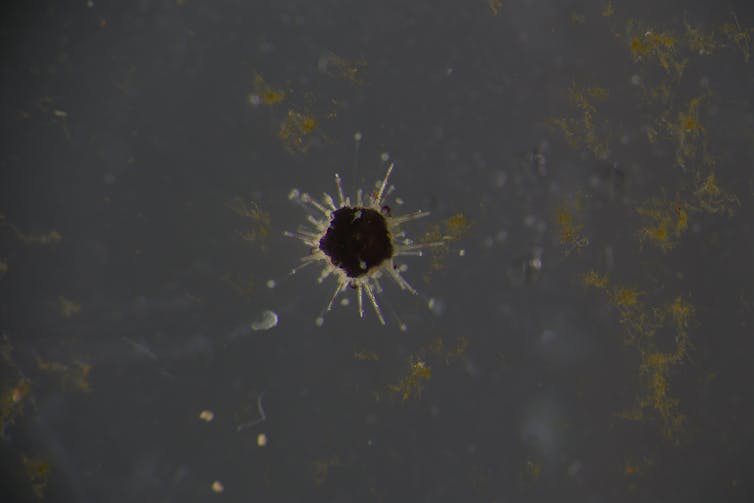
Kelps are the largest seaweeds in our coastal environments. They provide habitat and shelter for many other species – but their reproduction has been somewhat of a mystery.
They have what is called a biphasic life cycle, where two separate living organisms alternate to complete the life cycle. The organisms that form their reproductive life stage are called gametophytes.
Gametophytes grow from spores released by adults. Male and female gametophytes make sperm and eggs, and when they fertilise they produce baby kelp that develop into adults.
However, gametophytes are microscopic in size (about 0.5mm). Being this small, you might imagine finding another gametophyte to fertilise would require incredible luck. After all, the ocean is very large, and gametophytes need to be as close as 1mm to fertilise successfully.
It has been assumed gametophytes must exist in high densities in the ocean, and this is why successful fertilisation occurs.
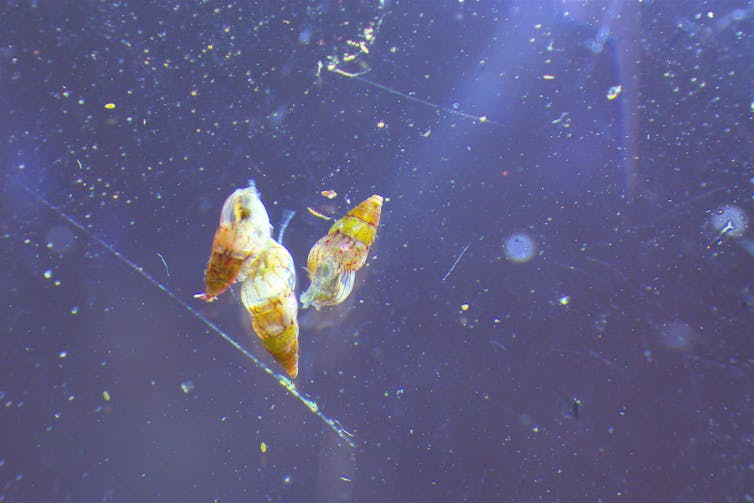
Fertilisation Through Poo
Initially, our team was curious about whether tiny grazers would suppress fertilisation success in kelps by eating gametophytes.
Adult invertebrate grazers, such as snails and urchins, can drastically damage kelp forests. So we wanted to find out if juveniles played a similar role. To our surprise, we found the opposite.
For our research, we fed gametophytes to juveniles of two urchin species, Tripneustes gratilla and Centrostephanus rodgersii, as well as the micro-snail Anachis atkinsoni.
We found the gametophytes could survive through the grazers’ intestinal tracts. We kept the pooed-out gametophytes for a few weeks, and eventually noticed lots of baby kelps growing from the the poo of Tripneustes gratilla and Anachis atkinsoni. We’re not sure why there were no baby kelps growing from the poo of Centrostephanus rodgersii (a species that overgrazes kelps in Tasmania).
Moreover, none of the gametophytes kept outside of the poo were fertilised. This means being eaten by tiny critters, and ending up in their poo, is somehow beneficial for kelp sex.
We don’t know exactly why this is. We think it may be due to increased proximity of gametophytes through ingestion, or the effect of some chemical cue from the poo itself.
Where Did Animal-Mediated Reproduction Begin?
Finding repeated examples of animal-mediated fertilisation in the ocean indicates this process might have originated underwater and not, as previously thought, on land.
In evolutionary terms, seaweeds are a lot older than land plants. So perhaps the unique relationship between animals and seaweed reproductive biology was passed on to land plants.
Alternatively, it could be animal-mediated fertilisation independently evolved multiple times throughout plant evolution, both on land and underwater.
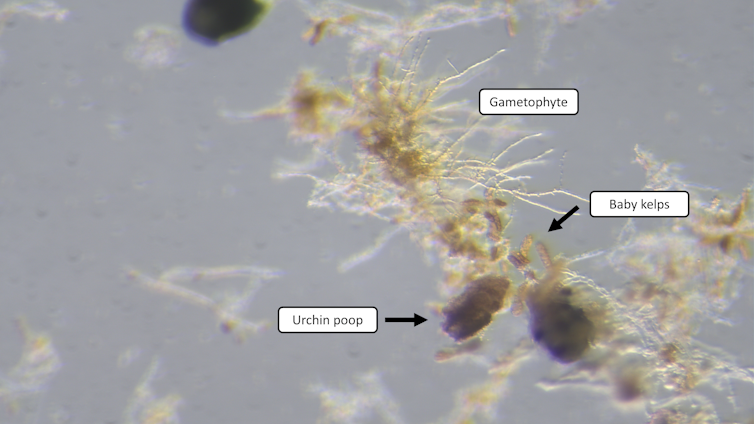
In either case, our findings are changing the way we look at seaweed-herbivore interactions. Seaweed grazers often get a bad rap for causing devastating loss in kelp and seaweed habitats.
Here, we highlight a positive impact: a grazer-seaweed story with a happy ending! Small grazers may fulfil an important role in seaweed reproduction, by making sure microscopic gametophytes in the big ocean can find each other and make babies.
In the end, it’s all about sex! Seaweed sex, that is …![]()
Reina Veenhof, PhD Candidate in kelp ecology, Southern Cross University; Curtis Champion, Research Scientist, Southern Cross University; Melinda Coleman, Adjunct Professor, Southern Cross University and Associate Professor, School of Biological Sciences, The University of Western Australia, and Symon Dworjanyn, Professor of Marine Ecology and Aquaculture, Southern Cross University
This article is republished from The Conversation under a Creative Commons license. Read the original article.
Why are so many climate records breaking all at once?

In the past few weeks, climate records have shattered across the globe. July 4 was the hottest global average day on record, breaking the new record set the previous day. Average sea surface temperatures have been the highest ever recorded and Antarctic sea ice extent the lowest on record.
Also on July 4, the World Meteorological Organization declared El Niño had begun, “setting the stage for a likely surge in global temperatures and disruptive weather and climate patterns”.
So what’s going on with the climate, and why are we seeing all these records tumbling at once?
Against the backdrop of global warming, El Niño conditions have an additive effect, pushing temperatures to record highs. This has combined with a reduction in aerosols, which are small particles that can deflect incoming solar radiation. So these two factors are most likely to blame for the record-breaking heat, in the atmosphere and in the oceans.

It’s Not Just Climate Change
The extreme warming we are witnessing is in large part due to the El Niño now occurring, which comes on top of the warming trend caused by humans emitting greenhouse gases.
El Niño is declared when the sea surface temperature in large parts of the tropical Pacific Ocean warms significantly. These warmer-than-average temperatures at the surface of the ocean contribute to above-average temperatures over land.
The last strong El Niño was in 2016, but we have released 240 billion tonnes of CO₂ into the atmosphere since then.
El Niño doesn’t create extra heat but redistributes the existing heat from the ocean to the atmosphere.

The ocean is massive. Water covers 70% of the planet and is able to store vast amounts of heat due to its high specific heat capacity. This is why your hot water bottle stays warm longer than your wheat pack. And, why 90% of the excess heat from global warming has been absorbed by the ocean.
Ocean currents circulate heat between the Earth’s surface, where we live, and the deep ocean. During an El Niño, the trade winds over the Pacific Ocean weaken, and the upwelling of cold water along the Pacific coast of South America is reduced. This leads to warming of the upper layers of the ocean.
Higher than usual ocean temperatures along the equator were recorded in the first 400m of the Pacific Ocean throughout June 2023. Since cold water is more dense than warm water, this layer of warm water prevents colder ocean waters from penetrating to the surface. Warm ocean waters over the Pacific also lead to increased thunderstorms, which further release more heat into the atmosphere via a process called latent heating.
This means that the build up of heat from global warming that had been hiding in the ocean during the past La Niña years is now rising to the surface and demolishing records in its wake.

An Absence Of Aerosols Across The Atlantic
Another factor likely contributing to the unusual warmth is a reduction in aerosols.
Aerosols are small particles that can deflect incoming solar radiation. Pumping aerosols into the stratosphere is one of the potential geoengineering methods that humanity could invoke to lessen the impacts of global warming. Although stopping greenhouse gas emissions would be much better.
But the absence of aerosols can also increase temperatures. A 2008 study concluded that 35% of year-to-year sea surface temperature changes over the Atlantic Ocean in Northern Hemisphere summer could be explained by changes in Saharan dust.
Saharan dust levels over the Atlantic Ocean have been unusually low lately.
On a similar note, new international regulations of sulphur particles in shipping fuels were introduced in 2020, leading to a global reduction in sulphur dioxide emissions (and aerosols) over the ocean. But the long-term benefits of reducing shipping emissions far outweighs the relatively small warming effect.
This combination of factors is why global average surface temperature records are tumbling.
Are We At The Point Of No Return?
In May this year, the World Meteorological Organization declared a 66% chance of global average temperatures temporarily exceeding 1.5℃ above pre-industrial levels within the next five years.
This prediction reflected the developing El Niño. That probability is likely higher now, since El Niño has developed.
It is worth noting that temporarily exceeding 1.5℃ does not mean we have reached 1.5℃ by the Intergovernmental Panel on Climate Change standards. The latter describes a sustained average global temperature anomaly of 1.5℃, rather than a single year, and is likely to occur in the 2030s.
This temporary exceedance of 1.5℃ will give us an unfortunate preview of what our planet will be like in the coming decades. Although, younger generations may find themselves dreaming of a balmy 1.5℃ given current greenhouse emissions policies put us on track for 2.7℃ warming by the end of the century.
So we are not at the point of no return. But the window of time to avert dangerous climate change is rapidly shrinking, and the only way to avert it is by severing our reliance on fossil fuels.![]()
Kimberley Reid, Postdoctoral Research Fellow in Atmospheric Sciences, Monash University
This article is republished from The Conversation under a Creative Commons license. Read the original article.
Climate change threatens to cause ‘synchronised harvest failures’ across the globe, with implications for Australia’s food security
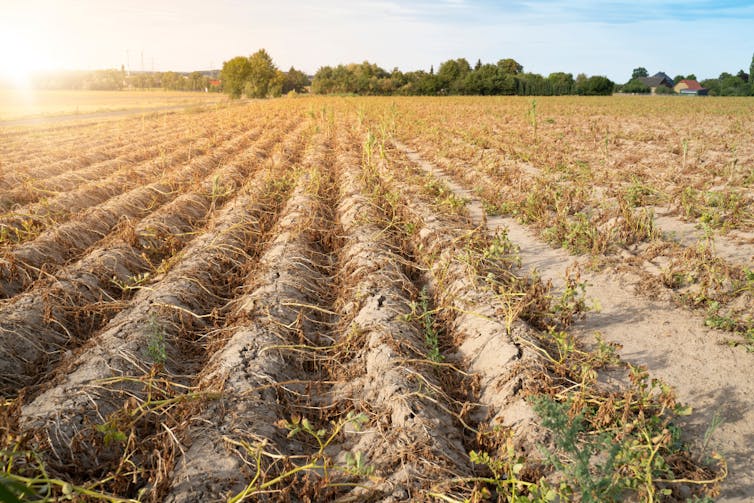
New research shows scientists have underestimated the climate risk to agriculture and global food production. Blind spots in climate models meant “high-impact but deeply-uncertain hazards” were ignored. But now that the threat of “synchronised harvest failures” has been revealed, we cannot ignore the prospect of global famine.
Climate change models for North America and Europe had previously suggested global warming would increase crop yields in the short term. Those regional increases were expected to buffer losses elsewhere in global food supply.
But new evidence suggests climate-related changes to fast flowing winds in the upper atmosphere (the jet stream) could trigger simultaneous extreme weather events in multiple locations, with serious implications for global food security.
I have been examining opportunities to manage agricultural risk for 25 years. Much of that work involves learning how agricultural systems can be made more resilient, not only to climate change but to all shocks. This involves understanding the latest science as well as working with farmers and decision-makers to make appropriate adjustments. As the evidence on climate risk mounts, it’s clear Australia must urgently adapt and rethink our approach to global trade and food security.
Building Resilience To Shocks
Unfortunately, the global food system is not resilient to shocks at the moment. Only a few countries such as Australia, the US, Canada, Russia and those in the European Union produce large food surpluses for international trade. Many other countries are dependent on imports for food security.
So, if production declines rapidly and simultaneously across big exporting countries, supply will decrease and prices will increase. Many more people will struggle to afford food.
The prospect of such synchronised harvest failures across major crop-producing regions emerges during northern hemisphere summers featuring “meandering” jet streams. When the path of these fast flowing winds in the upper atmosphere shifts in a certain way, the likelihood of extreme events such as droughts or floods increases.
The researchers studied five key crop regions that account for a large part of global maize and wheat production. They compared historical events and weather to modelling. Yield losses were mostly underestimated in standard climate models, exposing “high-impact blind spots”. They conclude that their research “manifests the urgency of rapid emission reductions, lest climate extremes and their complex interactions […] become unmanageable”.
Free Trade Or Food Sovereignty
Australia has been a big advocate for free trade, reducing barriers to trade such as tariffs and quotas. But the new research revealing the climate risk to food security should trigger a change in policy.
We have already experienced the limitations of an over-reliance on trade to access food. The system has wobbled during the COVID pandemic and the global financial crisis of 2008, when millions of people were thrown back into food insecurity and poverty.
Encouraging free trade in agriculture has not significantly improved global food security. In 1995, the World Trade Organisation implemented the Agreement on Agriculture to liberalise agricultural trade. That agreement constrained the ability of national governments to protect their agricultural industries, and many more people have become food insecure since its introduction.
Australia needs to reconsider its short-term focus on the advantages of selling goods internationally. Conceptualising food more as a human right than a commodity might initiate such a shift.
The global poor do not have the buying power to influence market demand and increase food supply for their benefit. As they face hardship, many are becoming angry, sparking conflict and undermining food security further.
The long-term goal needs to be a global food system that will be resilient to shocks, including climate change. Trade policy may need to respond by allowing governments to prioritise sovereign food security in a world dominated by risk.

Huge Implications For Australia
Prior to the COVID pandemic, the Australian Bureau of Agriculture and Resource Economics was spruiking the nation’s food security. But it isn’t that simple. Even though there has been a lot of food available across Australia since early 2020, access has declined. Local food insecurity increased as the pandemic disrupted supply chains, with rising poverty on one hand and inflation on the other.
Climate change risks are likely to dwarf the impacts of COVID on Australian food systems.
Australian agriculture is highly exposed to climate change because rainfall and temperatures are so strongly influenced by El Niño. The drying phase of the El Niño Southern Oscillation is expected to strengthen with climate change.
As atmospheric circulation changes, global weather patterns are shifting towards the poles. This is partly why early modelling of climate change in the cold-constrained agricultural systems of North America projected production would increase with global warming. But not anymore.
In Australia, modelling has rarely suggested the country would benefit from climate change. The Murray-Darling Basin, the heart of the nation’s food bowl, is expected to suffer warming, drying, reduced streamflow and more extreme events.
Australian agriculture is also highly sensitive to climate shocks because it is mostly rainfed – literally dependent on water that falls from the sky. Projected increases in droughts, evaporation and reduced average rainfall are going to challenge production systems.
Recent floods have also had shown how extreme weather events can have widespread impacts on agriculture and food prices. La Niña “rain bombs” (flash flooding from short duration, heavy rainfall events) damaged oranges and mandarin crops in 2022, downgrading produce.
To reduce the risk we need to adapt. Until recently, it was only rising land prices that enabled many Australian agribusinesses to remain viable for long periods of poor terms of trade.
Australian agriculture’s ability to withstand shocks relies on a range of structural factors that need more recognition, including:
our research and development capacity, which has been eroding with stagnant public investment
the sustainable management of key resources, such as the waters of the Murray-Darling and high-quality agricultural land, both of which we have struggled to protect
the resilience of farming communities, even though many are lacking key services and support.
A Lucky Country Facing Turbulent Times
Australia is fortunate to be one of the few countries that produces more food than it needs, but it has other responsibilities towards global food security. Policy will need to respond to the new understanding of how food security will be affected by climate change.
There are a number of ways Australia could respond to the new evidence. To drive that change, there needs to be a new level of awareness of the true extent of the risks to agriculture.
On a global scale, governments may need to rethink their strong advocacy for food trade liberalisation.
Locally, Australia will need to invest in adaptation to ensure that agriculture, and our food systems more broadly, are resilient to the gathering storm, because this one will be like nothing we have ever seen.![]()
Douglas Bardsley, Associate professor, University of Adelaide
This article is republished from The Conversation under a Creative Commons license. Read the original article.
China is pumping out carbon emissions as if COVID never happened. That’s bad news for the climate crisis
David Stern, Crawford School of Public Policy, Australian National University and Khalid Ahmed, Australian National UniversityCarbon emissions from China are growing faster now than before COVID-19 struck, data show, dashing hopes the pandemic may have put the world’s most polluting nation on a new emissions trajectory.
We compared emissions in China over the first four months of 2019 – before the pandemic – and 2023. Emissions rose 10% between the two periods, despite the pandemic and China’s faltering economic recovery. Power generation and industry are driving the increase.
Under the Paris Agreement, China has pledged to ensure carbon emissions peak by 2030 and reach net zero emissions by 2060. Our analysis suggests China may struggle to reach these ambitious goals.
Many believed the economic recovery from COVID would steer global development towards a less carbon-intensive footing. But China’s new path seems to be less sustainable than before. That’s bad news for global efforts to tackle climate change.
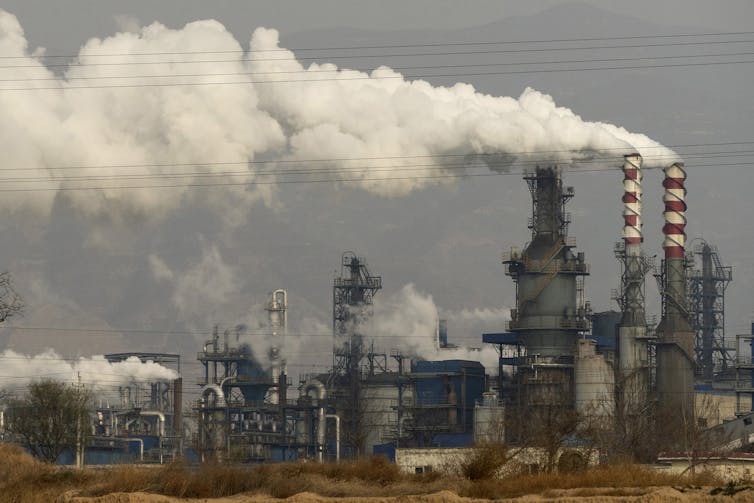
An Alarming Trend In Emissions
The COVID pandemic curbed greenhouse gas emissions in 2020, largely due to a drop in passenger travel. This led to hopes of a “green” economic recovery in which government stimulus spending would be invested into climate-friendly projects, to ensure a longer-term slowing of growth in emissions.
Some researchers examined the trends in China’s emissions up to 2019 and predicted the nation’s emissions would peak by 2026. Others have said the peak will occur even earlier, in 2025.
But unfortunately, it seems those predictions were too optimistic.
We examined data from Carbon Monitor, which provides science-based estimates of daily CO₂ emissions across the world. We compared emissions data from January to April 2019 (which represents typical pre-pandemic conditions in China) with the corresponding months in 2023. This period followed the removal of most COVID-related restrictions in China – such as testing requirements and quarantine rules – which essentially restored the country’s economy to business-as-usual.
We found average daily carbon emissions increased substantially between the two periods. In the first four months of 2019, China’s transport, industry, energy and residential sectors together emitted an average 28.2 million tonnes of CO₂ a day. In the first four months of 2023, daily emissions from those sectors were an average 30.9 million tonnes.
Emissions from the residential and transport sectors didn’t change much. This is mildly good news – it’s better than emissions going up. But these are the two smallest sectors, together accounting for only 18% of China’s emissions.
Rather, the increase was driven by emissions from China’s industrial and energy sectors. Average daily emissions from industry rose between 2019 and 2023 by 1.1 million tonnes or 11%. From energy, which includes electricity generation, they rose by 1.75 million tonnes or 14%.
Energy production from solar and wind in China did increase substantially between the two periods. But the growth was outweighed by electricity generated from fossil fuels.
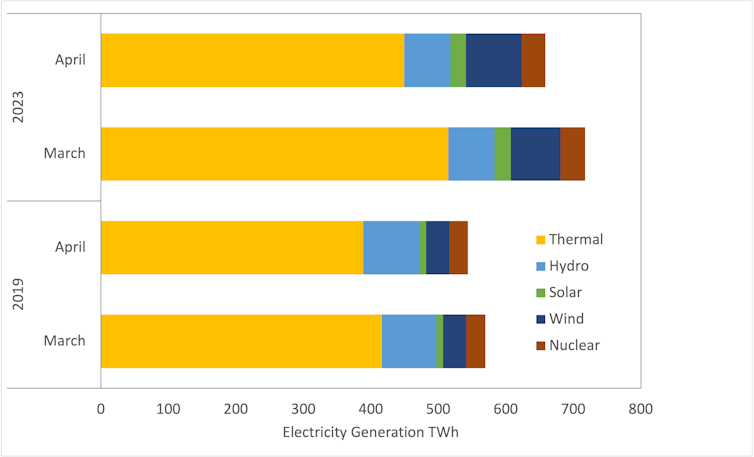
Separate data show the growth of coal production in China has accelerated. In the two years prior to the pandemic, coal production variously fell or only grew slightly. But coal production grew during the pandemic, and this has continued. In the year to April 2023, coal production increased by about 5%.
While coal’s share of energy consumption fell substantially from 2007 to 2019, it has changed little since then. That’s mainly because energy use is growing fastest in the electricity sector, which remains dominated by coal.
The Global Picture
Emissions in many developed countries have fallen in recent years due to government policies, slow economic growth, and the shift from coal to natural gas.
Developing nations increasingly dominate global emissions. China might be expected to be a leader on the clean energy shift among developing countries – in part because it produces much less oil than it consumes. That means its energy supply is not secure, giving it an incentive to find alternative sources of power.
There’s another reason why China should be a trailblazer on emissions reduction. China is the world’s biggest emitter – so a percentage reduction in emissions there leads to far fewer tonnes of CO₂ in the atmosphere than if a smaller country reduced emissions by the same percentage. And, partly because China’s population and economy are so big, it stands to benefit more than any country in the world from a more stable global climate.
But as we’ve outlined, China’s trajectory is by no means world-leading. What’s more, moves by China on the international stage suggest it’s becoming less cooperative in climate negotiations than in recent years. We saw this at the COP27 global climate conference in Egypt late last year, when China did not join a pledge to curb methane emissions and refused to provide financial support to developing nations vulnerable to climate change.
The potential for cooperation on climate policy is being reduced further by ongoing tensions between China and the United States. All this serves to cast doubt on China following through on its Paris pledges – and certainly, on any chance its emissions will peak in the next two years.![]()
David Stern, Professor, Crawford School of Public Policy, Australian National University and Khalid Ahmed, Visiting Fellow, Australian National University
This article is republished from The Conversation under a Creative Commons license. Read the original article.
Another assault on Country and its precious species has begun at Binybara/Lee Point
John Woinarski, Charles Darwin University; Lorraine Williams, Indigenous Knowledge, and Martine Maron, The University of QueenslandIn federal Environment Minister Tanya Plibersek’s first major speech, she said:
If we continue on the trajectory that we are on, the precious places, landscapes, animals and plants that we think of when we think of home may not be here for our kids and grandkids.
Yet, as you read this, the bulldozers are poised to destroy habitat for threatened species, subvert traditional cultural values and jeopardise a fabulous aspect of Darwin’s natural environment at Lee Point/Binybara. The government’s decision to approve this loss shows a continuing disregard for nature, cultural heritage and the legacy our descendants will inherit.
The battle to protect Binybara – as it is known to its Traditional Owners – has galvanised the local community. But the issues at stake are much broader and expose the tick-a-box nature of our unsatisfactory environmental laws.
The clearing of over 100 hectares of savanna woodland at Binybara for a defence housing development was first approved in 2019. When endangered Gouldian finches turned up in their hundreds last year, Plibersek agreed to reconsider the approval.
But in June this year the minister decided the development could proceed with a few more conditions. Last week, Traditional Owners, Darwin locals and ecologists from a nearby conference watched as the first trees were felled.
On Friday there was a reprieve: a ten-day pause to consider the Larrakia people’s concerns.
What’s At Stake?
The conflict between conservation or destruction at Binybara has global, national and local contexts.
The shoreline near the proposed housing is a globally significant site on the flyway of many shorebirds that migrate from eastern Asia to Australia each year. These birds face threats from habitat loss and degradation across their range. Their numbers are in steep decline.
Northern Australia has to date provided some respite from disturbance for these travellers. But an 800-home development would increase human activity and disturbance at a site already under pressure.
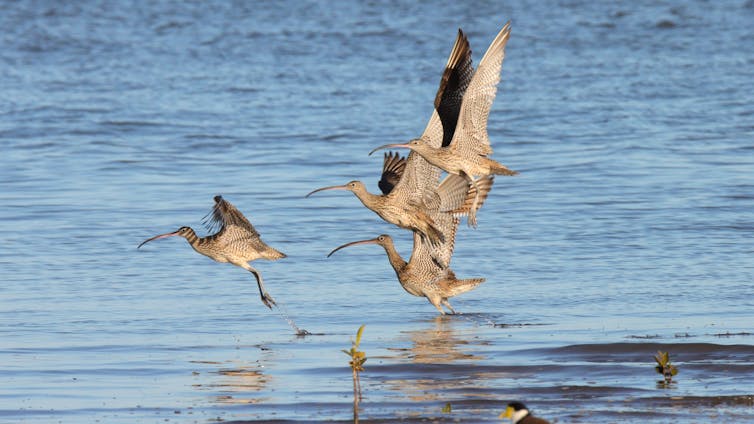
The national context is that most of our threatened species continue to decline. It’s often a result of an ongoing series of small losses – a patch of bushland cleared here, a population lost there. We cannot reduce the risks of extinction, let alone restore biodiversity, if these losses continue.
Binybara’s incredible richness of birds is valued by locals and tourists alike. Regarded as one of the world’s most beautiful birds, the Gouldian finch’s presence on the outskirts of Darwin is a particular blessing. The proposed development will jeopardise this population, particularly by destroying trees whose hollows provide potential nest sites.
The project’s environmental impact statement acknowledged it would also have a significant impact on another endangered species, the black-footed tree-rat. Tree felling would likely cause deaths of individuals and loss of hollows on which the species depends.
A Deep Cultural Significance
The Larrakia people’s deep and rich cultural ties to this area stretch back millennia. For them, Binybara is a sacred place.
It’s here that their ancestor Binybara transforms into a bird to fly out to see her husband Darriba Nungalinya.
The birdlife, from the migrating shorebirds to the owls, kites, eagles and Gouldian finches, is integral to the ecosystems and to the cultural fabric and story of this place. Generations of Larrakia people have lived, hunted, gathered foods, sourced materials and performed ceremonies here.
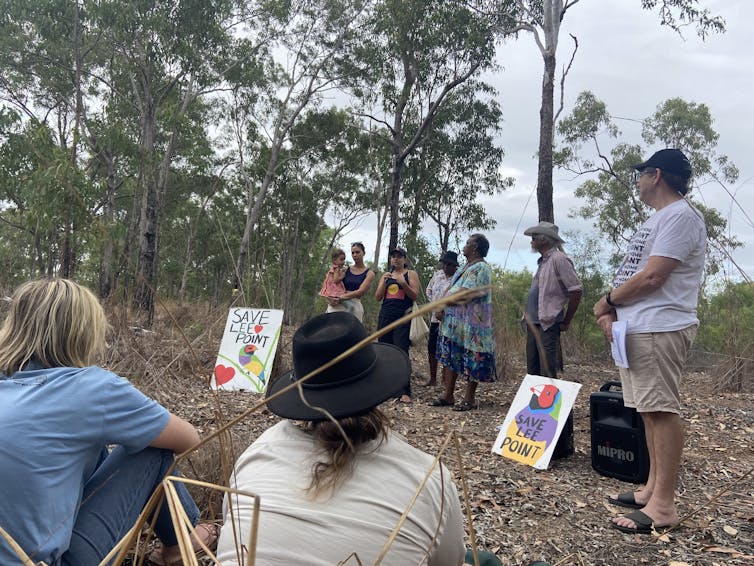
The woodlands provide foods such as the bowit-jba or bush potato (Brachystelma glabriflorum), datbing-gwa or sugarbag, green plum (Buchanania obovata), milky plum (Persoonia falcata), emu berry (Grewia retusifolia), possum (gutjgutjga), wallaby (milulu-la) and goanna (damiljulberreba).
Eucalyptus miniata timber is used for didjeridoo, harpoons, walking sticks, digging sticks and good firewood. Eucalyptus tetrodonta provides medicine and bark canoes. The bark and timber are also used for traditional houses. Erythrophleum chlorostachys (delenyng-gwa) leaves are used for smoking ceremonies and the inner bark for medicine to treat sores and deep wounds.
Hibiscus tiliaceus (lalwa) is a source of string for ropes, nets and harpoons. Its straight stems are used for fishing spears. Casuarina equisetifolia provides digging sticks for turtle eggs, firewood and beach shade. The paperbark from Melaleuca species (gweybil-wa) is used for cooking, bedding and roofing material, dugout canoes and rafts, while the leaves have medicinal uses.
Timber from the calendar plant, Acacia auriculiformis (gwalamarrwa), is used for clapsticks, while the pods are used medicinally. Dance practice for funerals happens here, using gwalamarrwa leaves.
It’s likely shell middens, artefact scatters and clay pits will need to be surveyed. There is a possible burial site in the area, a well and a registered sacred site at the tip of Lee Point. Tree burials, where the deceased was placed in a tree, may have taken place, so there may be scarred trees here.
The ten-day reprieve is due to an emergency application sought by the Traditional Owners under the federal Aboriginal and Torres Strait Islander Heritage Protection (ATSIHP) Act. They ask for a management plan to protect their cultural heritage to be developed with their input and that of experts and Darwin locals who value this place.
A(Nother) Failure Of National Environment Law
The main change to the approval was to require plans be developed to offset the loss of 94 hectares of Gouldian finch habitat. What those offsets are – or whether they are even possible – is not yet known.
This kind of “backloading” of offset conditions is highly risky. By the time the difficulty of finding a suitable offset site becomes clear, it is often too late – the habitat is gone.
Just two weeks ago, Plibersek ordered an audit of 1,000 environmental offset sites. “It’s not clear whether offset arrangements prevent environmental decline,” she said.
What we do know is that old-growth habitat features, such as tree hollows, are irreplaceable. And inherently place-based cultural values cannot be offset. This is ever more important as the Northern Territory moves to ramp up land clearing for cotton growing and gas development.
Another new condition is to maintain a 50-metre buffer zone around a dam where the finches drink. It’s a tokenistic measure, as the finches disperse hundreds of metres to feed and further to nest in old-growth hollow trees, like those in the areas to be cleared.
The case of Binybara exemplifies many of the failings of the Environment Protection and Biodiversity Conservation (EPBC) Act identified by the Samuel review. The test of the government’s promised reforms to the EPBC Act will be whether decisions like this continue to be made, leading to the loss of irreplaceable habitats and sacred cultural heritage.
Right now, the future of Binybara hangs by a thread.![]()
John Woinarski, Professor of Conservation Biology, Charles Darwin University; Lorraine Williams, Larrakia Traditional Owner, Indigenous Knowledge, and Martine Maron, Professor of Environmental Management, The University of Queensland
This article is republished from The Conversation under a Creative Commons license. Read the original article.
The Murray-Darling Basin shows why the ‘social cost of water’ concept won’t work
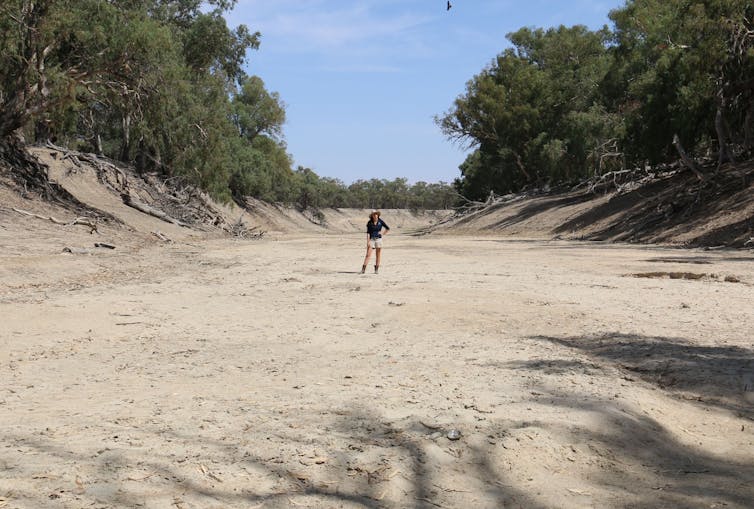
Access to safe, clean water is a basic human right. But water scarcity or barriers to access can cause conflict within and between countries.
Fights over water can be expected to intensify as the world warms, evaporation increases and rainfall becomes less predictable. So we’ll need to work even harder to resolve disputes and share this precious resource.
Earlier this year, for the first time in almost half a century, the United Nations held a conference squarely focused on water. Thousands of water experts gathered in New York for three days in March, to chart a way forward.
We were among the delegates. Since then, we have discussed and debated ideas that surfaced at this international meeting. Some were worthwhile, but others were wrong. In particular, we challenge the concept of a global “social cost of water”.
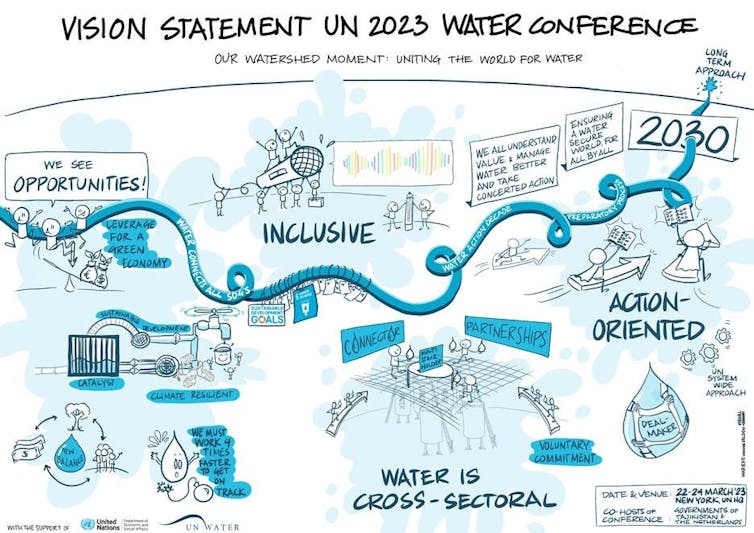
What Is A Global Social Cost Of Water?
One of the big ideas that came up at the conference was the need for a “new economics of water as a common good”, which includes the “social cost of water”.
Elaborating on his idea in the journal Nature, Swedish scientist Johan Rockström and colleagues wrote:
[Researchers] must assess the ‘social cost of water’, akin to the ‘social cost of carbon’, which considers the costs to society of loss and damage caused by water extremes and not meeting the basic provision of water for human needs.
The social cost of carbon is an estimate, in dollars, of the economic damages that would result from emitting one additional tonne of carbon dioxide into the atmosphere. It’s a decision-making tool used by governments, especially in the United States, for cost-benefit analysis of climate policy.
The social cost of water concept proposes valuing all types of water, including water vapour in the atmosphere that later falls as rain. This means attempting to put a dollar value on moisture flowing across borders, and implicitly creating world water markets. According to this logic, if most of Nigeria’s rain comes from forests in central Africa, then Nigeria should be prepared to pay central African nations to maintain the source of this moisture generation.
But we believe the concept of a global social cost of water is fundamentally flawed, as we explained in our correspondence in Nature in May, alongside others who also questioned its logic and purpose. Further correspondence in June also described calls to govern water on a global scale as “unrealistic” and distracting from sustainable and equitable access.
It’s unclear how a global social cost of water would work in practice. Writing as economists who have studied local water markets for decades, we see many problems with the concept, such as:
how water moisture volumes would be estimated reliably and regularly
how a dollar value could be reliably associated with water moisture flows across borders
how payments would be enforced between countries, and by what institutions
whether the money paid between countries would actually improve water security
what would happen when moisture flows across borders lead to floods with loss of human lives – would the downwind country receive compensation for water disasters as well as droughts?
Australia has the most sophisticated water markets in the world, in the Murray-Darling Basin. But even here there are considerable differences in how markets work. Water values and costs are also very different.
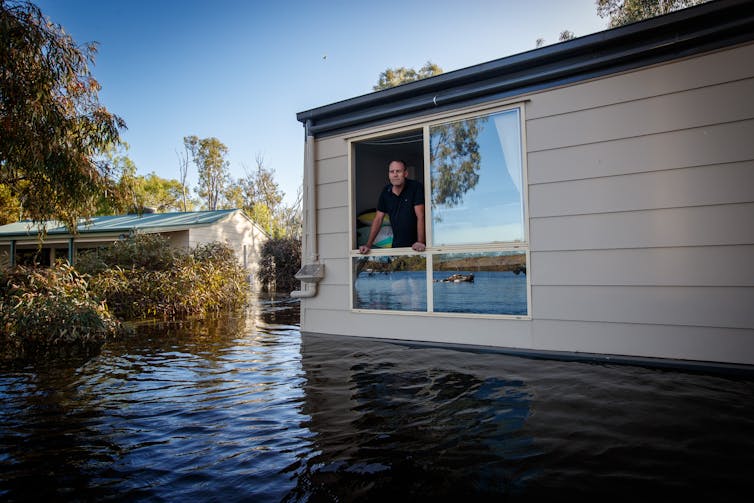
Australia’s Murray-Darling Basin: A Case In Point
The value of water in the Basin consists of benefits and costs. Some benefits include:
direct use of water to grow crops or irrigate pasture
recreational use such as boating and water sports
indirect use including the benefits to health and wellbeing from living alongside a natural water body
future use values, knowing there is sufficient water to sustain healthy ecosystems and rivers in years to come
future generational, existence and cultural values such as non-use values associated with the ancient Brewarrina fish traps.
Costs include harm to mental health associated with a lack of water during drought. At the other extreme, there’s the cost of too much water causing floods, property damage and loss of life, or salinity harming viticulture in the Riverland.
This shows the social value of water is incredibly difficult to measure even within one area such as the Basin, let alone trying to enforce a global water market.
What Should Instead Happen Next?
We think the best way to address the water crisis is to focus on local management and institutions, plan carefully and implement a wide range of policies. These include:
using economic methods and tools to assess and implement local water policies where feasible
removing subsidies that incentivise water exploitation
establishing sustainable extraction limits
strengthening water institutions to allow measurement, monitoring and enforcement of water use
This is a big task. Misdirection down blind alleys is a distraction that the world cannot afford.![]()
Sarah Ann Wheeler, Professor in Water Economics, University of Adelaide and Claudia Ringler, Deputy Director, Environment and Production Technology Division, International Food Policy Research Institute (IFPRI)
This article is republished from The Conversation under a Creative Commons license. Read the original article.
Soil erosion is filling vital inland river waterholes, putting the squeeze on fish, turtles and crayfish

During droughts, Australia’s inland rivers dry up, leaving waterholes as the only wet places in a parched landscape. Fish, turtles, crayfish and other aquatic animals retreat to these vital refuges.
But our research, published today, reveals these waterholes are in danger of filling up with eroded soil from farms. This is putting a big squeeze on life in the river.
When drought breaks, the water flooding into the river carries soil along with it. In theory, soil deposited in waterholes could be flushed out again by large floods.
Studies in the 1990s suggested as long as floods continued to occur, waterholes would maintain a natural balance of sediment. But these studies focused on the Cooper Creek, in the Kati Thanda (Lake Eyre) Basin, where waterholes have a sandy base underlying clay-dominated soil that can be easily washed out again. Many Australian rivers are different. So what happens elsewhere?
Our new research investigated waterhole infilling in the Moonie River, in the northern part of the Murray Darling-Basin. The Moonie catchment has experienced extensive clearing of native vegetation for sheep and cattle grazing. Unlike some neighbouring catchments, the upper and middle portions of the river have minimal water extraction and so their flow patterns are relatively “natural”. It’s a true “dryland river”, flowing only after infrequent rain events. During long periods with no flow, waterholes become the only remaining wet habitats for aquatic animals to survive.
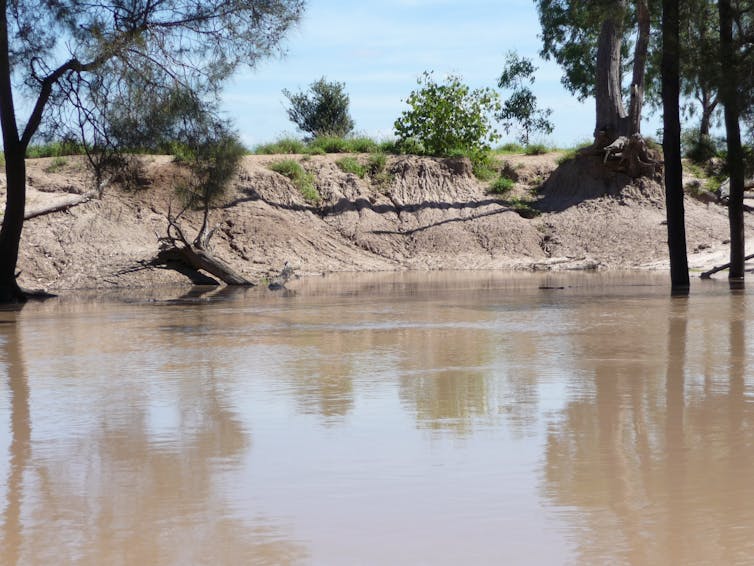
Poking At Sediment To Understand Waterholes
Waterholes in the Moonie River can be more than 5 kilometres long, up to 5 metres deep, and teeming with life. Kingfishers, whistling kites and parrots create a symphony of sound while fish occasionally break the surface of the murky water.
We studied three of the deepest waterholes in the Moonie River, as they are the ones that last longest in droughts. Our initial method was simple. Using metal rods, we probed the soil’s depth at evenly spaced points along the waterholes. Our first survey revealed all three waterholes had accumulated at least a metre of soil, with one site showing more than 2.5 metres of infilling, significantly reducing its depth.
To determine the rate of sediment accumulation, we used radiocarbon dating. This technique is commonly used for dating objects thousands of years old such as the Lake Mungo skeletons. However, nuclear weapons testing in the 1950s introduced new radioactive material including radiocarbon into the atmosphere worldwide. By analysing radiocarbon in the Moonie River sediments, we could estimate their age.
Our sediment dating revealed that, in places, more than two metres of soil had filled the deepest waterholes since the 1950s. Before European occupation, it would have taken thousands of years to deposit this much soil. Our research suggests sediment infilling also sped up over the past few decades.
The accumulated soil reduces the waterholes’ depth, preventing them from holding water for as long as they used to during droughts. Our modelling indicated this reduction has shortened the duration waterholes can hold water by almost a year at some sites, bringing them dangerously close to complete drying during the longest droughts.

Do Floods Remove Soil From Waterholes?
However, two significant questions remained: does sediment get removed after a large flood? And if it does, does material from upstream simply get dumped downstream? To answer these questions, we needed some luck and a knowledge of cocktails.
In 2010 and 2011, the Moonie River experienced two very large floods. This gave us the perfect opportunity to find answers. We repeated our waterhole surveys and found even after big floods, there was still a minimum of 1 metre of sediment across most of the bottom of these waterholes, with much deeper sediment in places.
The missing piece of our puzzle was to determine whether the sediments were mixed together, like a margarita, and deposited by a single flood, or if they were layered, resembling a B52 cocktail (another connection to nuclear bomb testing).
To unravel this, we examined how the sediment had changed since before the floods. We observed distinct layers, like those in a B52 cocktail, indicating the sediments had been deposited over a series of flows and floods since the 1950s, rather than solely after individual floods.
How Can We Solve This Problem?
We need to address the imbalance between eroded soil supply and the river’s capacity to transport sediment downstream.
In the Moonie River, water extraction for human use is minimal, so the problem is unlikely to lie with the river’s flow regime. The main culprit is an increased supply of sediment.
That means the solution lies in better catchment soil management. We need to stop so much soil washing into the Moonie River. This requires further research to find the main sources of soil that fills waterholes. Then determine the most effective ways to prevent erosion and reduce the amount of soil entering the river. This approach also helps preserve precious soils on agricultural land. In some exceptional cases, more extensive engineering solutions may be necessary to restore waterholes.
Given climate change projections for more frequent and longer droughts in the region, taking action to restore and preserve the function of waterholes in dryland rivers like the Moonie becomes increasingly crucial. These actions are essential for safeguarding the diverse aquatic animal life and the people that depend on waterholes for survival during droughts.![]()
John Tibby, Associate Professor in Environmental Change, University of Adelaide and Jonathan Marshall, Adjunct Senior Research Fellow in the Australian Rivers Institute, Griffith University
This article is republished from The Conversation under a Creative Commons license. Read the original article.
Australia has introduced a new bill that will allow us to ship carbon emissions overseas. Here’s why that’s not a great idea
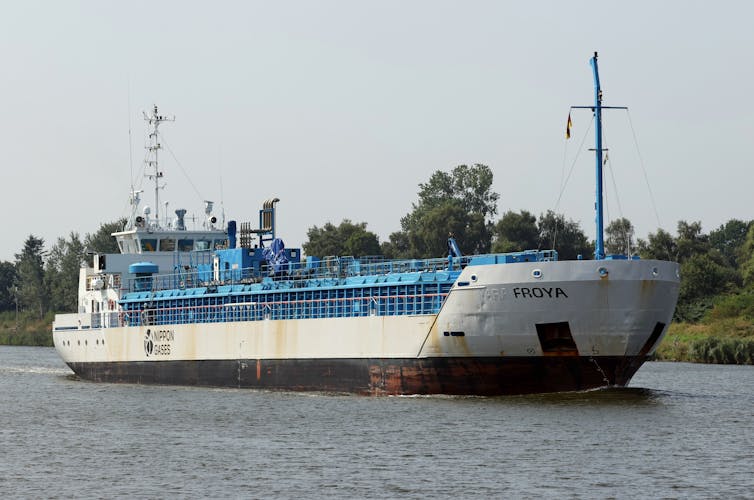
Fossil fuel companies in Australia could ship their carbon dioxide (CO₂) waste overseas for disposal, under changes to the Environment Protection (Sea Dumping) Act 1981 introduced to parliament late last week.
During her second reading speech, Environment Minister Tanya Plibersek said:
Companies would be able to better plan for transboundary projects for carbon capture and storage into sub-seabed geological formations within a clear regulatory framework. Until then, this export activity is not permitted under the sea dumping act.
The Environment Protection (Sea Dumping) Amendment (Using New Technologies to Fight Climate Change) Bill 2023 will allow export of CO₂ for the purpose of “sequestration”, or storage under the sea. Companies, or research organisations, would need to first apply for an export permit.
The main difficulty with this plan is that offshore carbon capture and storage has not worked effectively in Australian waters.
If a permit is given for CO₂ waste to be exported to poorer countries, it’s unclear how these countries will acquire the capacity and knowledge to achieve successful carbon storage when wealthy fossil fuel companies operating in Australia could not.
No Lack Of Storage Capacity Here
The stated objective of the amendment is to:
support countries without storage capacity to reduce their atmospheric emissions by allowing the export of carbon dioxide streams to countries with available sub-seabed geological storage formations.
But Australia appears to have a great deal of storage capacity, with conservative estimates putting the total at 740 billion tonnes.
In 2021, five areas for Offshore Greenhouse Gas Storage in Commonwealth waters were identified off the coast of Western Australia and the Northern Territory.
The real issue is not lack of storage capacity but rather, the fact offshore CO₂ injection is not working.
World’s Biggest Carbon Capture And Storage Flop
In Australia the only operational offshore carbon capture and storage project is Chevron’s Gorgon Project on Barrow Island in Western Australia.
Onshore, the Santos Moomba carbon capture and storage project in South Australia will become operational in 2024. Like the Gorgon project, the Moomba project has made bold claims, stating it has capacity to store up to 1.7 million tonnes of CO₂ annually.
Chevron built the “world’s largest” system to extract CO₂ in gas from its offshore reservoirs and inject it deep under the island. The A$81 billion gas export plant was approved on the condition it could store CO₂ in offshore reservoirs and, at a minimum, inject 80% of the CO₂ from the gas produced.
But in the 12 months to June 2022 Chevron only injected 1.6 million tonnes of CO₂ into the underground reservoir and vented 3.4 million tonnes to the atmosphere.
In the six years since export of LNG commenced from the Gorgon Project, 20.4 million tonnes of CO₂ has been extracted but only 6.5 million tonnes has been stored under the island. This significant shortfall adds to global warming and impedes Australia’s ability to reach our legislated 2030 emissions cuts.
Transferring CO₂ to poorer countries is also bonus for fossil fuel companies like Chevron because from July 1, the reformed safeguard mechanism will make carbon capture and storage failures very expensive.
That’s because the new safeguard mechanism does not allow emission baselines to be as readily adjusted as used to be the case.
Fossil fuel companies will have to begin paying a lot more for emissions that are above their allocated baselines. For example, a report estimates Woodside and its partners will be subject to an additional cumulative liability of up to A$63 billion up to 2050 at the Burrup Hub LNG export project under the new safeguard mechanism reforms. Exporting CO₂ from failed carbon capture and storage sites will allow fossil fuel companies to avoid these costs.
London Calling
The existing anti-dumping legislation and the proposed change stem from international agreement.
The Convention on the Prevention of Marine Pollution by Dumping of Wastes and Other Matter, 1972 (London Convention) was the first international agreement designed to protect the marine environment from sea dumping.
Sea dumping refers to the deliberate disposal of wastes or other matter from vessels, aircraft, platforms or man-made structures into the sea. It does not include material released directly into the sea from a land source or operational discharges from ships.
The London Convention sets up a framework which prohibited sea dumping and which required parties to apply for a special permit for approved materials to be dumped.
The subsequent London Protocol of 2006 took a more restrictive approach. The Protocol prohibited all sea dumping except for identified wastes such as dredged material, sewage sludge, and fish waste. These listed wastes could be dumped if a permit was approved but approval could not be given if it was reasonably likely to cause harm.
Amendments adopted to the London Protocol in 2009 and 2013, yet to be ratified, allowed for the export of CO₂ streams to countries with suitable offshore storage sites, provided an agreement or arrangement has been entered into between the countries concerned.
Australia intends to ratify the 2009 and 2013 amendments, and the amendments to the Sea Dumping Act represent the first stage in this process. The Department of Climate Change, Energy, the Environment and Water (DCCEW) has indicated Australia will apply a “precautionary approach” in the assessment of these permits.
Shifting The Problem Elsewhere
It’s argued that exporting CO₂ to storage sites overseas will provide significant environmental benefits within a decarbonising economy. The Australian research and industry collaboration CO2CRC considers such transboundary exportation “safe, reliable, necessary and urgent”.
But this is all premised on the assumption carbon capture and storage is effective and operational. The Australian experience to-date shows it is not. So the only apparent benefit of exporting CO₂ overseas lies in the fact it shifts the problem of escalating emissions out of the country.
Correction: this article originally stated Moomba was in the NT.![]()
Samantha Hepburn, Professor, Deakin Law School, Deakin University
This article is republished from The Conversation under a Creative Commons license. Read the original article.
Land clearing and fracking in Australia’s Northern Territory threatens the world’s largest intact tropical savanna
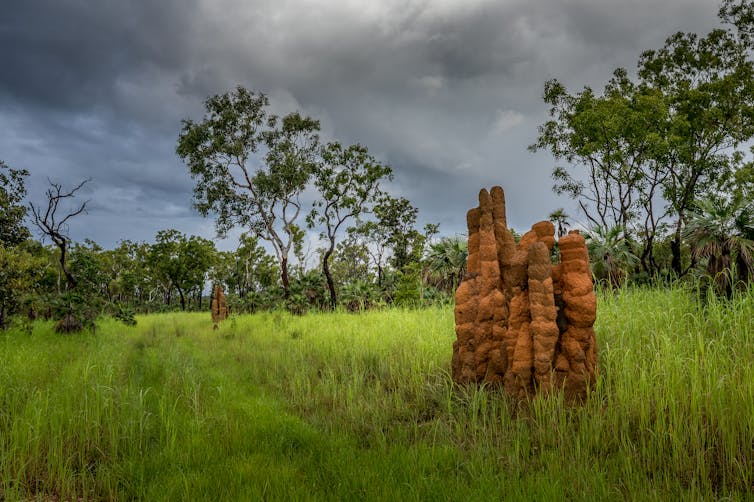
The Northern Territory government’s plan to turn 100,000 hectares over to large-scale crops such as cotton and its support for onshore gas extraction is threatening the world’s largest intact tropical savanna.
This is a region of immense cultural, environmental and economic value. It is home to the World Heritage listed Kakadu National Park and rich biodiversity.
As wildlife ecologists and conservation scientists, we are deeply concerned about plans announced last month that would intensify land clearing.
Accelerating habitat loss would all but guarantee failure of the Australian government’s zero extinctions plan, notwithstanding the fact many of the species placed in harm’s way by fracking and farming are yet to be discovered.
Rather than relaxing regulation to support development, we need to urgently overhaul Australia’s grossly inadequate environmental laws and safeguards, which also lack enforcement.
Land Clearing Leaves Wildlife Homeless
When we think of unregulated land clearing and habitat loss in the tropics, impoverished countries in tropical South America, Africa and Asia spring to mind. Not a relatively rich, developed country like Australia.
But across Australia’s tropical north, landscapes are afforded little protection. Land clearing leads to habitat loss, erosion and pollution of waterways.
Threatened species such as the Gouldian finch, black-footed tree-rat, and northern river shark are being put at risk.
Agriculture, including livestock grazing (pastoralism), is by far the greatest driver of land clearing in northern Australia.
The land subject to clearing approvals in the NT increased by 300% between 2018 and 2021. This trend is expected to continue.
First Nations Peoples, environmental scientists, conservation groups, and other members of the public fear the push to develop cotton in the NT will mean clearing a further 100,000 ha. That stems from the 2019 NT Farmers Association business case for the construction of a cotton processing facility in the NT, which is nearing completion.
Weak Laws Afford Limited Protection
Our national environmental protection law, the Environment Protection and Biodiversity Conservation Act, relies on self-referral of development activities for assessment.
Proponents of pastoral land clearing projects almost never refer their projects to the Australian government for assessment, even if their projects are set to deplete thousands of hectares of habitat within the known range of threatened species.
This means the potential impacts on threatened species and other natural values supposedly protected by national environmental laws, are never assessed by experts. And there is no mechanism for anyone else to refer the development for assessment.
The NT has no dedicated land clearing or native vegetation management legislation. The Pastoral Land Board approves land clearing across pastoral leases (which cover more than 45% of the territory’s land area). Permits for up to 5,000ha are generally granted without any formal environmental impact assessment.
On one occasion the proponent referred an application to the NT Environment Protection Agency. But it was deemed clearing the 10,000ha would not have a significant impact. So there was no environmental impact assessment required.
Some of the most notable examples of recent uncontrolled land clearing, without any assessment of biodiversity impacts, were for cotton on pastoral land in the NT.
Finally, the current regulatory system covers single development proposals. It is poorly equipped to consider the cumulative impacts of successive individual clearing events.
Fuelling Fires And Biodiversity Loss
The push to extract gas from the Beetaloo Basin represents another major threat to the region. The export of fracked gas from Beetaloo will be facilitated by the Middle Arm Sustainable Development precinct.
This runs counter to warnings from the world’s climate scientists that we must rapidly move away from a reliance on fossil fuels if we are to meet ambitions to keep global warming below 1.5℃.
For northern Australia, climate change means more severe storms, coral bleaching, death of mangroves, more intense and extended dry seasons (with less water for wildlife), and increased fire risk and severity.
Threats may compound upon each other, as invasive gamba and buffel grass that favour and promote fire would be even more likely to thrive and expand.
A Better Future For Australia’s Tropical Savannas
To protect Australia’s tropical savannas from uncontrolled land clearing and gas extraction, we need:
Stronger national environment protection legislation. The federal government is in the process of reviewing the EPBC Act. This is a perfect opportunity to recognise and protect our tropical savannas. The new act must have stronger requirements for the formal assessment of all projects that are likely to affect threatened species. It must also take the cumulative impacts of multiple small projects into account, to avoid “death by a thousand cuts”.
New NT-focused environmental law such as a Biodiversity Conservation Act, as proposed by the Environmental Defenders Office, Environmental Justice Australia and the Environment Centre NT, would provide tighter regulation of land clearing. This could also consider greenhouse gas emissions, carbon storage and native food production (bush tucker), as well as the intrinsic cultural values of intact ecosystems.
Most importantly, conservation planning that is community-led, scientifically grounded and respects the wishes and concerns of First Nations Peoples regarding enterprises on and management of Country. Recent pastoral land clearing in the NT has ignored the concerns of Traditional Owners over the loss of Country (despite having legally recognised Native Title on the land).
Avoid Repeating Past Mistakes
While Australia’s tropical savannas are massive in scale, they are increasingly insecure and under significant strain. Against a backdrop of climate change, biodiversity decline and extinction crises, any further development of the north must be subject to rigorous risk-assessment and appropriate environmental protections.
This is essential to ensure any economic benefits justify potential risks. We simply can’t afford to risk repeating mistakes already inflicted on much of southern Australia.![]()
Euan Ritchie, Professor in Wildlife Ecology and Conservation, School of Life & Environmental Sciences, Deakin University; Brett Murphy, Professor, Charles Darwin University, and John Woinarski, Professor of Conservation Biology, Charles Darwin University
This article is republished from The Conversation under a Creative Commons license. Read the original article.
Why red fire ants and yellow crazy ants have given themselves a green light to invade Australia
Brian Heterick, Curtin UniversityTwo of the worst ant pests on the planet are invading Australia. Red imported fire ants have been detected for the first time on the western side of the Great Dividing Range in Toowoomba, Queensland. Yellow crazy ants recently reached the Whitsundays.
The yellow crazy ant (Anoplolepis gracilipes) ranks among the world’s 100 worst animal pests because of its impacts on agriculture and biodiversity. The red imported fire ant (Solenopsis invicta) poses similar threats, and is also one of the world’s most dangerous ants. Its intensely painful stings, which give the ant its name, can kill people.
The prospects of total eradication of these ants in Australia are poor. Both species are highly adaptable and colonies need to be detected and eradicated early to contain them. Eradication efforts face other several challenges, including:
- inadequate biosecurity resources for checking incoming cargo
- the need for the public to maintain constant vigilance
- spread from built-up urban areas into bushland that’s much harder to monitor
- other pressing issues, such as the housing crisis, demand attention and resources, crowding out threats from insects.
Where Did The Crazy Ants Come From?
The origin of yellow crazy ants is disputed but is likely in South-East Asia or Africa. Workers are yellowish orange, medium-sized (around 4-5mm) and have long legs and antennae. They run rapidly in a seemingly random fashion, hence their name.
Workers and queens have a small funnel on their gasters (the bulbous end of their bodies) from which they can spray formic acid. It can burn human skin and is lethal for other ants and many native arthropods. Small animals such as lizards and bird chicks are at risk of being blinded or eaten.
These ants have spread to much of South-East Asia, parts of central America and the United States. They can be found indoors in the United Kingdom and a handful of European nations.
Since reaching the Australian territory of Christmas Island, yellow crazy ants have devastated the native wildlife. They killed up to 20 million of the famous red land crabs, causing major changes in the rainforest.
On the mainland, this species has reached the Northern Territory and Queensland, where it is most entrenched, having been discovered in Cairns in 2001. As well as spreading to Hervey Bay, Townsville and other coastal sites, the ant is now in Brisbane.
Brisbane City launched an eradication plan in 2022. Control measures include baiting using a fishmeal-based ant attractant combined with an insecticide. However, recently reported infestations in the Whitsundays and elsewhere suggest eradication will be difficult.
Northern Territory authorities have had more success. Some 26 locations covering nearly 300 hectares of Indigenous land have been freed of the pest.
The prospects of total eradication of yellow crazy ants in Australia are not promising. Like other serious ant pests, this species can form “super-colonies” with multiple queens, eats a wide variety of foods and readily colonises both exotic and native environments.
Such species are often only eradicated if their presence is detected before they become established. For eradication programs to succeed, local councils need landholders’ full support, plus adequate federal and state funding. Late last year the federal government provided another A$24.8 million, so there is some hope.
And What About The Fire Ants?
The red imported fire ant differs from the yellow crazy ant in having two waist segments (instead of one) and a powerful sting. The workers vary in size between 2.5mm and 6mm. They are reddish or yellowish with a darker gaster.
The fire ants are less distinctive than the crazy ants. They look like some small native ants in the genera Monomorium and Chelaner. However, their antennal clubs have two segments, while these native ants have three segments.
Another introduced Solenopsis species, S. geminata, looks even more similar. They are distinguished by the teeth on the mandible, or jaws: the red imported fire ant has four teeth and the other species has three. The nest mound of S. invicta is distinctive without any obvious nest entrance.

Native to South America, red imported fire ants have spread to the southern US, the South American tropics, the Caribbean, China and some Pacific Islands. Indoor infestations have been reported in Finland and Canada.
In Australia this species has become established in south-east Queensland. Small incursions have been eradicated in Port Botany, New South Wales, and, more recently, Fremantle, Western Australia.
In the US, fire ant stings have caused scores of human deaths due to anaphylaxis, or allergic shock. The stings cause small pustules on the skin, which can lead to infection or tissue death.
Fire ant stings also kill or injure domestic animals and livestock, and can cause serious economic loss. Like the yellow crazy ant, this species will protect disease-carrying plant bugs that produce honeydew. The ants will attack anything that threatens their food source and so help the bug population grow.
The ants also damage many crops themselves and destroy honey bees in their hives. They may nest in electrical utility boxes, causing outages.
Spreading corn bait laced with insecticide is the main means of control. Insecticide or steam can also be injected into nests.
Unfortunately, red imported fire ants were only identified in Brisbane in 2001, some years after the estimated date of the first arrivals. These ants likely came from the US. Despite successful eradications at sites including the Port of Brisbane and a separate incursion in central Queensland, the Brisbane outbreak has not been controlled.
The prognosis for controlling this pest is grim. It has super-colonies like the crazy ant and is equally adaptable in terms of food, nest sites and multiple queens (in some, but not all colonies). On top of that, identification and detection are more difficult.![]()
Brian Heterick, Adjunct Research Associate, School of Molecular and Life Sciences, Curtin University
This article is republished from The Conversation under a Creative Commons license. Read the original article.
Victoria has rediscovered a dragon – how do we secure its future?
Brendan Wintle, The University of Melbourne and Sarah Bekessy, RMIT UniversityThe Victorian grassland earless dragon (Tympanocryptis pinguicolla), not seen since 1969, has been found in grasslands west of Melbourne. No need to fear this dragon, though; these lizards are just 15cm long fully grown.
The dragon is Australia’s most imperilled scaled reptile. This is an extraordinary second chance. The rediscovery of a species thought to be extinct inspires hope of finding other lost treasures like the Tassie tiger.
But rediscovery only happens because a species has become so scarce it has eluded even the experts who know best where to look. To save it from extinction, three things must happen quickly:
intensive care – create a conservation breeding population, manage its remaining genetic diversity, and breed enough individuals to return to the wild
within the species’ range, protect habitats of the size, quality and quantity needed to support self-sustaining populations
restore and manage these habitats, reduce threats, reintroduce the dragons and monitor outcomes to ensure the species’ long-term viability.
Intensive Care
This first step is to set up a climate-controlled, disease-free conservation breeding facility, run by the ICU doctors and nurses of conservation. It’s a tragedy that the only option is to take the last few individuals of a species from the wild to secure its future. With that decision made, it is essential they receive the best possible care.
Fortunately, Melbourne has experts who know how to build and run such facilities, reintroduce species to the wild and monitor their recovery. In this way, Zoos Victoria and collaborators have over the past decade averted the extinction of the mountain pygmy possum, lowland Leadbeater’s possum, helmeted honeyeaters, Baw Baw frog, southern corroboree frog and spotted tree frog.
This work involves setting up, maintaining and staffing such a facility, as well as surveys to locate and move individuals into captive breeding. Based on experience with endangered frogs, plus the extra costs of outdoor enclosures, the cost will be around A$2 million over the next five years.
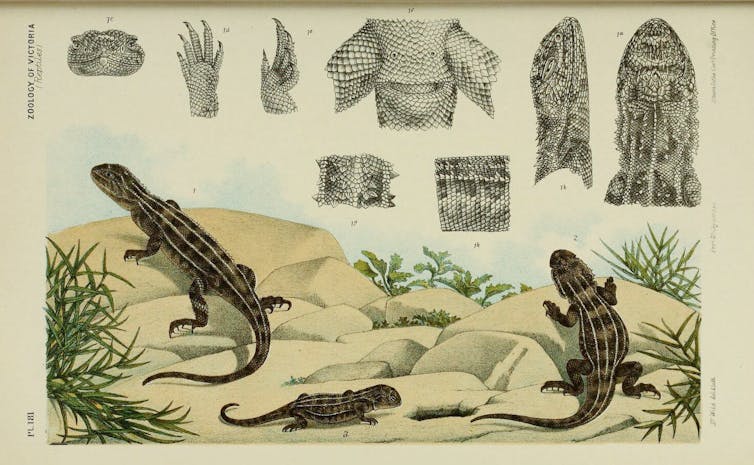
Securing Habitat
Merely keeping a species alive in zoos is not conservation. Self-sustaining wild populations must be established to recover a species. This is where complexity, uncertainty and economics really bite.
The dragon has only ever been found in the critically endangered ecosystem known as the basalt plains grasslands. Agriculture and housing development have reduced these grasslands to less than 3% of their pre-European extent. Most of what remains is on private land.
The dragon’s long-term fate depends on managing the site where it was found and any areas nearby where dragons are living. We also need substantial new areas of suitable plains grasslands as conservation reserves where captive-bred animals can be released.
Research tells us we need at least six independent, self-sustaining populations for the dragon to stand a chance of persisting for at least the next 50 years. Even if well-managed, some populations will occasionally be lost to disease, predation, hot fires, or other chance events.
Individuals will have to be released back into those areas once the areas recover and can support the species again. In pre-European times, animals could naturally migrate back into such places. Today, habitats are too fragmented for that to happen.
Unfortunately, basalt plains grasslands continue to be lost to legal and illegal clearing, the use of fertilisers that favour exotic grasses, weed invasion, rock removal, intensive grazing and the loss of regular low-intensity “cool” fires historically used by Traditional Owners.
To make matters worse, the Victorian government has over the past decade broken its promise to set aside large areas of western plains grasslands as conservation reserves.
Securing new conservation areas will be expensive given the competing demands for this land. However, the government has received offset payments from developers when they (legally) destroy grasslands to build houses. It’s time to use those funds to create the reserves the dragon and other endangered grassland species need to survive.
We estimate securing six high-quality grasslands of at least 100 hectares each will cost at least $30 million.
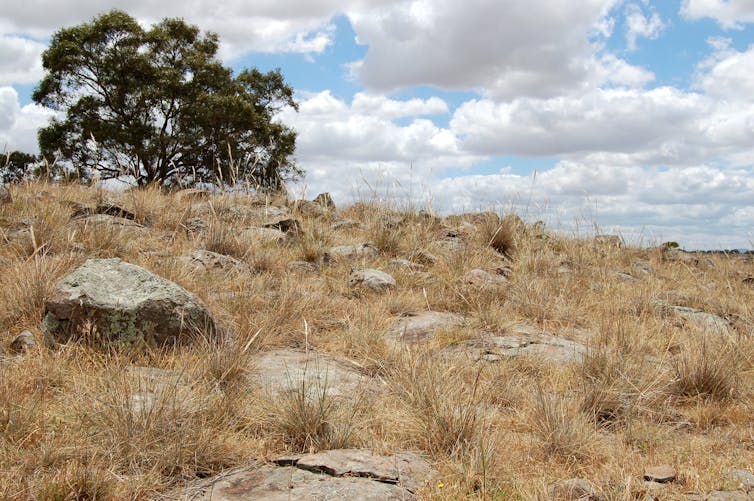
Managing Threats And Restoring Habitats
These reserves will need careful and active management. In the absence of frequent cool fires, and in the presence of invasive weeds and animal pests, these areas will lose the plant species that make them special and beautiful. Weeds, cats, foxes, dogs and rabbits all create unsuitable habitat for dragons.
Many of these grasslands are so degraded they need a lot of restoration work, almost starting from bare soil.
Weed control and fire management to maintain six 100-hectare reserves as suitable habitat for dragons will cost around $2.4 million a year. These reserves would of course be home to many more grassland animals and plants, including other endangered species such as the fat-tailed dunnart.
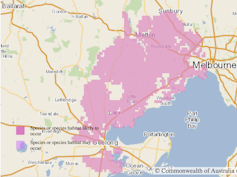
We can’t be sure of the exact costs of buying, restoring and managing grasslands. Our estimates assume, for example, the sites contain most grassland plant species. If areas were being restored from bare soil, ten-year restoration and management costs would more than double.
Other uncertainties include land prices, the costs of weed and pest control and fire management, and the possible need to help insect populations establish as a sustainable source of dragon food.
We Can Afford To Save The Dragon
The whole program is likely to cost around $56 million over ten years. More than half the cost involves buying highly sought-after properties.
If this sounds like a lot of money, consider that Australians spend over $30 billion a year on pet care. Just the GST on that spending ($3 billion) would cover the annual cost of conserving most of our 1,900 or so endangered species (most don’t have the dragon’s expensive taste in real estate). As a nation, we can afford to save the dragon and most of its endangered friends, as the law requires.![]()
Brendan Wintle, Professor in Conservation Science, School of Ecosystem and Forest Science, The University of Melbourne and Sarah Bekessy, Professor in Sustainability and Urban Planning, Leader, Interdisciplinary Conservation Science Research Group (ICON Science), RMIT University
This article is republished from The Conversation under a Creative Commons license. Read the original article.
Queensland Native Forestry Can Help Achieve Global Environment Goals New Research States
July 6, 2023
Research conducted by Dr Tyron Venn of the University of Queensland states that Queensland native forestry, including timber harvesting, could actually help conserve biodiversity and mitigate climate risks.
Dr Tyron Venn from UQ's School of Agriculture and Food Sustainability reviewed more than 350 publications, studying the ecological and economic impacts of Queensland native forest management, which includes everything from fire management to timber harvesting.
"Stopping forestry in Queensland's native forests may sound like a positive outcome for the environment, but the research suggests that it would further shift our impacts offshore and increase carbon emissions, while generating little benefit for biodiversity conservation within Australia," Dr Venn said.
Since the 1990s, Australia's annual harvest of native hardwood sawlogs has dropped by 2.2 million cubic metres, as large areas of state-owned native forests have been declared National Parks or other types of conservation reserves in which harvesting is not allowed.
"Over the same time period, imports of hardwood products from less-well managed forests in Asia and the Pacific increased by a similar amount," Dr Venn said.
"In many developing countries, large international timber companies operate with disregard for the environment and often have negative impacts on traditional forest communities."
"Without realising it, many Australians buy products made with foreign timbers and threaten conservation efforts for the orangutan, Malayan tiger, Asian sun bear and Asian tapir.
The research found that Queensland's low-intensity forestry management techniques are informed by science to minimise environmental impacts.
Queensland law allows selection harvesting in some of the state's public and private native forests, which typically removes 10 to 20 trees per hectare every 20 to 40 years.
Strict rules regulate how this is conducted, such as by requiring minimum retention of trees of different sizes, including large old trees with hollows.
"Selection harvesting can restore wildlife habitat, promote and conserve floristic diversity and improve the resilience of large trees against climate change and bushfire," Dr Venn said.
Dr Venn said forestry is the twenty-fifth most important threat to biodiversity in Australia, and forestry in Queensland impacts only 0.8 per cent of Australia's 1,795 threatened species.
"There are 24 more important threats we should be focused on, including invasive weeds, invasive predators, urban development, and reduced fire frequency or intensity" he said.
Dr Venn said Queensland should continue to manage some of its forests for wood production, as recommended by the Intergovernmental Panel on Climate Change (IPCC).
"The IPCC has long argued that sustainably managing forests to produce timber, fibre and energy will generate the largest carbon sequestration benefit from forests," he said.
"If Queensland reduced its native forestry in the near future, the knock-on effect would be negative impacts on global efforts to conserve biodiversity and reduce carbon emissions due to increased consumption of timber imports and carbon polluting substitutes.
"Queensland can maximise its contribution to global biodiversity and climate goals by continuing to manage some of the state's native forests for timber production."
Tyron J. Venn. Reconciling timber harvesting, biodiversity conservation and carbon sequestration in Queensland, Australia. Forest Policy and Economics, 2023; 152: 102979 DOI: 10.1016/j.forpol.2023.102979
Number Cruncher Calculates Whether Whales Are Acting Weirdly
July 6, 2023
We humans can be a scary acquaintance for whales in the wild. This includes marine biologists tagging them with measuring devices to understand them better. These experiences can make whales behave erratically for a while. Such behaviour can affect research quality and highlights an animal ethics dilemma. Now, University of Copenhagen researchers have figured out how to solve the problems with math.
Maybe you have tried taking a howling pooch or cranky cat to the vet. Regardless of your noblest intentions, your pet's experience may have been equally unpleasant. Animals react to the unknown in their own way. The case is no different for cetaceans like narwhal and bowhead whales when they encounter human generated noises such as ship noise or mining blasts in the North Atlantic -- or when they are caught by well-meaning marine biologists who just want to get to know them better.
When biologists 'tag' whales with measuring devices, the animals react by behaving unusually -- abnormally. For example, for a while after being tagged, they may perform many atypical shallow dives and quick jerks. Such behaviour is misleading when the goal is to study the animal's normal and natural behaviour.
The problem is getting help from an unusual corner.
"Biologists seek to understand animals as natural beings, but their reactions turn into unnatural behaviour that creates noise in the dataset. Because of this, a lot of data from just after whales are tagged ends up getting discarded. In this study, we have proposed a mathematical approach using statistical methods that can determine exactly how much data to keep," says PhD student Lars Reiter from the Department of Mathematics.

Photo: Carsten Egevang, Greenland Institute of Natural Resources
Valuable for humans and animals alike
With two statistical calculations, the researcher has found a way to estimate when whales like narwhals and bowhead whales will return to their natural behaviour after being tagged. It is a method that can also be used to study how animals respond to other types of disturbances.
"This research is extremely valuable to us as marine biologists who are interested in the behaviour and well-being of whales. It provides us with a standardised approach by which to distinguish between natural behaviour and affected behaviour in whales. Thus far, we've made individual estimates that are more or less spot on," says marine biologist Outi Tervo from the Greenland Institute of Natural Resources, who collaborated with the mathematicians on the study.
The statistical method allows researchers to avoid discarding too much or too little data. If too much data is kept, it can interfere with the research results, and if too much is lost, it comes at cost to both the animals and humans.
"It really matters in terms of research, but also financially. And not least, it means something for animal welfare. If we throw away data unnecessarily, more whales will eventually have to go through the experience for us to conduct this research, which is ultimately meant to benefit the animals," says Outi Tervo.
Idea came from a parliamentary election
Whale behaviour does not go from abnormal to normal with a flick of its tail. Their behaviour normalizes gradually, typically over a day -- and in a few cases over a longer period of time. During this transition, a whale's behaviour manifests itself on both sides of an area designated as normal whale behaviour. So how do scientists figure out where to make the cut?
"The idea came to me while I was standing in the voting booth during parliamentary elections. Borrowing from the logic of the electoral system, you can consider it as if the whales -- or these data points which show the whale's behaviour -- vote on whether they are in or out of their normal range," explains Lars Reiter.
By recording 1 positive "vote" when the behaviour is within the normal range, and 1 negative "vote" when outside, the scientists can add up all the votes and find the moment at which the number of votes goes from predominantly negative to positive.
The researchers use two approaches to determine normal whale behaviour. In part, they look at the whale's diving pattern, as well as its acceleration and fine motor skills.
How to calculate the behaviour of animals statistically
Sometimes it hunts in the deep, while at others times, it cruises quietly at the surface. The activity that a whale is engaged in is crucial for understanding its normal energy level. Lars Reiter's method takes this into account as something new:
"Where previous research focused on the mean behaviour, we instead situate a whale in an activity based on its movements -- where it is assessed based on a normal value for acceleration that matches the specific activity being engaged in. We do this by using what are known as quantiles, instead of averages, because they allow us to focus on behavioural extremes. For example, hunting and resting are opposing extremes in terms of energy levels," explains Lars Reiter.
When the focus is on the whale's diving profile, on the other hand, you look at the pattern formed by the whale's overall activities. By combining depth and time, one can assess whether the distribution of different dive types is natural.
Wiser about the animals' hardships and better at avoiding them
According to the marine biologist, the data-based approach represented by the statistical method also means that researchers can now develop better, more gentle ways of tagging.
"Based on this study, we already know that the amount of time we spend putting the equipment on is an important factor for how much the animals are affected afterwards. Therefore, we can set up some time limits -- where we stop and set the whale free if it takes more than X number of minutes allowed," says Outi Tervo.
A shift away from individual estimates to a mathematical standard could also mean better assessments from the veterinary oversight that tag-using research projects are required to go through.
"The method will make it so that ethical approval from a veterinary inspection is more data-based and precise. So, there is no doubt that this research is a step forward for animal welfare," says the marine biologist.
* Extra info: An important instrument for a future with less ice and more people
The natural Arctic habitat of narwhals and bowhead whales is changing due to climate change. Annual ice shrinkage and increasing human activity is taking place in areas that whales once had all to themselves. The researchers' method can become an important instrument and contribute to a greater understanding of the consequences.
"It allows us to study how whales are impacted by various human activities. They can be external sources of noise that we can situate in time and location, such as a blast or a ship passing by. Or sounds and activities that we emit ourselves. Lars' algorithm lets us get a clear picture of how it all affects the animals," says Outi Tervo.
Increased activity will lead to more ocean noise, which is of concern to marine biologists with regards to how it will affect large marine animals like narwhal, which are incredibly sensitive to sound. Co-author and supervisor Professor Susanne Ditlevsen believes that the studies and new method will become more important in the years ahead.
"Climate change is leading to increased anthropogenic activity in Arctic whale habitats. Melting ice means that areas which were once impassable can now be reached by humans. We would like to assess whether it scares and disturbs the animals, but it is not clear how. The new methods can be used to assess at what distance from the animal habitat should various activities take place," says Susanne Ditlevsen.
Facts: Statistical method with two mathematical calculations and one intersection.
The statistical method can generally be understood as calculations with two types of tagging data -- acceleration and depth, and a way of adding it up that finds the optimal intersection.
1. Acceleration tells about the energy level and whale movements ("jerks"). The indicators for natural behaviour are divided according to whale activity, so that, for example, a high energy level is recorded as natural in connection with hunting, but not in connection with rest.
2. The whale's diving profile is measured in depth and time spent on a dive. Temporal impacts over a 40-hour period show a pattern of different types of dives -- e.g., U-dives, where the whale stay at depth for some time, or V-dives, where the whale resurfaces quickly. The pattern is compared with normal values measured after the 40 hours.
3. The cut-off point for when the whale is back in normal behaviour is found by counting the individual measurements as "voting for or against" normal behaviour. As such, the researchers find the optimal place to divide the research data into natural and influenced behaviour.
About the study
The study is part of a larger research collaboration between the Greenland Institute of Natural Resources and the University of Copenhagen's Department of Mathematics, that focuses on the Arctic's large marine mammals.
The researchers include Lars Reiter Nielsen and Susanne Ditlevsen from the University of Copenhagen, Outi M. Tervo and Mads Peter Heide-Jørgensen from the Greenland Institute of Natural Resources and Susanna B. Blackwell from Greeneridge Sciences, Inc., Santa Barbara, USA
Lars Reiter Nielsen, Outi M. Tervo, Susanna B. Blackwell, Mads Peter Heide‐Jørgensen, Susanne Ditlevsen. Using quantile regression and relative entropy to assess the period of anomalous behaviour of marine mammals following tagging. Ecology and Evolution, 2023; 13 (4) DOI: 10.1002/ece3.9967

The researchers put measuring instruments on whales to better understand the animals and the way we humans affect them. Photo: Carsten Egevang, Greenland Institute of Natural Resources.
Fractured foundations: how Antarctica’s ‘landfast’ ice is dwindling and why that’s bad news
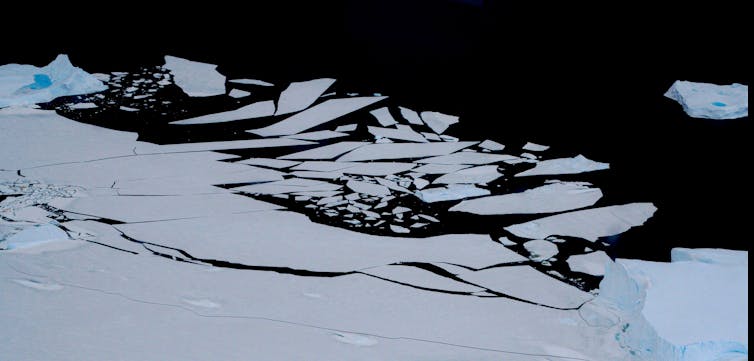
There’s more to Antarctic ice than meets the eye. Sea ice is not a uniform crust overlying the salty Southern Ocean.
Our new research is the first to review the many crucial roles of “landfast” sea ice around Antarctica. Landfast ice is frozen seawater that is fastened to the coast. It acts like a belt around the Antarctic coast, regulating the flow of ice shelves and glaciers into the sea. And it’s crucial habitat for Weddell seals and emperor penguins.
Satellites can easily estimate the horizontal extent of sea ice, but determining the type of ice is far more difficult. Our deeper analysis of satellite images reveals landfast sea ice extent declined to a record low of just 123,200 square km in March 2022. That’s well below the normal March range of 168,600-295,200 square km.
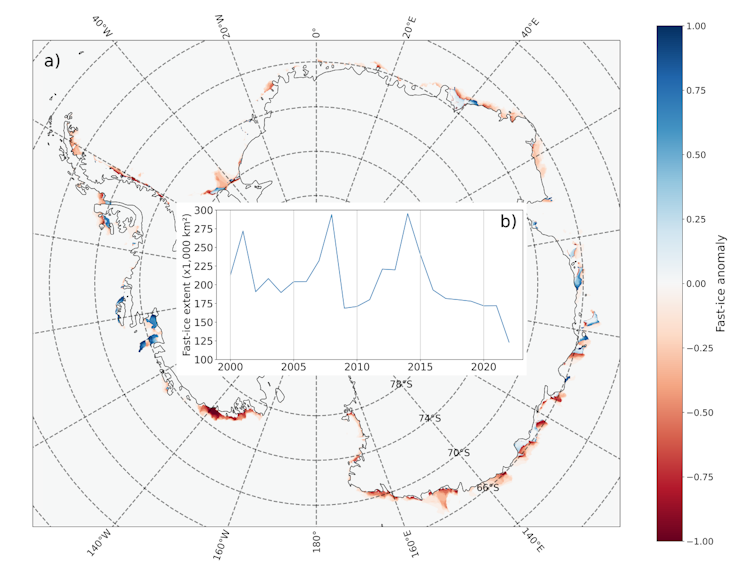
Much of the ice lost in 2022 had been present since 2000, when high-quality records began. If this trend persists, the consequences for the climate and for Southern Ocean ecosystems could be catastrophic.
Getting A Grip On Landfast Ice
Antarctic sea ice drives the circulation of the world’s oceans. The “overturning” circulation begins in Antarctica when very salty, dense brine (created as the ice forms) sinks to the bottom of the ocean. This “bottom water” spreads away from Antarctica to reach the northern hemisphere.
This crucial circulation is projected to slow due to glacial melt, because the input of more buoyant fresh water dilutes the denser brine. This raises the spectre of a further slowing or worse, total shut down of deep ocean currents as in the disaster movie, “The Day After Tomorrow”. We know concentrated regions of sea ice formation tend to occur next to landfast ice, so the changes we are seeing are likely to further reduce this deep ocean circulation.
Global climate models are not particularly skilful at reproducing the recent history of Antarctic sea ice, giving limited confidence in our ability to predict its future. There are many reasons for this, but one of the main ones is an overly simplistic representation of the sea ice.
Landfast sea ice is not represented in any global climate model. These models treat all sea ice as if it’s able to drift, whereas in reality up to 15% of ice should be held still by being anchored to land or grounded icebergs.
This is a big problem because, as our study reveals, if we don’t properly simulate it, we are likely to get all kinds of inaccurate flow-on effects, including an incorrect amount of sea ice (and hence dense water) produced by our models.
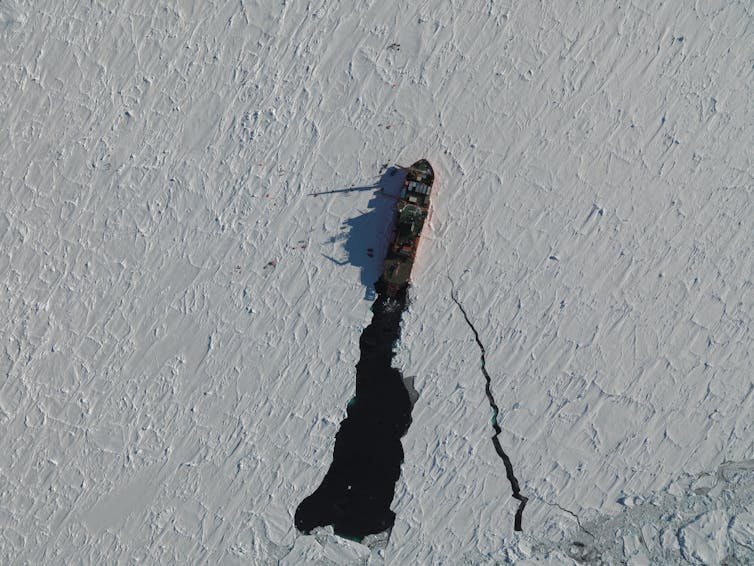
Wildlife Depends On Landfast Ice
Landfast ice supports a unique community of algae, krill, small crustaceans called copepods, molluscs and fish. They are adapted to live within and below the ice where conditions are harsh.
These species form a complex food web around ice algae, using the ice as a nursery ground. Life within landfast ice requires wide-ranging survival strategies. Drastic changes could mean cascading effects on the entire food web.
Seals and penguins rely on this environment for resting, hunting and breeding. Emperor penguins have a unique approach to raising a family that requires stable ice, which only landfast ice can provide. Reduced ice extent, increased fragmentation and earlier breakup can lead to population declines of this iconic species.
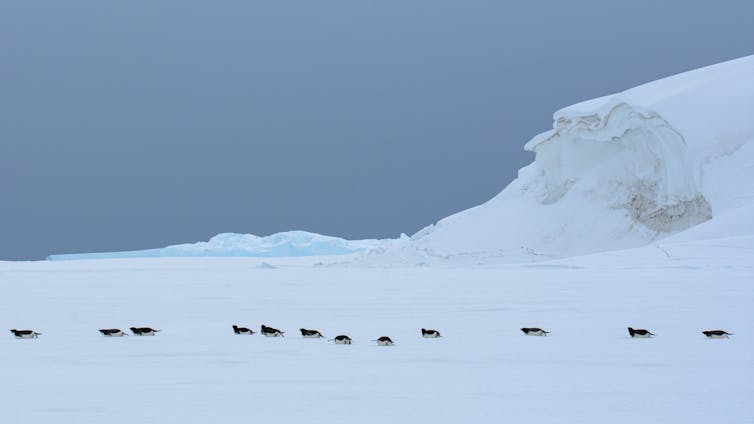
Deeper Knowledge Is Crucial For Climate Forecasts
Only a few areas of Antarctic landfast ice are regularly sampled. These areas are found near Antarctic research stations and are generally separated by thousands of kilometres of coast.
Additionally, scientists can often only safely collect sea ice cores from smooth ice thick enough to support people. So sampling is skewed to favour the unbroken crème brûlée-type crust over the shattered meringue of rough landfast ice.
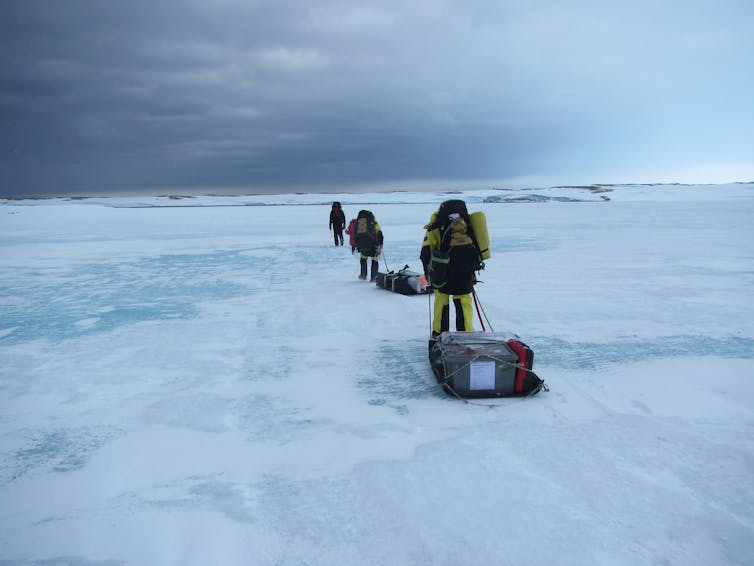
To better understand rough landfast ice and a slew of other poorly understood ice types, we need repeat ice core measurements along with more detailed satellite studies. We also need the capability to model each ice type accurately.
Our research has ensured landfast ice is earmarked for inclusion in the next iteration of our national climate model, which aims to better simulate the interactions between sea ice of all types and the Southern Ocean. Without this ability, we are missing a key ingredient in the recipe of Australia’s climate future.![]()
Alexander Fraser, Senior Researcher in Antarctic Remote Sensing, University of Tasmania; Christine Weldrick, Antarctic Marine Zooplankton Ecologist, University of Tasmania; Laura Dalman, PhD candidate, University of Tasmania; Matthew Corkill, PhD candidate, University of Tasmania, and Pat Wongpan, Quantitative Sea Ice Biogeochemist/Ecologist, University of Tasmania
This article is republished from The Conversation under a Creative Commons license. Read the original article.
Shrinking Arctic Glaciers Are Unearthing A New Source Of Methane
July 6, 2023
As the Arctic warms, shrinking glaciers are exposing bubbling groundwater springs which could provide an underestimated source of the potent greenhouse gas methane, finds new research published today in Nature Geoscience.
The study, led by researchers from the University of Cambridge and the University Centre in Svalbard, Norway, identified large stocks of methane gas leaking from groundwater springs unveiled by melting glaciers.
The research suggests that these methane emissions will likely increase as Arctic glaciers retreat and more springs are exposed. This, and other methane emissions from melting ice and frozen ground in the Arctic, could exacerbate global warming.
"These springs are a considerable, and potentially growing, source of methane emissions -- one that has been missing from our estimations of the global methane budget until now," said Gabrielle Kleber, lead author of the research who is from Cambridge's Department of Earth Sciences.
Scientists are concerned that additional methane emissions released by the Arctic thaw could ramp-up human-induced global warming. The springs the researchers studied hadn't previously been recognized as a potential source of methane emissions.
Kleber spent nearly three years monitoring the water chemistry of more than a hundred springs across Svalbard, where air temperatures are rising two times faster than the average for the Arctic. She likens Svalbard to the canary in the coal mine of global warming, "Since it is warming faster than the rest of the Arctic, we can get a preview of the potential methane release that could happen at a larger scale across this region."
Professor Andrew Hodson, study co-author from the University Centre in Svalbard said, "Living in Svalbard exposes you to the front-line of Arctic climate change. I can't think of anything more stark than the sight of methane outgassing in the immediate forefield of a retreating glacier."
Previously, research has centred on methane release from thawing permafrost (frozen ground). "While the focus is often on permafrost, this new finding tells us that there are other pathways for methane emissions which could be even more significant in the global methane budget," said study co-author Professor Alexandra Turchyn, also from Cambridge's Department of Earth Sciences.
Hodson added, "Until this work was conducted, we didn't understand the source and pathways of this gas because we were reading about studies from completely different parts of the Arctic where glaciers are absent."
The methane-delivering springs they identified are fed by a plumbing system hidden beneath most glaciers, which taps into large groundwater reserves within the underlying sediments and surrounding bedrock. Once the glaciers melt and retreat, springs appear where this groundwater network punches through to the surface.
The researchers found that methane emissions from glacial groundwater springs across Svalbard could exceed 2,000 tonnes over the course of a year -- which equates to roughly 10% of the methane emissions resulting from Norway's annual oil and gas energy industry.
This source of methane will likely become more significant as more springs are exposed, said Kleber, "If global warming continues unchecked then methane release from glacial groundwater springs will probably become more extensive."
Glacial groundwater springs aren't always easy to recognize, so Kleber trained her eye to pick them out from satellite images. Zooming in on the areas of land exposed by the retreat of 78 glaciers across Svalbard, Kleber looked for tell-tale blue trickles of ice where groundwater had leaked to the surface and frozen. She then travelled to each of these sites by snowmobile to take samples of the groundwater at locations where the ice had blistered due to pressurized water and gas build up.
When Kleber and the team profiled the chemistry of the water feeding these springs, they found that all bar one of the sites studied were highly concentrated with dissolved methane -- meaning that, when the spring water reaches the surface, there is plenty of excess methane that can escape to the atmosphere.
The researchers also identified localized hotspots of methane emissions, which were closely related to the type of rock from which the groundwater emerges. Certain rocks like shale and coal contain natural gases, including methane, produced by the breakdown of organic matter when the rocks formed. This methane can move upwards through fractures in the rock and into the groundwater.
"In Svalbard we are beginning to understand the complex and cascading feedbacks triggered by glacier melt -- it seems likely that there are more outcomes like this which we have yet to uncover," said Kleber.
"The amount of methane leaking from the springs we measured will likely be dwarfed by the total volume of trapped gas lying below these glaciers, waiting to escape," said Hodson, "That means we urgently need to establish the risk of a sudden increase in methane leakage, because glaciers will only continue to retreat whilst we struggle to curb climate change."
Gabrielle E. Kleber, Andrew J. Hodson, Leonard Magerl, Erik Schytt Mannerfelt, Harold J. Bradbury, Yizhu Zhu, Mark Trimmer, Alexandra V. Turchyn. Groundwater springs formed during glacial retreat are a large source of methane in the high Arctic. Nature Geoscience, 2023; DOI: 10.1038/s41561-023-01210-6

Glacier cave on Svalbard. Photo Credit: Gabrielle Kleber
Why are there hopping mice in Australia but no kangaroos in Asia? It’s a long story
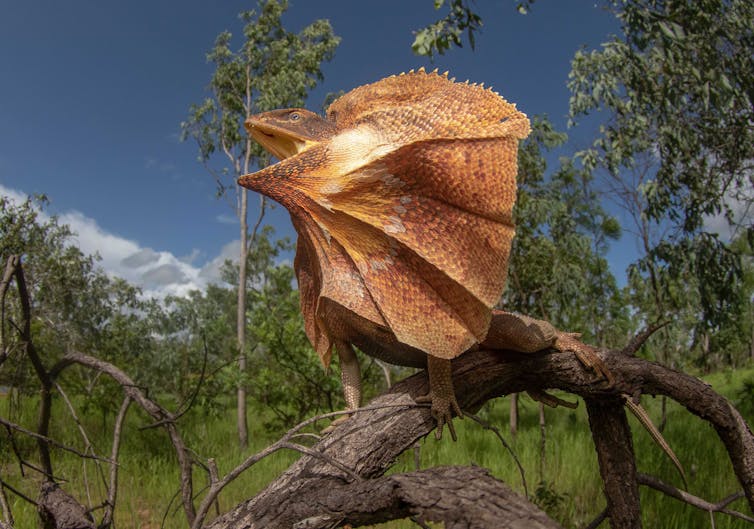
The animals in Australia are super-different to those in Asia. This goes without saying; we know Australia is full of weird and wonderful creatures found nowhere else on Earth, such as the platypus and the koala.
But it may surprise you to know that many of our most iconic critters came from Asia and arrived only recently (in geological terms, at least).
These most recent members of Australia’s characteristic fauna include many lizards, such as goannas and thorny devils, and other animals including hopping mice, flying foxes and the kookaburra. Yet the traffic was largely one way – there are far fewer representatives of Australian fauna in Asia than there are Asian fauna in Australia.
Why is the situation so asymmetrical? In a study published today in the journal Science, my colleagues and I analysed information about the distribution and habitat of 20,433 species of land-dwelling vertebrates – as well as climate and plate tectonics over the past 30 million years – to find out.
Drifting Continents On A Cooling Planet
The story begins more than 200 million years ago.
Dinosaurs were still a fairly new group walking the Earth, and Australia was part of a supercontinent called Gondwana. This giant landmass included modern Antarctica, South America, Africa, Australia and India.
Gondwana had just broken off from another supercontinent, called Laurasia, which was smooshed together from modern North America, Europe and Asia. The separation of Gondwana and Laurasia removed the last land connection between Australia and Asia.
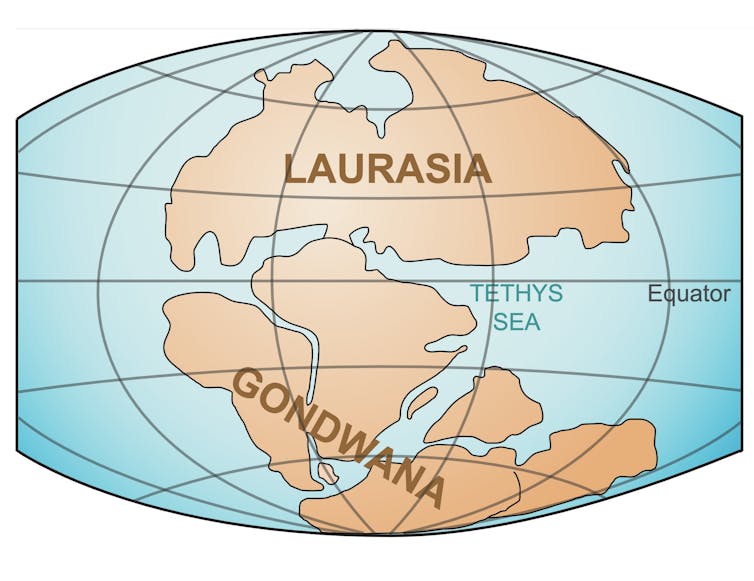
Now, Gondwana itself began to fall part pretty shortly after separating from Laurasia. Each piece of Gondwana gradually became isolated and began its own independent journey. Many of these journeys led them back to Laurasia.
India collided with Eurasia and formed the mighty Himalaya; South America crashed into North America, forming the snaking land bridge of Panama; Africa bumped into Eurasia, forming the Mediterranean Sea; and Australia began on a collision course with Asia.
Australia untethered its final Gondwanan connections between 45 and 35 million years ago, when it broke off from Antarctica.
At that time, Australia was much further south than it is today. As it drifted northwards, the increasing space between Australia and Antarctica kick-started the Antarctic circumpolar current, which cooled the planet dramatically.
Australia was isolated, cooling down and drying out. A unique set of animals and plants began to evolve.
Intercontinental Stepping Stones
Meanwhile, the Australian and Eurasian tectonic plates began to collide, forming thousands of islands in the Indonesian archipelago, including today’s Lombok, Sulawesi, Timor, and Lesser Sunda Isles.
These islands don’t belong to either the Australian continental shelf (also known as Sahul), which includes Australia and New Guinea, or to the Asian continental shelf (known as Sunda), which includes Thailand, Malaysia, Singapore, Sumatra, Java, Borneo, and Bali.
This in-between zone is known as Wallacea, after the 19th century British naturalist Alfred Russell Wallace. He first observed a difference in the types of animals found on either side of what is now called Wallace’s line.
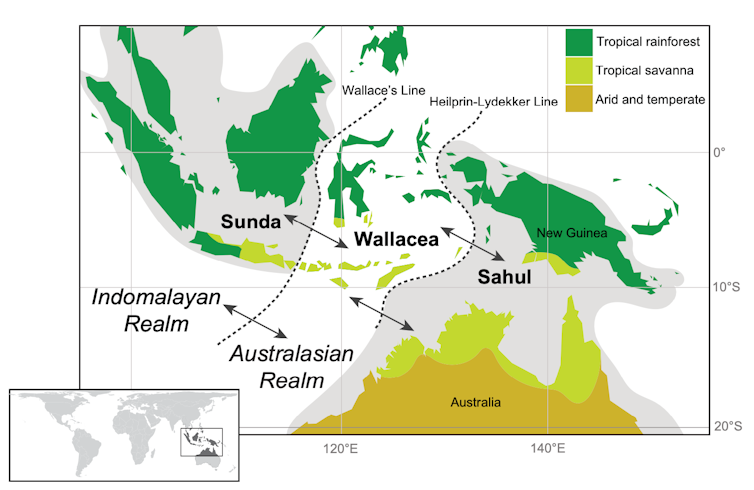
The islands became stepping stones between two continents whose groups of species hadn’t seen each other in a very, very long time. But, as our new research shows, only particular kinds of animals were able to make the crossing and establish themselves on the other side.
Wet And Dry
The first factor determining which animals spread between continents was their ability to cross the ocean.
Of all the groups of animals that moved between Asia and Australia, we found the staggering majority were birds.
But this wasn’t the only key to success.
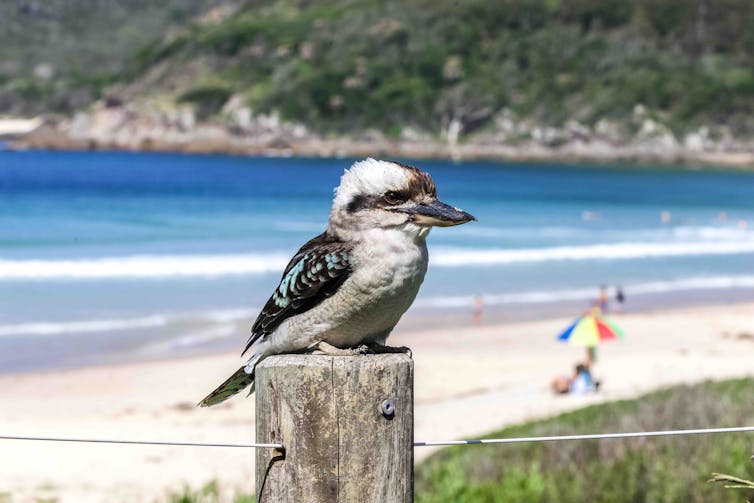
Animals also needed to be able to thrive in their new location, where the environment may have been quite different. We found animals that could tolerate a broad range of wetter and drier environments were more likely to make the move successfully.
This makes sense. Sunda is wet and Sahul is dry, and if you can tolerate more of that wet–dry spectrum, you are better equipped to move between these regions.
But we still have a big question. Why did more animals move from Sunda to Sahul than in the other direction?
A Lot Can Change In 30 Million Years
The final piece of the puzzle is considering how these crucial factors – the ability for species to disperse and establish themselves in new environments – have changed over time.
We know Sunda has been dominated by lush tropical rainforest since before Australia broke away from Antarctica. Later, when the stepping-stone islands began to pop up, they also had the kind of humid equatorial climate favoured by the rainforest vegetation, and later animals, from Sunda.
In Australia, however, similar rainforests were shrinking and being replaced by grasslands and woodlands in most areas.

What this means is that as animals move from Sunda, through the stepping-stone islands, to New Guinea and the northern tips of Australia in Sahul, they experience a band of similar humid tropical climate.
However, most animals in Sahul evolved on the Australian mainland, most of which was much drier. So moving from mainland Australia, through New Guinea and the stepping stones, to Sunda, requires adaptations to a very different environment.
And Australian animals that did manage to make their way onto the stepping-stone islands would have likely met competition from Sunda groups already happily existing in their preferred tropical climate.
Answers Are A Long Time In The Making
Climate and geography are some of the most important things that shape evolution and the distributions of different species. Taking the long view, deep into the past, helps us understand the world around us.
Simple questions – like “why are there no kangaroos in Asia but hopping mice in Australia?” – have answers that are hundreds of millions of years in the making.![]()
Alexander Skeels, Postdoctoral Researcher, Macroevolution and Macroecology Group, Australian National University
This article is republished from The Conversation under a Creative Commons license. Read the original article.
Decades of less rainfall have cut replenishing of groundwater to 800-year low in WA

Groundwater is the world’s biggest source of easily accessible freshwater. Despite its importance, we know very little about how this resource is replenished over time. In a world-first study, we have used caves to show the decades-long decline in rainfall in south-west Australia has reduced the replenishment of groundwater in the region to an 800-year low.
Our findings highlight the immediate threat of climate change to water security for communities in the south-west – the region between Geraldton and Albany, including Perth. Groundwater is the major source of water used in Perth and many rural towns.
Rainfall across south-west Australia has been decreasing since the late 1960s. The region’s drying climate means rainfall may no longer be reliably replenishing its groundwater.
How Can Caves Tell Us About Groundwater Recharge?
Caves are natural windows into what’s happening underground. In caves, we can directly observe water on its way to becoming groundwater. This is an advantage when we want to understand how rainfall replenishes groundwater (technically known as groundwater recharge).
In this study, we measured seven stalagmite records and also water dripping from the cave ceiling from caves located in the Leeuwin-Naturaliste National Park. Stalagmites grow up from the cave floor in limestone caves. These structures build up when dripping water deposits minerals onto the cave floor.
In our study area, the mineral calcite (CaCO₃) is deposited in layers. The oldest layers are at the base of the stalagmite and the youngest layers at the top.
These layers contain a record of past environmental change in the composition of their oxygen isotopes (different naturally occurring forms of oxygen atoms). We measured two of the stable isotopes of oxygen. Our study found both stalagmites and water showed the same change in their chemistry, an “uptick” or rise in the ratio between the two isotopes.
This oxygen isotope record of stalagmites is widely treated as a faithful recorder of changes in rainfall. However, it isn’t that simple in south-west Australia.
We found a change in the oxygen isotope composition of the stalagmites that was ten times greater than the drop in rainfall since the 1960s. This means another process was responsible for the oxygen isotope uptick.
We analysed the water dripping into the caves to help us understand the isotope changes in the stalagmites. We saw differences between water flow types: slower flow through the porous limestone and faster flow along fractures in the limestone, which is known as preferential flow. The faster flow of water had a different oxygen isotope composition, and the uptick in stalagmite oxygen isotopes indicates this flow type has declined in recent decades.
What Does This Mean For Groundwater Recharge?
Preferential flow is an important mechanism for rainfall recharge of groundwater. This flow supplies larger volumes of water to groundwater compared to porous flow.
The impact of reduced preferential flow can be seen in the stalagmite image below. A contraction of the growth to the centre of the stalagmite indicates a reduction in drip rate.
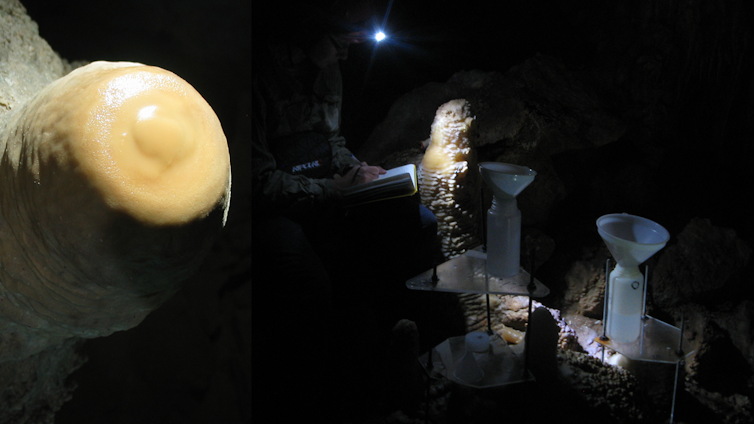
A decline in the local water table from another cave system in the region that began around 1980 matches the beginning of the oxygen isotope uptick. This confirms the decline in rainfall recharge to groundwater.
We now understood how the stalagmite record has captured changes in the groundwater recharge process. We then used the stalagmites to look further back in time to find evidence of previous upticks.
This is the second advantage of having approached this problem using caves. The stalagmite is essentially an archive of past dripwater oxygen isotope composition. Upticks further back in time would indicate if similar reductions in groundwater recharge had occurred.
Importantly, the longer record (shown below) indicates the current reduction in rainfall recharge is unprecedented in the past 800 years.

What Does This Mean For The Region’s Water Supply?
South-west Australia’s drying climate and reduced groundwater recharge have important implications for sustainable use of this resource. Groundwater supplies three-quarters of the water used in the region and future groundwater use is expected to increase. These trends also pose a threat to the plants and animals that live in groundwater-dependent ecosystems.
Australia as a whole depends on finite groundwater resources, which are under mounting pressure. Drought resilience is a research focus of CSIRO, ANSTO and UNSW.
This research includes looking at ways to improve water security, such as water banking. This involves storing water underground using managed aquifer recharge (MAR) techniques. Excess water resources, such as recycled stormwater, are stored when available and used during dry years or a drought.
We are now working towards extending the record further back in time to 10,000 years ago. Our aim is to understand when groundwater was recharged and under what past climate scenarios. This knowledge will give us a better understanding of the limits and sustainability of this vital resource for communities that rely heavily on groundwater.![]()
Stacey Priestley, Research Scientist, Environment Business Unit, CSIRO; Andy Baker, Professor, School of Biological, Earth and Environmental Sciences, UNSW Sydney, and Pauline Treble, Research Scientist, Environment Research Group, Australian Nuclear Science and Technology Organisation
This article is republished from The Conversation under a Creative Commons license. Read the original article.
Here’s why climate change isn’t always to blame for extreme rainfall
Andrew King, The University of Melbourne; Kate R Saunders, Monash University, and Kimberley Reid, Monash UniversityExtreme rain and floods can trigger claims climate change is to blame. But these claims are not always well founded.
In our new paper in Nature Geoscience, we discuss what can and can’t be attributed to climate change straight after extreme rain events. We use the floods of early 2022 in eastern Australia as a case study.
We know a warmer atmosphere can hold more moisture, so it would seem reasonable to say climate change makes extreme rain events worse. But this really only applies to short, heavy downpours. For longer duration events, the climate change signal tends to be weaker and more variable.
We hope our suggestions will improve the quality of scientific statements in the media and, ultimately, increase public understanding of climate change effects on extreme weather.
The Early 2022 Australian Floods
In late February and early March 2022, persistent extreme rainfall caused severe floods across much of the east coast of Australia. Many new rainfall records were set.
Brisbane recorded three consecutive days of over 200mm for the first time and Sydney experienced 16 wet days in a row, tying with a previous record. Much of southeast Queensland and northeast New South Wales had the wettest week since at least 1900.
The floods came towards the end of a third consecutive La Niña summer. Persistent heavy rainfall, associated with large-scale moisture transport in the atmosphere interacting with a trough, caused the flooding.
A blocking high pressure pattern in the Tasman Sea prevented the weather system from moving to the east. This caused the rain to continue and supported the formation of an east coast low, which brought rainfall to the greater Sydney region in early March.
The rain fell on already soaked surfaces, which worsened these floods and also set up the conditions for subsequent floods in Lismore and other parts of the east coast.

These floods occurred not long before the Australian election and led to a renewed focus on climate change action.
While we need to rapidly reduce greenhouse gas emissions to limit the damages caused by climate change, the role of climate change in this extreme rain event is unclear.
Rainfall In A Warming World
There are two necessary ingredients for extreme rainfall to occur – an abundant supply of moisture and ascending air. Heavy rain can occur when moist air rises, cools and condenses. Air can be forced upwards by obstacles such as mountains and by low pressure systems.
As the atmosphere warms it can hold more moisture – about 7% more for every 1℃ of warming. This means climate change has increased the moisture-holding capacity of the atmosphere.
But the climate change effect on low pressure systems that cause air to rise varies across the planet. In some places these are becoming more common and intense. In other places they’re occurring less often.
In the prolonged heavy rainfall of February-March 2022, the duration of the weather patterns was a major factor in the flood impacts. It’s unclear how big a role climate change played.
Short Downpours Or Longer Drenching Rains?
Heavy rain events that cause flash flooding and pass in minutes or hours are often limited by how much moisture is available to fall as rain. A warmer atmosphere can hold more moisture, so these short duration rain events are intensified in a warming world. Recent research shows that in Sydney there has been an increase in sub-hourly heavy rain intensity of about 40% over the last 20 years.
For persistent heavy rain that tends to cause river flooding, the limiting factor is more the positioning of weather systems and whether they stall. As a result, the climate change signal in these events tends to be weaker and more variable across the world.
What Can We Say After Extreme Events?
In the emotionally charged time following extreme events, it is important that commentators – whether they are scientists or journalists, politicians or advocates – make scientifically accurate statements on the role of climate change.
In our paper, we recommend scientists consider different lines of evidence before making statements on the role of climate change in extreme rainfall. These include examining observational trends and relevant peer-reviewed research on the climate of the area where the extreme event occurred.
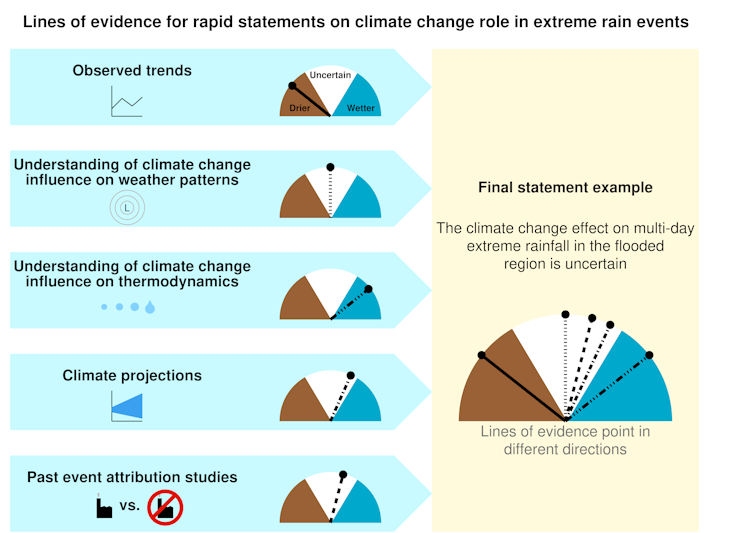
Robust statements on the effects of climate change on extreme events improve the public discourse and are crucial to planning for weather and climate extremes in a warming world.
The impacts of climate change are drastic enough. We don’t need to sensationalise them.![]()
Andrew King, Senior Lecturer in Climate Science, The University of Melbourne; Kate R Saunders, Lecturer, Monash University, and Kimberley Reid, Postdoctoral Research Fellow in Atmospheric Sciences, Monash University
This article is republished from The Conversation under a Creative Commons license. Read the original article.
We could need 6 times more of the minerals used for renewables and batteries. How can we avoid a huge increase in mining impacts?
Rusty Langdon, University of Technology Sydney and Elsa Dominish, University of Technology SydneyWe are seeing the biggest changes in our energy and transport systems since industrialisation. By 2026, global renewable energy generation is expected to match total fossil fuel and nuclear output. Building the wind and solar farms, batteries and electricity networks we need to run our system on renewables will use a huge array of mined minerals, known as “transition minerals”.
The numbers are staggering. The International Energy Agency estimates a sixfold increase in demand for these minerals by 2040 to meet climate targets of well below 2℃ of warming. We could need 21.5 million tonnes for electric vehicles and battery storage alone.
Transitional minerals include metals such as lithium, cobalt, copper, graphite, magnesium and nickel. They also include rare earths like neodymium, praseodymium, dysprosium and terbium.
Currently, mining provides almost our entire supply. The scale of demand for these minerals could result in almost 400 new mines by 2035.
To put this in perspective, Australia has around 350 operating mines. More than 50% of the world’s lithium and much of its copper, cobalt, nickel and rare earths come from our mines.
Australia is hosting the World Mining Congress this week. A key issue for the industry is how we can ensure the minerals needed for the energy transition are sourced responsibly.
How Can We Manage Demand?
We can design energy and transport systems to minimise mineral demand. Strategies include:
- reducing our dependence on cars and using smaller vehicles
- improving energy efficiency
- moving to a circular economy that makes reuse and recycling a priority.
All these changes can reduce the need for new mines.
Recycling, for example, could reduce demand for mined materials. For lithium-ion batteries for electric vehicles, estimated reductions are 25% for lithium, 35% for cobalt and nickel, and 55% for copper by 2040.
This recycled content will mainly come from waste batteries. However, large volumes of lithium-ion batteries won’t start reaching the end of their lives for at least a decade. Recycling will only have a significant impact from 2035.
Mining Is Unavoidable, So We Must Limit Its Impacts
If we are destined to continue mining for the minerals needed for the energy transition, how can this be done responsibly? And what exactly do we mean by responsible sourcing?
Responsible sourcing minimises the environmental, social and governance impacts and risks of mining. Key concerns include the use of child labour and forced labour, damage to the environment, impacts on Indigenous rights and cultural heritage, and corruption.
In 2011, the Australian government released guidance on sustainable mining. Historical and recent harmful impacts highlight the need for a fresh look at mining practices. In 2020, for example, Rio Tinto destroyed a 46,000-year-old Aboriginal heritage site in Juukan Gorge.
First Nations people worldwide are calling for free, prior and informed consent when mining and renewable energy developments are proposed for their land. This approach recognises the right to be consulted early in the process, informed of the impacts, and supported to take part in negotiation and making agreements. Most importantly, it includes the right to say no.
In many parts of Australia, Indigenous communities have been locked out of economic opportunities, despite mining generating enormous wealth on their Country.
What Does Responsible Sourcing Involve?
How do we do things more responsibly? We need to ensure activities comply with a range of sustainability criteria. An agreed standard will mean we have information that enables us to compare the good and bad apples.
The problem is there isn’t a common approach to measuring, managing and reporting environmental, social and governance performance. Our recent research analysed the plethora of voluntary standards and certifications available to battery materials producers. No common global or Australian standard has been adopted.
Smaller mining companies also struggle with the administrative complexities of sustainability reporting and management criteria. An agreed common language for reporting and management is needed. Only then can traceability solutions, such as the Global Battery Alliance’s blockchain-enabled “battery passport”, produce trustworthy and comparable results.
Let’s Set The Bar High
Our research identified the Initiative for Responsible Mining Assurance (IRMA) as one of the more rigorous standards. Its credibility is built on how it is governed. This involves six stakeholder groups: mining companies, purchasers, NGOs, affected communities, labour organisations and the finance sector.
There are still questions to be answered. How do practices in Australia measure up to the standard? And how can regulatory reform help to steer mining operations in the right direction?
A focus on environmental, social and governance practices in the Australian Critical Minerals Strategy, released last week, is a welcome first step.
Issues that must be front and centre include:
- mining impacts on water supply
- free, prior and informed consent from First Nations communities
- integrated planning for climate change impacts such as extreme weather that may affect management of mine tailings
- biodiversity protection
- mine closure planning that integrates progressive rehabilitation of ecosystems
- circular business practices to make the most of what we have.
As a leading mining nation, Australia is in a position to leverage its historical environmental leadership, show renewed responsibility and integrity, and lead by example. We can then help leave the planet in a shape that future generations will be proud to inherit.![]()
Rusty Langdon, Senior Research Consultant, Institute for Sustainable Futures, University of Technology Sydney and Elsa Dominish, Research Principal, Institute for Sustainable Futures, University of Technology Sydney
This article is republished from The Conversation under a Creative Commons license. Read the original article.
New transmission lines are controversial for nearby communities. But batteries and virtual lines could cut how many we need
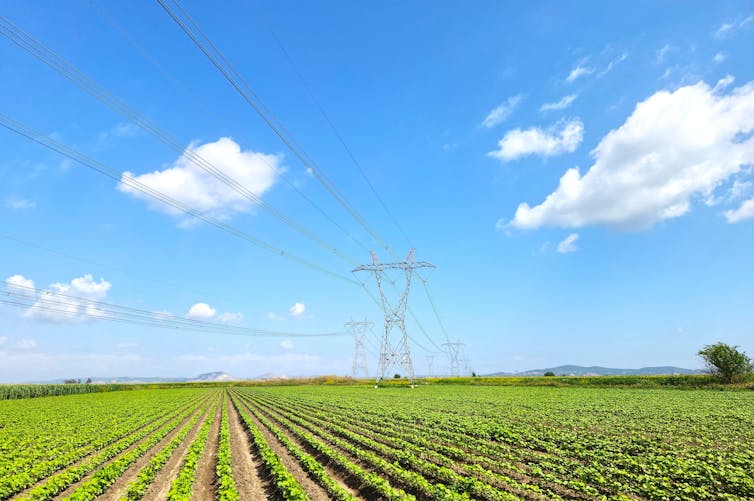
Australia’s power grid was built to transport power from coal-fired power stations or the Snowy Hydro scheme to large cities and industrial precincts. The large transmission lines were designed with generation supply and demand, the shortest routes, and cost in mind.
But this ageing grid isn’t designed to cope with a green future where power flows into the grid from solar farms and windfarms on land and out at sea. To cope, Australia’s energy market operator is proposing over 10,000 kilometres of new transmission lines, linking major renewable precincts with the cities.
The problem? No one likes having large, unsightly lines built near them. There’s already been strong pushback from communities near sites slated for new power lines. Community resistance has now forced the federal government to launch a review of how transmission projects are approved.
The good news is, some alternatives to large-scale transmission lines have come of age. Grid-scale battery banks have already proven their use to store intermittent flows of green electricity for later. And we may be able to build more lightly if we adopt dynamic line rating, which means letting more power flow through when, say, cold winds cool the lines and stop them overheating. Western Australia – which has its own grid – is having success with microgrids as a way to avoid having to send power long distances.
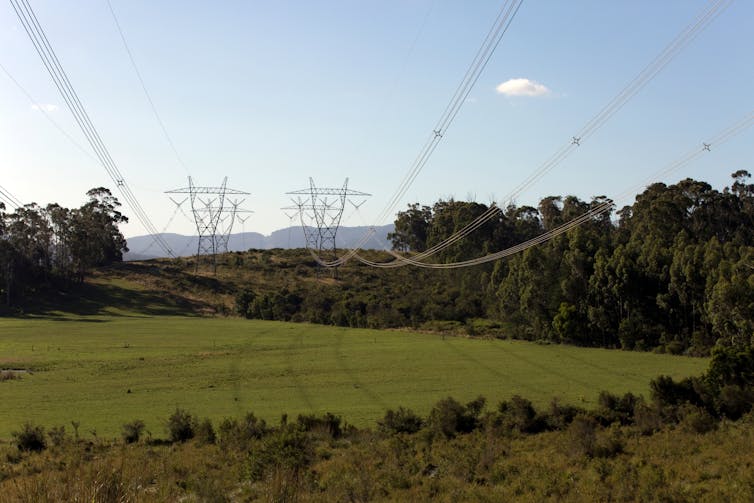
How Can We Minimise New Transmission Lines?
Coal power was concentrated in coal-rich areas such as the LaTrobe Valley in Victoria and the Hunter Valley in New South Wales.
But the best renewable resources are often located in different places. That means a green grid has to connect new renewable zones such as Victoria’s Murray River zone and New South Wales’ Illawarra zone. (Some coal areas, like the LaTrobe Valley, will be able to take advantage of resources such as offshore wind and pair this with existing transmission infrastructure).
We will have to build some new transmission infrastructure. That’s unavoidable. But we can do this cleverly and minimise the impact on communities and landowners.
How? Battery banks allow us to store energy for later use. So if new transmission lines are built leaner and smaller, we could use these grid batteries to store excess energy and transmit it later.
Dynamic line rating offers another way to reduce the scale of new transmission lines.
Every transmission line is rated to a certain power capacity. A key factor limiting how much electricity can flow through a given line is heat. As electrons move, they produce heat. Too high a current and the line will overload.
But if, say, the wind is blowing strongly, it can cool the power lines and let them carry more capacity. That’s especially useful in a grid with a lot of wind energy flowing in. When the weather conditions are right, it could mean carrying as much as 20% more current.
Aren’t Grid Batteries More About Reliability?
At present, large-scale lithium batteries are the most technically viable way to store electricity relatively cheaply. These are already up and running. South Australia’s Hornsdale battery was one of the first, but other states are now joining in. Victoria recently installed a new big battery on the site of a former coal power station.
To date, these batteries have mainly been used to firm up output and boost system reliability.
But they can do more. We can use them as virtual power lines, storing excess power close to a renewable zone and transmitting it to another storage system close to cities and towns as the peak load arrives.
The virtual power line concept has been adopted in Germany and Chile to relieve transmission systems at risk of congestion when bursts of renewable power arrive.
We can even use them as virtual reservoirs, storing energy from hydro plants for later transmission.
How Can We Put These To Use?
It’s in everyone’s interests to minimise how many new transmission lines we build. For the government, being able to reduce the size of the build means savings – and less demand on our already stretched workforce. And for local communities, it means some – but not all – new lines could be avoided.
How do we make it a reality? Essentially, by embedding these new approaches into the way we plan for the electricity grid of the future. When considering any new transmission lines, planners should assess whether part of the needed transmission capacity could instead be provided by virtual powerlines in the form of batteries, and whether the area is suitable for dynamic line rating schemes.
If we integrate these methods of making the most out of our grid’s capacity, we could keep the number of new lines to the minimum while ensuring we can take clean power from where it’s produced to where it’s needed. ![]()
Lasantha Meegahapola, Associate Professor, RMIT University
This article is republished from The Conversation under a Creative Commons license. Read the original article.
The furry puss caterpillar’s venom packs a painful punch. Now new research shows it came from an unlikely source
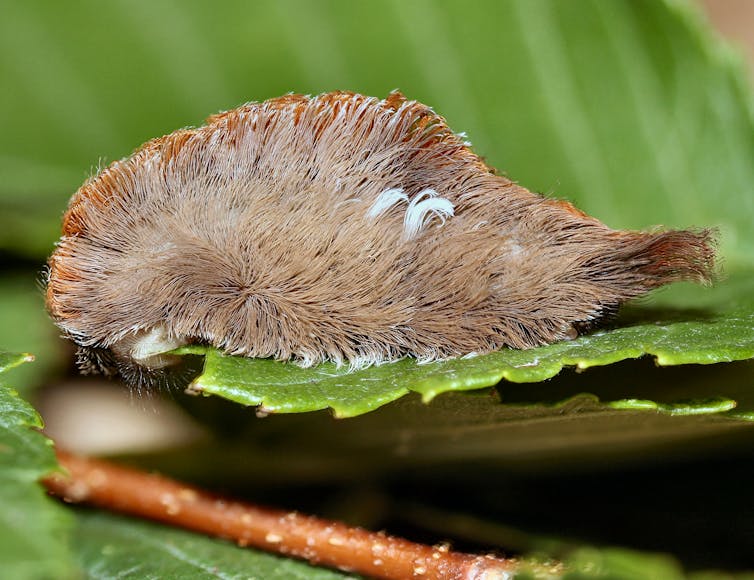
Did you know venom – a toxic substance injected by one animal into another – has evolved around 100 times?
In our laboratory at the University of Queensland, my colleagues and I study all kinds of venomous animals. One reason we do this is to find new molecules that can be used in medicines, or as bio-friendly insecticides.
Scientists have used venom toxins from snakes, spiders and scorpions in various medical contexts, including to lower blood pressure, protect against stroke, and label tumours during surgery.
There are several other groups of venomous animals, such as assassin bugs and robber flies, which have been largely neglected – yet their venom may prove to be just as useful to humans.
In research published today in the Proceedings of the National Academy of Sciences, our team investigated the venom from a group of caterpillars called asp caterpillars, which are notorious for their ability to cause excruciating pain. They’re also called puss caterpillars since they sport long, soft hairs that have been dubbed “toxic toupées”.
We were surprised to find the main painful toxins in asp caterpillars belong to a family of molecules usually found in disease-causing bacteria. We discovered that a gene that codes for this kind of toxin hopped from bacteria to the ancestors of moths and butterflies millions of years ago, in a phenomenon called horizontal gene transfer.
Float Like A Butterfly, Sting Like A Bee
The insect group Lepidoptera, which we usually think of as butterflies and moths, are my favourite venomous animals. Interestingly, it’s always the larval forms (caterpillars) that are armed with venom, and not the adults. We think this is because caterpillars are particularly helpless against predators, and therefore need special defences.
This is also why venom has evolved multiple times just within Lepidoptera. Unlike most arthropods, which use venom for hunting, caterpillars are among a select few (including bees) that use it purely to defend themselves from predators.
However, the venom of some of these caterpillar groups, including asp caterpillars, has never been examined with modern methods.
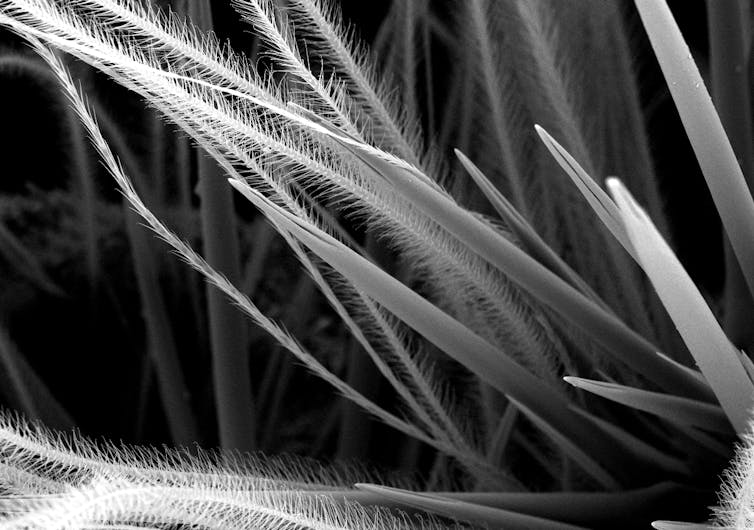
Evolution By Horizontal Gene Transfer
People who have been stung by asp caterpillars have described the feeling as being similar to “touching burning coals” or “being hit with a baseball bat”. We set out to find what this venom contains and how it can inflict such incredible pain.
Asp caterpillars aren’t found in Australia, so I had to travel to Florida to collect them from oak and elm trees. Although I couldn’t return with live individuals (due to the threat of invasive species), with the help of some US researchers I was able to bring some venom and preserved caterpillars back to the lab for analysis.
We used a variety of imaging and molecular techniques to build a picture of where the venom is made, what kinds of toxins it contains, and how those toxins produce pain.
Surprisingly, when we looked at the structures of the main pain-causing toxins, we found they belonged to a toxin group usually produced by bacteria, including disease-causing bacteria such as E. coli and salmonella. These caterpillar toxins work by punching holes in cells – the same mechanism the bacterial toxins use to inflict damage on humans.
When we analysed the family tree of the toxins in detail, we found a gene that codes for this kind of toxin had “hopped” from a bacterium to the ancestors of butterflies and moths hundreds of millions of years ago.
These hopping events are called horizontal gene transfer to distinguish them from the vertical transfer of genes from parents to offspring. These events are very rare.
In the case of asp caterpillars, DNA from the infecting bacteria would have not only had to come into contact with the ancestral caterpillar, but also get incorporated into its DNA, inside the cells that would become sperm or eggs (and be passed on to subsequent generations).
We know of only a few examples of the horizontal gene transfer of venom toxins.
Harnessing Nature’s Resources
Our study shows evolution and life are weirder and more complex than we usually assume. Beyond this, projects like this can also help us discover new ways in which venom toxins may benefit humans and the environment.
For example, toxins that make holes in cell membranes are already being investigated for their ability to deliver lifesaving drugs to the inside of cells.
Another potential application is in engineering toxins that could punch holes in cells to selectively kill cancer cells, while leaving normal cells intact. Our ability to develop such new technologies depends on discovering and understanding the molecular resources that exist in nature.![]()
Andrew Walker, Postdoctoral Research Fellow, Institute for Molecular Bioscience, The University of Queensland
This article is republished from The Conversation under a Creative Commons license. Read the original article.
The true origins of the world’s smallest and weirdest whale
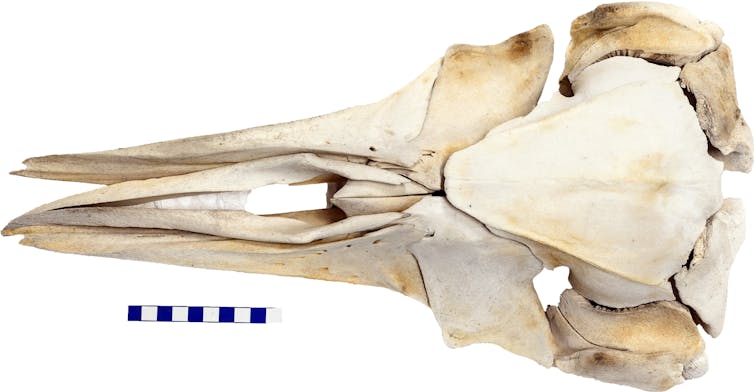
The pygmy right whale, Caperea marginata, is the weirdest whale you’ve probably never heard of.
It is the smallest of the living baleen whales and restricted to the Southern Hemisphere.
Its tank-like skeleton is unique among whales, and its ecology and behaviour remain virtually unknown. Even its mitochondria – the power plants of the cell – seem to be ticking differently.
Because Caperea is so unusual, its evolutionary relationships have long been a bone of contention.
Our new study in the international Marine Mammal Science journal finally solves this enduring mystery.
You Are What You Eat?
For 150 years, anatomists considered Caperea a relative of right whales.
Then came the age of DNA, and Caperea was reinterpreted as a distant cousin of rorquals, which include the mighty blue whale, humpback and minke whale.
Many scientists remained unconvinced, however, leading to decades of acrimonious debates over bones, fossils and molecules.
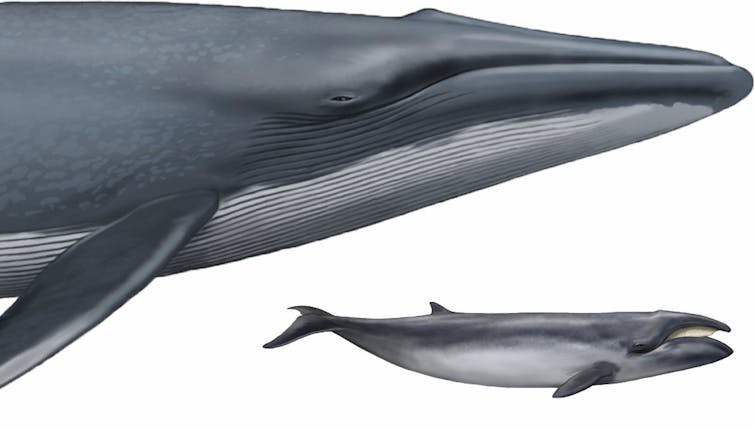
For more than a century, the case for Caperea being a right whale seemed sound. Sure, it looked weird and small, but its feeding strategy was a dead ringer.
Like right whales, Caperea uses long, finely-fringed baleen plates to skim tiny crustaceans from seawater. Also like right whales, it has a hugely arched snout to accommodate its long baleen, which water and prey stream past continuously during feeding.
Now compare this to rorquals. Unlike Caperea, they feed in short bouts during which they engulf enormous amounts of water and prey in expandable throat pouches. They then expel the water through their short, coarsely-fringed baleen and trap any prey inside the mouth.
The implications of this brief comparison are obvious: Caperea resembles right whales far more than it does rorquals, and so must have the same evolutionary origin.
Morphology Versus Molecules
Molecular data for Caperea first became available in the 1990s and immediately challenged the traditional view. Time and again, genes allied Caperea with rorquals, rather than right whales.
Such disagreements are normal in science and do not diminish the importance of anatomy, which, after all, remains the only way to study the 99% of species that are already extinct. But anatomical family trees have a nemesis: convergence.
Convergent evolution happens when unrelated species evolve similar traits. Just think of the streamlined bodies of sharks, whales and the extinct ichthyosaurs. Could this be what happened to Caperea?
As molecular evidence mounted, geneticists began to accept Caperea as a distant rorqual relative. Anatomists, however, disagreed.
Fuelling the debate was the fact that only some of the DNA of Caperea had actually been sequenced. Interpreting such a subset is risky, as each gene can have its own unique evolutionary history.
Also unhelpful was the deplorable fossil record of pygmy right whales. Sometimes, key fossils can settle evolutionary debates, as happened in 2001 when two pivotal finds confirmed the origin of whales from hoofed mammals.
Caperea, however, remains largely alone. Even though its lineage is undoubtedly ancient, we only know of six related fossils worldwide.
With both traditional genetic and fossil approaches at a loss, where else was there to turn? Enter genomics.
What Our DNA Testing Revealed
Genomics studies all of an organism’s DNA – its entire molecular blueprint. DNA ultimately determines body shape, so comparing genomes should either corroborate anatomical family trees or expose the effects of convergence.
Sequencing genomes is costly and took a long time to achieve at scale. Even so, recent years have seen huge advances and produced genomes for most baleen whales. Except, you guessed it, the elusive Caperea.
Here is where our study comes in. Using a sample from a stranded individual from South Australia, we finally sequenced the genome of the pygmy right whale.
Unbeknown to us, a separate research group in Europe had had the same idea. Both teams published their results within a few weeks of each other.
Crucially, their conclusions were the same: Caperea is indeed related to rorquals like the blue whale. Its similarities with right whales are the result of similar feeding strategies, rather than genetics.
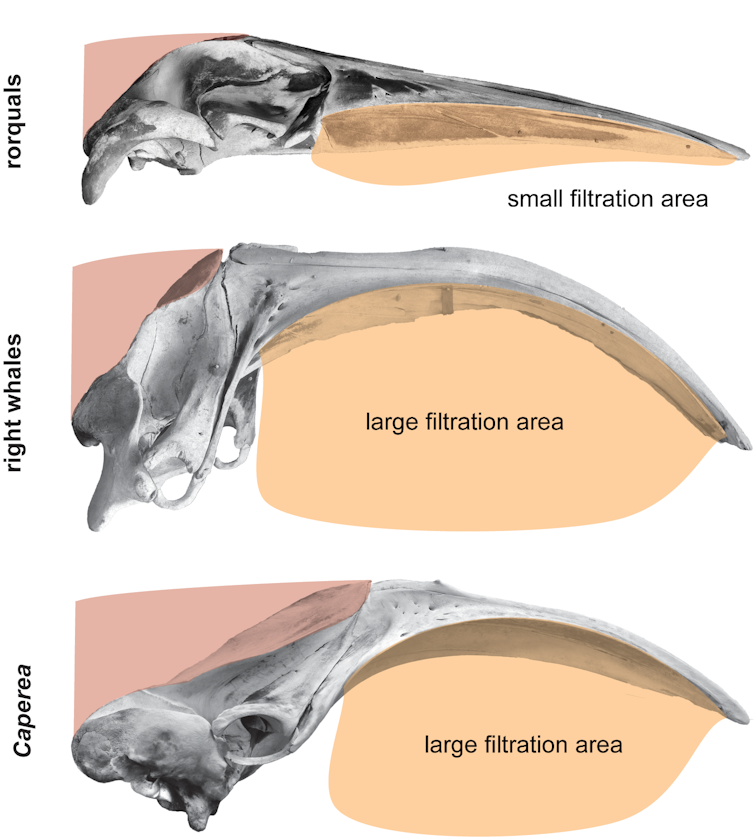
So What Is Caperea Really?
Proving that Caperea is not a right whale raises another question: why is it so unlike its rorqual cousins?
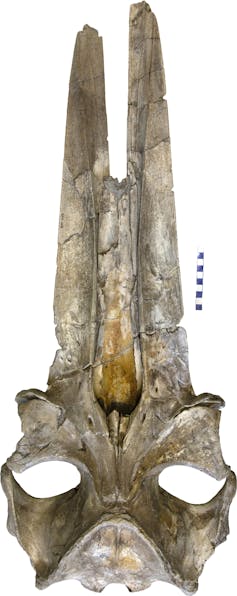
To start answering this, we need to consider the great antiquity of Caperea‘s ancestry. Molecular dating suggests it diverged from other whales at least 14 million years ago, and perhaps much earlier. The oldest recognisable fossils, however, are just 10 million years old.
What, then, fills the gap? One possibility is that Caperea sprang from the cetotheriids, an ancient family of whales once thought to be extinct.
Many palaeontologists remain sceptical about this idea and instead have clung to the traditional grouping of Caperea with right whales. But anatomical data sets will now need to be re-examined to weed out the effects of convergence.
What this process might reveal remains unclear, of course, but cetotheriids are certainly back in the running.
New insights might also come from new fossils or ancient proteins. Whereas DNA completely breaks down after about a million years, proteins can persist far longer - maybe just long enough to test ideas like Caperea’s cetotheriid origin more rigorously. ![]()
Nic Rawlence, Senior Lecturer in Ancient DNA, University of Otago; Felix Georg Marx, Curator Vertebrates, Te Papa Tongarewa, and Ludovic Dutoit, , University of Otago
This article is republished from The Conversation under a Creative Commons license. Read the original article.
All animal intelligence was shaped by just 5 leaps in brain evolution
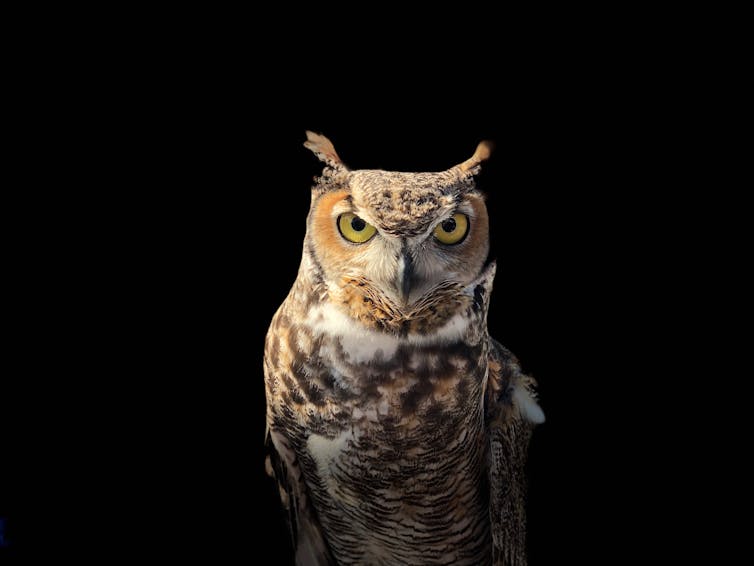
The animal world is full of different types of intelligence, from the simple bodily coordination of jellyfish to the navigation abilities of bees, the complex songs of birds and the imaginative symbolic thought of humans.
In an article published today in Proceedings of the Royal Society B, we argue the evolution of all these kinds of animal intelligence has been shaped by just five major changes in the computational capacity of brains.
Each change was a major transitional point in the history of life that changed what types of intelligence could evolve.
The Coordination Problem
The first intelligence transition was the development of animals with a nervous system. Some have argued single-celled organisms show adaptive and complex behaviour and forms of learning, but these are limited to life at tiny sizes.
Multi-cellular bodies allowed animals to get big and exploit entirely new physical domains. However, a multi-cellular body need to be coordinated to actively move as a single entity. A nervous system solves that coordination problem.
The simplest nervous systems look something like the kind of diffuse neural networks we see in jellyfish. This is great for coordinating a body, but it is not so good at putting information together.
Growing A Brain
The second transition was to a centralised nervous system. With this came a brain, and the capacity to combine information from different senses.
A brain can be the master coordinator of the whole body, and this let new types of bodies evolve: bodies with specialised limbs and special sensory structures.
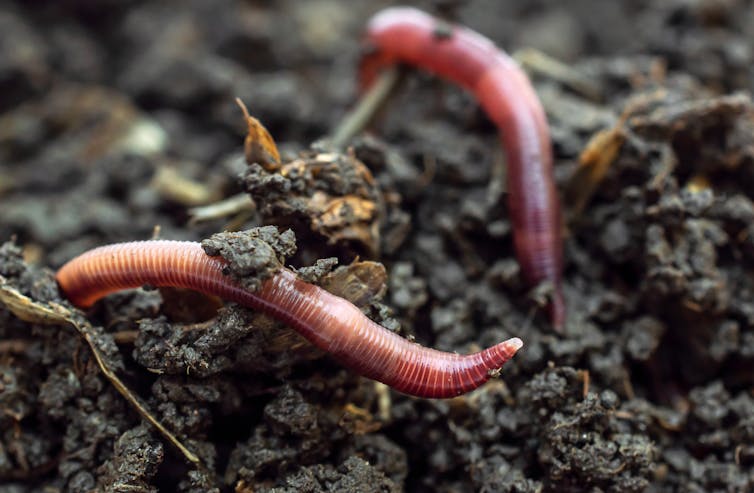
We see these very simple brains in modern worms, leeches and tardigrades. With these brains animals can integrate senses, learn from sensory input, coordinate and orient their movements.
Simple brains transform sensory input to motor output. We can think of the information flow as a “feed forward” from information to action.
A Feedback Loop
The third transition was to more complex brains, specifically ones with feedback. When the output of a process is fed back into the process, we call it “recurrence”.
Insects have recurrent brains. The brilliance of bees – their ability to quickly learn different types of art, to recognise abstract concepts and to navigate to goal locations – is all enabled by their recurrent brains.
Parallel Processing
The fourth transition is to brains constructed from multiple recurrent systems each in recurrent connection to each other. Here information flow iterates through recurrent systems. We see brains like this in birds, dogs, reptiles and fish.
This allows massive parallel processing of information. The same information can be used in multiple different ways at the same time, and relationships between different types of information can be recognised.

These networks of recurrent systems are why birds are so good at learning complex sequences in songs; why birds, rats and dogs are great at learning what, where and when things happen; and why monkeys can learn new ways to manipulate objects to solve problems and make rudimentary tools.
The Brain That Modifies Itself
The fifth transition was to brains that can modify their own computational structure according to what is needed. In computer science this is called reflection.

A reflective brain can learn the best information flow for a specific task and modify how it processes information on the fly to complete the task in the fastest and most efficient way.
The human brain is reflective, and this capability has enabled our imagination, our thought processes and our rich mental lives. It also opened the door for the use of symbolic language, which expanded our minds even further as it helped us communicate and coordinate so efficiently with each other.
Different Brains For Different Lifestyles
Each of these transitions is a a set of evolved changes in the structure of information flow through the nervous system. Each transition changed in fundamental ways what the nervous system could do and opened up new possibilities for cognition.
The transitions build on each other. For example, you cannot have recurrence without first evolving centralisation. But this story is not a ladder with Homo sapiens at the top.
Our story describes five fundamentally different types of brain. One is not better than another, each is just different.

We might like to claim we are the smartest animal and depending how you measure it, perhaps we are. But a bee can do things a human simply cannot.
Our intelligence demands an extended childhood, in which we can’t even walk for a year; a bee is fully functional from the moment its wings dry as it emerges from its cell. A bee can learn to navigate for kilometres around its hive with less than 20 minutes of flight time; I still get lost walking home from the train.
And a jellyfish or a worm might not be Einstein, but they can tolerate a level of damage that would kill or paralyse a mammal.
Different types of brains suit animals to different lifestyles, and support different types of animal minds. These five transitions help us make sense of our place among the stunning diversity of animal intelligences.![]()
Andrew Barron, Professor, Macquarie University
This article is republished from The Conversation under a Creative Commons license. Read the original article.
Bees are astonishingly good at making decisions – and our computer model explains how that’s possible
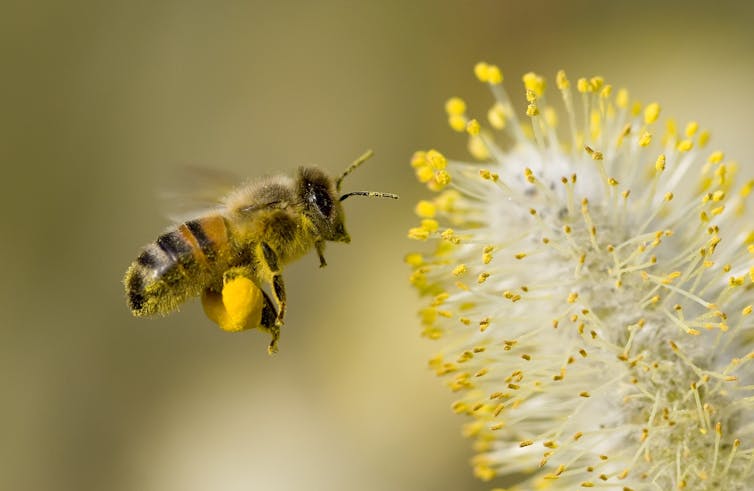
A honey bee’s life depends on it successfully harvesting nectar from flowers to make honey. Deciding which flower is most likely to offer nectar is incredibly difficult.
Getting it right demands correctly weighing up subtle cues on flower type, age and history – the best indicators a flower might contain a tiny drop of nectar. Getting it wrong is at best a waste of time, and at worst means exposure to a lethal predator hiding in the flowers.
In new research published today in eLife our team reports how bees make these complex decisions.
A Field Of Artificial Flowers
We challenged bees with a field of artificial flowers made from coloured disks of card, each of which offered a tiny drop of sugar syrup. Different-coloured “flowers” varied in their likelihood of offering sugar, and also differed in how well bees could judge whether or not the fake flower offered a reward.
We put tiny, harmless paint marks on the back of each bee, and filmed every visit a bee made to the flower array. We then used computer vision and machine learning to automatically extract the position and flight path of the bee. From this information, we could assess and precisely time every single decision the bees made.
We found bees very quickly learned to identify the most rewarding flowers. They quickly assessed whether to accept or reject a flower, but perplexingly their correct choices were on average faster (0.6 seconds) than their incorrect choices (1.2 seconds).
This is the opposite of what we expected.
Usually in animals – and even in artificial systems – an accurate decision takes longer than an inaccurate decision. This is called the speed-accuracy tradeoff.
This tradeoff happens because determining whether a decision is right or wrong usually depends on how much evidence we have to make that decision. More evidence means we can make a more accurate decision – but gathering evidence takes time. So accurate decisions are usually slow and inaccurate decisions are faster.
The speed-accuracy tradeoff occurs so often in engineering, psychology and biology, you could almost call it a “law of psychophysics”. And yet bees seemed to be breaking this law.
The only other animals known to beat the speed-accuracy tradeoff are humans and primates.
How then can a bee, with its tiny yet remarkable brain, be performing on a par with primates?
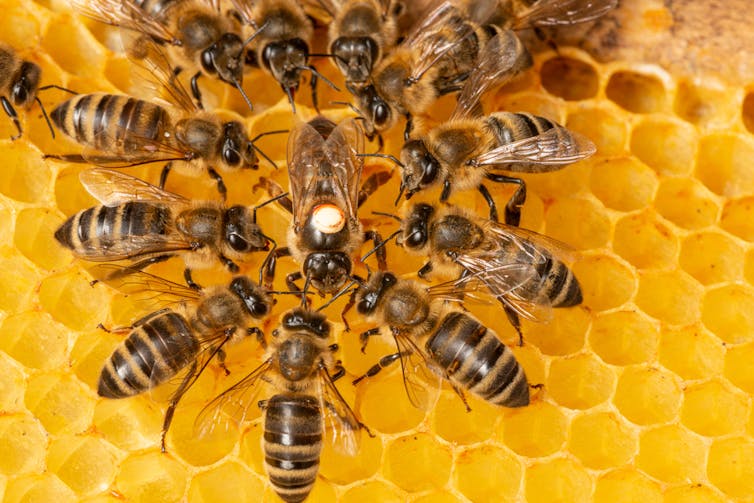
Bees Avoid Risk
To take apart this question we turned to a computational model, asking what properties a system would need to have to beat the speed-accuracy tradeoff.
We built artificial neural networks capable of processing sensory input, learning and making decisions. We compared the performance of these artificial decision systems to the real bees. From this we could identify what a system had to have if it were to beat the tradeoff.
The answer lay in giving “accept” and “reject” responses different time-bound evidence thresholds. Here’s what that means – bees only accepted a flower if, at a glance, they were sure it was rewarding. If they had any uncertainty, they rejected it.
This was a risk-averse strategy and meant bees might have missed some rewarding flowers, but it successfully focused their efforts only on the flowers with the best chance and best evidence of providing them with sugar.
Our computer model of how bees were making fast, accurate decisions mapped well to both their behaviour and the known pathways of the bee brain.
Our model is plausible for how bees are such effective and fast decision makers. What’s more, it gives us a template for how we might build systems – such as autonomous robots for exploration or mining – with these features.![]()
Andrew Barron, Professor, Macquarie University
This article is republished from The Conversation under a Creative Commons license. Read the original article.
Pittwater Reserves: Histories + Notes + Pictorial Walks
A History Of The Campaign For Preservation Of The Warriewood Escarpment by David Palmer OAM and Angus Gordon OAM
A Stroll Through Warriewood Wetlands by Joe Mills February 2023
A Walk Around The Cromer Side Of Narrabeen Lake by Joe Mills
America Bay Track Walk - photos by Joe Mills
An Aquatic June: North Narrabeen - Turimetta - Collaroy photos by Joe Mills
Angophora Reserve Angophora Reserve Flowers Grand Old Tree Of Angophora Reserve Falls Back To The Earth - History page
Annie Wyatt Reserve - A Pictorial
Avalon's Village Green: Avalon Park Becomes Dunbar Park - Some History + Toongari Reserve and Catalpa Reserve
Bairne Walking Track Ku-Ring-Gai Chase NP by Kevin Murray
Bangalley Headland Bangalley Mid Winter
Banksias of Pittwater
Barrenjoey Boathouse In Governor Phillip Park Part Of Our Community For 75 Years: Photos From The Collection Of Russell Walton, Son Of Victor Walton
Barrenjoey Headland: Spring flowers
Barrenjoey Headland after fire
Bayview Baths
Bayview Wetlands
Beeby Park
Bilgola Beach
Botham Beach by Barbara Davies
Bungan Beach Bush Care
Careel Bay Saltmarsh plants
Careel Bay Birds
Careel Bay Clean Up day
Careel Bay Playing Fields History and Current
Careel Creek
Careel Creek - If you rebuild it they will come
Centre trail in Ku-ring-gai Chase National Park
Chiltern Track- Ingleside by Marita Macrae
Clareville Beach
Clareville/Long Beach Reserve + some History
Coastal Stability Series: Cabbage Tree Bay To Barrenjoey To Observation Point by John Illingsworth, Pittwater Pathways, and Dr. Peter Mitchell OAM
Cowan Track by Kevin Murray
Curl Curl To Freshwater Walk: October 2021 by Kevin Murray and Joe Mills
Currawong and Palm Beach Views - Winter 2018
Currawong-Mackerel-The Basin A Stroll In Early November 2021 - photos by Selena Griffith
Currawong State Park Currawong Beach + Currawong Creek
Deep Creek To Warriewood Walk photos by Joe Mills
Drone Gives A New View On Coastal Stability; Bungan: Bungan Headland To Newport Beach + Bilgola: North Newport Beach To Avalon + Bangalley: Avalon Headland To Palm Beach
Duck Holes: McCarrs Creek by Joe Mills
Dunbar Park - Some History + Toongari Reserve and Catalpa Reserve
Dundundra Falls Reserve: August 2020 photos by Selena Griffith - Listed in 1935
Elsie Track, Scotland Island
Elvina Track in Late Winter 2019 by Penny Gleen
Elvina Bay Walking Track: Spring 2020 photos by Joe Mills
Elvina Bay-Lovett Bay Loop Spring 2020 by Kevin Murray and Joe Mills
Fern Creek - Ingleside Escarpment To Warriewood Walk + Some History photos by Joe Mills
Iluka Park, Woorak Park, Pittwater Park, Sand Point Reserve, Snapperman Beach Reserve - Palm Beach: Some History
Ingleside
Ingleside Wildflowers August 2013
Irrawong - Ingleside Escarpment Trail Walk Spring 2020 photos by Joe Mills
Irrawong - Mullet Creek Restoration
Katandra Bushland Sanctuary - Ingleside
Lucinda Park, Palm Beach: Some History + 2022 Pictures
McCarrs Creek
McCarr's Creek to Church Point to Bayview Waterfront Path
McKay Reserve
Mona Vale Beach - A Stroll Along, Spring 2021 by Kevin Murray
Mona Vale Headland, Basin and Beach Restoration
Mona Vale Woolworths Front Entrance Gets Garden Upgrade: A Few Notes On The Site's History
Mount Murray Anderson Walking Track by Kevin Murray and Joe Mills
Mullet Creek
Narrabeen Creek
Narrabeen Lagoon Catchment: Past Notes Present Photos by Margaret Woods
Narrabeen Lagoon State Park
Narrabeen Lagoon State Park Expansion
Narrabeen Rockshelf Aquatic Reserve
Nerang Track, Terrey Hills by Bea Pierce
Newport Bushlink - the Crown of the Hill Linked Reserves
Newport Community Garden - Woolcott Reserve
Newport to Bilgola Bushlink 'From The Crown To The Sea' Paths: Founded In 1956 - A Tip and Quarry Becomes Green Space For People and Wildlife
Pittwater Reserves: The Green Ways; Bungan Beach and Bungan Head Reserves: A Headland Garden
Pittwater Reserves, The Green Ways: Clareville Wharf and Taylor's Point Jetty
Pittwater Reserves: The Green Ways; Hordern, Wilshire Parks, McKay Reserve: From Beach to Estuary
Pittwater Reserves - The Green Ways: Mona Vale's Village Greens a Map of the Historic Crown Lands Ethos Realised in The Village, Kitchener and Beeby Parks
Pittwater Reserves: The Green Ways Bilgola Beach - The Cabbage Tree Gardens and Camping Grounds - Includes Bilgola - The Story Of A Politician, A Pilot and An Epicure by Tony Dawson and Anne Spencer
Pittwater spring: waterbirds return to Wetlands
Pittwater's Lone Rangers - 120 Years of Ku-Ring-Gai Chase and the Men of Flowers Inspired by Eccleston Du Faur
Pittwater's Parallel Estuary - The Cowan 'Creek
Resolute Track at West Head by Kevin Murray
Resolute Track Stroll by Joe Mills
Riddle Reserve, Bayview
Salvation Loop Trail, Ku-Ring-Gai Chase National Park- Spring 2020 - by Selena Griffith
Seagull Pair At Turimetta Beach: Spring Is In The Air!
Stapleton Reserve
Stapleton Park Reserve In Spring 2020: An Urban Ark Of Plants Found Nowhere Else
Stony Range Regional Botanical Garden: Some History On How A Reserve Became An Australian Plant Park
The Chiltern Track
The Resolute Beach Loop Track At West Head In Ku-Ring-Gai Chase National Park by Kevin Murray
Topham Track Ku-Ring-Gai Chase NP, August 2022 by Joe Mills and Kevin Murray
Towlers Bay Walking Track by Joe Mills
Trafalgar Square, Newport: A 'Commons' Park Dedicated By Private Landholders - The Green Heart Of This Community
Tranquil Turimetta Beach, April 2022 by Joe Mills
Turimetta Beach Reserve by Joe Mills, Bea Pierce and Lesley
Turimetta Beach Reserve: Old & New Images (by Kevin Murray) + Some History
Turimetta Headland
Warriewood Wetlands - Creeks Deteriorating: How To Report Construction Site Breaches, Weed Infestations + The Long Campaign To Save The Warriewood Wetlands & Ingleside Escarpment March 2023
Warriewood Wetlands and Irrawong Reserve
Whale Beach Ocean Reserve: 'The Strand' - Some History On Another Great Protected Pittwater Reserve
Wilshire Park Palm Beach: Some History + Photos From May 2022
Winji Jimmi - Water Maze

Pittwater's Birds
Australian Predators of the Sky by Penny Olsen - published by National Library of Australia
Australian Raven Australian Wood Duck Family at Newport
A Week In Pittwater Issue 128 A Week In Pittwater - June 2014 Issue 168
Baby Birds Spring 2015 - Rainbow Lorikeets in our Yard - for Children Baby Birds by Lynleigh Greig, Southern Cross Wildlife Care - what do if being chased by a nesting magpie or if you find a baby bird on the ground
Baby Kookaburras in our Backyard: Aussie Bird Count 2016 - October
Balloons Are The Number 1 Marine Debris Risk Of Mortality For Our Seabirds - Feb 2019 Study
Bangalley Mid-Winter Barrenjoey Birds Bird Antics This Week: December 2016
Bird of the Month February 2019 by Michael Mannington
Birdland Above the Estuary - October 2012 Birds At Our Window Birds at our Window - Winter 2014 Birdland June 2016
Birdsong Is a Lovesong at This time of The Year - Brown Falcon, Little Wattle Bird, Australian Pied cormorant, Mangrove or Striated Heron, Great Egret, Grey Butcherbird, White-faced Heron
Bird Songs – poems about our birds by youngsters from yesterdays - for children Bird Week 2015: 19-25 October
Bird Songs For Spring 2016 For Children by Joanne Seve
Birds at Careel Creek this Week - November 2017: includes Bird Count 2017 for Local Birds - BirdLife Australia by postcode
Black Cockatoo photographed in the Narrabeen Catchment Reserves this week by Margaret G Woods - July 2019
Black-Necked Stork, Mycteria Australis, Now Endangered In NSW, Once Visited Pittwater: Breeding Pair shot in 1855
Black Swans on Narrabeen Lagoon - April 2013 Black Swans Pictorial
Endangered Little Tern Fishing at Mona Vale Beach
‘Feather Map of Australia’: Citizen scientists can support the future of Australia's wetland birds: for Birdwatchers, school students and everyone who loves our estuarine and lagoon and wetland birds
Fledgling Common Koel Adopted by Red Wattlebird -Summer Bird fest 2013 Flegdlings of Summer - January 2012
Flocks of Colour by Penny Olsen - beautiful new Bird Book Celebrates the 'Land of the Parrots'
Friendly Goose at Palm Beach Wharf - Pittwater's Own Mother Goose
Front Page Issue 177 Front Page Issue 185 Front Page Issue 193 - Discarded Fishing Tackle killing shorebirds Front Page Issue 203 - Juvenile Brush Turkey Front Page Issue 208 - Lyrebird by Marita Macrae Front Page Issue 219 Superb Fairy Wren Female Front Page Issue 234: National Bird Week October 19-25 and the 2015 the Aussie Back Yard Bird Count: Australia's First Bird Counts - a 115 Year Legacy - with a small insight into our first zoos Front Page Issue 236: Bird Week 2015 Front Page Issue 244: watebirds Front Page Issue 260: White-face Heron at Careel Creek Front Page Issue 283: Pittwater + more birds for Bird Week/Aussie Bird Count Front Page Issue 284: Pittwater + more birds for Bird Week/Aussie Bird Count Front Page Issue 285: Bird Week 2016 Front Page Issue 331: Spring Visitor Birds Return
G . E. Archer Russell (1881-1960) and His Passion For Avifauna From Narrabeen To Newport
Glossy Black-Cockatoo Returns To Pittwater by Paul Wheeler Glossy Cockatoos - 6 spotted at Careel Bay February 2018
Grey Butcher Birds of Pittwater
INGLESIDE LAND RELEASE ON AGAIN BUT MANY CHALLENGES AHEAD by David Palmer
Issue 60 May 2012 Birdland - Smiles- Beamings -Early -Winter - Blooms
Jayden Walsh’s Northern Beaches Big Year - courtesy Pittwater Natural Heritage Association
John Gould's Extinct and Endangered Mammals of Australia by Dr. Fred Ford - Between 1850 and 1950 as many mammals disappeared from the Australian continent as had disappeared from the rest of the world between 1600 and 2000! Zoologist Fred Ford provides fascinating, and often poignant, stories of European attitudes and behaviour towards Australia's native fauna and connects these to the animal's fate today in this beautiful new book - our interview with the author
July 2012 Pittwater Environment Snippets; Birds, Sea and Flowerings
Juvenile Sea Eagle at Church Point - for children
King Parrots in Our Front Yard
Kookaburra Turf Kookaburra Fledglings Summer 2013 Kookaburra Nesting Season by Ray Chappelow Kookaburra Nest – Babies at 1.5 and 2.5 weeks old by Ray Chappelow Kookaburra Nest – Babies at 3 and 4 weeks old by Ray Chappelow Kookaburra Nest – Babies at 5 weeks old by Ray Chappelow Kookaburra and Pittwater Fledglings February 2020 to April 2020
Lion Island's Little Penguins (Fairy Penguins) Get Fireproof Homes - thanks to NSW National Parks and Wildlife Service and the Fix it Sisters Shed
Lyre Bird Sings in Local National Park - Flock of Black Cockatoos spotted - June 2019
Magpie's Melodic Melodies - For Children (includes 'The Magpie's Song' by F S Williamson)
Masked Lapwing (Plover) - Reflected
May 2012 Birdland Smiles Beamings Early Winter Blooms
Musk Lorikeets In Pittwater: Pittwater Spotted Gum Flower Feast - May 2020
Nankeen Kestrel Feasting at Newport: May 2016
National Bird Week 2014 - Get Involved in the Aussie Backyard Bird Count: National Bird Week 2014 will take place between Monday 20 October and Sunday 26 October, 2014. BirdLife Australia and the Birds in Backyards team have come together to launch this year’s national Bird Week event the Aussie Backyard Bird Count! This is one the whole family can do together and become citizen scientists...
National Bird Week October 19-25 and the 2015 the Aussie Back Yard Bird Count: Australia's First Bird Counts - a 115 Year Legacy - with a small insight into our first zoos
Nature 2015 Review Earth Air Water Stone
New Family of Barking Owls Seen in Bayview - Church Point by Pittwater Council
Noisy Visitors by Marita Macrae of PNHA
Odes to Australia's Fairy-wrens by Douglas Brooke Wheelton Sladen and Constance Le Plastrier 1884 and 1926
Oystercatcher and Dollarbird Families - Summer visitors
Painted Button-Quail Rescued By Locals - Elanora-Ingleside escarpment-Warriewood wetlands birds
Palm Beach Protection Group Launch, Supporters Invited: Saturday Feb.16th - Residents Are Saying 'NO' To Off-Leash Dogs In Station Beach Eco-System - reports over 50 dogs a day on Station Beach throughout December-January (a No Dogs Beach) small children being jumped on, Native birds chased, dog faeces being left, families with toddlers leaving beach to get away from uncontrolled dogs and 'Failure of Process' in council 'consultation' open to February 28th
Pardalote, Scrub Wren and a Thornbill of Pittwater
Pecking Order by Robyn McWilliam
Pelican Lamps at Narrabeen Pelican Dreamsong - A Legend of the Great Flood - dreamtime legend for children
Pittwater Becalmed Pittwater Birds in Careel Creek Spring 2018 Pittwater Waterbirds Spring 2011 Pittwater Waterbirds - A Celebration for World Oceans Day 2015
Pittwater's Mother Nature for Mother's Day 2019
Plastic in 99 percent of seabirds by 2050 by CSIRO
Plover Appreciation Day September 16th 2015
Powerful and Precious by Lynleigh Grieg
Red Wattlebird Song - November 2012
Restoring The Diamond: every single drop. A Reason to Keep Dogs and Cats in at Night.
Sea Birds off the Pittwater Coast: Albatross, Gannet, Skau + Australian Poets 1849, 1898 and 1930, 1932
Sea Eagle Juvenile at Church Point
Seen but Not Heard: Lilian Medland's Birds - Christobel Mattingley - one of Australia's premier Ornithological illustrators was a Queenscliff lady - 53 of her previously unpublished works have now been made available through the auspices of the National Library of Australia in a beautiful new book
7 Little Ducklings: Just Keep Paddling - Australian Wood Duck family take over local pool by Peta Wise
Shag on a North Avalon Rock - Seabirds for World Oceans Day 2012
Short-tailed Shearwaters Spring Migration 2013
South-West North-East Issue 176 Pictorial
Spring 2012 - Birds are Splashing - Bees are Buzzing
Spring Becomes Summer 2014- Royal Spoonbill Pair at Careel Creek
Spring Notes 2018 - Royal Spoonbill in Careel Creek
Station Beach Off Leash Dog Area Proposal Ignores Current Uses Of Area, Environment, Long-Term Fauna Residents, Lack Of Safe Parking and Clearly Stated Intentions Of Proponents have your say until February 28, 2019
Summer 2013 BirdFest - Brown Thornbill Summer 2013 BirdFest- Canoodlers and getting Wet to Cool off Summer 2013 Bird Fest - Little Black Cormorant Summer 2013 BirdFest - Magpie Lark
New Shorebirds WingThing For Youngsters Available To Download
A Shorebirds WingThing educational brochure for kids (A5) helps children learn about shorebirds, their life and journey. The 2021 revised brochure version was published in February 2021 and is available now. You can download a file copy here.
If you would like a free print copy of this brochure, please send a self-addressed envelope with A$1.10 postage (or larger if you would like it unfolded) affixed to: BirdLife Australia, Shorebird WingThing Request, 2-05Shorebird WingThing/60 Leicester St, Carlton VIC 3053.

 Shorebird Identification Booklet
Shorebird Identification Booklet
The Migratory Shorebird Program has just released the third edition of its hugely popular Shorebird Identification Booklet. The team has thoroughly revised and updated this pocket-sized companion for all shorebird counters and interested birders, with lots of useful information on our most common shorebirds, key identification features, sighting distribution maps and short articles on some of BirdLife’s shorebird activities.
The booklet can be downloaded here in PDF file format: http://www.birdlife.org.au/documents/Shorebird_ID_Booklet_V3.pdf
Paper copies can be ordered as well, see http://www.birdlife.org.au/projects/shorebirds-2020/counter-resources for details.
Download BirdLife Australia's children’s education kit to help them learn more about our wading birdlife
Shorebirds are a group of wading birds that can be found feeding on swamps, tidal mudflats, estuaries, beaches and open country. For many people, shorebirds are just those brown birds feeding a long way out on the mud but they are actually a remarkably diverse collection of birds including stilts, sandpipers, snipe, curlews, godwits, plovers and oystercatchers. Each species is superbly adapted to suit its preferred habitat. The Red-necked Stint is as small as a sparrow, with relatively short legs and bill that it pecks food from the surface of the mud with, whereas the Eastern Curlew is over two feet long with a exceptionally long legs and a massively curved beak that it thrusts deep down into the mud to pull out crabs, worms and other creatures hidden below the surface.
Some shorebirds are fairly drab in plumage, especially when they are visiting Australia in their non-breeding season, but when they migrate to their Arctic nesting grounds, they develop a vibrant flush of bright colours to attract a mate. We have 37 types of shorebirds that annually migrate to Australia on some of the most lengthy and arduous journeys in the animal kingdom, but there are also 18 shorebirds that call Australia home all year round.
What all our shorebirds have in common—be they large or small, seasoned traveller or homebody, brightly coloured or in muted tones—is that each species needs adequate safe areas where they can successfully feed and breed.
The National Shorebird Monitoring Program is managed and supported by BirdLife Australia.
This project is supported by Glenelg Hopkins Catchment Management Authority and Hunter Local Land Services through funding from the Australian Government’s National Landcare Program. Funding from Helen Macpherson Smith Trust and Port Phillip Bay Fund is acknowledged.
The National Shorebird Monitoring Program is made possible with the help of over 1,600 volunteers working in coastal and inland habitats all over Australia.
The National Shorebird Monitoring program (started as the Shorebirds 2020 project initiated to re-invigorate monitoring around Australia) is raising awareness of how incredible shorebirds are, and actively engaging the community to participate in gathering information needed to conserve shorebirds.
In the short term, the destruction of tidal ecosystems will need to be stopped, and our program is designed to strengthen the case for protecting these important habitats.
In the long term, there will be a need to mitigate against the likely effects of climate change on a species that travels across the entire range of latitudes where impacts are likely.
The identification and protection of critical areas for shorebirds will need to continue in order to guard against the potential threats associated with habitats in close proximity to nearly half the human population.
Here in Australia, the place where these birds grow up and spend most of their lives, continued monitoring is necessary to inform the best management practice to maintain shorebird populations.
BirdLife Australia believe that we can help secure a brighter future for these remarkable birds by educating stakeholders, gathering information on how and why shorebird populations are changing, and working to grow the community of people who care about shorebirds.
To find out more visit: http://www.birdlife.org.au/projects/shorebirds-2020/shorebirds-2020-program
Aussie Bread Tags Collection Points

Frida & Diego: Love & Revolution is insightful and beautiful; a reminder of how Anglo-American our conception of modern art is

Frida Kahlo devotees, this is your show. There are her paintings aplenty, photographs of her by Imogen Cunningham through to Edward Weston, and film imagery of Kahlo and Rivera as the happy couple.
But there’s much more to this exhibition at the Art Gallery of South Australia than a Frida Kahlo love-in.
The context for the exhibition, aptly titled Frida & Diego: Love & Revolution, is set in its first gallery.
There, decked out in the colours of the Mexican flag, snippets of historic film footage are on view. They set the scene for Mexico rooted in its colonial Spanish-European past, its 1910 revolution and transition to a democracy.

The newly formed Republic of Mexico ushered in a raft of reforms in the 1920s conducive to cultural growth and valuing its indigenous cultures.
This is the backdrop to a high point in Mexican avant-garde art by Diego Rivera, Frida Kahlo and a host of other modern artists in this exhibition.
‘Mexicanidad’
Each gallery is a dramatic set for paintings, photographs, murals and moving images.
Architects Grieve Gillett have employed wall colour and shape to craft viewing spaces that induce a dramatic engagement with the paintings, such as Rivera’s hyper-real anthropomorphic Landscape with cacti (1931).

His paintings compete favourably with Kahlo’s. His scenes of the everyday include Calla Lily vendor (1943), showing two traditionally dressed young girls nursing their gigantic basket of lilies.

It is emblematic of the shift away from academic subject matter to traditional Mexican art and folk culture which creates a new sense of national identity and pride – known as “Mexicanidad”.
The cultural vibrancy of post-revolution Mexico fostered the production of modern art by artists including Guatemalan/Mexican Carlos Merida.

Merida’s vibrant black and bronze abstract shapes dance across the canvas in Variation on an old theme (1960).
Another is Rufino Tamayo, whose inversion of volume and playful approach to representing depth frame his oversized subject in The Diner (1938).

These are just two of a host of fabulous modern artists on view whose work is not sufficiently known outside Mexico: a reminder of how Anglo-American our conception of modern art is.
Enigmatic Self-Portraits
Kahlo was an extraordinary woman. Her enigmatic self-portraits such as Self-portrait with monkeys (1943) have an undeniable ability to draw in the viewer, her introspection transferring itself to her audience.

She suffered polio as a child. She then had her sights set on a career in medicine when it was thwarted by a shocking bus accident, followed by long periods of rehabilitation.
As a consequence, she took to art.
This well-known story tends to frame her as an artist, and may well explain why her stunning self-portraits – always of her upper torso – convey a singular strength and determination as in Self-portrait with red and gold dress (1941).

She presents herself as exotic, wearing the indigenous Tehuana dress of her ancestors as both a personal and political statement, while the long skirts disguise her misshapen polio-affected legs.
Her paintings transcend her disability, so while the re-creation of her four-poster bed and bedroom within the exhibition is a homage to her determination, it is unnecessary.
The point about her disability could have been made more gently by the photographs in the space.

Artistic Vision
The exhibition is testament to the vision of two emigres, Jacques Gelman and Natasha Zahalka who settled in Mexico City.
Gelman came from Russia via Germany and France; Zahalka from Czechoslovakia via Singapore. They met and married, and from the 1940s began collecting and commissioning work from this exciting period in Mexican art.
It is their collection on view, supplanted by some photographic loan work.

The Gelmans come to life in the exhibition: both Kahlo and Rivera completed portraits of Natasha.
But more interesting is Gunther Gerzso’s Portrait of Jacques Gelman (1957).
This shows a diminutive patron embedded in an abstract field of shape and colour, testament to his love of the avant-garde.

An Insightful Exhibition
Between 1923 and 1939, the Mexican government employed artists to paint murals to foster a sense of national identity.
Two of Rivera’s murals valorising the working class are photographically reproduced across large wall spans to convey the intensity and power of his imagery.
There is a delightfully intriguing side to this exhibition in Japanese artist Yasumasa Morimura’s video Dialogue with myself (2001).
He is well known for appropriating the persona of key artists from art history such as Van Gogh, Vermeer and Manet or their signature artworks.
Here, he performs as Kahlo, dressed in her distinctive clothing, while playing the piano and conversing with her.
Perhaps, in these conversations, he is drawing out the inner self Kahlo so perfectly controls in her portraits.

This is an insightful exhibition, beautifully curated by Tansy Curtin who weaves around the drawcards Kahlo and Rivera to present the breadth of modern Mexican art, situating it in its political and cultural context.
The exhibition catalogue with its fold-out Rivera mural is an indispensable aid. But it is the inspired architectural design complimented by wall-sized imagery of the murals and the artists’ studio and courtyard that lifts the images in the exhibition to another level to make it a wholly immersive viewing experience.
Frida & Diego: Love & Revolution is at the Art Gallery of South Australia until September 17.![]()
Catherine Speck, Emerita Professor, Art History and Curatorship, University of Adelaide
This article is republished from The Conversation under a Creative Commons license. Read the original article.
What is the story of maneki-neko, the Japanese beckoning cat?

Maneki-neko, translated as beckoning cat but also known as lucky cat or welcome cat, is recognisable internationally, often found behind cash registers of restaurants and retail outlets – and also in your phone.
But how did the cat come to be, and what does it mean in Japan?
Cats, great companions and pets, probably arrived in Japan as early as a few thousand years ago, and by the eighth century appeared in literature and mythology.
As in the rest of the world, cats were useful in catching rats and mice.

The population of domesticated cats, however, was relatively small. Because they were precious, some cats were kept on leashes to keep them close, rather than letting them run wild.
During the Edo period (1603-1868), paintings of cats were sold to silkworm farmers. These images were believed powerful enough to scare off silkworm predators: rats and mice.

A Symbol Of Good Fortune
Maneki-neko style Japanese cat dolls can be traced back to the Edo period (1603-1868), or shortly beforehand. They probably first appeared in the Buddhist temples Gotokuji, Saihoji, or Jishoin, all located in Edo, today’s Tokyo.
Because the dolls have roots in the new eastern capital – instead of the traditional Japanese centre of Kyoto and its surrounding area of western Japan – we know maneki-neko is relatively new in Japanese history.

Each Edo temple has a different story about how maneki-neko came to be.
At the Gotokuji temple, the legend is based on the story of Ii Naotaka (1590-1659), the lord samurai of the Hikone domain. While passing Gotokuji, Naotka was beckoned by a cat at the temple gate. As he came inside he was saved from an unexpected heavy thunderstorm.
Out of gratitude, the samurai decided to provide continuous donations to the temple that had been struggling financially. The cat became the temple’s symbol and brought them continuous good fortune. Today, the temple attracts tourists from all over Japan and the world.

Economic Prosperity
When and where the ceramic cats began to be sold remains a mystery, but by the late Edo period they found appeal with urban consumers.
Clear evidence of this is found in Utagawa Hiroshige’s ukiyo-e print from 1852, which depicts a stall selling numerous doll cats. But these cats look slightly different from many cats we see in the 21st century; they hold no koban gold coins.
These cats, as seen in today’s Gotokuji cats, wore a bell around their necks, and were said to bring good luck to the owner.

In the Meiji era (1868-1912) mass production by using plaster moulds made the cat a popular figure nationwide. The cat came to represent material rather than emotional happiness.
By then, bells around cats’ necks were typically replaced with coins – perhaps linked to Japan’s increasing economic prosperity.

The earlier ceramic cats looked like cats rather than cartoon characters.
In the 1950s, makers in Aichi Prefecture adapted the form of its local dolls, Okkawa Ningyo, onto the dolls of cats. The head became as big as the body and eyes became widely opened.
Later in the century, maneki-neko gained popularity in the Chinese-speaking world through Hong Kong and Taiwan. Altars in Hong Kong tea houses had traditionally been dedicated to legends such as the 3rd century Chinese military general Guan Yu, but these days the pretty cats are also featured.
The cats then spread globally through a diffusion of Asian culture by Asian migrants.
Today, turn on your phone and launch the Pokemon app. You might soon capture Meowth, a maneki-neko pokemon with a koban (gold coin) on its forehead.
‘Cool Japan’
While in the English-speaking world, it is commonly held that “money doesn’t buy happiness,” it is permissible under Japan’s spiritual code to pray for personal material desires.

In contemporary Japan, you are free to ask for and seek what you want – even if what you want is just as simple as meeting the cat.
In addition to the Tokyo temples mentioned above, there are many places where you can meet the cat. Seto City in Aichi Prefecture, an area where ceramic cats have been produced over 100 years, is home to the Maneki-Neko Museum.

You can paint your own original cat at the Manekineko Art Museum in Okayama.
At the Hikone Castle, you can meet Hikonyan, a mascot created by the local government in 2007 to celebrate the castle’s 400th anniversary. The mascot is a model of the Gotokuji cat that welcomed Ii Naotaka.

The Japanese equivalent of the phrase “cast pearls before swine” is “cast coins before cats”.
And so maneki-neko, the pretty cat, welcomes you – and your money.
This feline welcome nicely reflects Japan’s soft power policy known as “Cool Japan”. Japan wants to use its cultural assets to attract international consumers and visitors to contribute to its economic revitalisation in the era when the county’s population is declining. We are most welcome to spend money in Japan. ![]()
Tets Kimura, Adjunct Lecturer, Creative Arts, Flinders University
This article is republished from The Conversation under a Creative Commons license. Read the original article.
French botanist Théodore Leschenault travelled to Australia in 1800-1803. His recently recovered journal contains a wealth of intriguing information
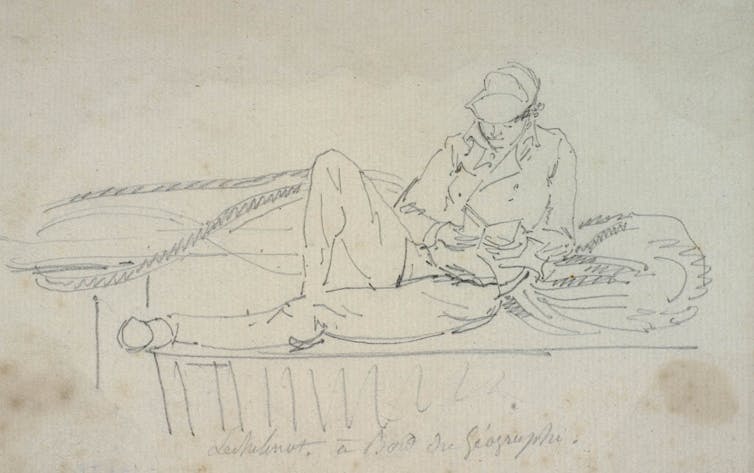
Content warning: this article describes outdated and potentially offensive terminology when referring to First Nations people.
In the storeroom of a square-towered château in Burgundy, my genial hosts gestured towards a large, wooden chest of drawers. I pulled open a compartment and began sorting through bundles of old papers – house records from the 18th and 19th centuries. I was there, in 2015, on the trail of Théodore Leschenault, a botanist who had travelled to Australia in the years 1800 to 1803 with the expedition of discovery led by Nicolas Baudin.
The château belonged to Leschenault’s descendants, who had invited me to explore the family archives. There was a register detailing his divorce from his young wife Marguerite due to their “incompatible temperaments”. There were shells and rocks bearing faded ink labels. And there was a printed invitation to a funeral service held for him at the Madeleine church in Paris in 1826 after he died of a stroke.
All this was valuable research material but I felt a slight sense of disappointment. The original manuscript journal of his voyage to Australia was not there.
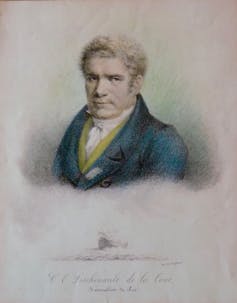
Prior to this I had been working on a translation of the only version of the journal thought to exist, an incomplete copy made for the navy by an unknown hand. But then, in late 2016, out of the blue, the original journal in Leschenault’s own handwriting was put up for auction in Royan on the west coast of France. Where the journal had been for the previous 200 years was not revealed.
After bidding closed at €110,000 ($A180,500), the French government stepped in, seizing the journal as its own property, on the grounds that it had funded the original expedition. The journal was deposited with the National Archives of France, which in 2020 provided me with scans to use as the basis for a new translation that appears in my book The French Collector.
This journal contains a store of fascinating new information. Two previously unknown chapters describe the first part of Leschenault’s journey from Paris to Le Havre and onward via the Canary Islands and Mauritius to the west Australian coast. They offer much else besides, including insights into his fears and ambitions, an array of scientific observations, and impassioned discussions of slavery and the treatment of Indigenous peoples.
A Collecting Frenzy
Leschenault was 26 when he set out from France with the Baudin expedition to explore the “unknown coasts” of New Holland. Sociable by nature, with a head of blond curls, he came from a wealthy legal family and had been imprisoned during the French Revolution. A child of the Enlightenment, with an anti-religious and empirical cast of mind, he hoped to forge a career as a botanist.
When Leschenault went ashore for the first time on the Australian coastline in June 1801, at Geographe Bay in the south-west, he immediately went into a collecting frenzy, picking up so many shells, pebbles and plants he couldn’t carry them all back to the boat.
Here he saw grass trees and tuart trees, black swans and a dingo, and had a much anticipated first encounter with some Wardandi Noongar men. Over the next two years, Leschenault collected thousands of plant and animal specimens as the expedition explored three sides of the continent.
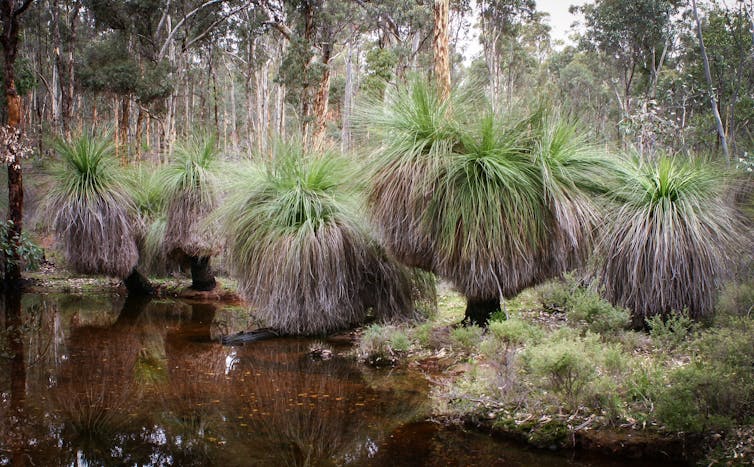
All the officers and scientists on the voyage were required to keep a record of their experiences. Some are terse maritime affairs – lists of bearings, wind directions and similar data. Leschenault’s is among the most eloquent and wide-ranging. These writings all supplement the official record of the expedition, the Voyage de découvertes aux terres australes, published by François Péron and Louis Freycinet between 1807 and 1816.

Leschenault’s original journal is a battered-looking object, a large notebook with torn cloth covers, muddy-brown in colour, with the words “private journal” written on the front. Inside, the paper is well preserved and his handwriting spills in neat, brown ink along hand-ruled lines.
The two previously unknown chapters contain an invaluable ragbag of materials about the voyage. Into these chapters he copied a whole sheaf of loose-leaf jottings he had done earlier: private letters, interviews with travellers, short essays on different phenomena (atmospheric humidity, sea temperatures and phosphorescence), philosophical reflections, descriptions of plants and animals, alongside a more conventional daily narrative.
The emotional register of these early chapters shifts according to his imagined audience. When he sees the sea for the first time at Le Havre, for example, he describes for friends and family his terror at the thought that he might drown beneath the waves. But his language becomes more austere when detailing natural phenomena for scientific readers.
Colonisation And Slavery
Some of the most unexpected passages in the new chapters relate to slavery and the effects of colonisation. In Australia, he quickly came to the conclusion that the local peoples, “far from a state of civilisation” and prone to treachery, disproved the idea of the “noble savage”. But the early chapters reveal that he arrived with sympathetic preconceptions.
While on Tenerife, one of the Canary Islands, he learnt about the fate of the island’s original Guanche inhabitants – which gave him reason for concern. Spanish invaders had come with firearms and confronted a peaceful community of farmers. “Oppression and despair drove this people to extinction,” he writes. “Now we are setting out to visit unknown peoples; perhaps the moment of their discovery will be the start of their misfortune”.
Leschenault contemplates the bleakest of fates for Indigenous Australians, before changing his mind: “But no, that can’t be true, today governments are more enlightened, they will be just […]”

Leschenault also takes an interest in a marginal figure among the scientific staff, the teenage assistant gardener and former slave who was referred to by the derisive nickname Merlot (“little blackbird”). He sympathetically recovers the youth’s original name, Bognam-Nonen-Derega (meaning “everlasting happiness”), copies down details about life in his home village (in what is perhaps now eastern Nigeria) and records the story of how he was kidnapped at the age of 12 and sold to English slavers. Later, on Mauritius, Leschenault directly addresses moral questions around slavery.
It is, he declares, “an outrage against nature” but he understands why, for economic reasons, it cannot be abolished immediately. His sympathies are prone to fluctuation though: when he interviews an albino Mauritian slave girl, his manner seems much less compassionate.
The recently recovered journal traces Leschenault’s travels over the course of two years but comes to an abrupt end in Sydney, at the half-way point of the expedition. What happened afterwards – did he start to write a second volume, now lost?
When he abandoned the expedition due to illness at Timor in June 1803, he gave all his papers to Baudin: drawings, botanical notebooks, possibly even a sequel to the journal. But the whole bundle of papers disappeared without a trace. Perhaps they linger in some storeroom, awaiting their moment to re-emerge into the light …![]()
Paul Gibbard, Senior Lecturer in French Studies, The University of Western Australia
This article is republished from The Conversation under a Creative Commons license. Read the original article.
Period shame stops countless girls from continuing sport. The Women’s World Cup can help break this stigma
Michelle O'Shea, Western Sydney University; Hazel Maxwell, Western Sydney University, and Kylie A Steel, Western Sydney UniversityIn the lead up to the first FIFA Women’s World Cup hosted in the Southern Hemisphere, host nations Australia and Aotearoa New Zealand are forging other firsts, including efforts to break the shame, stigma and taboo that continue to shroud periods.
In April, both teams unveiled new kits that included period leak protections, together with materials and tailoring that specifically respond to the needs of high performance women footballers.
New Zealand has also swapped out its traditional white shorts for teal blue to help combat period anxiety.
Similar changes are occurring across the global sporting landscape, albeit more slowly in some quarters.
Despite initial reluctance, last year the All England Club relaxed the long-held tradition that Wimbledon players wear all white, so women can now wear dark undershorts.
In rugby, the Irish national women’s team have permanently switched white shorts for navy, while New Zealand referees are no longer required to wear white shorts.
The impact of these changes should not be underestimated. The shame and taboo associated with periods stops many young girls from continuing sport, and misinformation about menstruation affects the performance and health of countless elite athletes. The 2023 FIFA Women’s World Cup is an opportunity to dispel period myths and put a focus on the specific needs of athletes who menstruate.
Women Athletes Aren’t Small Men
Women’s elite sport continues to be professionalised, yet their training protocols have often been based on research evidence derived from male cohorts.
This research doesn’t consider the physical and psychological changes that women athletes may experience at each phase of the menstrual cycle, nor how that may affect peak performance.
Research into how the menstrual cycle affects the performance of women athletes is growing. Teams are employing methods to work with the period cycle, rather than against it.
Reigning FIFA Women’s World Cup champions the United States say that menstrual tracking is one of their performance weapons.
No Longer A Mark Of Honour
Ignoring and generalising the needs of women athletes not only hurts performance, but can damage health.
Overly intense training can cause some athletes to stop having periods. This has often been considered normal by coaches and a mark of honour among athletes themselves. Indeed there’s a dangerous notion in many high performance sporting cultures that the absence of menstruation equates to an ideal elite athlete.
But this can lead to serious health consequences, including a condition called RED-S – relative energy deficiency in sport. Symptoms include periods stopping or becoming irregular, reduced performance, mood changes, and recurrent illnesses and injuries including stress fractures.
Australian research involving 112 women elite and pre-elite athletes found almost 80% of participants demonstrated at least one symptom consistent with RED-S. Nearly 40% experienced at least two symptoms.
Like women in other workplaces, elite athletes are often reluctant to discuss the impact of their periods fearing assumptions they are a liability in team environments, less capable, and not deserving of development opportunities.
Change Is Happening, Albeit Slowly
Across some high performance pathways, road maps are being developed to specifically support women athletes. For example, the Australian Institute of Sport launched an initiative in late 2019 to “improve female athlete specific knowledge and systems of support”. And in March, the South Australian government started its “I’m an athlete. Period” campaign which aims to promote positive menstrual health in sport.
Many women athletes themselves have started to speak up about the taboo associated with menstruation and are lobbying for change.
Earlier this year, decorated Australian Olympic swimmer Cate Campbell shared the performance struggles she has experienced managing her periods.
While her training and nutrition regimens were monitored with precision, the absence of information and access to a network of women’s health professionals saw her suffer a near career-ending injury.
To try and manage her periods, she had a contraceptive bar inserted into her arm, which is meant to be inserted into the fat layer above the muscle. But because she’s an elite athlete, she has a very low body fat percentage, so the bar was inserted next to her muscle. A botched attempt to retrieve the bar caused her permanent nerve damage.
She’s now using her profile to raise awareness of women’s health issues and to try and reduce the taboo around periods.
Girls’ Barriers To Sport
Puberty, and the start of periods, is a time when girls’ participation in grassroots sport falls off sharply.
A UK survey of more than 4,000 teenagers published last year found there are complex barriers and deep-rooted negative attitudes affecting girls’ enjoyment of sport, including period shame and body image issues.
It found, of girls in the survey who used to be sporty, 78% said they avoided sport when they had their period, and 73% of this cohort said they didn’t like others watching them take part in physical activity.
Of girls who avoided exercise on their periods, 73% said it was due to pain and 62% did so out of fear of leakage.
Various state governments are investing in grassroots sport facilities that better attend to the needs of women. But many facilities continue to lack basic amenities including menstrual bins.
An important way to address these issues is for sporting clubs to develop “period positive” cultures.
Clubs should undertake measures such as:
providing comfortable and period-friendly uniforms
supplying sanitary bins and ample period products for free
and having open discussions about periods and how they may impact athletes.
These can help girls and women be empowered to manage their periods in ways that will enable them to continue their participation and not feel ashamed or embarrassed.
With the world cup media spotlight, we have an unprecedented opportunity to break menstrual shame, silence and taboo.![]()
Michelle O'Shea, Senior Lecturer, School of Business, Western Sydney University; Hazel Maxwell, Senior Lecturer, Western Sydney University, and Kylie A Steel, Senior Lecturer in Motor Learning and Skill Acquisition, Western Sydney University
This article is republished from The Conversation under a Creative Commons license. Read the original article.
Asteroid City: Wes Anderson’s cosmic tale is his most engaging in years
Tom Hemingway, University of WarwickWes Anderson’s new film Asteroid City (2023) is a sci-fi dramedy following a grieving family stranded in a rural US town during a star-gazing event in the summer of 1955.
However, it’s also a text by fictional playwright, Conrad Earp (Edward Norton), the writing and dramatisation of which forms the basis of this film’s framing story. And those hyper-saturated, expansive vistas you’re likely to be familiar with from the film’s promotional materials are from the in-world, televised dramatisation of this play.
You’re right, it’s confusing.
This is a story within a story within a story where art mimics art. Anderson is obsessed with these types of framing devices. His last feature, The French Dispatch (2021) has an anthology structure, with each story representing an article in an issue of the film’s fictional Liberty, Kansas Evening Sun newspaper.
I’ve also written about how The Life Aquatic with Steve Zissou (2004) often visually resembles the faux documentaries made by the faux oceanographic collective, Team Zissou, as if you’re watching something which could have been created within the plot of the film itself.
Even as far back as The Royal Tenenbaums (2001), Anderson depicted his film as a realisation of a fictional book, splitting it into chapters and including a prologue and epilogue. The effect of these framing devices has increasingly created a sense of distance, as if the director is making a concerted effort to hold the viewer at arm’s length. It often means the viewer can appreciate, but never feel wholly invested in, the events onscreen.
Despite taking a similar approach to framing its story, Asteroid City is by far the most engaging Anderson film in a decade. It’s sumptuous to look at, with a raw emotion consistently threatening to leak out from behind its perfectly composed frontispiece.
The control of these emotions, oscillating between the now-expected deadpan posturing and fleeting moments of cathartic release, has always been an ace up Anderson’s sleeve. It can be found in The Darjeeling Limited (2007) scene where the Whitman brothers let go of their luggage to catch a moving train at the film’s climax. It’s there when Steve Zissou is reduced to tears asking “I wonder if it remembers me?” as he comes face-to-face with the shark that murdered his friend in The Life Aquatic.
And it is present in Asteroid City in a handful of sequences towards the film’s end, which I won’t spoil, but that are the beating heart of a picture that otherwise contains all the typical quirks and occasionally suffocating authorial flourishes one might expect from an Anderson project.
Star Turns
The film moves from a small 1.37 black-and-white aspect ratio to widescreen colour as it follows the different stories. In these widescreen shots, Asteroid City returns to the pastel colours that could be considered one of the hallmarks of Anderson’s work. The sparse, barren setting of the film is rendered vibrant by Anderson’s regular cinematographer, Robert Yeoman.
The small desert town resembles a live-action incarnation of a Looney Tunes cartoon. Anderson directly acknowledges the cartoon’s influence by including a roadrunner bird dancing along to the film’s soundtrack in one sequence.
As always, the film boasts a gargantuan cast, which is impressive even by Anderson’s standards. There are some first-timers (Margot Robbie, Tom Hanks) appearing alongside familiar faces (Willem Dafoe, Tilda Swinton and Jeff Goldblum).
It is a particular pleasure to see Jason Schwartzman in a leading role a quarter-century after his breakout performance in Anderson’s Rushmore (1998). Schwartzman plays Augie Steenbeck, a war photographer and the unwilling patriarch of the film’s central family.
But it is Scarlett Johansson who steals the show as Midge Campbell, a famous actress also stranded in Asteroid City after a mysterious incident places the town’s inhabitants under a strict and indefinite quarantine. Johansson expertly toes the line between playing up the blank delivery that is often required of lines in Anderson screenplays and the lively curiosity of someone who might exist in our reality – someone interested in a life beyond her immediate surroundings.
As events take a cosmic turn, the wheels occasionally threaten to come off. However, the film is buoyed by some wonderfully understated comic performances from Steve Carell and Liev Schreiber, as well as 50s-inspired original music by British musicians Jarvis Cocker (also starring) and Richard Hawley.
Asteroid City contemplates grief, the unknown and the way these things can be rendered meaningful through art – in photography, a play and, in a self-reflexive turn, even this film. In the moment, it’s a surprisingly breezy affair packed with ideas that linger in the hours and days after first watching.![]()
Tom Hemingway, Teaching Fellow in Film and Television Studies, University of Warwick
This article is republished from The Conversation under a Creative Commons license. Read the original article.
The fascinating Cameroonian art of spider divination is on display at London exhibition
David Zeitlyn, University of OxfordTomás Saraceno In Collaboration: Web(s) of Life, which opened at London’s Serpentine South Gallery in June, explores how humans relate to spiders. It features installations of spider webs displayed and lit to be viewed as sculptures. There are also films: one made about Saraceno’s work with groups battling lithium mining in Argentina and another about spider diviners from Somié village in Cameroon.
That’s where I came in. Ŋgam dù (the Mambila term for spider divination) is one of many types of oracle or divination used by Mambila people in Cameroon. It is the most trusted form and – unlike other types which are sometimes dismissed as mere games – its results can be used as evidence in the country’s courts. Variants of this form of divination are found throughout southern Cameroon and the long history of the word ŋgam attests to the longevity of the practice.
I work as a social anthropologist in the Mambila village of Somié. I have visited almost every year since 1985, working on a variety of projects. Divination was the focus of a chapter in my PhD in 1990, but I never stopped working on the subject. As well as becoming an initiated diviner, I have continued to think about the wider implications of using divination or oracles.
Ngam dù is a form of divination in which binary (either/or) questions are asked of large spiders that live in holes in the ground. The options are linked to a stick and a stone then, using a set of leaf cards marked with symbols, the spider is left to make its choice.
The hole plus the stick, stone and cards are covered up. The spider emerges and will move the cards so the diviner can then interpret the pattern relative to the stick and stone. If cards are placed on the stick, then the option associated with that has been selected, and vice versa if the cards are placed on the stone.
Things get more interesting (at least to me and other diviners) if both options are selected, or neither. Sometimes a contradictory response is interpreted to mean that the question posed is not a good one. The diviner is thereby told to go and discuss the issue with the client and reframe the problem, posing a different question.
The process is “calibrated” regularly by asking test questions such as “Am I here alone?” or “Will I drink tonight?”. Spiders that fail these tests are discarded as liars and not used for future consultations. It’s also common to ask the same question in parallel to get a consistency check, so more than one spider can be used at the same time. Sometimes the stick and stone option are reversed to ensure that the spider isn’t just moving the cards always in the same direction.
Mambila diviners rely on these tests to justify the system, although they also say (as do many groups in Cameroon) that spiders are a source of wisdom since they live in the ground where the “village of the dead” is found.
Tomás Saraceno And Spider Divination
As an anthropologist, I avoid questions about whether spider divination is true. For me the important question is: “Does it help?”
Sometimes the results of divination are considered, but rejected, and the advice is not followed. Even in these instances it can be helpful, however, since it enables people decide on a course of action.
People use the results as a tool to help them think through hard decisions such as who to marry, or where to go for treatment when a child is ill. The latter involves weighing up conflicting considerations about expense, the possibility an illness has been caused by witchcraft and the reputations for effective treatment of different traditional healers as well as of rival biomedical health centres.
I met the Argentine artist Tomás Saraceno when he had an exhibit at the Venice Bienale in 2018. He was intrigued by the computer simulation of spider divination that my colleague Mike Fischer had made. He invited me to Venice to demonstrate the simulation and talk about spider divination in front of his “sculptures”, which are made in collaboration with spiders. They are patterns of spiderwebs displayed as art.
As we talked, I said that if one day he wanted to visit Cameroon I would be happy to introduce him to the diviners I worked with. In December 2019, he came with his friend, the filmmaker Maxi Laina. We visited Somié, where he worked with the diviner Bollo Pierre Tadios and the Mambila filmmaker Nguea Iréné.
Saraceno and Laina came with some questions to ask from their friends. This included “Who would win the 2020 US election?” This was the Trump v Biden election, the results of which Trump went on to question. The answer was that there would be a new president but it would not be straightforward!
Saraceno liked the idea that spiders could help humans resolve their personal problems. It gave an example of a different way in which human-spider relationships are expressed. Bollo liked the idea of opening the process up to questions from outside the village. He already has some clients from other places in Cameroon who call him, so working internationally is very doable.
He suggested that Saraceno could make his work accessible via the internet, which he has now done through a dedicated website. Some of the first results are included in the Serpentine exhibition along with film made by Nguea Iréné of Bollo in action. The film will also be shown in the village later in the summer.
Tomás Saraceno In Collaboration: Web(s) of Life is on at London’s Serpentine South Gallery until 10 September.![]()
David Zeitlyn, Professor of Social Anthropology, University of Oxford
This article is republished from The Conversation under a Creative Commons license. Read the original article.
Henry VIII’s notes in prayer book written by his sixth wife reveal musings on faith, sin and his deteriorating health – new discovery
Alec Ryrie, Durham UniversityIt’s common knowledge that Henry VIII had six wives. But the cataclysmic love triangle between Catherine of Aragon and Anne Boleyn gets all the airtime, while wives three to six are an afterthought.
In director Alexander Korda’s rollicking film The Private Life of Henry VIII (1933), Katherine Parr (wife six) was reduced to a throwaway joke in the film’s last moments. Brazilian director Karim Aïnouz’s upcoming film Firebrand is the first to bring Parr to centre stage – and not before time.
Right on cue, new evidence has come to light giving an intriguing glimpse into Parr’s relationship with her capricious husband. Namely, the discovery of Henry’s notes in a book authored by his wife.
The Bookish Queen
Katherine Parr was unlike her five predecessors. Aged 30 and already twice widowed in 1543, the king made her an offer she couldn’t refuse, forcing her to break off another planned marriage. The increasingly disabled Henry had finally stopped pursuing nubile broodmares and sought out a companion instead.
Parr deftly navigated the tangled politics of the royal family, brokering a reconciliation between the king and the two daughters, Mary and Elizabeth, he had declared to be bastards. She may even have helped in restoring them to the line of succession.

Henry certainly came to trust her judgment. When he set off for his final, futile war in France in 1544, he made her regent in his absence. Part of the appeal, it seems, was her bookish piety. Parr was the first English queen to publish a book and the first English woman to publish under her own name.
Her three books were pious exercises, beginning with a safe collection of translated texts titled Psalmes or Prayers (1544) and becoming more daring thereafter. The Lamentation of a Sinner (1547) was written during Henry’s lifetime, but its theology was too assertively Protestant to be published until he was safely dead.
The earlier books, though, seem to have delighted the king. He inscribed the queen’s own copy of Psalmes or Prayers: “Remember this writer / when you do pray / For he is yours”. He had always been theatrically pious and in his last years – brooding, in pain, nurturing his many humiliations – he turned to religion with melancholy intensity.

We know what Henry thought religion should mean to his subjects: a tough, moralistic faith without much room for forgiveness, whose keynote was obedience to himself. But what about his personal faith?
Enter a new discovery by Canadian literary scholar Micheline White.
Queen Katherine ordered a few luxury copies of Psalmes or Prayers printed on vellum, with delicate hand colouring. One of these, now in Buckinghamshire’s Wormsley Library is festooned with marginal markings and “manicules” – little doodled hands with fingers pointing to a passage some reader wanted to emphasise.
White has established, by meticulously comparing these distinctive manicules with others whose provenance we know, that this attentive reader was none other than Henry VIII.
What Henry VIII’s Notes Reveal
It’s no surprise Henry should have taken comfort in the Biblical psalms. They were supposedly the work of a pious but lecherous king, David, with whom he strongly identified.
The passages Henry marked are a telling glimpse of the extent – and the limits – of his self awareness. His illness and other troubles are much on his mind: he marks prayers to “take away thy plagues … turn away thine anger”.
He is also drawn to prayers lamenting sin and asking God for wisdom. “Give me a new heart, and a right spirit, and take from me all wicked and sinful desires.”
The sentiments indicate a man who was serious both about his kingly responsibilities and personal spiritual predicament. Unlike many other murderous narcissists, Henry VIII did know he was a sinner who needed forgiveness. But his confidence “that my sins may be purged” suggests tension between the eagerness with which he sought grace and his refusal to countenance mercy – royal or divine – for his subjects.
Queen Katherine, as the popular rhyme tells us, “survived” her marriage, but it was a close run thing.
In 1546, the last summer of Henry VIII’s life, she was suspected – on good grounds – of nurturing a nest of religious radicals at court. Henry allowed himself to be persuaded that all her pious talk was actually an attempt to lure him into heresy.
According to a late but well-informed account by the martyrologist John Foxe, she got wind of the danger and immediately threw herself on his mercy. Katherine protested that she, a “poor woman so much inferior in all respects of nature unto you”, had simply been seeking his religious guidance.
“Not so, by Saint Mary,” Henry replied. “You are become a Doctor, Kate, to instruct us (as we take it) and not to be instructed, or directed by us.”
No, she protested: she had only sought to distract him with talk during “this painful time of your infirmity” and had in the process learned a great deal from his wisdom. With someone else, that might have been laying it on too thick, but she knew her man.
“And is it even so, sweetheart?” Henry replied. “Then perfect friends we are now again.” The arrest warrant was cancelled.
Months later, the king was dead. Unfortunately, Queen Katherine married the man she’d kept waiting with almost indecent haste – only to be cold shouldered when she fell pregnant and left to die in childbirth. History is thin on happy endings.![]()
Alec Ryrie, Professor of the History of Christianity, Durham University
This article is republished from The Conversation under a Creative Commons license. Read the original article.
What is the ‘nine-dash line’ and what does it have to do with the Barbie movie?
Donald Rothwell, Australian National UniversityThe new Barbie film starring Margot Robbie and Ryan Gosling is set for imminent release. But according to Vietnam’s state-run Tuoi Tre newspaper the film’s release has been barred. The head of the Department of Cinema, a government body in charge of licensing and censoring foreign films, said
We do not grant license for the American movie ‘Barbie’ to release in Vietnam because it contains the offending image of the nine-dash line
Vietnam’s response to the Barbie movie’s depiction of the South China Sea shows how sensitive these matters are in South East Asia, and especially in Vietnam.
What Is The Nine-Dash Line?
The South China Sea has a long history of being contested.
China and Vietnam engaged in military clashes over the Paracel and Spratly Islands in the South China Sea in 1974 and 1988.
Those disputes were over land, but more recently the focus has turned to claims over the continental shelf (the area of seabed that extends beyond the coast to at least 200 nautical miles), and the economic zones (the area at least 200 nautical miles from the coast).
Since the late 1940s, China has promoted the so-called nine-dash line in the South China Sea. The line, also known as the “U-shaped line” or “cow’s tongue” comprises nine dashes.
As depicted in various official and unofficial Chinese maps, the line extends off the coast of China’s Hainan Island, and runs close to the coast of Vietnam, deep into the South China Sea, enclosing the Spratly Islands.
North of Borneo, near the coasts of Malaysia and Brunei, the line turns and runs to the west of the Philippines and ends just to the south of Taiwan.
The line has long been the subject of speculation as to what exactly it purports to encompass. Is it a Chinese territorial claim? Is it a Chinese claim to a maritime space? Does it extend to sovereignty over the whole area or just to resources?
China has never been very explicit as to precisely what the claim includes but it has been persistent in seeking to advance the claim.
This has especially been the case since Malaysia, the Philippines, and Vietnam have begun to advance their own claims to parts of the South China Sea, which overlap the nine-dash line.
Who Disputes The Line?
A 2009 joint Malaysia/Vietnam submission to the United Nations Commission on the Limits of the Continental Shelf highlighted competing claims over the continental shelf in the South China Sea, which is what sparked the current controversy.
China made a formal diplomatic response to the UN claiming:
China has indisputable sovereignty over the islands in the South China Sea and the adjacent waters, and enjoys indisputable sovereign rights and jurisdiction over the relevant waters as well as the seabed and subsoil thereof (see attached map).
China attached a copy of the nine-dash line map to its formal diplomatic protest to the Malaysia/Vietnam submission and added
The above position is consistently held by the Chinese Government, and is widely known by the international community.
It turned out, however, that this was not a widely known or shared view by the international community. Since then the commission has become something of a de facto legal battleground for various views regarding the status of the nine-dash line.
In addition to China continuously advancing its position regarding the legitimacy of the nine-dash line, countries including Australia, France, Indonesia, Malaysia, New Zealand, the Philippines, United Kingdom, and Vietnam have rebutted China’s assertions.
But the commission is not a court and is comprised of scientists who assess continental shelf claims.
It was up to the Philippines, as the other nation with possible claims on the region, to separately challenge the legality of China’s nine-dash line claim under the law of the sea. In 2016, a United Nations Law of the Sea Convention Tribunal ruled unanimously that China’s claim had no basis in international law.
That ruling was clear-cut and conclusive, and immediately rejected by China. While the Philippines conclusively won the legal argument that the nine-dash line had no basis in modern international law or the law of the sea, China refused to respect the outcome of that case and continues to assert its South China Sea entitlements.
China does this in multiple ways. It has built artificial islands in the South China Sea, harassed foreign naval and military aircraft passing through the region, intimidated Vietnamese and other foreign fishermen, asserted rights to explore and exploit maritime oil and gas reserves, and continued to publish maps depicting the nine-dash line claim.
This is why any legitimacy given to the nine-dash line, even in Hollywood movies, is so sensitive.
Why Are Maps So Controversial?
Maps are reflective of a critical national attribute: territory.
They define the outer limits of territorial claims. Children are familiarised with their home country by maps. Maps have historically been depicted on postage stamps, buildings, and more recently government websites.
Maps now depict a country digitally and this has become contested, as highlighted by the Russian invasion of Ukraine.
University students challenge their professors when maps are shown that depict disputed lands.
Maps have meaning and touch national sensitivities.
Vietnam’s response to Hollywood’s depiction of China’s nine-dash line is understandable. It demonstrates a fierce resistance to any legitimacy that China’s ongoing South China Sea nine-dash line claims may generate, even in Barbie’s fictional world.![]()
Donald Rothwell, Professor of International Law, Australian National University
This article is republished from The Conversation under a Creative Commons license. Read the original article.
Why is the Barbie DreamHouse so creepy? An expert in the uncanny explains
Joana Jacob Ramalho, UCLA mass of hot pink emerges violently amid the green foliage, palm trees and shrubbery. Located in Malibu, the oceanfront Barbie DreamHouse created by Airbnb is the latest in a series of global marketing stunts to promote Greta Gerwig’s new film Barbie, the first live-action adventure movie about the iconic Mattel doll.
A closer aerial shot of the video – uploaded to Twitter by photojournalist John Schreiber – reveals a curved slide, with a small square pool at the bottom. On the pink and white wall behind the water slide, the Barbie logo has been graffitied over with Ken’s name.
The image then cuts to an infinity pool where a set of three giant custom pool floats spells “KEN”. The bird’s-eye view allows us to spy the deep shadows that each letter, swaying gently in the breeze, casts onto the bottom of the pool.

This article is part of Quarter Life, a series about issues affecting those of us in our twenties and thirties. From the challenges of beginning a career and taking care of our mental health, to the excitement of starting a family, adopting a pet or just making friends as an adult. The articles in this series explore the questions and bring answers as we navigate this turbulent period of life.
You may be interested in:
Worried about AI? You might have AI-nxiety – here’s how to cope
Four ways to have hard conversations with your friends – without making things worse
Aerial footage shows the pink palace in stark contrast to the neighbouring white mansions. The video ends with two crash zooms, a cinematic technique typical in horror films. The camera zooms in rapidly before quickly zooming out and resuming its god-like surveillance of a house seemingly devoid of human life.
Has Ken Killed Barbie?
Airbnb’s life-size DreamHouse, as captured in the video, has a very different feel to trailers for the upcoming Barbie movie. Its unsettling aesthetic is a sharp counterpoint to the thoughtfully curated architectural wonderland that production designer Sarah Greenwood and set decorator Katie Spencer painstakingly created for the film.
My immediate reaction upon watching the footage was: “What has he done with the body? Where has Ken buried Barbie?”
The ominous K, E, N, letters floating aimlessly in the deserted pool – Barbie’s silencing through the desecration of her signature, a key marker of her identity – and the terrace furniture enveloped in pallet wrap do not bode well for Barbie.
Airbnb’s official press release confirms that Ken has taken over Barbie’s house, going as far as letting guests check in for free while she is “away”. The reader is not privy to Barbie’s opinion or consent on this matter.
Airbnb classifies Ken’s starring role in this endeavour as a “twist”, because “Barbie is everything, and he’s always been ‘Just Ken’ – until now!” A fitting tagline for a revenge horror film.
The grim wording of the press release appears unintentional. Indeed, Airbnb is making a charity donation along with the opening of the DreamHouse “to honour girls’ empowerment”. Why, then, do some of us react to that pink haven with a frisson of anxiety?
Uncanny Matters
Airbnb’s topsy-turvy iteration of the DreamHouse evokes uncanny emotions. The uncanny – a state of fear and unease – has been defined in a variety of different, albeit overlapping, ways.
German psychiatrist Ernst Jentsch (1867-1919), thought the feeling arises from the seeming animation of the inanimate or, conversely, the apparent lifelessness of a living being.
Psychologist Sigmund Freud (1856-1939) saw the uncanny in the resurgence of repressed childhood fantasies and primitive beliefs – such as animism, the attribution of a living soul to inanimate things – which challenge adult worldviews.
Japanese roboticist Masahiro Mori coined “uncanny valley” in 1970 to denote the point at which human-like automata (such as robots but also CGI characters) become too lifelike. Uncanny feelings are triggered by their failure to act in a recognisably human manner, despite their appearance.
Through its myriad revisions over the years, the concept’s core idea has remained unchanged: the defamiliarisation of the familiar generates ambiguity and temporary disorientation, eliciting a sense of creepiness, dread or horror.
In this sense, Barbie’s Malibu beach house (in both Airbnb’s and Gerwig’s versions) evokes the uncanny. However, the film relishes its artificiality and uses the uncanny playfully. “Her environment isn’t always three-dimensional, and the scale of everything is a bit off. Barbie is a little too big for her house,” Gerwig told Vogue.
Set decorator Katie Spencer told Architectural Digest that she and production designer Sarah Greenwood “adjusted [the] rooms’ quirky proportions to 23% smaller than human size”. It reminded me of American writer Shirley Jackson’s Hill House, which she described as “chillingly wrong in all dimensions”.
The candy-coloured mansion is an extension of Barbie and vice-versa, central to her identity. Odd proportions, decals paired with three-dimensional objects and the vivification of dolls paint a portrait, both seductive and unsettling, of Barbie Land. Despite its surrealism, Barbie Land is coated in a fairytale veneer that prevents it from becoming terrifying.
On the other hand, Airbnb’s garish dwelling annexes more troublesome elements of the uncanny. It blurs the lines between doll and human along with the boundaries between the real world of California and the fictional realm of the magical dollhouse.
Barbie’s bright pink plastic fantasy is a disquieting inversion of the gothic Addams Family mansion, rising darkly above the white suburban picket fences. The real-life DreamHouse discloses our borderline vampiric appetite for consuming a piece of someone else’s life – even a doll’s. As children’s literature scholar Anna Panszczyk has observed, “we can never fully occupy the space of our dolls” – but that hasn’t stopped us from trying.![]()
Joana Jacob Ramalho, Lecturer (Teaching), Faculty of Arts & Humanities, UCL
This article is republished from The Conversation under a Creative Commons license. Read the original article.
2001: A Space Odyssey still leaves an indelible mark on our culture 55 years on
Nathan Abrams, Bangor University2001: A Space Odyssey is a landmark film in the history of cinema. It is a work of extraordinary imagination that has transcended film history to become something of a cultural marker. And since 1968, it has penetrated the psyche of not only other filmmakers but society in general.
It is not an exaggeration to say that 2001 single-handedly reinvented the science fiction genre. The visuals, music and themes of 2001 left an inedible mark on subsequent science fiction that is still evident today.
When Stanley Kubrick began work on 2001 in the mid-1960s, he was told by studio executive Lew Wasserman: “Kid, you don’t spend over a million dollars on science fiction movies. You just don’t do that.”
By that point, the golden age of science fiction film had run its course. During its heyday, there was a considerable variety of content within the overarching genre. There had been serious attempts to foretell space travel. Destination Moon, directed by Irving Pichel and produced by George Pal in 1950, and, in mid-century, Byron Haskin’s Conquest of Space both fantasised space travel and, in Haskin’s film, a space station, which Kubrick would elaborate on in 2001.
Most 1950s science fiction films, though, were cheap B-movie fare and looked it. They involved alien invasions with an ideological and allegorical subtext. They were cultural, cinematic imaginations of the danger of communism, which in the overheated political atmosphere of the time was seen as an imminent threat to the American way of life.
The aliens in most science fiction films were out simply to destroy or take over humanity; they were expressions, to use the title of a Susan Sontag essay, of “the imagination of disaster”. There were some exceptions, including Byron Haskin’s film version of The War of the Worlds and Robert Wise’s The Day the Earth Stood Still.
By 1968, then, as the lights went down, very few people knew what was about to transpire and they certainly were not prepared for what did. The film opened in near darkness as the strains of Thus Spake Zarathustra by Richard Strauss were heard. The cinema was dazzled into light, as if Kubrick had remade Genesis.
The subsequent 160 or so minutes (the length of his original cut before he edited 19 minutes out of it) took the viewer on what was marketed as “the ultimate trip”. Kubrick had excised almost every element of explanation leaving an elusive, ambiguous and thoroughly unclear film. His decisions contributed to long silent scenes, offered without elucidation. It contributed to the film’s almost immediate critical failure but its ultimate success. It was practically a silent movie.
2001 was an experiment in film form and content. It exploded the conventional narrative form, restructuring the conventions of the three-act drama. The narrative was linear, but radically, spanning aeons and ending in a timeless realm, all without a conventional movie score. Kubrick used 19th-century and modernist music, such as Strauss, György Ligeti and Aram Khachaturian.
Vietnam
The movie was made during a tumultuous period of American history, which it seemingly ignored. The war in Vietnam was already a highly divisive issue and was spiralling into a crisis. The Tet offensive, which began on January 31 1968, had claimed tens of thousands of lives. As US involvement in Vietnam escalated, domestic unrest and violence at home intensified.
Increasingly, young Americans expected their artists to address the chaos that roared around them. But in exploring the origins of humanity’s propensity for violence and its future destiny, 2001 dealt with the big questions and ones that were burning at the time of its release. They fuelled what Variety magazine called the “coffee cup debate” over “what the film means”, which is still ongoing today.
The design of the film has touched many other films. Silent Running by Douglas Trumbull (who worked on 2001’s special effects) owes the most obvious debt but Star Wars would be also unthinkable without it. Popular culture is full of imagery from the film. The music Kubrick used in the film, especially Strauss’s The Blue Danube, is now considered “space music”.
Images from the movie have appeared in iPhone adverts, in The Simpsons and even the trailer for the new Barbie movie.
The warnings of the danger of technology embodied in the film’s murderous supercomputer HAL-9000 can be felt in the “tech noir” films of the late 1970s and 1980s, such as Westworld, Alien, Blade Runner and Terminator.
HAL’s single red eye can be seen in the children’s series, Q Pootle 5, and Pixar’s animated feature, Wall-E. HAL has become shorthand for the untrammelled march of artificial intelligence (AI).
In the age of ChatGPT and other AI, the metaphor of Kubrick’s computer is frequently evoked. But why when there have been so many other images such as Frankenstein, Prometheus, terminators and other murderous cyborgs? Because there is something so uncanny and human about HAL who was deliberately designed to be more empathic and human than the people in the film.
In making 2001, Stanley Kubrick created a cultural phenomenon that continues to speak to us eloquently today.![]()
Nathan Abrams, Professor of Film Studies, Bangor University
This article is republished from The Conversation under a Creative Commons license. Read the original article.
Book Of The Month - July 2023: Our Mutual Friend By Charles Dickens
Our Mutual Friend, written in 1864–1865, is the last novel completed by Charles Dickens and is one of his most sophisticated works, combining savage satire with social analysis. It centres on, in the words of critic J. Hillis Miller, quoting the book's character Bella Wilfer, "money, money, money, and what money can make of life".
Most reviewers in the 1860s continued to praise Dickens's skill as a writer in general, but did not review this novel in detail. Some found the plot both too complex and not well laid out. The Times of London found the first few chapters did not draw the reader into the characters. In the 20th century, however, reviewers began to find much to approve in the later novels of Dickens, including Our Mutual Friend. In the late 20th and early 21st centuries, some reviewers suggested that Dickens was, in fact, experimenting with structure, and that the characters considered somewhat flat and not recognized by the contemporary reviewers were meant rather to be true representations of the Victorian working class and the key to understanding the structure of the society depicted by Dickens in the novel.
Students Move To The Groove For Olympic Day
June 29, 2023
Narrabeen Sports High School celebrated Olympic Day as a warm-up to becoming an Olympic Pathway School. Media Officer with the NSW Dept. of Education Sophie Lambert reports:
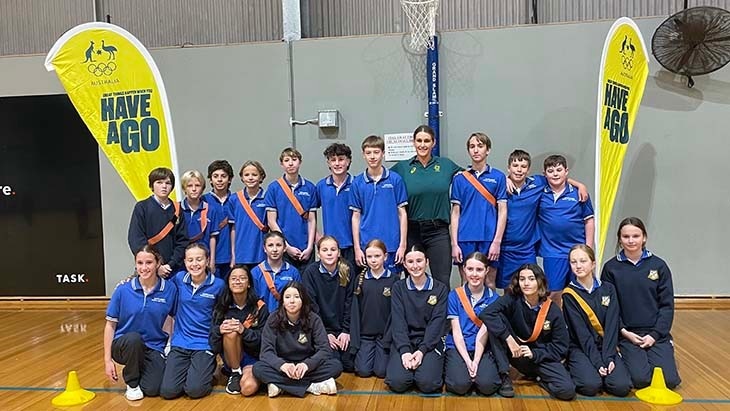
Olympian Holly Young with Year 7 students at Narrabeen Sports High School.
Olympic Day, a celebration of sport, health and community, commemorates the day the International Olympic Committee was founded on June 23, 1894.
Students from Narrabeen Sports High School, on Kuring-gai land, marked the day last week by embracing the Olympic Day theme of ‘Let’s Move’.
Principal Heidi Currie said she was proud to encourage students to celebrate Olympic Day as the school will next term become an official Olympic Pathway School.
“Olympic Day is a chance to celebrate the Olympic spirit by moving, learning and discovering new activities in the community and at school,” Ms Currie said.
“Our Year 7 students were lucky enough to attend a motivational presentation from Australian Olympian and bronze water polo medallist Holly Young.”
Students also played handball as part of the #HaveaGo Olympic initiative.
Narrabeen Sports High School will become an Australian Olympic Pathway School in Term 3, a privilege offered to schools with established elite athlete development programs including Olympic sports.
Schools in the program are provided with access to high quality sports training and sports academies, accredited coaches and specialist support services.
Narrabeen Sports High School will join Hills Sports High School, Endeavour Sports High School, Westfields Sports High School, Matraville Sports High School, Illawarra Sports High School and Hunter Sports High School as Olympic Pathway Schools.

Narrabeen Sports High is an Olympic Pathway school.
NEST Collaboration - Executive Director School Performance Recognition Program
June 29, 2023
The NEST Collaboration received an award as part of the Executive Director School Performance Recognition Program. This is an incredible demonstration of the innovative and collaborative practice that is taking place in NSW Department of Education schools.
The NEST Collaboration is creating a K-12 Learning Pathway for Elanora Heights PS, Narrabeen Lakes PS, Narrabeen North PS and Narrabeen Sports High School. The NEST is emblematic of quality collaboration. It has been developed with purpose and hinges around ensuring equity and excellence K-12.
Opportunities for students and teachers to collaborate and enrich learning is at the very heart of what NEST does.
On June 8th the 2nd Annual NEST Combined Band, featuring students from our four schools and staff working together, produced a wonderful evening of music.
Launched in April 2022 the Narrabeen Elanora Student and Teacher Collaboration (The NEST Collab) is a dynamic, focused community of four NSW Education schools working together to grow student learning outcomes, teacher collective efficacy and pedagogy, and community engagement.
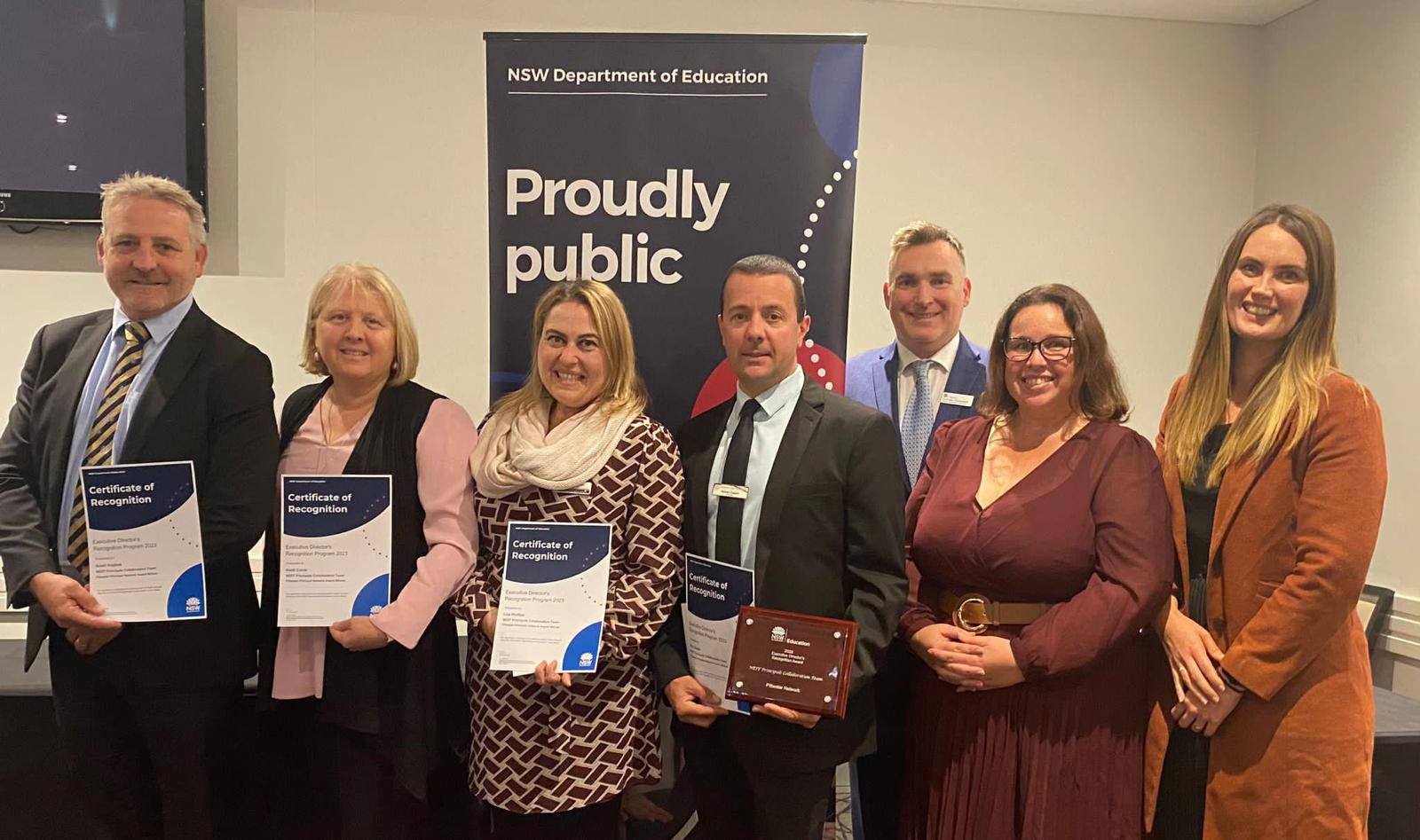
Pictured are Adam Hughes, Principal at Narraben North PS, Heidi Currie, Principal Narrabeen Sports High School, Lisa Phillips, Principal at Elanora Heights PS, Robert Zappia, Principal Narrabeen Lakes Public School, along with Andrew Stevenson (at back), Director Educational Leadership (DEL) Pittwater Network since 2018; Supporting continuous school improvement K-12 across all NSW DoE Schools.
Parli-Flicks Short Film Award 2023
Lights, camera, action!
NSW high school students, it’s time to shoot your shot for the 2023 Parli-Flicks Short Film Award.
The brief? Create a one-minute short film that takes a stand on whether the voting age should be lowered or kept at 18 in NSW.
Animation, music, comedy, drama, what’s your angle? This is your chance to be creative!
The winner will take home a $250 cash prize, with the finalists invited to an exclusive awards night at the Parliament of NSW.
Entries are open to Year 7 – 12 NSW high school students and close Friday August 11th 2023.
Want your school to participate? Visit our Education website for entry details and more information to share with your school administration.

Your First Speech To The Australian Parliament
Your first speech is a great way to speak about issues you are passionate about. You could enter as an individual or get your whole school involved!
Australian students enrolled in years 10 to 12 are invited to enter the 'My First Speech' competition.
You can enter as a school or as an individual.
Imagine yourself as a newly elected Member of the House of Representatives. Your task is to write a 90 second speech about issues you are passionate about then record yourself presenting the speech on video.
The video should be in MPG, MPEG, M4V, MPEG 4, AVI, WMV or MOV format with a resolution of 640 x 480 pixels or above and no longer than 90 seconds in length. Opening titles or end credits are not required.
A winner from each year, 10, 11 and 12, will be invited to Canberra to deliver their speeches live and undertake a program of meetings at Parliament House.
To enter the competition, submit your video via email, along with a written transcript of your speech and completed competition forms. The scanned forms can be pdf or jpg format.
If your video is too large to be emailed (over 30mb) send it via Dropbox, Google Drive or even a USB along with a transcript of your speech and completed competition forms.
For mailed entries send to:
My First Speech competition
House of Representatives
PO Box 6021
Parliament House
Canberra ACT 2601
Entries must be received by Friday, 11 August 2023
Competition forms and more here: https://www.aph.gov.au/myfirstspeech/enter
Applications Open For 150 Apprentice Scholarships
 Apprentices facing financial or personal hardship will be supported to undertake their trade and study through a $2.25 million NSW Government scholarship program.
Apprentices facing financial or personal hardship will be supported to undertake their trade and study through a $2.25 million NSW Government scholarship program.
Applications are now open until 21 July for the 2023 Bert Evans Apprentice Scholarships program that will support 150 people with $15,000 each to complete their training and further their career.
The scholarships support apprentices who are experiencing financial or personal hardship, demonstrate a high aptitude for vocational education and training, and are committed to their on- and off-the-job training in metropolitan and regional NSW.
The scholarship program is named in honour of the late Bert Evans AO, a passionate advocate of vocational education for more than 30 years. A total of 751 Bert Evans Apprentice Scholarships have been awarded since 2014.
These scholarships greatly assist first year apprentices to undertake their trade and study to achieve their career goals.
The NSW Government-run program offers grants of $5000 annually over 3 years to help people overcome personal barriers to finish their apprenticeships and go onto rewarding careers.
The scholarships are awarded to apprentices in NSW who have demonstrated:
- financial hardship and/or personal hardship
- capability for vocational education and training, and
- a positive attitude and application in the workplace and in off-the-job training.
Minister for Skills, TAFE and Tertiary Education Tim Crakanthorp said, “With demand for vocational education high, this year we have increased the number of Bert Evans scholarships on offer to help more apprentices through their training.
“Whether you need to purchase new tools, cover fuel or car maintenance costs, or pay for additional training courses, these scholarships have helped people overcome personal barriers to finish their apprenticeships and go onto rewarding careers.
“Apprenticeships are vital in ensuring NSW has a pipeline of skilled workers, and we want to give our apprentices a helping hand to complete their training, so they can make a strong contribution in their jobs and in the lives of their families and communities.”
Visit Bert Evans Apprentice Scholarships or phone 13 28 11 for more information and to apply.
NSW Government Takes A New Approach To Temporary Accommodation To Support People In Crisis
July 12, 2023
Women and children escaping domestic and family violence, disaster victim-survivors, rough sleepers and couch surfers are just some of the vulnerable people across the state who will now be able to access temporary accommodation for a longer period with the NSW Government expanding support for those seeking assistance.
Temporary accommodation is emergency housing support that is provided to people experiencing homelessness.
The reforms mean that people in need can now access an initial period of 7 days temporary accommodation, instead of just 2 days under the previous government.
This change marks a significant shift in how we support people in vulnerable situations across NSW.
The Department of Communities and Justice (DCJ) have revised eligibility requirements for people requesting temporary accommodation raising the asset cap to $5000 instead of $1000 and removing this requirement altogether for those fleeing domestic or family violence.
Under the changes, people who contact Link2home can initially access 7 days of temporary accommodation.
Clients will continue to receive temporary accommodation while seeking longer-term accommodation options, providing they keep engaging with support and accommodation services and take up options for accommodation.
This announcement builds on the NSW Government’s commitment to addressing homelessness. The NSW Government states it has committed to:
- 30% social and affordable housing.
- A 2-year extension of Specialist Homelessness Services (SHS) contracts. The end date for these contracts has changed from 30 June 2024 to 30 June 2026. Providing stability and continuity for some of the state's most vulnerable people.
- People in temporary accommodation are no longer required to complete a Rental Diary to demonstrate they are actively looking for housing. Women and children escaping domestic violence and flood victims are just some of the people in temporary accommodation.
- The 12-month freeze on the requirement to complete seeker diaries started on Saturday 1 July 2023 as we thoroughly review and assess this scheme.
- Department of Communities and Justice (DCJ) Housing staff are available to assist people in temporary accommodation to access the Specialist Homelessness Services that can help them find stable housing.
Residents can visit their local housing office or call the Housing Contact Centre on 1800 422 322.
If you or someone you know is experiencing or at risk of homelessness, help is available 24 hours a day, 7 days a week by calling Link2home on 1800 152 152.
NSW Premier Chris Minns said:
“Everyone in NSW should have access to safe and secure housing.
“The NSW Government is committed to increasing housing supply and delivering solutions to help break cycles of homelessness.
“I don’t want to see a situation where a woman fleeing domestic and family violence has to pick up and leave every 2 days. This is an important change for people in some of the most vulnerable situations.”
Minister for Housing and Homelessness Rose Jackson said:
“This is about bringing humanity and dignity back to the housing system in NSW and sends a clear message that this government cares about our homeless community and people in crisis.
“Two days just isn’t enough time for someone experiencing housing insecurity to organise their next steps. We want to ease the burden on people trying to find stable accommodation, not add to it.
“Part of rebuilding our housing system includes giving people in temporary accommodation more time to find their feet, get connected with the services and access stable housing from the safety of a motel.
“Homelessness is not a personal failing. Many people are one bad job, one bad relationship, one climate disaster away from facing homelessness. We need to strengthen our safety net to ensure people don’t fall through the cracks and find themselves unable to access shelter.”
Minister for the Prevention of Domestic Violence and Sexual Assault Jodie Harrison said:
“Access to temporary accommodation is crucial for women and children escaping domestic violence and sexual assault. Not knowing what will happen, especially where they are going to live, often becomes a barrier for women who leave a violent relationship.
“Access to an initial period of 7 days temporary accommodation instead of 2 provides women with peace of mind so they can access other support services they need to leave a violent partner.”
Manager of Policy and Research for Homelessness NSW Kate Davies said:
“These sensible changes are the right thing to do, prioritising people, not processes, and their pathway out of homelessness. Emergency accommodation is critical in a crisis, but we must see investment in frontline support services and social housing to give people a safe home and the support to keep it.
“These changes are another step in the right direction to helping people exit the cycle of homelessness for good.”
New Rental Commissioner To Give Renters A Voice
July 11, 2023
NSW renters will soon have a strong voice to government with the announcement by the NSW Government that sector leader Trina Jones will be the first NSW Rental Commissioner.
The commissioner will work with the government to design and implement changes that rebalance the rental market, making it fairer and more modern.
In her role as NSW Rental Commissioner, Ms Jones will be a voice for renters and work with the government and stakeholders to get moving on the reforms open for consultation now, including:
- making it easier for renters to have pets in their homes
- ending ‘no-grounds’ evictions
- implementing a portable bonds scheme that allows renters to transfer bonds from one property to another
- improving the protection of renters’ information and privacy.
Beyond these proposed changes, the rental commissioner will also be responsible for identifying and investigating other issues that are impacting the NSW rental market.
The commissioner will examine rental affordability and supply, encourage longer term rental agreements, investigate ways to improve energy efficiency for renters, develop educational resources for renters and owners, and monitor current tenancy laws.
Premier of NSW Chris Minns said:
“The government’s appointment of NSW’s first rental commissioner is an important step to addressing some of the issues facing renters and importantly giving them a voice.
“Anyone who rents in NSW knows just how anxious and challenging the process can be to find suitable accommodation, not to mention the rent increases and cost of living pressures.
“I’m looking forward to working with the new commissioner to make our state a fairer place for both renters and owners.
“We can’t fix years of problems in the rental market overnight, but we have already made a start and we are determined to do more.”
Minister for Fair Trading and Better Regulation Anoulack Chanthivong said:
“Renters are almost a third of the state and they deserve secure and fair housing, Trina’s job will be to advocate and drive meaningful change.
“The housing challenge isn’t just about affordability, it’s about amenity too – and we need rules that let renters get on with their lives with the rights and security they need.
“We’re consulting now on changes to improve stability and fairness in the rental market, I’m looking forward to working with Trina to bring this work together by the end of the year."
Incoming NSW Rental Commissioner Trina Jones said:
“In taking on the role of rental commissioner, my mission is to amplify the voice of renters, help strengthen their rights and improve the fairness of the rental market.
“I look forward to working closely and productively with government, industry, renters and owners across our state as we collaboratively search for solutions to our housing challenges.”
School Leavers Support
- Download or explore the SLIK here to help guide Your Career.
- School Leavers Information Kit (PDF 5.2MB).
- School Leavers Information Kit (DOCX 0.9MB).
- The SLIK has also been translated into additional languages.
- Download our information booklets if you are rural, regional and remote, Aboriginal or Torres Strait Islander, or living with disability.
- Support for Regional, Rural and Remote School Leavers (PDF 2MB).
- Support for Regional, Rural and Remote School Leavers (DOCX 0.9MB).
- Support for Aboriginal and/or Torres Strait Islander School Leavers (PDF 2MB).
- Support for Aboriginal and/or Torres Strait Islander School Leavers (DOCX 1.1MB).
- Support for School Leavers with Disability (PDF 2MB).
- Support for School Leavers with Disability (DOCX 0.9MB).
- Download the Parents and Guardian’s Guide for School Leavers, which summarises the resources and information available to help you explore all the education, training, and work options available to your young person.
School Leavers Information Service
- navigate the School Leavers Information Kit (SLIK),
- access and use the Your Career website and tools; and
- find relevant support services if needed.
Word Of The Week: Presume
verb
1. suppose that something is the case on the basis of probability. to believe something to be true because it is very likely, although you are not certain. 2.be arrogant or impertinent enough to do something. 3. to take upon oneself without permission or authority; dare (to say or do something); venture. 4 to take for granted; accept as true, lacking proof to the contrary; suppose. 5. to constitute reasonable evidence for supposing
From late Middle English: from Old French presumer, from Latin praesumere ‘anticipate’ (in late Latin ‘take for granted’), from prae ‘before’ + sumere ‘take’.
Compare Assume
verb
1. suppose to be the case, without proof. 2. take or begin to have (power or responsibility). 3. begin to have (a specified quality, appearance, or extent). 4. to pretend to have or be : feign. assumed an air of confidence in spite of her nervousness
From late Middle English: from Latin assumere, from ad- ‘towards’ + sumere ‘take’.
Avalon Soccer Club's Women's 16'S Return To Vanuatu - 2023

After a three year COVID enforced hiatus, the traditional W16 tour to Vanuatu was back for 2023. Started in 2012, the tour is used to promote women’s sport in the region, to offer the team the chance to play against local opposition and allow the Avalon community to make charitable donations to projects on the islands.
This year Avalon Soccer Club had 21 girls from our 2 W16 teams travelling at the end of June for a 9 day trip that would encompass 3 matches, community visits, cyclone recovery work and a meeting at the Australian High Commission in Port Vila.
The trip is entirely self-funded with the team commencing fundraising in August 2022 with numerous cake bakes and BBQs at local events.
Despite a number of travel challenges, our W16 squad returned home on Sunday July 9 following the successful resumption of the Vanuatu tour, the 9th since 2012.
The original 9 day itinerary was cut back to 7 after the group were bumped from their initial Air Vanuatu flight on Friday June 30, and cut back further to 4 days, after their rescheduled flight was cancelled due to the Sydney airport chaos over the first weekend of the Winter School Holidays break.
But despite the logistical challenges, the group still managed to spend an extremely productive few days on Etafe, with a number of community visits, football projects and even a little down time!
Arriving in the early hours of Thursday morning, the group grabbed a few hours sleep before reconvening at 7am and heading off to drive around the whole island on a donations drop. With 27 containers of goods donated by the public, the club and one of our sponsors Mike Pawley, and delivered to Port Vila courtesy of the IVE Group, it was a mammoth effort to organise and distribute in a short time frame.

Random School Holidays Snaps:
.jpg?timestamp=1689108728011)
.jpg?timestamp=1689108778993)
Congratulations Maureen North, Eli Demeny
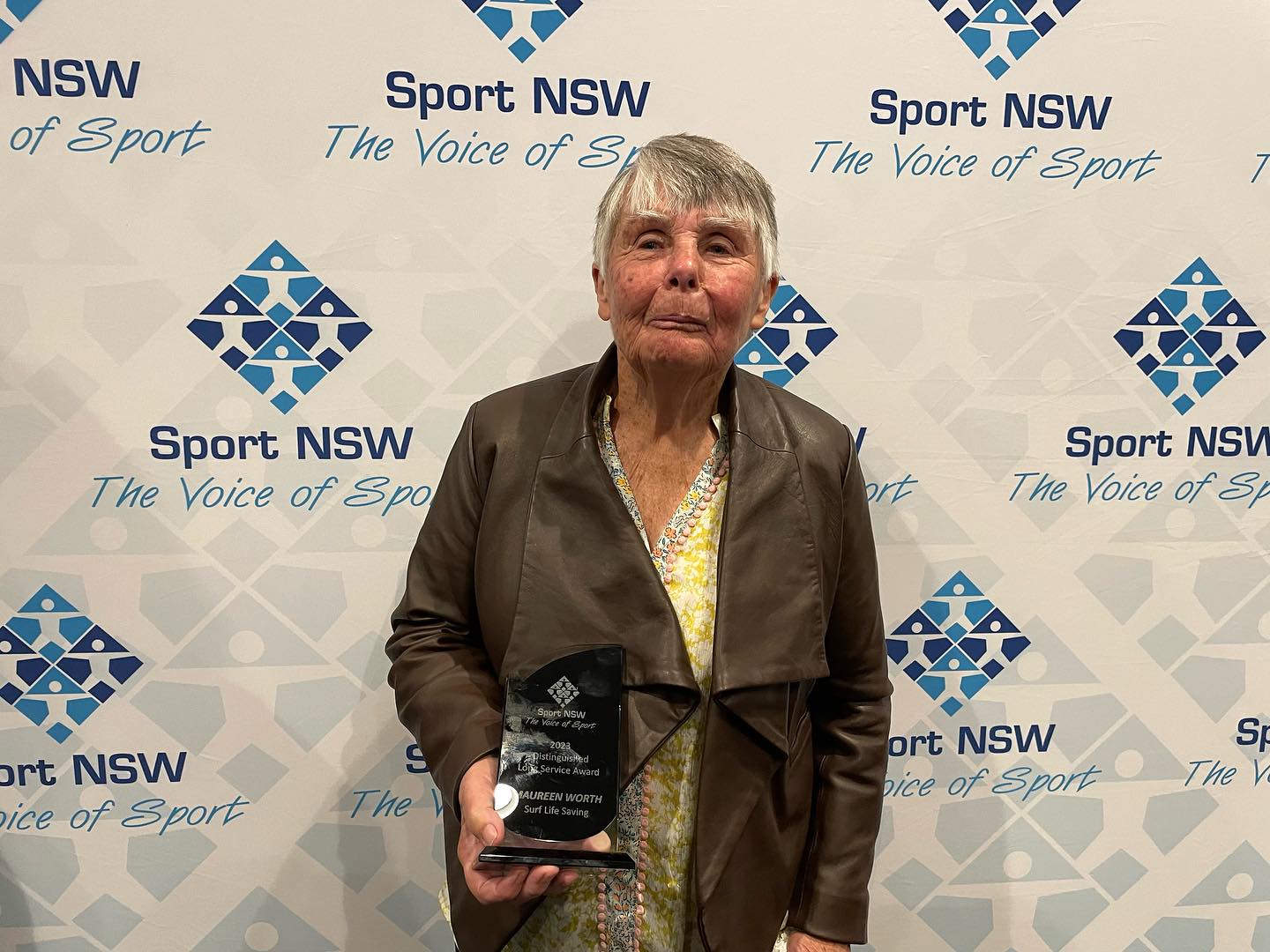
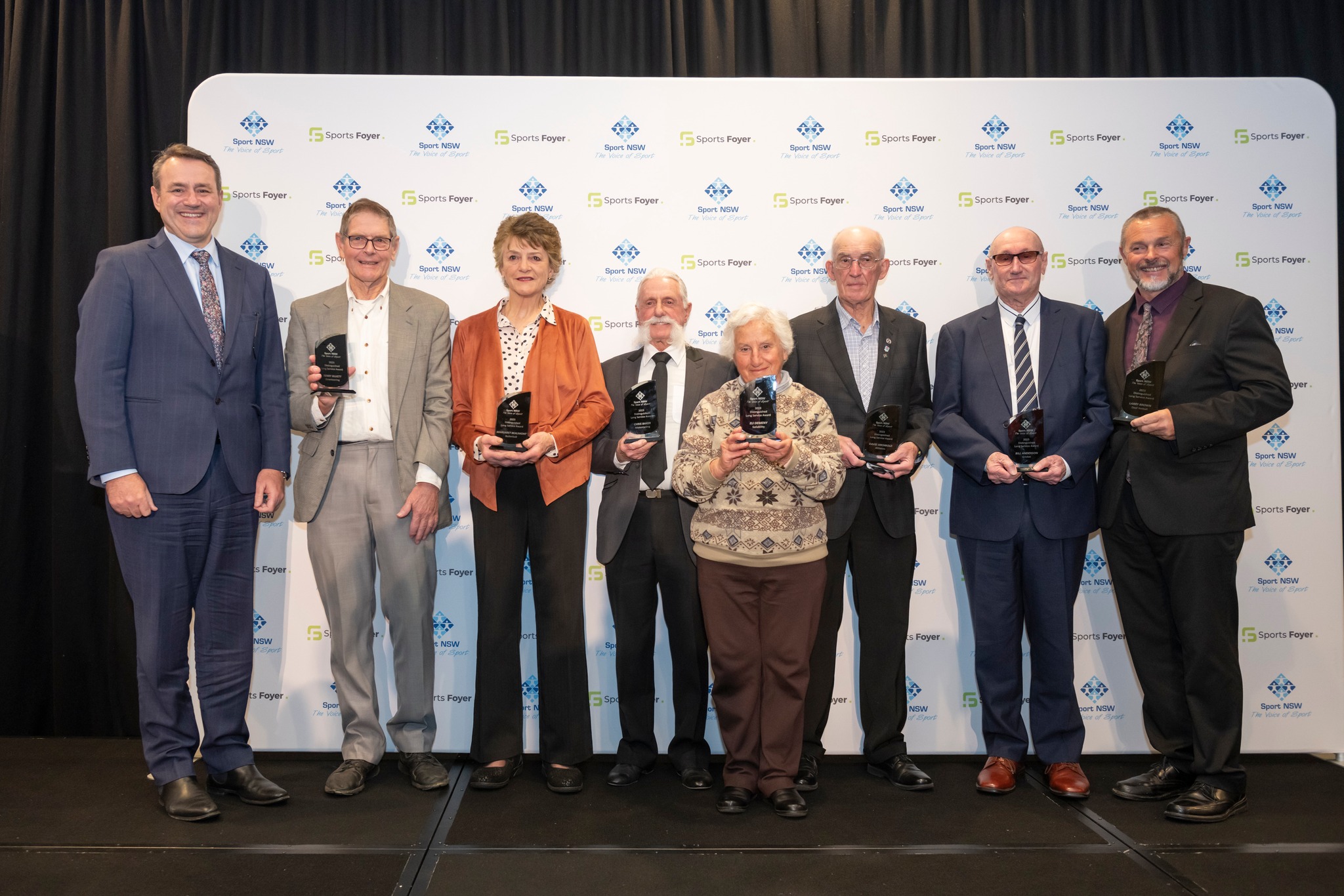

Cutting Red Tape To Give Veterans Ongoing Access To Rego And Licence Concessions
Aged Care Homes Urged To Accept Pets

Australian Of The Year – Have Your Say
Hope As Link Between Retina And Alzheimer's Revealed

Not just a youth movement: history too often forgets older protesters

Recent sustained anti-coal action by Blockade Australia in the Hunter Valley has brought public protest back into the news cycle. Activists have occupied trains, railway lines and machinery in an attempt to obstruct coal production and broadcast their message about the climate crisis.
Under recent anti-protest legislation in New South Wales, which has been matched by similar laws in other states, some protesters have been charged by police for their activism.
Internationally, protesters faced with arrest have devised new ways to protest. Recently, Iranian activists have started engaging in “micro-protests”, which are small-scale protests over a shorter period of time, to evade arrest.
My historical research into the infrastructure of protest, using the anti-Vietnam War campaign in New South Wales as a case study, has found that many Australians who did not or could not actively or publicly protest similarly found “quieter” ways to express their opposition to the conflict.

The Youth Are Revolting
In the popular Australian imagination, it seems the protester is a young person creating a public spectacle – holding up a sign, occupying a building or marching down a city street, even though older activists regularly play a part in protest movements.
Many might think of figures like Lidia Thorpe disrupting the 2023 Sydney Gay and Lesbian Mardi Gras Parade or ongoing protests by School Strike 4 Climate, which have shown how willing young people are to agitate for their collective futures.
But, in fact, one of the two anti-coal activists charged on last month for occupying a train in Singleton, New South Wales, is 64 years old.
My research shows our public memory of protest doesn’t come close to capturing everyone who used their energies to protest Australian involvement in Vietnam in the 1960s and 1970s, so we need to shift our idea of both protest and the protester to understand the potential scope of activism.
Quiet Protest
Vietnam War-era protest organisations, such as the Association for International Cooperation and Disarmament, Save Our Sons, Youth Campaign Against Conscription and the Vietnam Moratorium Campaign, were aware of how important “quiet protest” was to the wider movement.
They continually appealed to supporters for help selling buttons, putting up posters, selling raffle tickets, filling envelopes, leafleting and other clerical work. These were all carried out by people who were opposed to the war, and are all considered acts of protest.
Social movement theorists agree that time and availability are crucial in drawing people to protest. As far back as 1974, the sociologist Anthony Orum wrote:
Without people who have time on their hands, great revolutions would probably never get off the ground.

Time And Capacity
But what of those who did not have the time or capacity to march on streets, but who still saw themselves as part of the anti-Vietnam War movement?
The administrative records of protest organisations held in the State Library of New South Wales let us into the lives of such people.
These include Ian Robertson, a full-time Macquarie University student, whose parents had banned political activity because they feared it would disrupt his studies. Another silent protester was a Mrs Thomson, who was too busy organising her daughter Sue’s wedding to participate in anti-Vietnam protest activities. Public servants were also not permitted to publicly support the movement.
Most such records come from elderly members of the movement. In November 1969, Mabel Wilson, who in her words was “six years an octogenarian,” sent $5 to the Committee in Defiance of the National Service Act, writing:
I admire your courage and am completely in sympathy with your ideals. Alas! I am very old […] As you can see I can be of practically no use to you – or anyone […] My heart is with you all the way.
Similarly, on March 21 1970, Doris J Wilson of Asquith sent a donation to the Northern Districts Vietnam Moratorium Group with a letter saying:
I am past the age where I can do very much more than be just a voice.
On September 14 1970, L.T. Withers sent the same group a letter saying:
Congratulations for what you have accomplished. I feel rather guilty at being so useless […] myself and my wife are not as energetic as we used to be as the years are catching up on us a bit. I have enclosed a small donation to your local funds […] I would also be grateful if you could keep me informed of your activities.
Ruth Fryer of Hornsby sent a letter on February 9 1971 with a $3 donation:
Sometimes you wish you were young & strong again! But the hard work seems to be left to the young ones.
These Australians, among many others, were interested in the anti-Vietnam campaign and wanted to be involved as much as they could, given their limitations.
The Infrastructure Of Historical Protest
Studying the infrastructure of historical protest organisations shows us that we need to expand our idea of what a protest movement is and who it includes if we want to achieve the present-day goals of activist campaigning.
These findings are exciting because they capture a larger group of Australians in the protest tradition, and move past a limited, and often ableist and ageist, vision of protest to incorporate many others who feel just as strongly about the issues governing their lives.![]()
Effie Karageorgos, Lecturer, University of Newcastle
This article is republished from The Conversation under a Creative Commons license. Read the original article.
A rose in every cheek: 100 years of Vegemite, the wartime spread that became an Aussie icon

There are roughly 22 million jars of Vegemite manufactured in the original Melbourne factory every year. According to the Vegemite website, around 80% of Australian households have a jar in the cupboard.
The cultural status of Vegemite is so enduring that, in 2022, the City of Melbourne Council included the smell of the factory at 1 Vegemite Way, Fishermans Bend, in a statement of heritage significance.
Vegemite first hit Australian supermarket shelves in 1923, but it took a while to find its feet.
Indeed, the now classic spread may have failed into obscurity as “Parwill” if not for a very clever advertising campaign in the second world war.
A Product Of War
Vegemite has German U-boats to thank for its invention.
When the first world war began in 1914, Australians were big fans of Marmite, the British yeast extract spread.
As the Germans began sinking ships full of British supplies to Australia, Marmite disappeared from the shelves. Due to the conditions of its patent, Marmite could only be manufactured in Britain.
As a result, there was a gap in the market for a yeast spread.
Fred Walker, who produced canned foods, hired food technologist Cyril P. Callister to create a homegrown yeast spread using brewer’s yeast from the Carlton Brewery.
Callister’s experiments produced a thicker, stronger spread than the original Marmite. Callister’s inclusion of vegetable extracts to improve the flavour would give the spread its name, Vegemite, chosen by Walker’s daughter from competition entries.
Australians were wary of Vegemite when it first appeared on grocery shelves, perhaps due to brand loyalty to Marmite.
To try and combat this, Walker renamed Vegemite “Parwill” in 1928 as a play on Marmite: “if Ma might, Pa will”.
This rebrand was short-lived. Australians were not any more interested in Parwill than they were in Vegemite.
A Nutritious Food Replacement
In the 1930s, Walker hired American advertiser J. Walter Thompson. Thompson began offering free samples of Vegemite with purchases of other Kraft-Walker products, including the popular Kraft cheese.
Kraft-Walker also ran limerick competitions to advertise Vegemite. Entrants would write the final line of a limerick to enter into the draw to win a brand new car.

It would take another world war, however, before Vegemite became part of Australian national identity.
The second world war also disrupted shipping supply routes. With other foodstuffs hard to come by, Vegemite was marketed as a nutritious replacement for many foods. One 1945 advertisement read:
If you are one of those who don’t need Vegemite medicinally, the thousands of invalids and babies are asking you to deny yourself of it for the time being.
With its long shelf life and high levels of B-vitamins, the Department of Supply also saw the advantages of Vegemite. The department began buying Vegemite in bulk and including it in ration kits sent to soldiers on the front lines.
Due to this demand, Kraft-Walker foods rationed the Vegemite available to civilians. Yet the brand increased advertisements. Consumers were told Vegemite was limited because it was in demand for Australian troops due to its incredible health benefits.

In all operational areas where our men and those of our Allies are engaged, and in military hospitals, Vegemite is in great demand, because of its value in fighting Vitamin B deficiency diseases. That’s why the fighting forces have first call on all Vegemite produced. And that is why Vegemite is in short supply for civilian consumption. But it won’t always be that way. When the peace is won and our men come home, ample stocks of this extra tasty yeast extract will be available for everyone.
This clever advertising linked Vegemite with Australian nationalism. Though most could not buy the spread during the rationing years, the idea that Vegemite was vital for the armed forces cemented the idea that Vegemite was fundamentally Australian.
Buying Vegemite was an act of patriotism and a way to support Australian troops overseas.
Happy Little Vegemites
In the postwar baby boom, Vegemite advertisements responded to concerns about the nation’s health and the need to rebuild a healthy population.
This emphasis on Vegemite as part of a healthy diet for growing children would remain the key advertising focus of the next 60 years.
The ear-catching jingle was composed in the early 1950s, first for radio and then later used in the 1959 television ad.
The link between Australian identity and Vegemite was popularised internationally by Men At Work’s 1981 song Down Under, with the lyrics “He just smiled and gave me a Vegemite sandwich”.
The 1980s also saw the first remake of the 1950s television campaign, re-colourising it for nostalgic young parents who had grown up with the original.
In February 2022, the first international arrivals welcomed back into Australia post-COVID were greeted with a DJ playing Down Under, koala plushies and jars of Vegemite.
On Vegemite’s centenary in 2023, the unassuming spread is now firmly cemented as an Australian cultural icon. Love it or hate it, Vegemite is here to stay. ![]()
Hannah Viney, Researcher, Monash University
This article is republished from The Conversation under a Creative Commons license. Read the original article.
A History Of Sydney Streets
Avalon Beach Ladies Probus Club: July 2023 Speaker
 Avalon Beach Ladies Probus Club meets on 1st Tuesday of each month at Club Palm Beach at 10am, followed by a delicious lunch!
Avalon Beach Ladies Probus Club meets on 1st Tuesday of each month at Club Palm Beach at 10am, followed by a delicious lunch!AvPals Term 3 At Newport

Victoria Scraps Elder Abuse Support Services
Government Releases List Of Cheaper Medicines
- Cardiovascular disease.
- Crohn’s disease.
- Gout.
- Heart failure.
- High cholesterol.
- Hypertension.
- Osteoporosis.
- Ulcerative colitis.
24/7 Registered Nurse Cover And Care Minutes
How to overcome repetitive negative thinking through meditation

Do you ever find yourself caught in a cycle of negative thoughts? Maybe you ruminate on past mistakes, worry excessively about the future, or imagine worst-case scenarios?
Do you sometimes have a great day, everything goes well, and then your brain says, “Hey, remember that time you embarrassed yourself in front of everyone? Let’s relive that moment for the next 20 minutes.” And suddenly, your good day turns into a cringe-fest.
If so, know that you’re not alone. Many people struggle with repetitive negative thinking, and this can have a serious impact on mental health and well-being.
As the coordinator of expertise in caregiving at the Centre for Research and Expertise in Social Gerontology and an associate member of the Centre for Study and Research on India, South Asia and its Diaspora, I would like to shed light on the negative impact of repetitive negative thinking on the mental and physical health of caregivers.
The Devastating Effects Of Repetitive Negative Thinking
Repetitive negative thinking (RNT) is a cognitive process characterized by persistent and intrusive contemplation on past events, commonly known as rumination, and apprehensions about future possibilities, often referred to as worries.
RNT is a recurring, unwelcome, and difficult to dislodge pattern of thinking that has been implicated in the onset and perpetuation of diverse mental disorders, including depression, anxiety, and post-traumatic stress disorder. Furthermore, RNT has been found to be associated with physical health and has been linked to an increased likelihood of future health issues. RNT may negatively impact one’s quality of sleep, decrease efficiency, and hinder decision-making abilities.
Recent studies have revealed that the severity of RNT is connected with changes in brain morphology, leading to a decline in general cognitive abilities and increasing the risk of developing Alzheimer’s disease. Even at low levels, RNT can have detrimental effects on the cardiovascular, autonomic nervous, and endocrine systems.
So, what would be the most effective strategy for managing repetitive negative thinking? Research has demonstrated a negative correlation between RNT and mindfulness, implying that a low level of mindfulness can increase one’s susceptibility to RNT.

Journey To The Present: The Transformative Power Of Mindfulness
Mindfulness can be seen as a mental faculty or skill that can be developed through regular practice. It entails cultivating a non-judgmental and non-reactive awareness of the present moment. The objective is to be fully engaged in what’s happening right now, rather than dwelling on the past or worrying about the future.
There are two main styles of mindfulness practice: focused attention meditation and open monitoring meditation. Focused attention meditation involves choosing a specific object, such as the breath, and bringing your full attention to it. Whenever the mind wanders, it is simply brought back to the object of focus. In contrast, open monitoring meditation involves being aware of everything occurring in the present moment. Instead of trying to focus on a specific object, one simply observes whatever arises in the experience, including thoughts, emotions, and physical sensations.
But what’s happening in the brain during these practices? Recent studies have revealed that only during focused attention meditation, there is a deactivation of the “default mode network” — a network of brain areas that are typically active when we’re not focused on any particular task. This network is implicated in “resting-state” thinking, which involves repetitive negative thinking. By deactivating the “default mode network,” focused attention meditation can help reduce this harmful type of thinking.

Reducing Repetitive Negative Thinking: A Breakthrough For Caregivers
As part of our project, we will develop and examine an intervention targeted at reducing RNT in family caregivers.
According to a recent report, over eight million Canadians aged 15 and older, or 25 per cent of the population, provide care to a family member or friend with a long-term health condition, disability, or aging-related needs.
While caregiving can be rewarding, it can also be challenging and stressful, particularly for those who provide extensive or complex care. Chronic stress is a common experience for family caregivers, and it can take a toll on their health and well-being. A survey of caregivers found that the top areas of need for caregivers were emotional health (58 per cent) and physical health (32 per cent). RNT is strongly associated with caregiver burden and predicts negative impacts on the physical and mental health of caregivers.
We will recruit 100 caregivers with high levels of RNT. The intervention will be presented to participants in the form of interactive videos that guide them through the practice of focused attention meditation. We will measure changes in RNT, stress, anxiety, depression, and quality of life before and after the intervention, as well as at a six-month follow-up.
If the intervention is effective, it could serve as the basis for the development of an innovative tool for monitoring and reducing RNT. This tool could be deployed as a mobile app or on virtual reality platforms, providing caregivers with access to an intervention that they can use at their convenience. This could significantly expand the reach of the intervention, making it more accessible and convenient for caregivers who may not have the time or resources to participate in traditional face-to-face interventions.
Overall, the potential of the focused attention meditation intervention to improve the mental and physical health of caregivers, as well as the development of new innovative tools, represents a promising avenue in the field of caregiver support services. Further research and implementation of such interventions could significantly improve the quality of life for caregivers and the people they care for.

After all, to echo the words of philosopher Marcus Aurelius, “the happiness of your life depends upon the quality of your thoughts.”![]()
Anna Andrianova, Coordonnatrice, Domaine d'expertise en Proche aidance, Centre de recherche et d'expertise en gérontologie sociale (CREGÉS), Candidate au Ph.D. et chargée de cours, Université Laval
This article is republished from The Conversation under a Creative Commons license. Read the original article.
Common diabetes drug metformin could protect against long COVID

There are no drugs to treat long COVID – a condition that affects around 2 million people in the UK alone – so you can imagine the excitement when a cheap diabetes drug called metformin was shown to decrease the risk of getting the disease.
The study, published in The Lancet Infectious Diseases, showed that if you give people who are overweight or obese metformin when they are ill with COVID, they are 40% less likely to develop long COVID compared with people who are given a placebo (dummy pill).
We don’t know exactly what causes long COVID, but a variety of biological mechanisms have been suggested, including an overactive immune response, the virus lingering in certain organs, and thrombosis (clots) causing tissue damage.
Finding a cure is clearly going to be difficult, so a better approach would be to prevent the condition from developing in the first place. Treatment given during the infection may be able to reduce the immune response or help the body eliminate the virus and so lessen its long-term effects.
What The Study Did
In a clinical trial in the US, overweight and obese people aged 30 and over were randomly allocated to receive metformin or a placebo. (Being overweight or obese are known risk factors for long COVID.)
The participants were recruited remotely, for example, through online messaging, and people were selected for the study based on self-reported criteria, including age and weight. The trial did include women who were pregnant or breastfeeding, which is important as these groups are often excluded from drug trials.
Over 1,000 people were given either metformin or an identical placebo pill after testing positive for COVID between December 2020 and January 2022.
The active drugs and placebos were mailed to patients by courier and treatment was initiated within seven days of COVID symptoms starting. Almost half of the participants began treatment within four days of their symptoms starting.
Participants were instructed to take the pills for two weeks. The researchers followed the participants for ten months to see if they developed long COVID. Participants reported their symptoms monthly via an online survey.
Neither the trial participants nor the researchers knew which treatment a participant had received. This is what’s known as a “double-blind” trial and it’s important for avoiding bias.

What The Results Showed
The main outcome measure was the report of a doctor’s diagnosis of long COVID. Of the 564 people who received metformin, 35 developed long COVID (6.3%) compared with 58 out of 562 (10.4%) who took a placebo. This equates to a 41% lower risk of long COVID for patients who received metformin.
Those starting treatment earlier, by day four, had lower rates of long COVID compared with those who started treatment later. This lends weight to the proposition that metformin has a protective effect against long COVID.
However, because relatively few people developed long COVID, large numbers of people needed to take metformin to prevent a single case of long COVID. Roughly 24 people would need to take metformin to prevent one case of long COVID.
While metformin is a safe drug – as indicated by many decades of use worldwide for type 2 diabetes as well as its current prescribing in pregnancy to treat gestational diabetes – it’s nevertheless worth weighing up the risks and benefits carefully. Side-effects can include a rash and diarrhoea.
Further studies will also be required to determine whether similar benefit is seen in the UK, particularly in people from minority ethnic groups, who were underrepresented in this study (83% of participants were white).
While it’s not clear how exactly metformin might work to protect against long COVID, this study offers a promising glimpse of how we might prevent it from developing in future.![]()
Frances Williams, Professor of Genomic Epidemiology and Hon Consultant Rheumatologist, King's College London
This article is republished from The Conversation under a Creative Commons license. Read the original article.
What is ‘sundowning’ and why does it happen to many people with dementia?

The term “sundowning” is sometimes used to describe a tendency for people living with dementia to become more confused in the late afternoon and into the night.
At the outset, I should emphasise the term “sundowning” is overly simplistic, as it’s a shorthand term that can encompass a vast number of behaviours in many different contexts. When assessing changed behaviours in dementia, it’s always better to hear a full and accurate description of what the person is actually doing at these times, rather than to just accept that “they’re sundowning.”
This set of behaviours commonly described as “sundowning” often includes (but is not limited to) confusion, anxiety, agitation, pacing and “shadowing” others. It may look different depending on the stage of dementia, the person’s personality and past behaviour patterns, and the presence of specific triggers.
Why then, do such altered behaviours tend to happen at specific times of the day? And what should you do when it happens to your loved one?

Fading Light
We all interpret the world via the information that enters our brains through our five senses. Chief among these are sight and sound.
Imagine the difficulty you’d have if asked to perform a complex task while in a darkened room.
People living with dementia are just as dependent on sensory input to make sense of and correctly interpret their environment.
As light fades towards the end of the day, so too does the amount of sensory input available to help a dementia patient interpret the world.
The impact of this on a brain struggling to integrate sensory information at the best of times can be significant, resulting in increased confusion and unexpected behaviours.
Cognitive Exhaustion
We have all heard it said that we only use a fraction our brain power, and it is true we all have far more brain power than we typically require for most of the day’s mundane tasks.
This “cognitive reserve” can be brought to bear when we are faced with complex or stressful tasks that require more mental effort. But what if you just don’t have much cognitive reserve?
The changes that ultimately lead to symptoms of Alzheimer’s disease can begin to develop for as many as 30 years before the onset of symptoms.
During that time, in simple terms, the condition eats away at our cognitive reserve.
It is only when the damage done is so significant our brains can no longer compensate for it that we develop the first symptoms of Alzheimer’s disease and other dementias.
So by the time someone first presents with very early dementia symptoms, a lot of damage has already been done. Cognitive reserve has been lost, and the symptoms of memory loss finally become apparent.
As a result, people living with dementia are required to exert far more mental effort during the course of a routine day than most of us.
We have all felt cognitively exhausted, run down and perhaps somewhat irritable after a long day doing a difficult task that has consumed an extreme amount of mental effort and concentration.
Those living with dementia are required to exert similar amounts of mental effort just to get through their daytime routine.
So is it any surprise that after several hours of concerted mental effort just to get by (often in an unfamiliar place), people tend to get cognitively exhausted?

What Should I Do If It Happens To My Loved One?
The homes of people living with dementia should be well-lit in the late afternoons and evenings when the sun is going down to help the person with dementia integrate and interpret sensory input.
A short nap after lunch may help alleviate cognitive fatigue towards the end of the day. It gives the brain, and along with it a person’s resilience, an opportunity to “recharge”.
However, there is no substitute for a fuller assessment of the other causes that might contribute to altered behaviour.
Unmet needs such as hunger or thirst, the presence of pain, depression, boredom or loneliness can all contribute, as can stimulants such as caffeine or sugar being given too late in the day.
The behaviours too often described by the overly simplistic term “sundowning” are complex and their causes are often highly individual and interrelated. As is often the case in medicine, a particular set of symptoms is often best managed by better understanding the root causes.![]()
Steve Macfarlane, Head of Clinical Services, Dementia Support Australia, & Associate Professor of Psychiatry, Monash University
This article is republished from The Conversation under a Creative Commons license. Read the original article.
People with Parkinson’s may benefit from cardio, weight training and yoga – here’s what you need to know
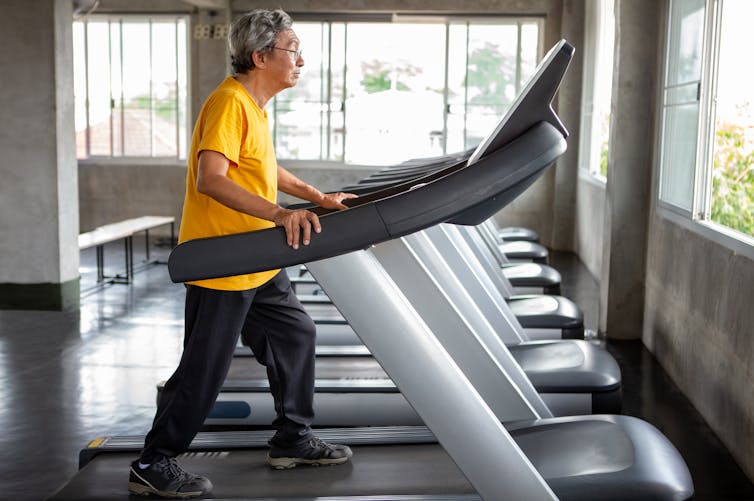
Many people associate Parkinson’s disease with the physical symptoms it causes – such as tremors, muscle stiffness and balance problems – which can all make everyday activities difficult. But just because Parkinson’s makes movement harder, doesn’t mean those with the disease should stop moving.
This was highlighted in a recent video posted by British fitness influencer Joe Wicks on his YouTube channel. In the video, Wicks guides viewers through exercises they can do if they have Parkinson’s disease – and explains why it’s important to keep moving.
There have been several scientific studies exploring the impact of different types of exercise on people with Parkinson’s disease. On the whole, most types of exercise have been shown to have a positive effect on people with Parkinson’s – improving quality of life and physical symptoms. Aerobic exercise appears to be particularly beneficial.
One clinical trial, for instance, found that high-intensity exercise may reduce the severity of motor symptoms in people recently diagnosed with Parkinson’s disease.
To conduct their study, researchers split participants into three groups. One group performed a high-intensity treadmill routine, running close to maximum effort. Another performed moderate-intensity exercise, running at a light jog. The last group were given no instructions to perform a treadmill-based exercise regime. The exercise regimes were performed for 30 minutes between three and four times a week for a period of six months.
At the end of the study, the participants who had performed the high-intensity exercise had less severe motor symptoms compared to the other groups. None of the participants in the study had yet been prescribed medication to manage their symptoms – so the positive effects appear to be solely down to exercise.
Another long-term global study of 2,940 people with Parkinson’s found that those who said they consistently exercised for at least 2.5 hours a week (around 20 minutes per day) had a better quality of life compared to those who didn’t exercise at all. The greatest benefit was seen in participants with advanced Parkinson’s disease.
However, given that all the participants were taking medication to manage their symptoms at the time of the study, it’s difficult to know if exercise alone explained this link.
Maintaining a regular exercise routine may also slow the worsening of Parkinson’s symptoms. A study, which looked at 237 people recently diagnosed with Parkinson’s, found that those who reported doing moderate exercise 150 minutes a week showed less decline in motor symptoms after six years compared to those who did less exercise and were less active in general.
This was true for many different types of physical activity – including doing household chores – so long as the exercise was regular and sustained throughout the study.
It isn’t only high-intensity aerobic exercise that may be beneficial to people with Parkinson’s. A large systemic review, which examined 156 randomised clinical trials and data from 7,939 participants, found that many types of exercise – from swimming to walking – can improve movement and overall quality of life in people with Parkinson’s.
The authors also concluded that there was no evidence that one kind of exercise worked better than others.

Research has also shown that regular physical activity may help prevent other Parkinson’s symptoms from worsening – such as sleep problems.
While researchers still aren’t sure why exercise may improve symptoms for people with Parkinson’s, some evidence from laboratory and clinical studies shows that exercise may protect the brain’s neurons (the nerve cells which send messages from the brain throughout the body) by releasing a protein in the brain called brain-derived neurotrophic factor.
This is a protein which can promote the survival and regrowth of neurons and is present at higher levels during physical exercise. Levels of brain-derived neurotrophic factor have been shown to be lower in people with Parkinson’s.
Another protein, called irisin, which is made by muscle cells when we exercise, may also help protect neurons, as shown in cell models of Parkinson’s disease.
Tailored Workouts
While exercise has many benefits for people with Parkinson’s, it should be used as a complement to other treatments, such as medications which help manage symptoms.
It’s also important that people with Parkinson’s consult their GP when putting together an exercise regime. This is to avoid risk of pain, injury or falls by determining which exercises suit each person.
Exercises which maintain and improve strength and balance are recommended. Pilates, for example, has been shown to benefit balance and overall strength in people with Parkinson’s. Yoga can also improve flexibility and overall mental wellbeing in people with Parkinson’s, while balance training (such as tai chi or yoga) may prevent falls.
If you’re up for something more intense, strength training has been shown to improve slowness of movement. Swimming is also a good option, and may especially be beneficial for those who with joint stiffness or pain.
But even if you’re having trouble motivating yourself to exercise, many types of physical activity may be helpful as long as you do them regularly. For example, walking, gardening and household chores (such as cooking, hoovering and dusting) may prevent symptoms worsening and improve quality of life. And, these activities may be easier to incorporate into your daily routine than a gym workout.![]()
Aideen Sullivan, Professor and Head of Department of Anatomy & Neuroscience, University College Cork and Lucy Collins-Stack, Senior Post-Doctoral Researcher, University College Cork
This article is republished from The Conversation under a Creative Commons license. Read the original article.
Australian researchers confirm world’s first case of dementia linked to repetitive brain trauma in a female athlete
Stephen Townsend, The University of Queensland; Alan Pearce, La Trobe University, and Rebecca Olive, RMIT UniversityResearchers at the Australian Sports Brain Bank have today reported the world’s first diagnosis of chronic traumatic encephalopathy (CTE) in a female athlete.
With the consent of her family, the diagnosis was made on the brain of Heather Anderson, a 28-year-old AFLW athlete who died last November. Heather’s family donated her brain to the Australian Sports Brain Bank hoping to better understand why she died.
The findings, which Professor Alan Pearce co-authored with the Australian Sports Brain Bank, raise questions about how a lifetime of contact sport may have contributed to her death. They come as Australia’s Senate inquiry works on its report into concussions and repeated head trauma in contact sport, due in August.
Given how hard women have fought to participate in football codes and contact sports in recent years, this diagnosis has major implications for women’s sport in Australia. It also highlights the significant lack of research about women athletes in sport science and medicine.
What Is Chronic Traumatic Encephalopathy?
CTE is a devastating form of dementia which causes a decline in brain functioning and increased risk of mental illness. It is increasingly associated with athletes who play contact sports, such as football, boxing and martial arts.
It is incurable and can only be diagnosed post-mortem. Recently, a number of high-profile former Australian footballers were found to have been suffering from CTE when they died, including former AFL stars Danny Frawley and Shane Tuck, and former NRL player and coach Paul Green.
Concussions in contact sports have long been associated with long-term neurodegeneration in Australia and internationally. While the public and researchers are rightly concerned about serious concussions, a study published last month in Nature Communications confirmed that repetitive brain trauma over time – even seemingly mild head knocks or whiplash – is the strongest predictor for an athlete developing CTE. Athletes with long careers in contact sport are at particular risk, especially if they play from an early age.
A Sporting Life
Heather Anderson began playing rugby league at age five before transferring to Australian rules football in her early teens. She played representative football in the Australian Capital Territory and Northern Territory before being drafted into the inaugural season of the AFLW in 2017.
Anderson played a single season with the Adelaide Crows, during which she won a premiership and suffered a career-ending shoulder injury. She then returned to her role as a medic with the Australian Army, a physical career which also carries a heightened risk of brain injury.
Anderson’s family donated her brain in the hope of knowing whether a lifetime of exposure to repetitive head trauma contributed to her death.
Was This Diagnosis Expected?
Concussion researcher Anne McKee predicted earlier this year it was a matter of time before CTE was found in the brain of a woman athlete.
The Australian Sports Brain Bank team believe Anderson is a “sentinel case” we can learn from. She is the first female athlete diagnosed with CTE, but she will not be the last.
Although Australian women have historically been excluded from the sports most associated with repeated head injuries, this is changing. In 2022, there were almost one million women and girls playing some form of contact sport in Australia. As women’s participation in contact sport continues to grow, so too does their risk of repetitive brain trauma.
Are Women More Prone To CTE Than Men?
There is emerging evidence that women are at significantly higher risk of mild traumatic brain injury (concussion) and may suffer more severe symptoms.
Concussion alone does not cause CTE, but an athlete’s number of concussions is a reliable indicator of their cumulative exposure to brain trauma, which is the biggest predictor of CTE.
While knowledge on the topic is still developing, researchers propose a mix of physiological and social explanations for women’s increased concussion risk. These include
[…] differences in the microstructure of the brain to the influence of hormones, coaching regimes, players’ level of experience and the management of injuries.
More research is needed to understand sporting brain injuries specifically in women and girls. Given their growth in participation and the enhanced risks they face in sport, it is concerning that women and girls are underrepresented in concussion research.
This is representative of a broader trend in sport and exercise science research to exclude women from studies because their bodies are perceived as more complex than men’s and thus more difficult to accommodate in testing.
A Disease That Does Not Discriminate
This world-first report of CTE in a female athlete is proof the disease does not discriminate and lends urgency to calls for greater representation of women in brain injury studies.
Efforts to reduce concussion in women’s sport must first address resource inequalities between men’s and women’s sport. This includes giving women access to quality training and coaching support, as well as greater attention from sport science and medical research.
The health of women athletes and women’s sport will only progress if researchers, policymakers and sport governance bodies ensure the attention and resources required to address concussion and brain disease are not focused solely on men.
If this article has raised issues for you, or if you’re concerned about someone you know, call Lifeline on 13 11 14. The National Dementia Helpline number is 1800 100 500.![]()
Stephen Townsend, Lecturer, School of Human Movement and Nutrition Sciences, The University of Queensland; Alan Pearce, Professor, College of Science, Health, Engineering, La Trobe University, and Rebecca Olive, Vice Chancellor's Senior Research Fellow, RMIT University
This article is republished from The Conversation under a Creative Commons license. Read the original article.
Why eating disorder treatments only work half the time, according to a psychologist

No single treatment will work for all people with eating disorders. Even the most highly researched evidence-based treatment may work for some people, but less so for others. When such treatments do not work, it can provoke anxiety.
As part of our research, we spoke with one mother who was supporting her teenage daughter through anorexia nervosa. When current treatments were not working, the mother told us:
We don’t really know what else we can do.
But there may be other treatment options for people like her daughter. The issue is they’re not always available on Medicare.
Medicare Provides A Menu Of Options
In Australia, changes to Medicare mean people diagnosed with an eating disorder may be eligible for up to 40 sessions with a psychologist and up to 20 sessions with a dietitian a year.
This is a remarkable recognition of how eating disorders such as anorexia, bulimia or binge eating impact people’s lives, and for those who care for them.
This also recognises how difficult it can be to recover from an eating disorder. This is particularly when aspects of the eating disorder are acceptable to the person, and become their way of dealing with the slings and arrows of life.
Medicare provides several options for psychological interventions to treat eating disorders that are backed by research evidence.
These treatments include family-based treatment for adolescent eating disorders and cognitive behavioural therapy for adult eating disorders.
Such interventions work in the long term for around half of people.
So what about the other half?
It’s Not Just About Evidence
Think about psychotherapy – also known as talking therapy – as a three-legged stool.
One leg of the stool is the research evidence. Another is the clinician’s expertise. The third leg is preferences of the person having treatment. We need all three if the stool is to stay upright and the psychotherapy has a chance of working.

The current Medicare system allows clinicians to draw from the first leg – the research evidence. This works for some.
Then there’s the second leg, the clinician’s expertise. One welcome development is through the Australian & New Zealand Academy for Eating Disorders credential for professionals treating eating disorders.
What is less recognised in the current Medicare system, however, is the importance of the therapeutic relationship, such as whether the clinician works in a person-centred way that takes into consideration the person’s preferences.
This could be tailoring treatment to the person’s unique needs, instilling hope for their recovery, and seeing the person as more than just the eating disorder. Think of these as the third leg of the stool.
These second and third legs help explain why even gold-standard, research evidence-based treatments do not work for everyone.
What Else Could Work?
There are many psychological treatments for eating disorders that don’t have research evidence to back them. We cannot necessarily dismiss them as not working. They may have not yet been extensively researched. These emerging treatments need more research evidence, including which treatments work, for whom, and when.
Emerging treatments include those based on mindfulness. These may involve people learning not to judge their thoughts and feelings as right or wrong, or good or bad. Instead, this therapy allows them to observe these thoughts and feelings by focusing on the present moment.
Others include therapies that address both the eating disorder and adverse and traumatic life events, including the experience of the eating disorder itself.
We are also interested in, and are currently researching, narrative therapy. This explores aspects of the person that have been lost to the eating disorder, such as a valued sense of oneself. Reclaiming these aspects can give the person freedom to live a life no longer dominated by the eating disorder.
Until emerging treatments have more extensive research evidence, the Medicare system needs to mention them as valid treatment pathways when facilitated by experienced practitioners. This is particularly important if the most widely researched interventions do not work for someone.
Including emerging therapies, however, does not mean anything goes. To work out which of these emerging therapies might be eligible for Medicare funding in the future, we need greater consultation with people living with eating disorders, and the clinicians who treat them, to learn which emerging treatments work in practice.
Join Our Study
We are conducting a small study on narrative therapy for anorexia nervosa. This involves 40 sessions over 12 months to be conducted at Western Sydney University.
If you want to know more about participating in the study, email us at narrative@westernsydney.edu.au
If you (or someone you know) needs care for an eating disorder, see your GP to be assessed for a Medicare Eating Disorder Plan. For support and more information about eating disorders, contact the Butterfly Foundation on 1800 33 4673 or Kids Helpline on 1800 551 800. If this article has raised issues for you, or if you’re concerned about someone you know, call Lifeline on 13 11 14. In an emergency, call 000.![]()
Janet Conti, Associate Professor of Clinical Psychology, Western Sydney University
This article is republished from The Conversation under a Creative Commons license. Read the original article.
ACCC Invites Views On Data Broker Industry
Tradie Platform Hipages Rectifies Subscription Trap Issues
Pricing Practices And Operating Costs Of Childcare Services To Be Examined, As Latest ACCC Report Confirms Fees Outpaced Inflation
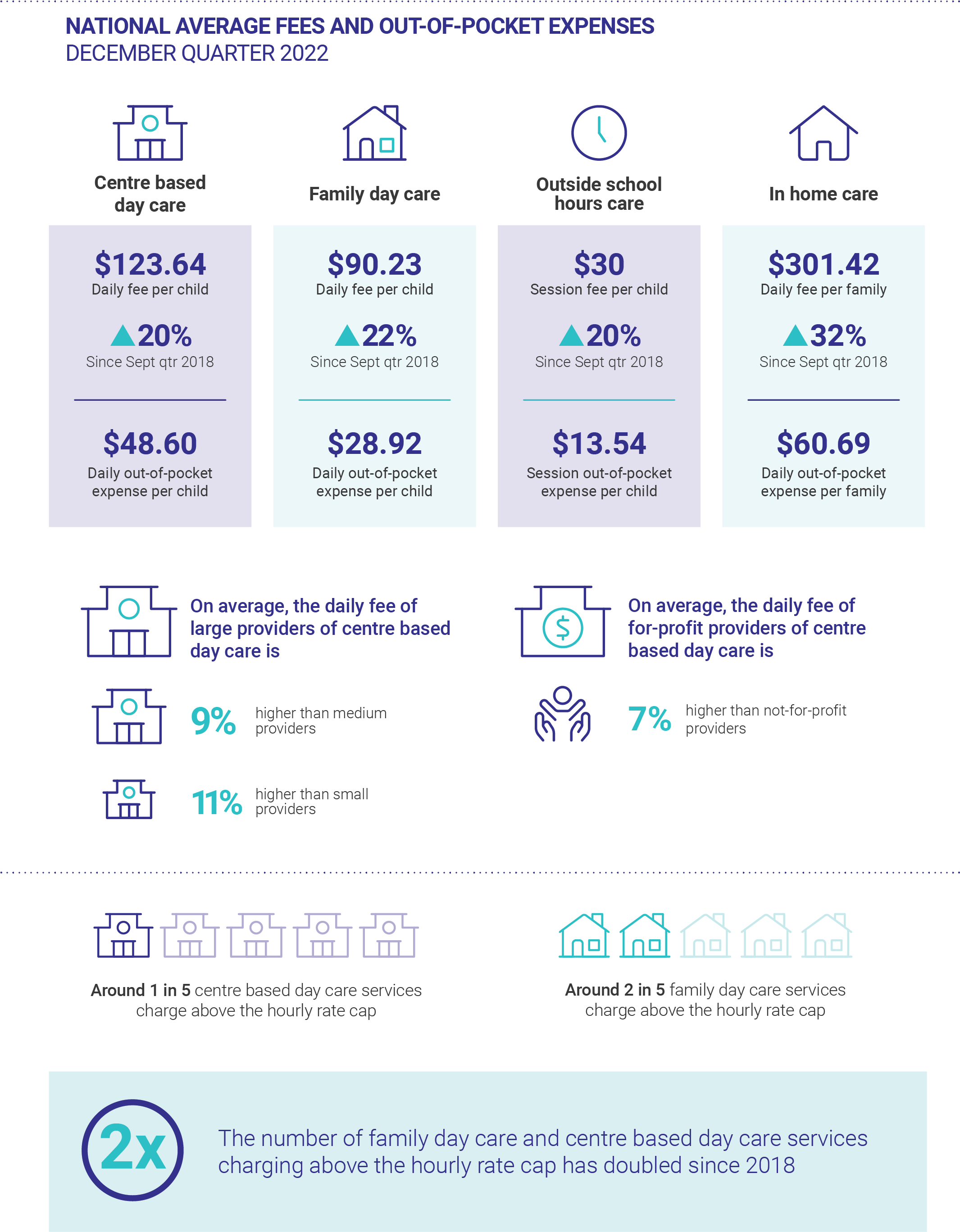
ACCC Intervenes To Ensure 543 Businesses Avoid Higher Electricity Bills
Transurban's Proposed Majority Ownership Of Horizon Roads Raises Concerns
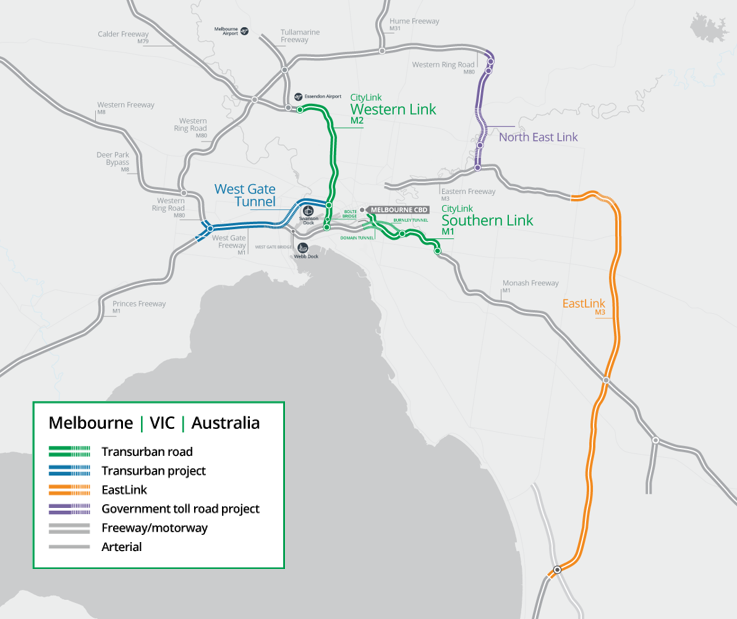
Green Endeavour Pays Penalty For Alleged Breach Of Horticulture Code
First Look At Australia's First Purpose-Built Biocontainment Centre At Sydney’s Westmead Health Precinct
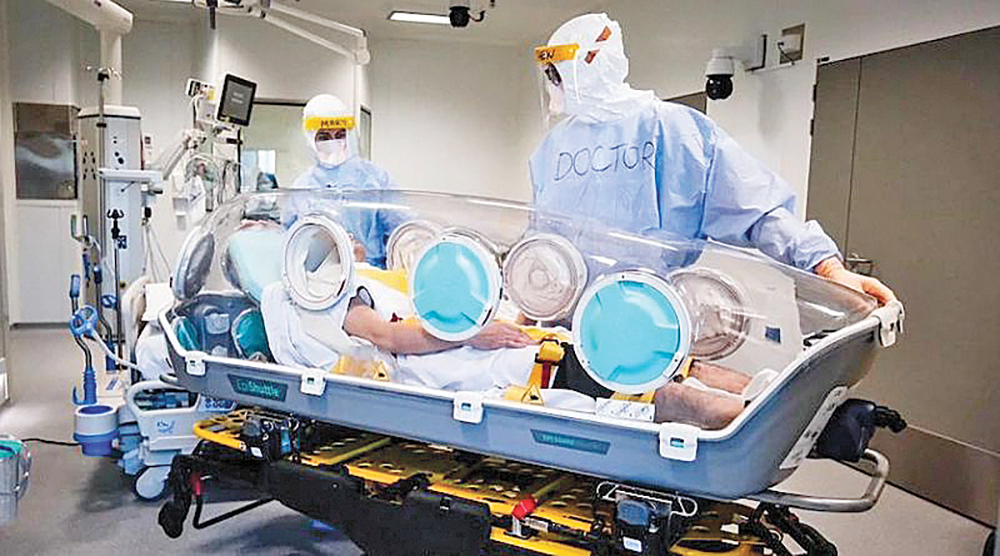
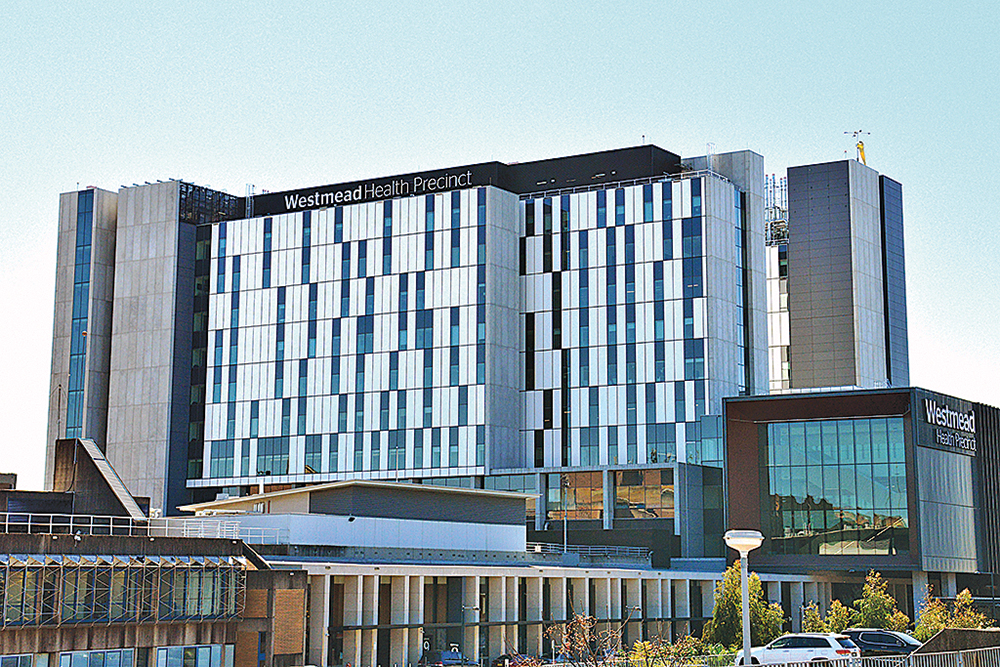
Burns Take A Toll On Academic Outcomes: New Macquarie University Study
How many types of narcissist are there? A psychology expert sets the record straight

Our interest in narcissism has never been higher, with Google searches for the word “narcissist” having steadily increased over the past decade. This term has become part of everyday parlance, readily thrown around to describe celebrities, politicians and ex-partners.
A byproduct of our growing interest in narcissism is a curiosity about what types of narcissist exist. But this is where things get tricky. A search for “types of narcissists” on Google returns wildly varied results. Some websites describe as few as three types. Others list up to 14.
What’s going on here?
What Is A Narcissist?
The word “narcissism” comes from the Greek myth of Narcissus, a boy who falls in love with his own reflection.
Over the past century or so, conceptualisations of narcissism have evolved. It is now thought of as a collection of personality traits characterised by grandiosity, entitlement and callousness. “Narcissist” is the term used to describe someone who scores highly on these traits.
A narcissist may also meet the diagnostic criteria for narcissistic personality disorder, a mental health diagnosis that affects about 1% of people. It’s broadly described as a pervasive pattern of exhibiting grandiosity, needing admiration and lacking empathy.
Importantly, not all narcissists have narcissistic personality disorder.
How Many Types Of Narcissism Are There?
There are two main types of trait narcissism (which are distinct from narcissistic personality disorder). These are grandiose narcissism and vulnerable narcissism.
Grandiose narcissism is associated with a grandiose sense of self, aggression and dominance. Vulnerable narcissism is characterised by heightened emotional sensitivity and a defensive and insecure grandiosity that masks feelings of inadequacy.
Recent models have identified three core components of narcissism that help explain the similarities and differences between both grandiose and vulnerable narcissism.
Antagonism is common to both grandiose and vulnerable narcissism. It’s linked with traits such as arrogance, entitlement, exploitativeness and a lack of empathy.
Agentic extraversion is unique to grandiose narcissism. It’s associated with traits such as authoritativeness, grandiosity and exhibitionism.
Narcissistic neuroticism is specific to vulnerable narcissism. It’s associated with fragile self-esteem and a tendency to experience negative emotions and shame.
A person will likely meet the diagnostic criteria for narcissistic personality disorder when there is a convergence of high scores across each of these components.
Also, while diagnostic criteria emphasise the grandiose aspects of narcissistic personality disorder, clinicians report an oscillation between both grandiose and vulnerable narcissism in people with the disorder.
Vulnerable narcissism has a considerable overlap with borderline personality disorder, particularly in terms of its causes and the displayed personality traits. A person who only scores highly for vulnerable narcissism is more likely to be diagnosed with borderline personality disorder than narcissistic personality disorder.
Are There Other Types Of Narcissists?
Given the consensus in psychology on the two main types of trait narcissism described above (which sit alongside the clinical diagnosis of narcissistic personality disorder), how can we account for the many sources describing other “types” of narcissism?
First and most concerning is the proliferation of pop psychology articles that describe types of narcissism for which there is no good evidence.
They feature terms such as “cerebral narcissist”, “somatic narcissist”, “seductive narcissist” and “spiritual narcissist”. But searching for these terms in peer-reviewed academic literature yields no evidence that they are valid types of narcissism.
Some articles also use terms often considered synonymous with grandiose and vulnerable narcissism. This likely comes from early literature, which used a range of terms to describe types of narcissism. One review from 2008 identified more than 50 different labels used to describe types of narcissism.
Conceptually, however, each of these labels can be mapped onto either grandiose or vulnerable narcissism.
Often you will see “overt” and “covert” being described, sometimes alongside descriptions of grandiose and vulnerable narcissists. Some researchers have proposed overt and covert narcissism as being akin to grandiose and vulnerable narcissism. Others argue they are more appropriately considered expressions of narcissism present in both grandiose and vulnerable narcissism.
Lastly, a number of these articles describe narcissists by drawing on specific expressions of grandiose or vulnerable narcissism. For instance, they describe “antagonistic narcissists”, “communal narcissists”, “agentic narcissists” and “sexual narcissists” alongside grandiose and vulnerable narcissists.
These descriptions imply each of these are mutually exclusive types of narcissism, when really they should be thought of as aspects of grandiose and/or vulnerable narcissism. In other words, they are examples of how narcissism might be expressed.
The Danger Of Labels
Narcissism’s multifaceted nature has likely contributed to the array of terms people use to describe narcissists.
Some of these are valid constructs. When used accurately, they can be useful for identifying the different ways narcissism is expressed – particularly in intimate relationships, where high levels of grandiose and vulnerable narcissism are associated with perpetration of abuse.
However, online articles that inaccurately describe and categorise narcissism are anything but helpful. This content fuels armchair psychologists, who then jump to assign the label “narcissist” to anyone they think is displaying narcissistic traits.
Even when accurately applied in clinical settings, diagnostic labels aren’t always useful. They may bring stigma, which can discourage people from seeking mental health support.![]()
Megan Willis, Senior Lecturer, School of Behavioural and Health Sciences, Australian Catholic University
This article is republished from The Conversation under a Creative Commons license. Read the original article.
What do the different colours of mould mean in my house?

You may be interested (or possibly horrified) to discover you ingest and inhale thousands of tiny life forms on a daily basis.
The air and surfaces around you are home to multitudes of bacteria, fungi, viruses, mites, algae and protozoa. Your skin isn’t much better, with a complex ecosystem of organisms called commensals which aren’t necessarily good or bad, but will shift in their composition depending on where you live, the products you use and the pets you have.
Most of these creatures are generally undetectable due to their microscopic size and low concentrations. But when they find a niche they can exploit, you might notice them by their smell, or the appearance of unwanted staining and colour changes. A lot of this fungal growth is what we call mould.
We’ve all been disappointed in ourselves at one time or another, lifting a neglected orange out of the fruit bowl to discover the bottom half is covered in a velvety blue-green growth.
But what do the myriad colours that appear on our stuff tell us about the world we try not to think about?
Black
Often black staining is quite a disturbing occurrence. The concept of toxic black mould is one many people have become aware of due to flood impacts.
A quick online search will likely terrify you, but not all black discolouration is due to the same organisms, and almost none of it will outright cause you harm.
Stachybotrys is the one known as toxic black mould. It often turns up on building materials that have been wet for a long time.

When the grout in your shower turns black though, that’s a different fungus called Aureobasidium. It’s slimy, sticky and somewhere between a filamentous mould, which grows threadlike roots through whatever it’s eating, and a yeast, which prefer a free-floating, single-celled style of life.
Bleaching will often kill Aureobasidium, but the dark pigmentation will likely hang around – harmlessly, but stubbornly.

Blue
That blue orange I mentioned before, you can thank Penicillium for that. The organism that gives us blue cheese and the antibiotic penicillin is also responsible for producing a dense growth of mould that almost looks like smoke when disturbed, spreading millions of spores onto the rest of your fruit bowl.
Penicillium is a big group with hundreds of species, ranging from recognised pathogens to species yet to be named. However, the ones that turn up in our homes are generally the same “weed” species that simply cause food spoilage or grow in soil.

Yellow And Orange
We often think of fungi as organisms that thrive in the dark, but that’s not always true. In fact, some need exposure to light – and ultraviolet (UV) light in particular – to complete their life cycle.
Many plant pathogens use UV light exposure as a trigger to produce their spores, and then protect their DNA by hiding it behind melanin-containing shells.
Stemphylium and Epicoccum turn up in our homes from time to time, often hitching a ride on natural fibres such as jute, hemp and hessian. They produce a spectrum of staining that can often turn damp items yellow, brown or orange.
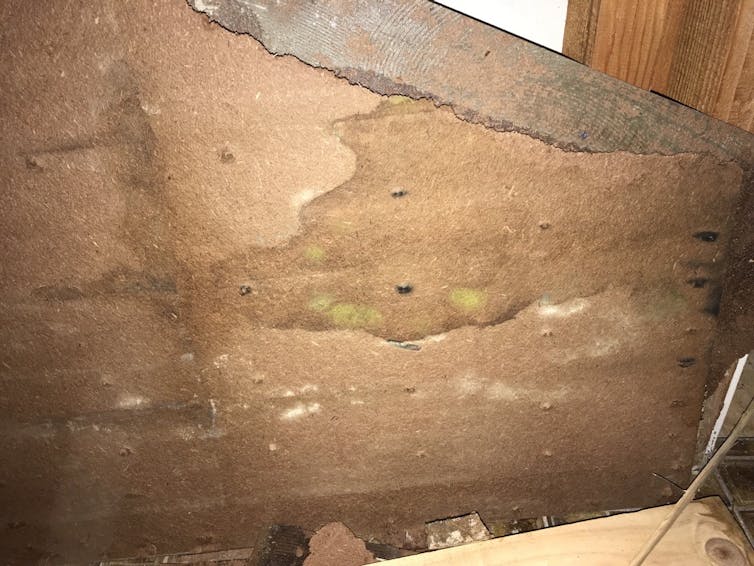
Green
We’re all fairly familiar with the green spots that turn up on mouldy bread, cake and other food items. Often we try to convince ourselves if we just cut off the bad bit, we can still salvage lunch.
Sadly that’s not the case, as the roots of the fungi – collectively called mycelium – spread through the food, digesting and collecting sufficient nutrients to pop out a series of tiny fruiting bodies which produce the coloured spores you see.
The green tuft is often from a group of fungi called Aspergillus. Under the microscope they look rather like the puffy top of a dandelion gone to seed.
Like Penicillium, Aspergillus is another big fungal group with lots of species that turn up virtually in every environment. Some are heat tolerant, some love acid and some will happily produce spores that stay airborne for days to months at a time.
In the green gang is also a fungus called Trichoderma, which is Latin for “hairy skin”. Trichoderma produces masses of forest-green, spherical spores which tend to grow on wet cardboard or dirty carpet.

Pink, Purple And Red
There are plenty to speak of in this category. And there is also a common bacterium that makes the list.
Neurospora, also known as the red bread mould, is one of the most studied fungi in scientific literature. It’s another common, non-hazardous one that has been used as a model organism to observe fungal genetics, evolution and growth.
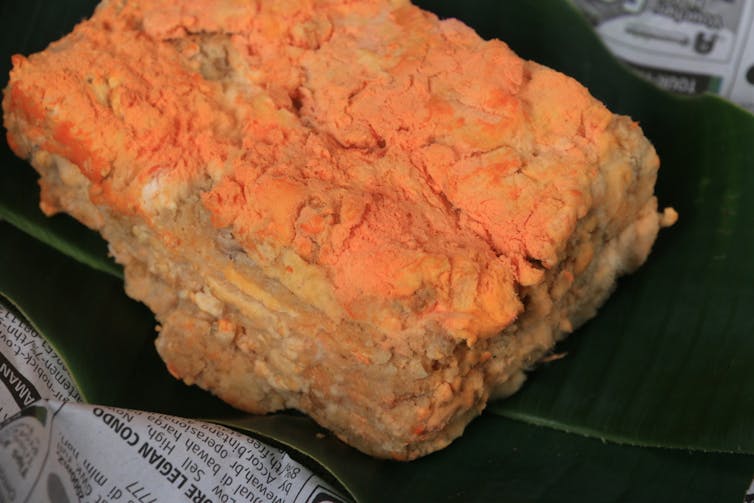
Fusarium is less common indoors, being an important crop pathogen, but will sometimes turn spoiled rice purple. It also occasionally turns up on wet cement sheet, causing splotchy violet patches. Fusarium makes large, sticky, moon-shaped spores that have evolved to spread by rain splashes and hang onto plants. However, it is fairly bad at getting airborne and so doesn’t tend to spread very far from where it’s growing.
Finally in this category, that pink scum that turns up around bathroom taps or in the shower? It’s actually a bacterium called Serratia. It will happily chew up the soap scum residue left over in bathrooms, and has been shown to survive in liquid soaps and handwash.

White
When fungi were first being classified and were eventually given their own phylogenetic kingdom, there were lots of wonderful and not strictly categorical ways we tried to split them up. One of these was hyaline and non-hyaline, essentially referring to transparent and coloured, respectively.
One of the interesting non-pigmented moulds you may well catch sight of is a thing called Isaria farinosa (“farinosa” being Latin for “floury”). This fungus is a parasite of some moths and cicadas and is visible as brilliant white, tree-shaped growths on their unfortunate hosts.

So when you notice the world around you changing colour, you can marvel with your newfound knowledge at the microscopic wonders that live complex lives alongside yours. Then maybe clean it up, and give the fruit bowl a wash. ![]()
Michael Taylor, Adjunct academic, Flinders University
This article is republished from The Conversation under a Creative Commons license. Read the original article.
Astronomers puzzled by ‘planet that shouldn’t exist’
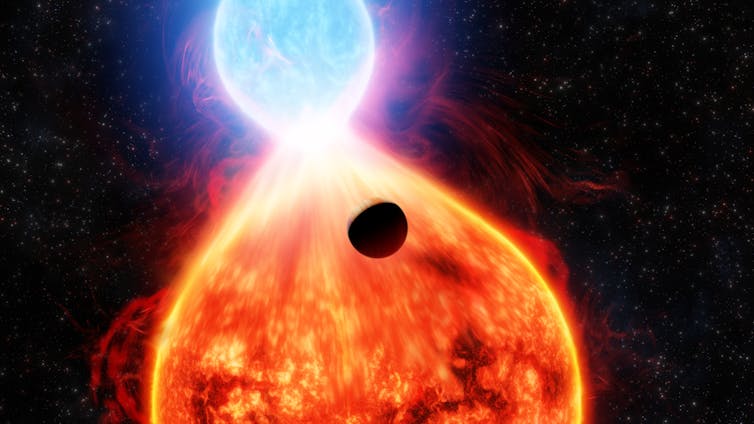
The search for planets outside our Solar System – exoplanets – is one of the most rapidly growing fields in astronomy. Over the past few decades, more than 5,000 exoplanets have been detected and astronomers now estimate that on average there is at least one planet per star in our galaxy.
Many current research efforts aim at detecting Earth-like planets suitable for life. These endeavours focus on so-called “main sequence” stars like our Sun – stars which are powered by fusing hydrogen atoms into helium in their cores, and remain stable for billions of years. More than 90% of all known exoplanets so far have been detected around main-sequence stars.
As part of an international team of astronomers, we studied a star that looks much like our Sun will in billions of years’ time, and found it has a planet which by all rights it should have devoured. In research published today in Nature, we lay out the puzzle of this planet’s existence – and propose some possible solutions.
A Glimpse Into Our Future: Red Giant Stars
Just like humans, stars undergo changes as they age. Once a star has used up all its hydrogen in the core, the core of the star shrinks and the outer envelope expands as the star cools.
In this “red giant” phase of evolution, stars can grow to more than 100 times their original size. When this happens to our Sun, in about 5 billion years, we expect it will grow so large it will engulf Mercury, Venus, and possibly Earth.
Eventually, the core becomes hot enough for the star to begin fusing helium. At this stage the star shrinks back to about 10 times its original size, and continues stable burning for tens of millions of years.
We know of hundreds of planets orbiting red giant stars. One of these is called 8 Ursae Minoris b, a planet with around the mass of Jupiter in an orbit that keeps it only about half as far from its star as Earth is from the Sun.
The planet was discovered in 2015 by a team of Korean astronomers using the “Doppler wobble” technique, which measures the gravitational pull of the planet on the star. In 2019, the International Astronomical Union dubbed the star Baekdu and the planet Halla, after the tallest mountains on the Korean peninsula.
A Planet That Should Not Be There
Analysis of new data about Baekdu collected by NASA’s Transiting Exoplanet Survey Satellite (TESS) space telescope has yielded a surprising discovery. Unlike other red giants we have found hosting exoplanets on close-in orbits, Baekdu has already started fusing helium in its core.
Using the techniques of asteroseismology, which studies waves inside stars, we can determine what material a star is burning. For Baekdu, the frequencies of the waves unambiguously showed it has commenced burning helium in its core.
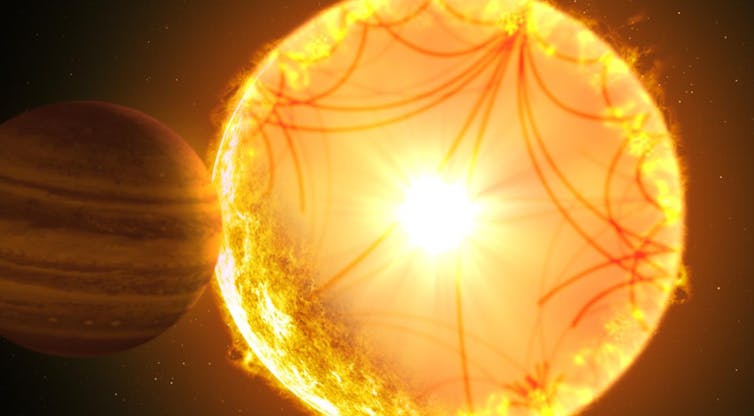
The discovery was puzzling: if Baekdu is burning helium, it should have been much bigger in the past – so big it should have engulfed the planet Halla. How is it possible Halla survived?
As is often the case in scientific research, the first course of action was to rule out the most trivial explanation: that Halla never really existed.
Indeed, some apparent discoveries of planets orbiting red giants using the Doppler wobble technique have later been shown to be illusions created by long-term variations in the behaviour of the star itself.
However, follow-up observations ruled out such a false-positive scenario for Halla. The Doppler signal from Baekdu has remained stable over the last 13 years, and close study of other indicators showed no other possible explanation for the signal. Halla is real – which returns us to the question of how it survived engulfment.
Two Stars Become One: A Possible Survival Scenario
Having confirmed the existence of the planet, we arrived at two scenarios which could explain the situation we see with Baekdu and Halla.
At least half of all stars in our galaxy did not form in isolation like our Sun, but are part of binary systems. If Baekdu once was a binary star, Halla may have never faced the danger of engulfment.
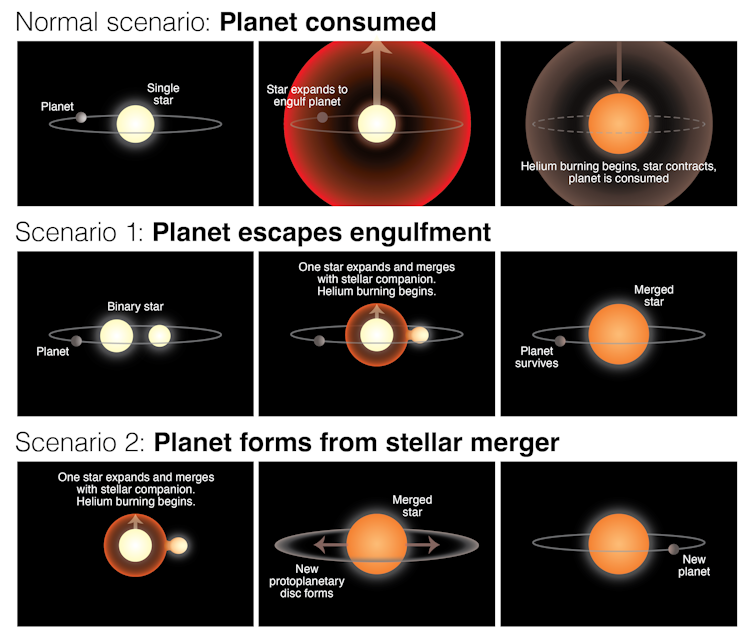
A merger of these two stars may have prevented the expansion of either star to a size large enough to engulf planet Halla. If one star became a red giant on its own, it would have engulfed Halla – however, if it merged with a companion star it would jump straight to the helium-burning phase without getting big enough to reach the planet.
Alternatively, Halla may be a relatively newborn planet. The violent collision between the two stars may have produced a cloud of gas and dust from which the planet could have formed. In other words, the planet Halla may be a recently born “second generation” planet.
Whichever explanation is correct, the discovery of a close-in planet orbiting a helium-burning red giant star demonstrates that nature finds ways for exoplanets to appear in places where we might least expect them. ![]()

Daniel Huber, Astronomer, University of Sydney
This article is republished from The Conversation under a Creative Commons license. Read the original article.
Disclaimer: These articles are not intended to provide medical advice, diagnosis or treatment. Views expressed here do not necessarily reflect those of Pittwater Online News or its staff.
